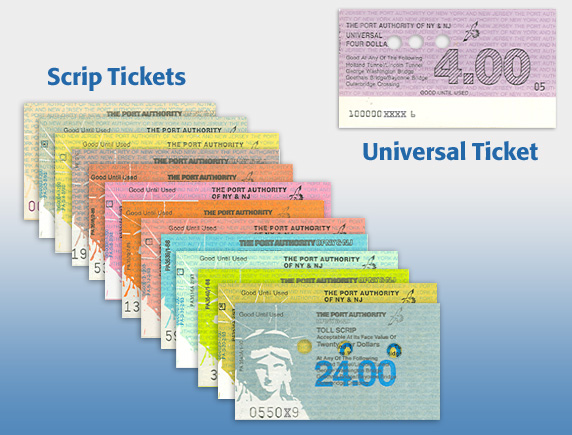New York State Bridge and Tunnel Commission / New Jersey Interstate Bridge and Tunnel Commission
Port of New York Authority
Port Authority of New York and New Jersey
A Brief History of the Interstate Crossings
When the first of the vehicular crossing was planned and built, the Holland
Tunnel; the original agency controlling the crossing was the New York State
Bridge & Tunnel Commission. The Holland Tunnel, which opened in
1927; was then operated as a joint venture between the New York State Bridge
& Tunnel Commission which was organized as far back as 1906, and the New Jersey Interstate Bridge &
Tunnel Commission was formed in 1908.
Both of these agencies were created to study the feasibility of construction a bridge over the Hudson River between New York City and New Jersey located
near or at West 57th Street, Manhattan. While the bridge at this
location would not be built, this planning resulted in the construction
of what would eventually become the George Washington Bridge much further north at West 179th Street.
However, it would be a tunnel connecting the two states, that would
be constructed first. Originally known as the "Hudson River Vehicular
Tunnel" or the "Canal
Street Tunnel",
the tunnel would be renamed the Holland Tunnel in memory of Clifford
Milburn Holland, the chief engineer. Mr. Holland passed away suddenly
in 1924 prior to the tunnels' opening.
Since very early on, conflicts and disagreements arose between the two agencies.
Meanwhile, a third entity; the Port of New York Authority "PoNYA" had been created on April 30, 1921
via an interstate compact between the states of New York and New
Jersey. This compact was enacted by the U.S. Congress. The PoNYA was
the first such agency in the United States so created under a provision in the Constitution
of the United States
permitting interstate
compacts.
The creation of the Port of New York Authority was to plan and
construct the bridges spanning the Arthur Kill and the Kill Van Kull
waterways that separated New Jersey and Staten Island, NY; and that planning would result in the construction of the Goethals, Outerbridge Crossing and the Bayonne Bridge.
In the end, operations of the now open Holland Tunnel was
contracted to the Port of New York Authority in 1930; and with it, to
eventually absorb the Holland Tunnel operations into its agency
outright. The New York and New Jersey Interstate Bridge & Tunnel
agencies were dissolved altogether.
The Port of New
York Authority would additionally come to plan and operate the George
Washington Bridge and the Lincoln Tunnel (and each of its three bores
built over the next few decades); as well as various airports,
seaports, container terminals, as well as commercial and industrial
spaces for rent or long term lease; as well as the original World Trade Center in lower Manhattan.
In 1972, both New York and New Jersey state governments adopted
legislation changing the name of the agency from "Port of New York Authority" (PoNYA) to "the Port Authority of
New York and New Jersey" (PANYNJ) so as to better reflect both states
involvement in the shipping and transportation needs of the two states,
and not just New York.
 |
crossing
name |
date
opened |
| George
Washington Bridge |
upper
deck: October 24, 1931
lower deck: August 29, 1962 |
|
|
Lincoln
Tunnel
formerly "Midtown Hudson Tunnel" |
center
tube: December 22, 1937
north tube: February 1, 1945
south tube: May 25, 1957 |
|
|
| Holland
Tunnel |
November
13, 1927 |
|
|
| Bayonne
Bridge |
November 15,
1931
deck height raised
northbound lanes opened: February 20, 2017
southbound lanes February 11, 2019, |
|
|
| Goethals
Bridge |
original
span: June 29, 1928
new eastbound span: June 10, 2017
new westbound span: May 21, 2018 |
|
|
| Outerbridge
Crossing |
June
29, 1928 |
Double Width Toll Lanes: Driver or Passenger Side Payment
One quick side trip before delving
into the intricacies of the scrip issues, which I felt was
worth noting. The toll booths as originally constructed for the Port
Authority crossings (as well as other toll booths in the New York City area), were of the double lane design. Meaning, there
were two lanes of traffic abreast of one another, flanked by toll
collectors booths. This design allowed collection from either the drivers
side or passenger side windows of the vehicle.
I have located the following film footage courtesy of Getty Image
archives and it is dated 1932. The very beginning of the film shows two
toll collectors occupying the same booth but collecting tolls from
lanes on either side of the booth (click on image for film):
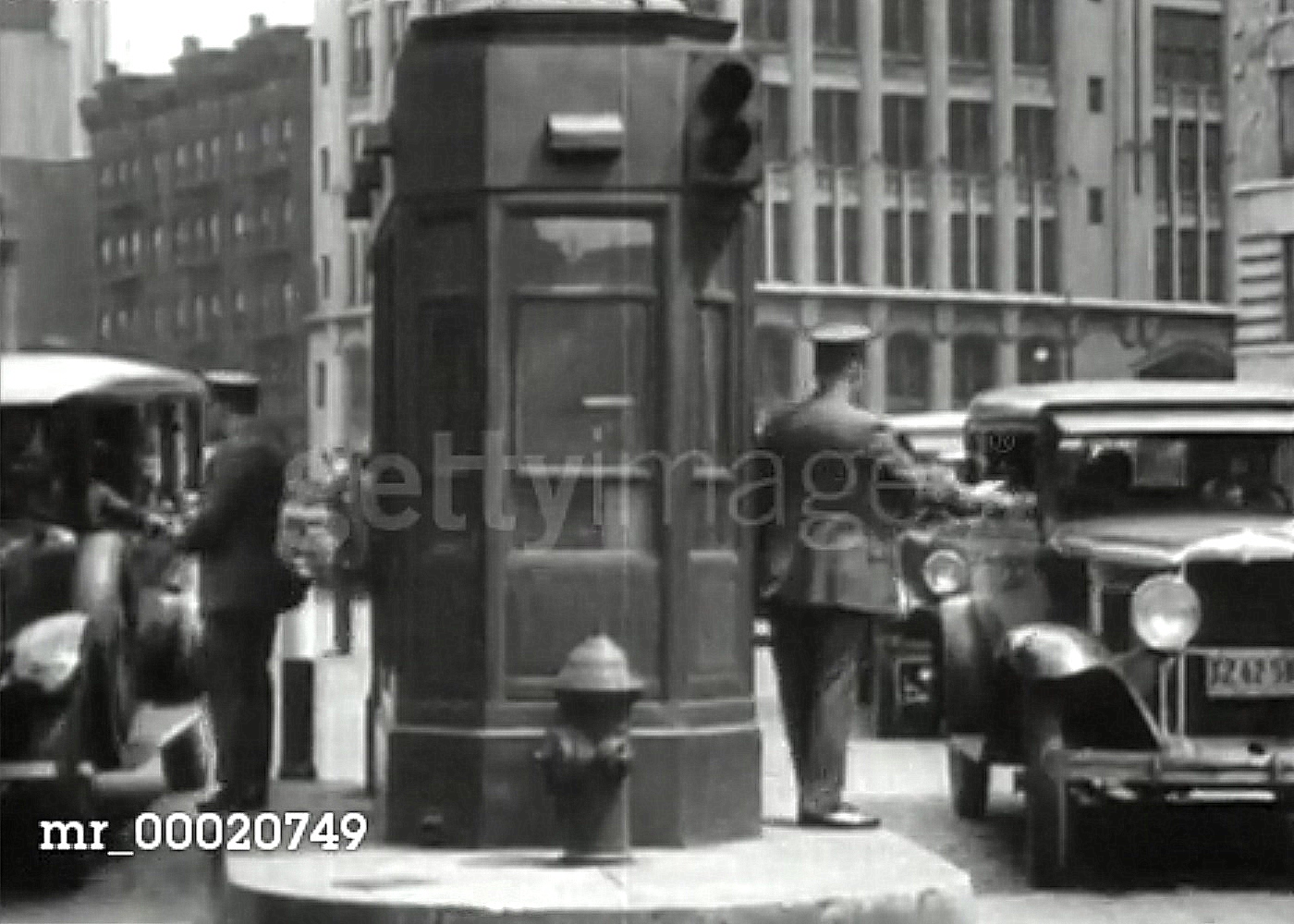
Apparently, this dual collection design was quite common in
that era of highway design, as I have seen other facilities in other states with the same arrangement. To
be clear, we are not talking about opposing traffic next to one
another, but traffic flow in the same direction. This arrangement also
allowed a single toll collector located between two lanes to collect from either a driver or a passenger.
Double
lane toll collection fell out of favor sometime in the 1950's and toll
plazas were reconstructed to the one lane / one booth style that was
prevalent until the electronic / cashless era of toll collection. Many
of the images below show this dual lane collection, as well as being
historically significant for the crossings:
|
First Toll Paid at Holland Tunnel
Officers of the New York State Bridge and Tunnel Commission and the New Jersey Interstate Bridge and Tunnel Commission
following the dedication ceremony; 12:00 am, November 12, 1927 - Manhattan, NY
added 21 January 2024
|
|
Holland Tunnel (entrance only - Manhattan, NY) - 1929
|

Holland Tunnel (entrance only - NJ) - ca. 1929 |
| . |
|
 |
 |
| .George Washington Bridge (Fort Lee, NJ) Dedication Ceremony - October 24, 1931 |
.George Washington Bridge (Fort Lee, NJ) - First civilian car paying toll - October 25, 1931 |
|
|
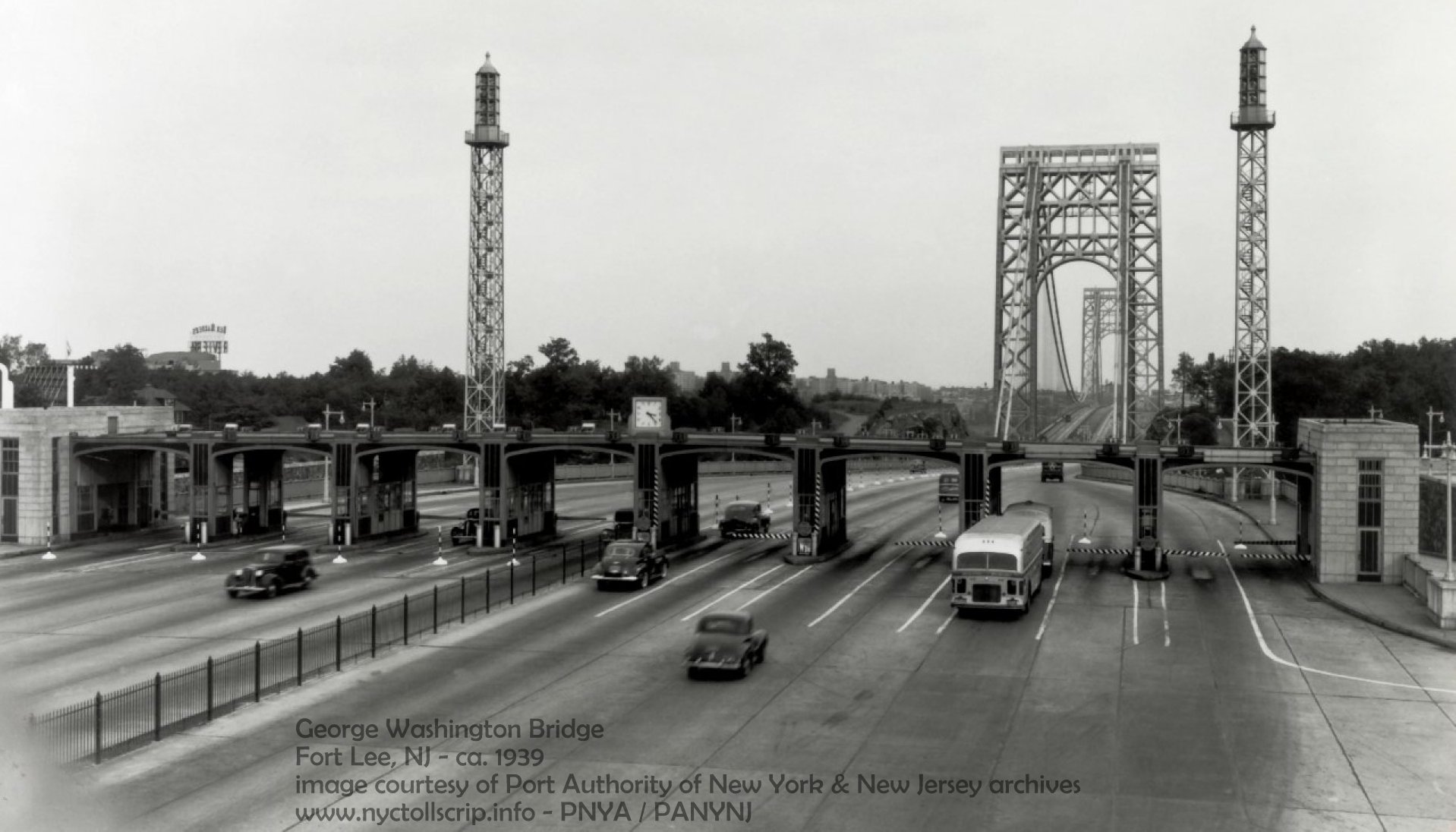 |
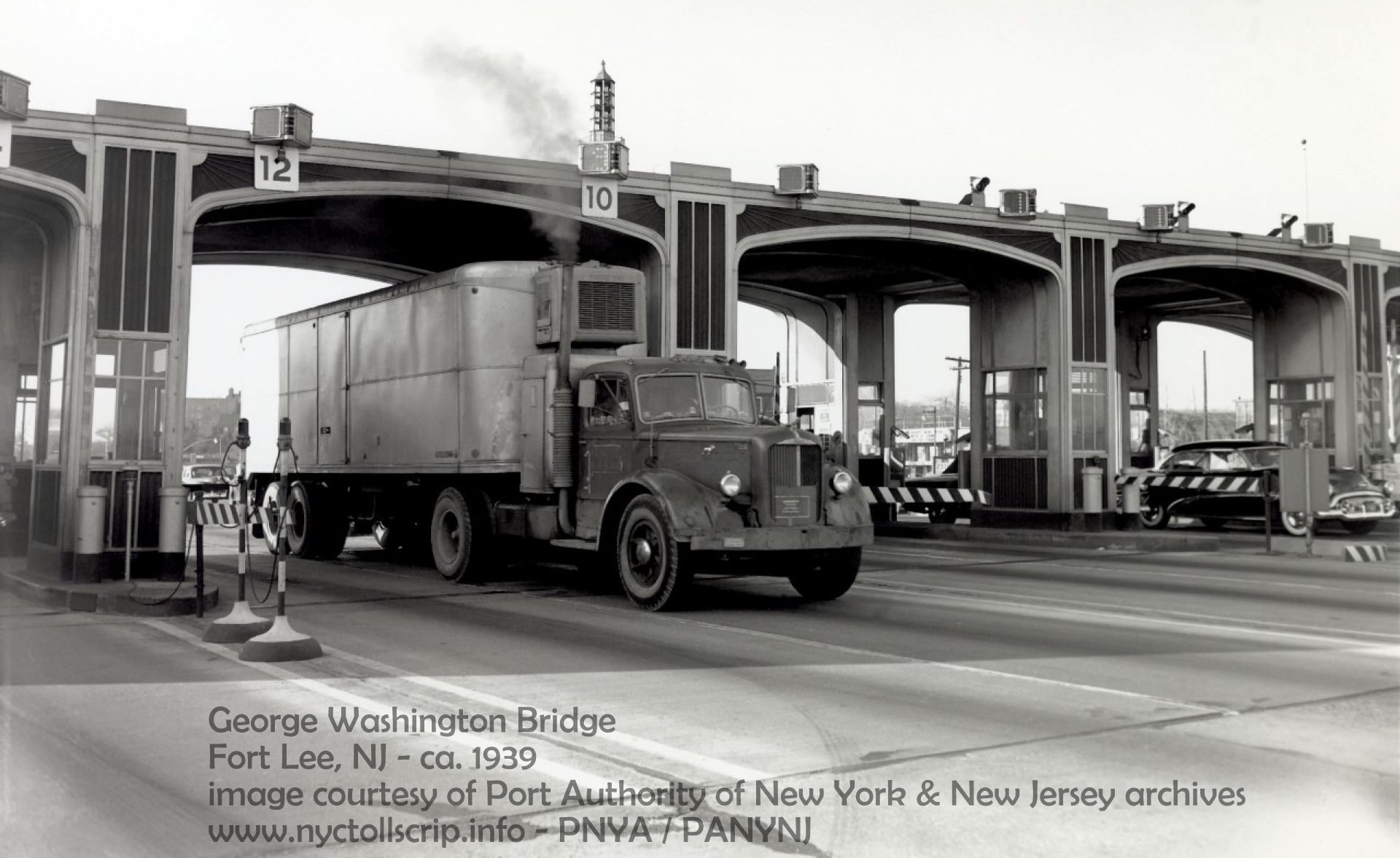 |
| George Washington Bridge (Fort Lee, NJ) - ca. 1939 |
George Washington Bridge (Fort Lee, NJ) - ca. 1939 |
|
|
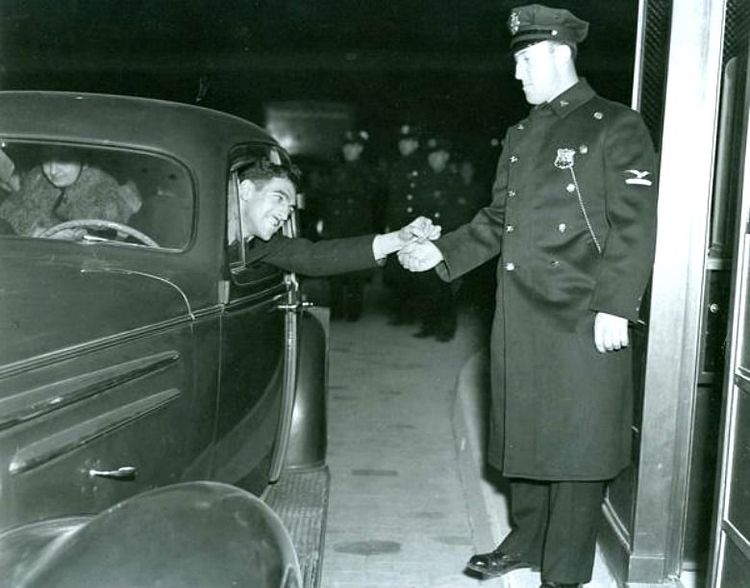
Lincoln Tunnel - Omero C. Catan pays the first toll (Weehawken, NJ) - December 22, 1937.
Mr. Catan also known as "Mr. First". He waited 30 hours in the December cold for this honor. Mr. Catan made it a regular endeavor to be the first paying vehicle or rider on many infrastructure projects constructed on the Eastern Seaboard.
Mr. Catan was the first toll to be paid on so many of the
highways on crossing contained within this website, i have given him
his own chapter on Page 1
the first to traverse the newly opened lower level of the George Washington
Bridge in 1962 (from the New Jersey side - see photo below).
|
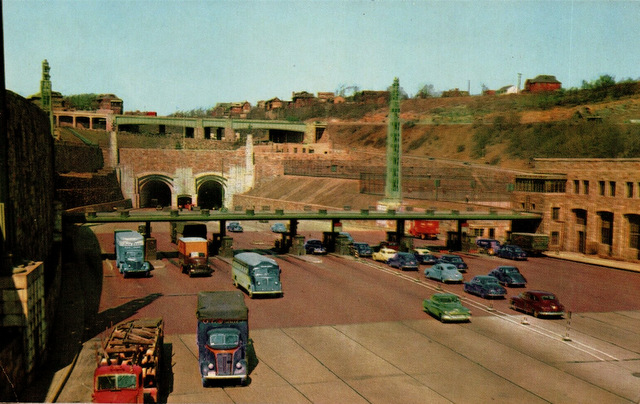
Lincoln Tunnel (Weehawken, NJ) - ca. 1950's |
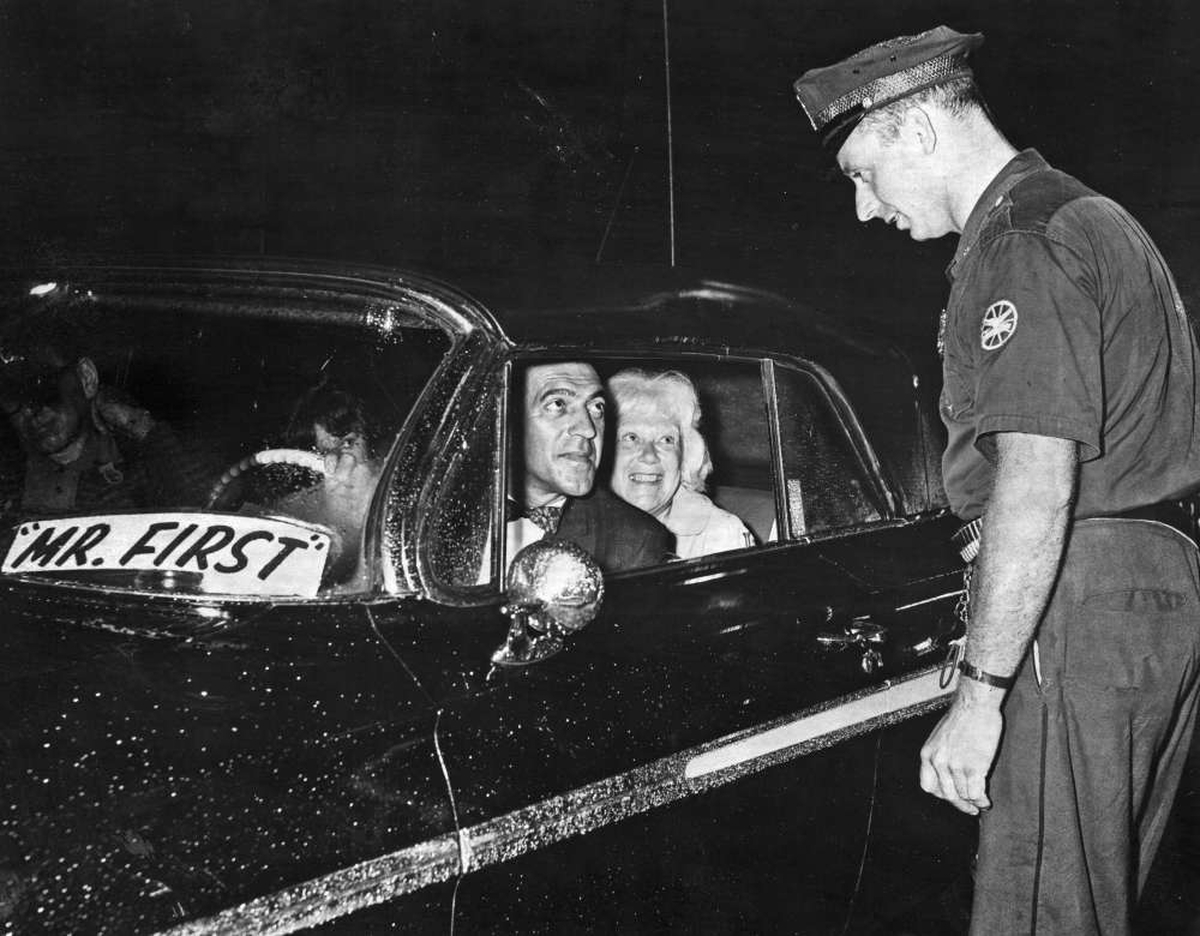 |
|
Holland Tunnel - the semi-circular Toll Plaza, Manhattan, NY
Because of the one square block confines of the westbound
entrance, the Manhattan-side entrance to the Holland
Tunnel toll plaza was doubly unique in itself, as not only were the
lanes double width to allow driver or passenger side payment;
but the booths themselves were
arranged in a 180 degree semi-circle to allow traffic to enter from the
peripheral five streets: Broome, Canal, Hudson, Varick and
Watts. The New Jersey-side was built as conventional linear toll barrier.
This Manhattan plaza entrance was obscurely known known as
Freeman Plaza; and so named after Milton Freeman, one of the
co-engineers with Clifford Holland in the design and construction of
the tunnels. Freeman took over after Holland passed of a heart attack
in 1924; with Freeman in charge until he was struck down by pneumonia
about a year later.
The second
reconfiguration took place in 1954. The lanes were widened to
accommodate larger tractor trailers and this necessitated a reduction of
toll lanes. New climate controlled toll booths were built, as well as an overhead canopy which now connected the
toll booths on either side of the main administration building to
provide additional protection for the toll collectors from inclement weather.
However, the overall design of the toll plaza would
remain a semi-circular plaza until 1971.
 Holland Tunnel
Toll Plaza
Holland Tunnel
Toll Plaza
Manhattan, NY - ca. 1960
note new toll booths and overhead canopy connecting same
(looking northeast)
digital version: authors collection
added 27 February 2022
After
one way directional tolling (towards New York) was adopted by the Port
Authority of
New York and New Jersey in 1971; the toll booths, canopies of the
Manhattan Toll Plaza for the
Holland Tunnel were razed. The former multiple lane feed through the
toll booths was reduced to a four legged approach. The administration
building survived until
ca. 1983.
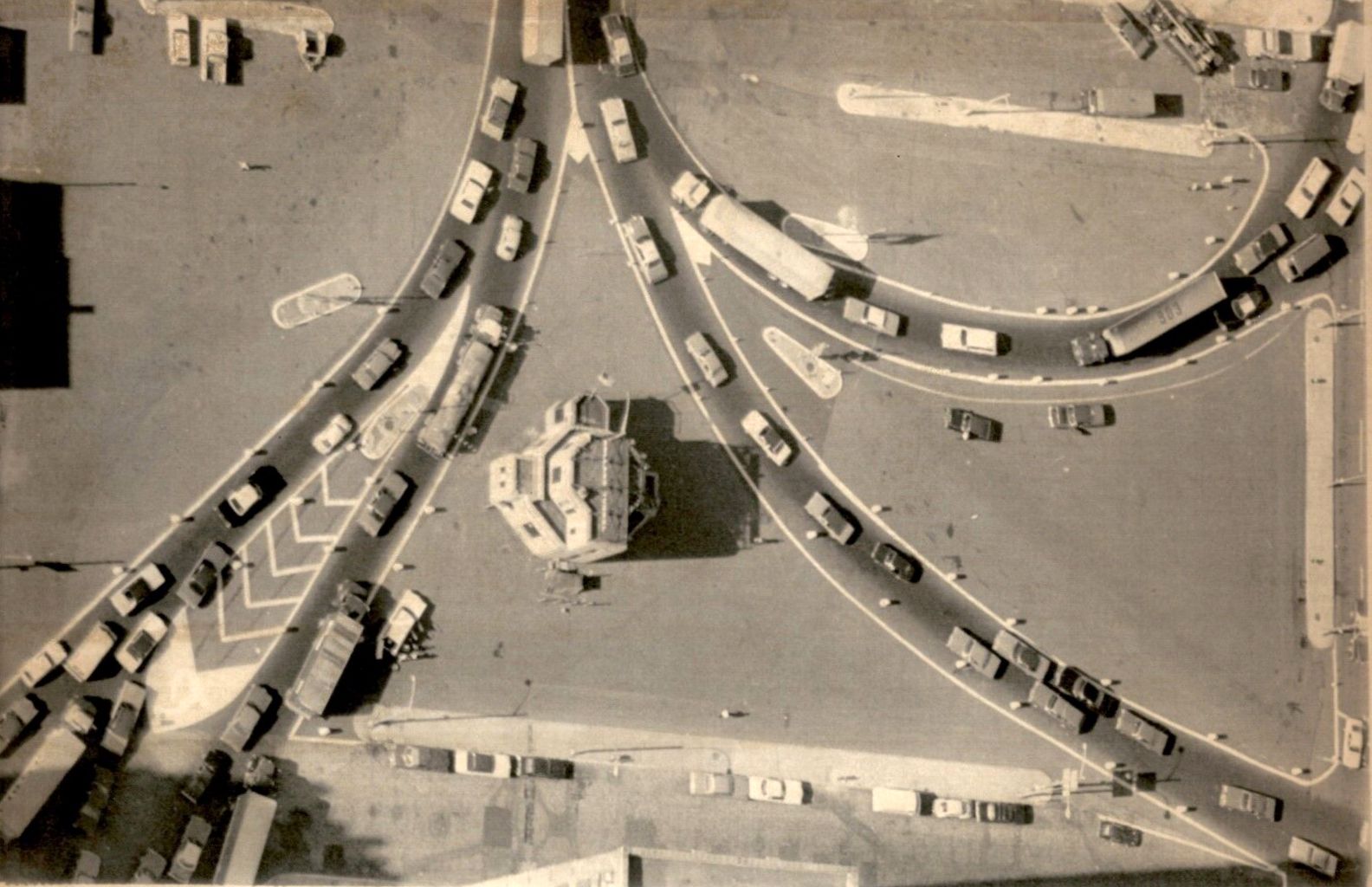 Holland Tunnel
Toll Plaza
Holland Tunnel
Toll Plaza
Manhattan, NY - August 16, 1975
Associated Press photo
note toll booths and overhead canopy removed
(north is up)
added 02 April 2023
The plaza grounds would remain undeveloped and paved, and was
utilized as space for snow removal and administration vehicles until
around 2000.
It is at this time the non-vehicular spaces
were developed into sitting areas and green space. A more fitting monument and plaque was erected honoring Milton Freeman.
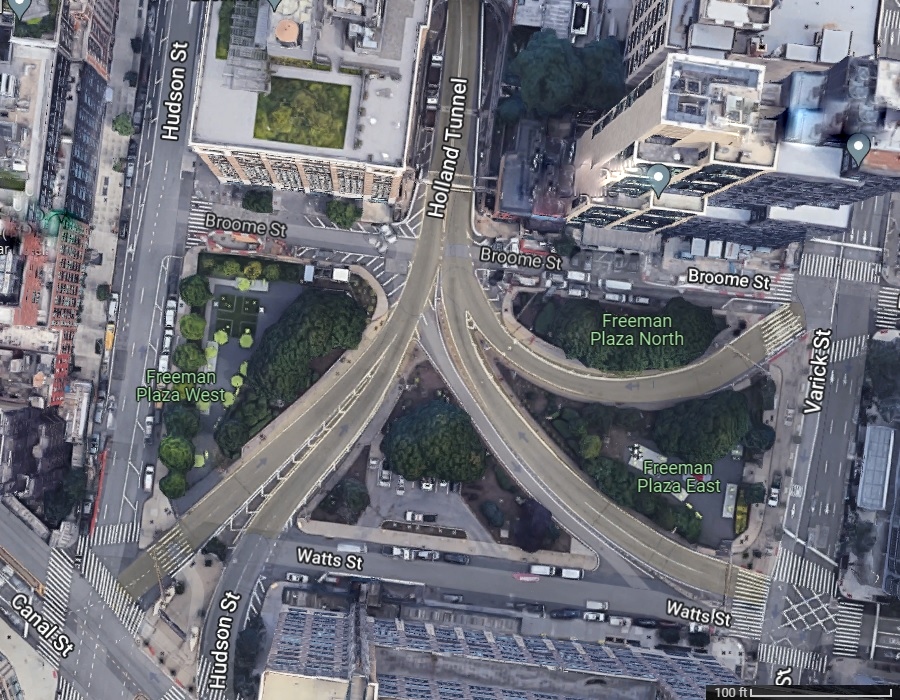 courtesy of Google Street Map
courtesy of Google Street Map
Now, with the short history of this unusual toll plaza design covered,
lets get down to the fiscal issues!
While I originally attributed these to being "simple" toll
receipts, I took note of its perforation and the duplication of portions
of the information. This perforation made me ponder as to its actual purpose.
Why the need for a two part receipt? Unless in fact, it is the prepaid
class ticket as mentioned in the Port of New York Authority Annual
Reports and as mentioned later on this website.
|
 |
|
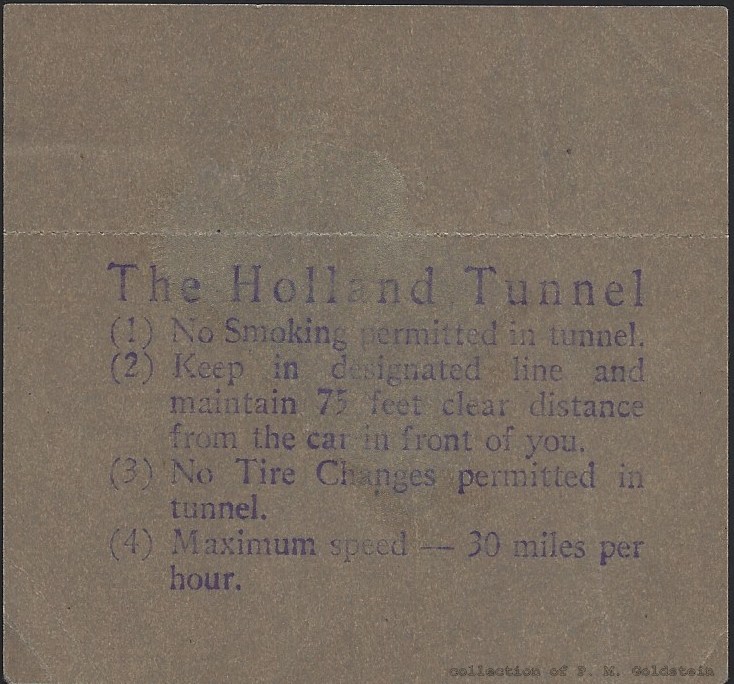 |
|
|
Holland
Tunnel Prepaid Class Ticket (Class II)
- opening day: November 13, 1927
#0030 - lowest known transaction numbers
3 ⅜"
(height) - 3 ⅝"
(width) - .008 (thickness)
collection of
Philip M. Goldstein |
|
| . |
|
|
|
|
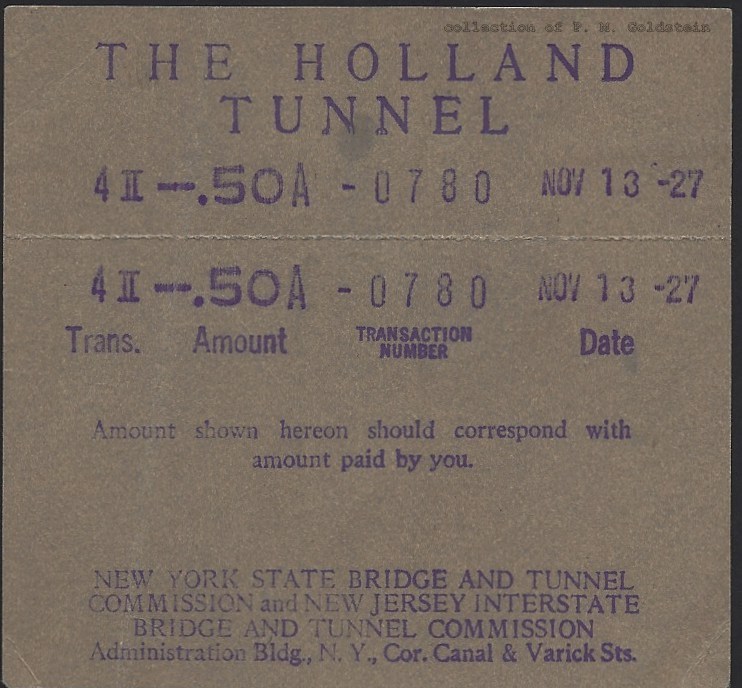 |
 |
|
 |
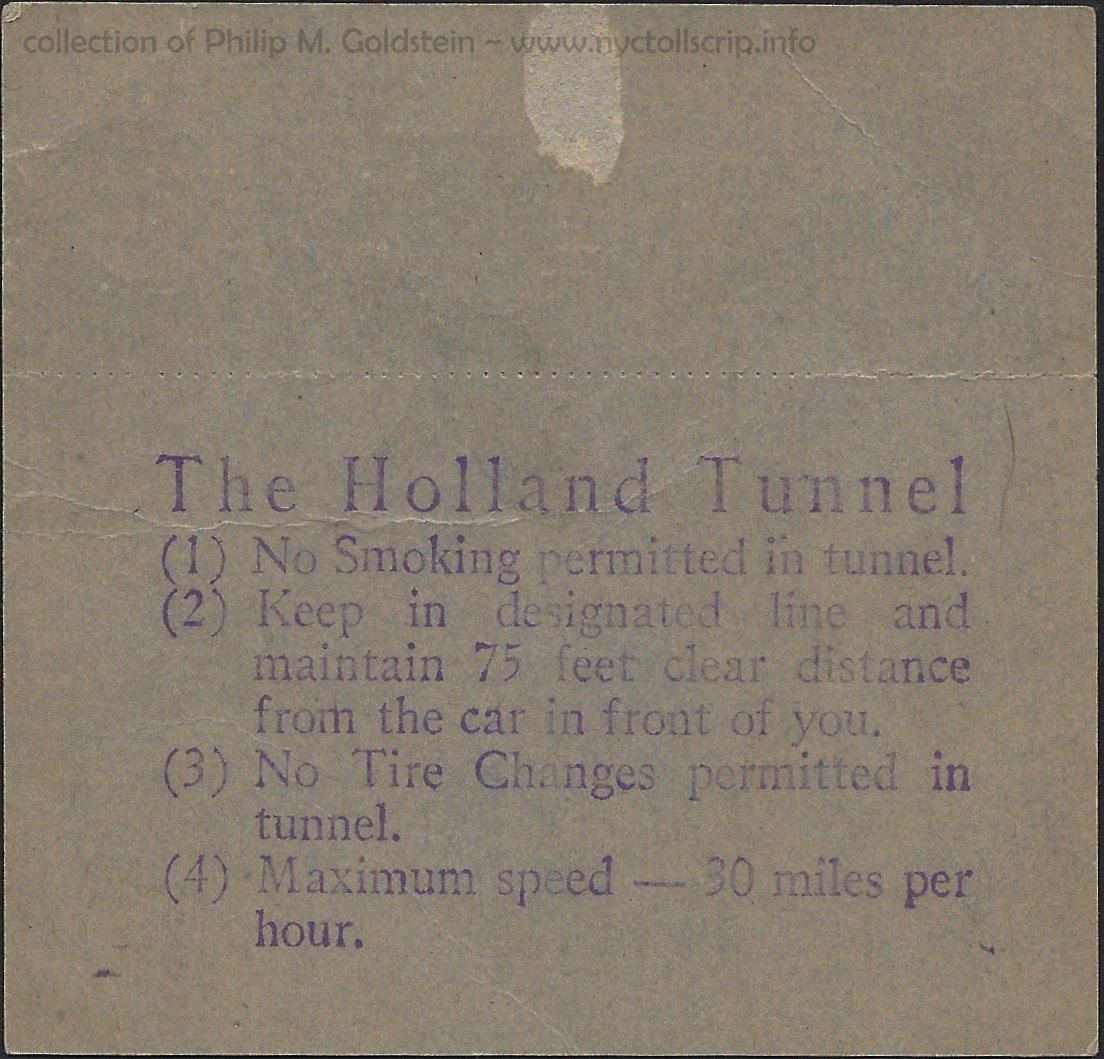 |
Holland
Tunnel Prepaid Class Ticket (Class II)
- opening day: November 13, 1927
3 ⅜"
(height) - 3 ⅝"
(width) - .008 (thickness)
collection of
Philip M. Goldstein |
|
Holland
Tunnel Prepaid Class Ticket (Class II)
- opening day: November 13, 1927
Note month listed: October! All historical accounts list opening day to the general public to be
November 13, not October!
Most likely the collector didn't have the ticket imprinter set correctly, thereby the ticket above is an "error"!
It is a .50 B which does give me a different variant than the one I had.
3 ⅜"
(height) - 3 ⅝"
(width) - .008 (thickness)
collection of
Philip M. Goldstein |
| . |
|
|
|
|
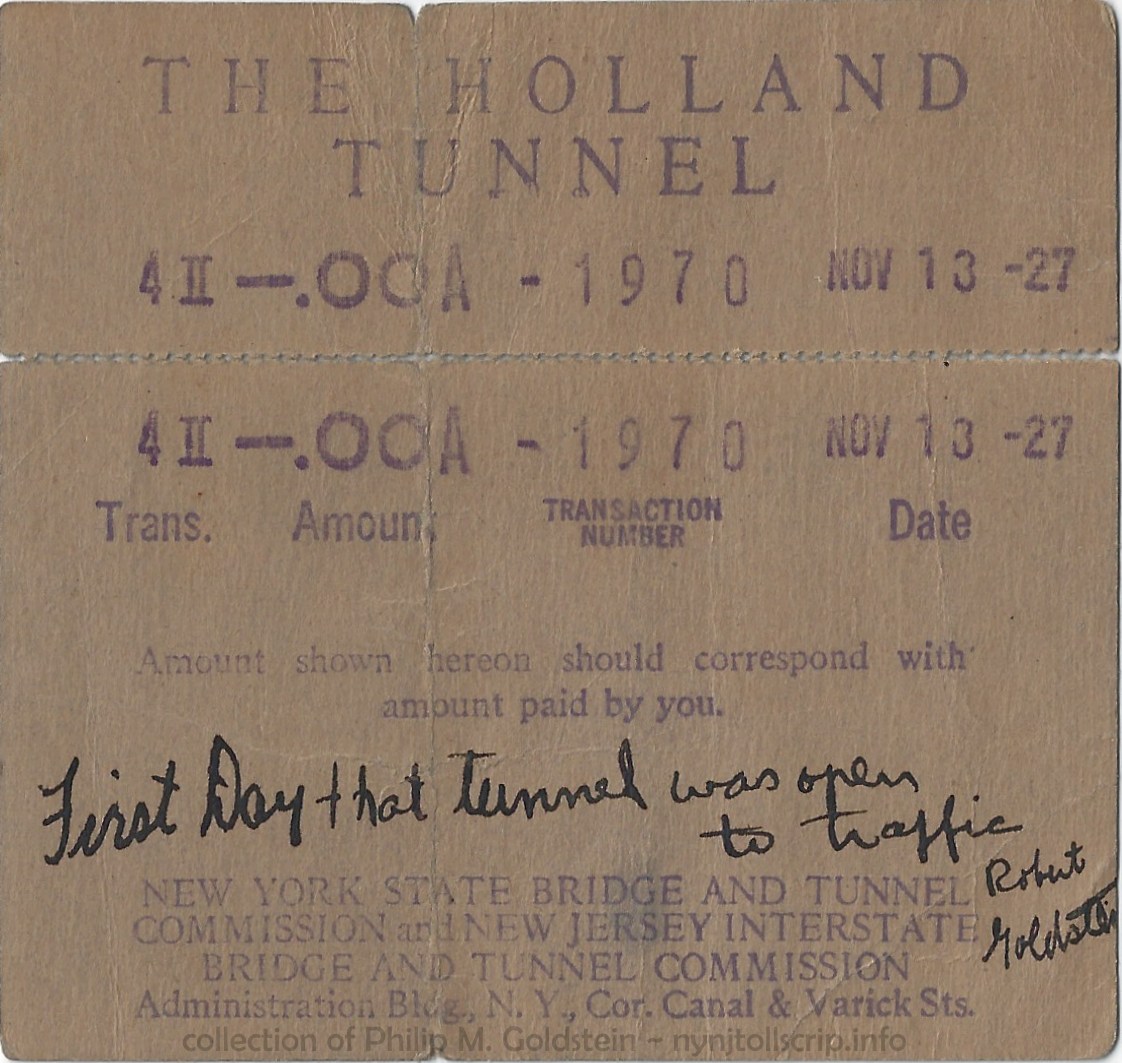 |
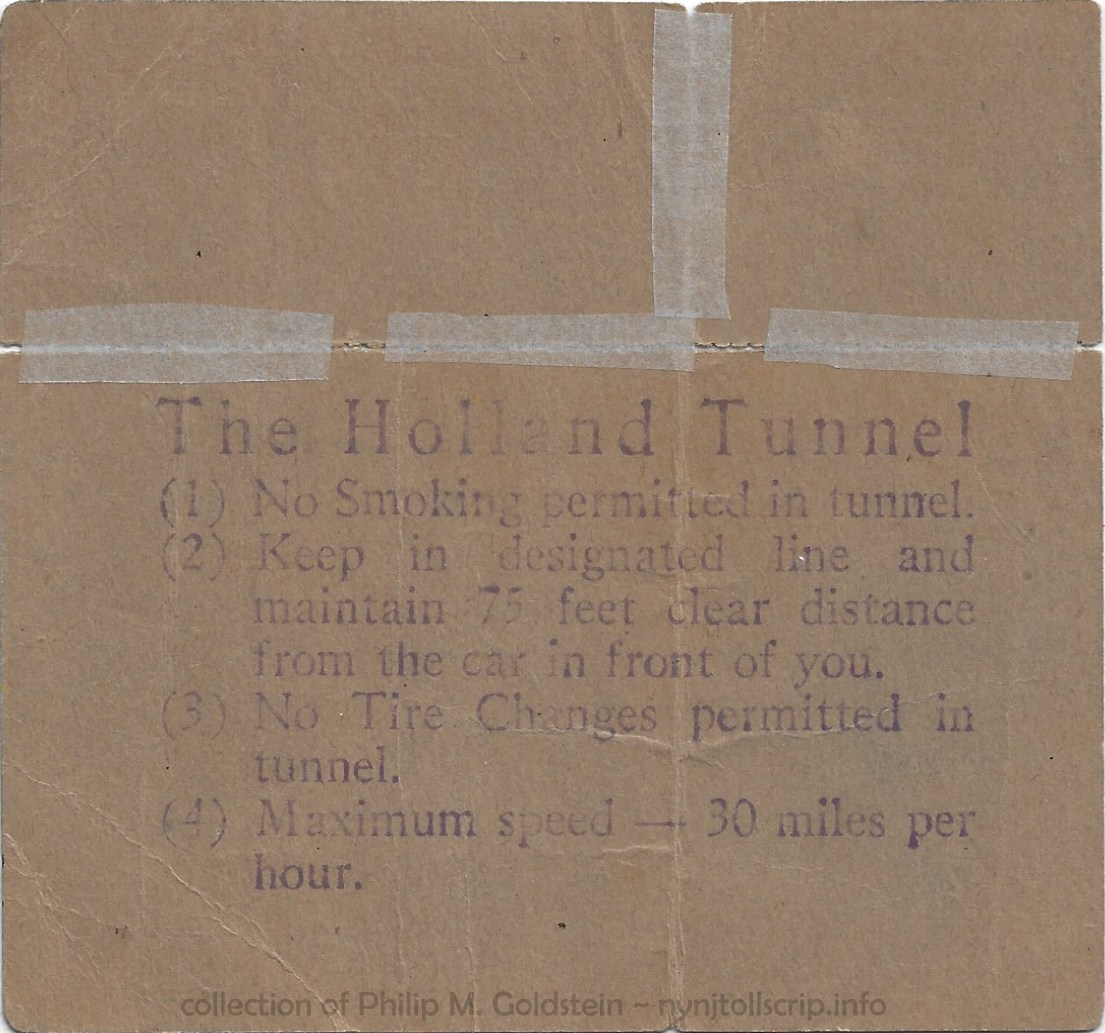 |
|
|
Holland
Tunnel Prepaid Class Ticket (Class II)
- opening day: November 13, 1927
Another oddball: note the amount: .00A - No charge? The ticket is issued as a Class II
(passenger auto)
and since no pedestrians were allowed through the
tunnel, that cannot be the case here. It's very unusual.
Another interesting fact, is this ticket was obtained by a Mr. Robert Goldstein,
no relation to me, but very interesting coincidence at the least.
3 ⅜"
(height) - 3 ⅝"
(width) - .008 (thickness)
collection of
Philip M. Goldstein |
|
|
The reason I now suspect that this is a prepaid class ticket, is
that the the top portion bears no rules and regulations as the
bottom half does, which would understandably be the drivers portion to
be retained after presentation for passage, with the top portion being
detached and kept by the toll collector.
Furthermore, the Port Authority of New York and New Jersey
Authority blog has an almost identical issue displayed (albeit from 6 days
later) and they refer to it as a "ticket". All the examples I have encountered,
whether in museums and those for sale; have the two parts attached as
seen, and I had not encountered just the bottom (receipt) portion on
its own. This could be expected as after the top portion is detached,
the bottom portion had no value; and they were simply discarded (but more about his later).
I have located three articles in the New York Times Digital archives regarding these tickets:
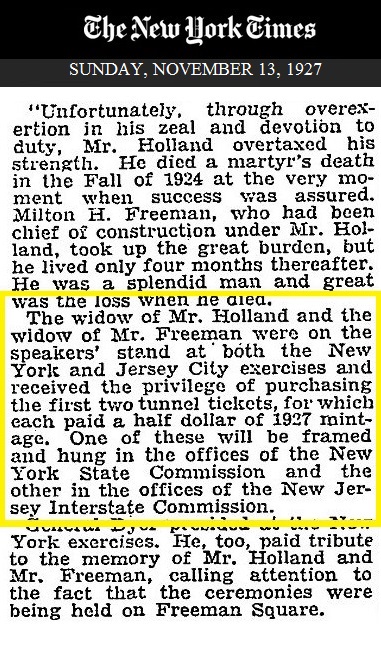 |
 |
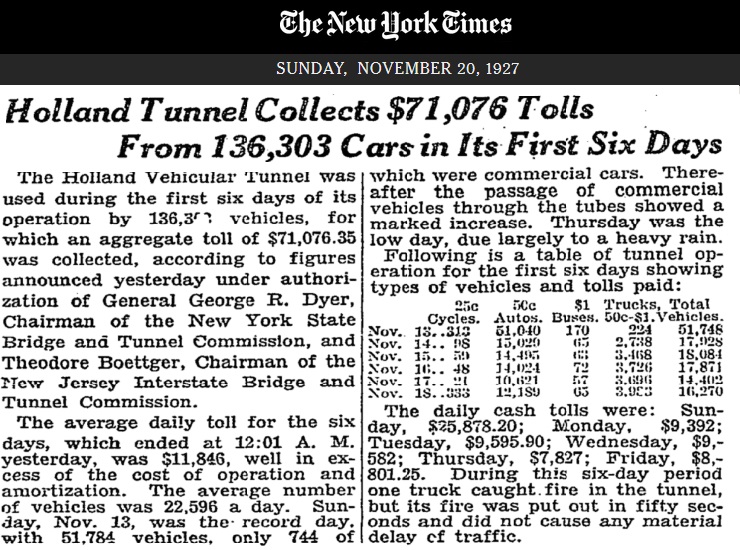 |
| all courtesy of the New York Times Digital Archives |
Deciphering the codes.
There are several questions regarding the codes seen on the
Holland Tunnel Prepaid Tickets which remain to be answered. Starting
from the left, we see 4 II - .50 A.
It is my estimation that the numeral 4 (or any other number in this position, others have been seen: 4, 12, 13, 14, 20, and 22)
is either the Toll Collectors Badge Number, Toll Booth Number or Lane
Number. Remember, when first opened, the toll booth was situated
between two lanes and the collector took tolls from passengers side and
drivers side. As originally configured when opened in 1927, there were
six toll booths servicing twelve toll lanes on the New York side. This
was reconfigured around 1939 or so; to ten booths servicing ten lanes
with collecting from drivers side only. As we have not seen any number
higher than the 20's, so I lean towards the latter of the two of these
possibilities, as there certainly had to be more than 22 toll
collectors employed!
In the next position, we see the Roman numeral II. This is almost certainly the vehicle class / group number. When one views the Goethals Bridge ticket further below, it shows II +1; which for that crossing would equate to a passenger vehicle (Group II)
plus one passenger other than driver. So far, tickets with any other
vehicle classes have not yet been seen, other than passenger auto. If
and when a ticket shows with the appropriate class number and the
corresponding toll amount (i.e. truck up to 2 tons = IV and $1.00 amount, we will have our confirmation this is in fact the case.
The .50 amount paid is self evident.
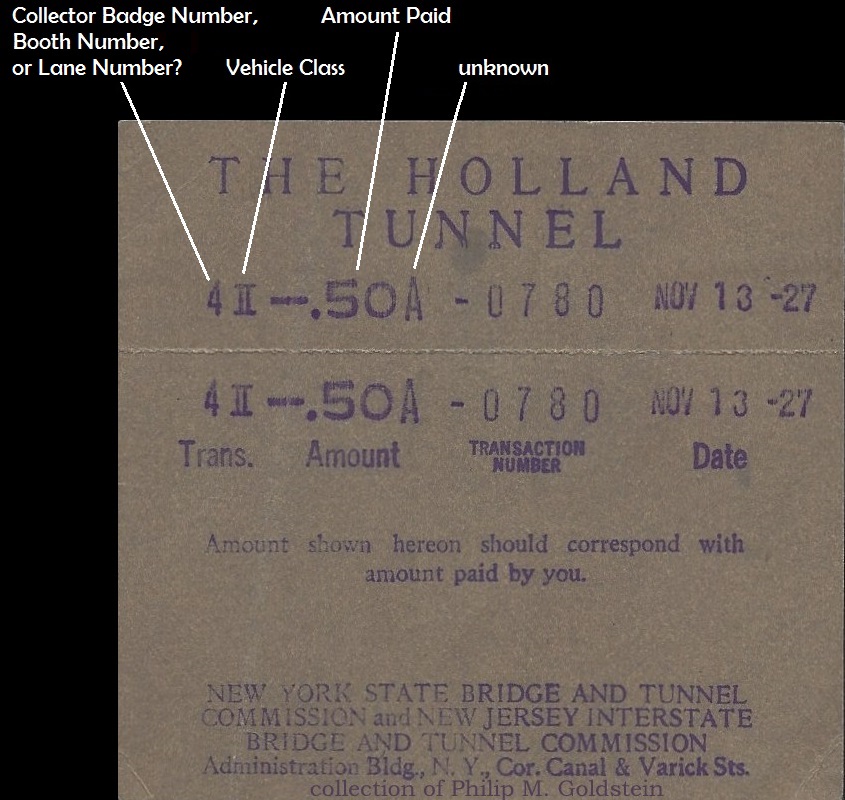 |
| Vehicle
Type |
Group
# |
Rate |
| Motorcycle |
I |
0.25 |
Passenger
Automobile,
with a capacity up to 7 passengers, ambulance or hearse |
II |
0.50 |
Bus,
(up to and including 29 passenger seating capacity) |
III |
1.00 |
| Truck,
up to 2 tons |
IV |
0.50 |
| 2 ton+
to 5 ton Truck |
V |
0.75 |
| 5 ton+
to 10 ton Truck |
VI |
1.00 |
| Trucks
exceeding 10 tons capacity and not exceeding 15 tons Gross Weight and not exceeding 12 tons axle load |
VII |
2.00 |
| Vehicles
admitted by special permit, only |
VIII |
Special* |
|
This leaves up with the suffix letters following the amount, (after the .50) and are what remains totally unknown.
I had originally thought I understood the coding for the Holland Tunnel Tickets
(the Goethals and Outerbridge appear to have used a slightly different
schedule which I will address below), but now I am not so sure.
I originally was under the
impression this suffix letter denoted the number of occupants:
A = 1
occupant (driver / operator),
B = 2 occupants (driver & passenger),
C = 3 occupants (driver and
two passengers),
D = 4 occupants (driver and three passengers),
E = 5 occupants (driver and four passengers), etc.
But now I have observed a ticket marked .50E (seen below). Note
that this ticket lists four names of a family on it; therefore D =
4 and E should have meant 5: driver and four passengers.
If the driver was automatically accounted for in the base
.50 cent toll, with
no suffix = driver only
A = driver and one passenger,
B = driver and two
passengers,
C = driver and three passengers - and thats the four occupants.
However, this equation still doesn't work,
and I have never seen a ticket with just .50 on it without a suffix
letter.
The discovery of the New York Times article seen to the right
reveals that counting occupants was not a factor at the Holland Tunnel,
as it would be at the Goethals and Outerbridge Crossing when they
opened a few years later.
|
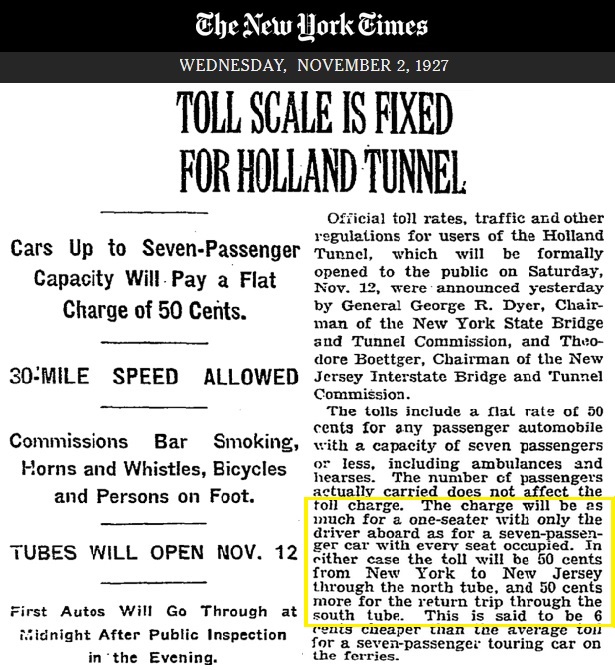 courtesy of the New York Times Digital Archives courtesy of the New York Times Digital Archives
|
It is possible these letters denote time of day in some form, but
being combined in the "amount" column, I think it might denote how the
toll was paid: coins or bills. A = one half dollar, B= two quarters, C
= five dimes D= ten nickels, E = dollar bill, et al or vice versa. But
as seen with the Goethals ticket below, 55 cent and B - it should have
two letters as 55 cents would require a minimum of two coins to make up
the 55 cents: a half dollar and a nickel, or three coins being two
quarters and a nickel. Again, this is a hypothesis. We simply
just have no idea exactly what these suffix letters mean at this time.
|
|
| Hoboken Historical Museum archives |
Now, what I did not expect to encounter, was only the top
portion of the
ticket. I concluded these had been kept by the NYSB&TC /
NJIB&TC agency after being
detached from the bottom receipt portion for daily accounting
tallies, then stored and subsequently destroyed after a period of time
elapsed. I honestly expected to see a bottom only (customers portion /
receipt) long before, if at all; than the top portion and as I
mentioned above.
But yet, here we have a top portion only. How or why it survived
remains an unanswered mystery and if my understanding on how these
tickets worked, this should have now become and internal document
following redemption at the toll booth and being separated from the
bottom portion of the ticket / customers receipt. The only two
postulations I can surmise are: it was found or kept by a toll
collector or other agency employee; or, it was a complete two part
ticket, that inadvertently became detached from the bottom, and
separated with the top portion surviving, to eventually be listed for
sale on eBay.
While it is not from opening day, is is
collectible and documentary none the less. It also has a slightly peachier color tone
than other examples of Holland Tunnel tickets in my collection.
 |
collection of Philip M. Goldstein
added 12 February 2021 |
.
.
In
1930, following a disagreement between the New York State Bridge
& Tunnel and New Jersey Interstate Bridge & Tunnel Commissions;
the
Port of New York Authority which had already been operating the
Goethals,
Outerbridge & Bayonne Bridges, was contracted to operate the
Holland Tunnel. This contract was in effect for the time span
from April 21, 1930 through March 1, 1931.
On this date, it was agreed the Port
of New York Authority would assume all responsibility for
operation, repair, and governance of the Holland Tunnel.
.
The Arthur Kill Crossings
Moving onto the Goethals, Outerbridge and the Bayonne Bridges;
these were interchangeably known as the "Arthur Kills Crossings" or the
"Staten Island Bridges".
It appears toll rate were
not fixed until the last minute. To the best of my searching, no
announcement was made until just prior to opening. And the Goethals and
Outerbridge opened without any hubris. They just opened. Furthermore,
there appears to be contradicting information as to the toll. In
subsequent New York Times articles, the first being June 29, 1928, the
tolls were lists as 50 cents per pleasure car, 5 cent each passenger,
and $1.00 for trucks.
Seen
below, is a prepaid class ticket and receipt for the
Goethals Bridge. On this ticket, one will note the Dept. (Class) is II
+1, and the charge amount of 55 cents. For those of you paying
attention, the toll of 55 cents seems odd, as when the Goethals,
Outerbridge Crossings and Bayonne spans opened, the passenger automobile toll rate
was 50 cents. So where does 55 cents factor in? Well, I'll tell you: 55 cents
equates
to the toll for a Group II vehicle (passenger automobile with a
driver) and a passenger.
Obviously, the driver
was included in the base 50 cent toll fare for passenger automobiles (not originally though! - see below),
however an additional charge of 5 cents per each additional passenger
was charged when the spans first opened, therefore 50 cents + 5 cents =
55 cents.
Images of
this ticket were located in a 2012 Staten Island Advance / SILive.com
article on the internet. The ticket, at the time of the article's
publishing; resided in possession of Mr. Owen Auer, of Grasmere, Staten
Island. Mr. Auer states the ticket was issued to
grandfather when he paid to cross the span on July 15, 1928, just a few
weeks after the span opened. If
Mr. Auer (or his descendants) happen across this website, it would be
greatly appreciated if they would contact me at bedt14@aol.com
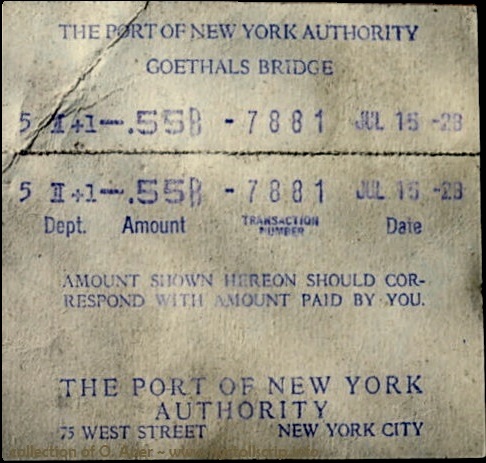 |
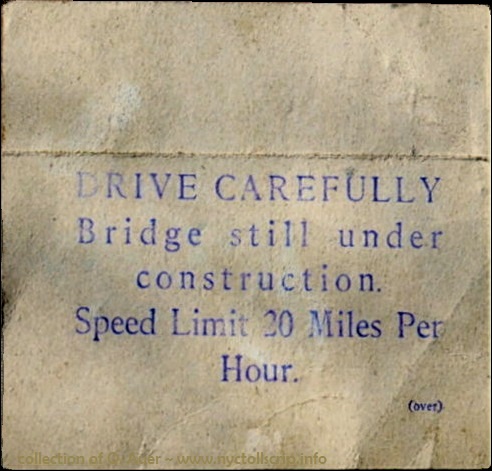 |
Goethals
Bridge Prepaid Class Ticket (Class II
+1) - July 15, 1928
(dimensions
unknown but believed to be identical to Holland Tunnel ticket
above.
Also note this ticket is marked for the Port of New York Authority.)
O. Auer
collection |
| Vehicle
Type |
Group
# |
Rate |
| Motorcycle |
I |
0.25 |
Passenger
Automobile,
with a capacity up to 7 passengers, ambulance or hearse |
II |
0.50 |
additional
passengers added to base toll,
over and above driver at Goethals, Outerbridge & Bayonne Bridge only |
+ |
0.05 |
Bus,
(up to and including 29 passenger seating capacity) |
III |
1.00 |
| Truck,
up to 2 tons |
IV |
0.50 |
| 2 ton+
to 5 ton Truck |
V |
0.75 |
| 5 ton+
to 10 ton Truck |
VI |
1.00 |
| Trucks
exceeding 10 tons capacity and not exceeding 15 tons Gross Weight and not exceeding 12 tons axle load |
VII |
2.00 |
| Vehicles
admitted by special permit, only |
VIII |
Special* |
I believe this charge for extra passengers would be
eliminated in 1932 making all passenger automobiles a flat 50 cent rate and to match the Holland Tunnel toll schedule.
Now, the article is written quite clearly that the car is a base rate and each occupant to be considered an additional 5 cents.
Confusing matters is on the very next day, another article states 25 cents per car, 5 cents each passenger, and $1.00 per truck.

courtesy of the New York Times Digital Archives |
|
To the best of our knowledge, the June 29 article gives the
correct toll rates. Previous articles (not applicable to the tolls)
show the regulations for using the bridges were released one or two at
a time and revised over several New York Times articles.
Commutation books were first considered not long after opening on
August 29, 1928. Apparently, the PoNYA was dilly dallying as they were
still considering it by way of a survey on January 14, 1930. I
have not yet found the results of this survey.
Adding to this, I have also located a New York Times article
dated March 12, 1932, in where the toll rates were to be adjusted with
a reduction on April 1, and the rates announced for the combination rate and not to be confused with the commutation rate, which is also discussed.
A
"combination" rate was offered to drivers who found themselves needing
to use two crossings in the same trip, for example the Bayonne Bridge
and the Outerbridge Crossing or Bayonne Bridge and the Goethals or the
Bayonne Bridge and the Holland Tunnel (and in either direction).
There is something else about this particular article that I took
note of. The line "Passenger Cars will play a flat rate of 50 cents,
against 50 and 60 cents, respectively, for single and two seated
passenger cars at the present. So it appears the Port of New York
Authority experimented once again with the passenger car toll
between 1928 and 1932.
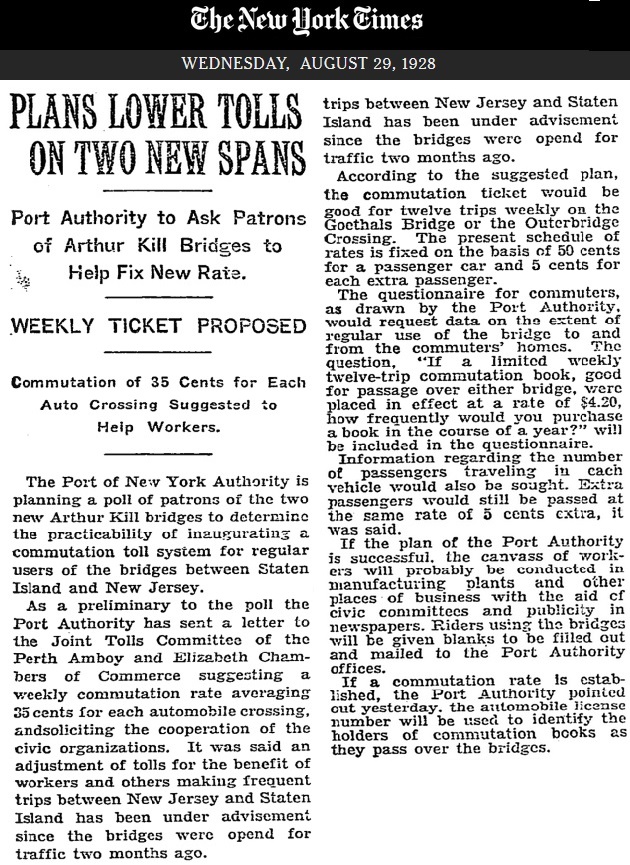 |

|
 all courtesy of the New York Times Digital Archives all courtesy of the New York Times Digital Archives |
The Port of New York Authority soon added the George
Washington Bridge and the Lincoln Tunnel to its operations as
each crossing opened.
The PoNYA was also responsible for the operation of many of the shipping
terminals, as well as LaGuardia and Idlewild / J. F. K Airports as
each opened.
Speaking of the George Washington Bridge, I uncovered this
little factoid in the New York Times Digital Archives. It was suggested
that the new span being built carry the name Verrazano Bridge upon
completion! Sorry Mr. Coppola, but it would not be for another 33
years..
The
Port of New York Authority would eventually being renamed the Port
Authority of New York and New Jersey in 1972, to better reflect the
bi-state operation.
Frankly, I think New Jersey did not like its name being left out,
the bunch of whiners! Hell, they have been trying to steal the
Statue of Liberty from New York for decades! LOL - just kidding
Jerseyites! ☻
Port of New York Authority Scrip
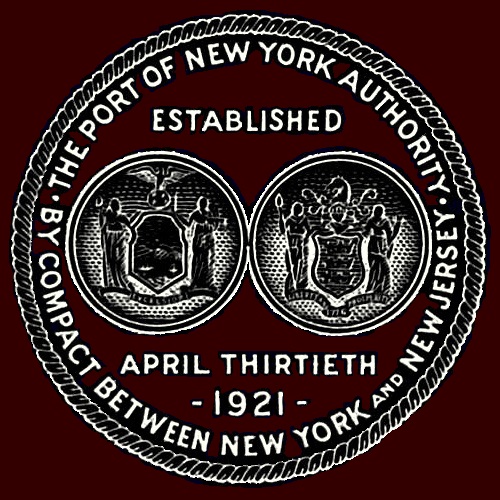
the
Seal of the Port of New York Authority
|
The
First Scrip Issue for New York
and a primer of the design intricacies
The
first known prepaid toll scrip (as opposed to a ticket to be issued at
the time of admittance) for the interstate crossings in the
New York Metropolitan Area, is the TS series of 1935 issued by Port of
New York Authority. It is presumed TS stands for "Toll Scrip".
In the preparation for creating this website, my research
on the web revealed a piece of this scrip to be displayed in the
Hoboken Historical Museum, where it is stated:
"While
undated, toll scrip was not issued until August 9, 1951."
As best as my research has uncovered, this description is blatantly
incorrect. Multiple facts that contradict that statement are known,
and are as follows:
- The
Twenty-Five Cents scrip in my collection, marked Series TS1-1935,
clearly lacks Lincoln Tunnel in the list of crossings on the face. This
makes perfect sense, as the Lincoln Tunnel did not open until December
22, 1937, and thus with the scrip being issued two years prior in 1935.
(The
next denomination in that series, Fifty Cents, Series TS2-1935, does
list the Lincoln Tunnel as do all other subsequent issues of scrip.)
.
- The
25 cent script (and the intaglio plates) carry the facsimile
signature (in lower right corner) of John E. Ramsey, who held the
position of General Manager of the Port of New York Authority, from
1926 through 1942. It was not until 1942 that Austin J. Tobin
became executive director, and of whom would hold the position until
1972.
.
- Furthermore,
it is within the Port of New York Authority annual reports themselves
dated 1932 and 1933, that state tickets and scrip were created in
those discussions covering "continuation tickets" and in 1933 with
the issuance of toll scrip.
.
- As
Austin Tobin commenced holding his position of Executive Director
beginning in 1942, and that this date still predates the statement "not
issued until August 9, 1951."
.
- The
50 cent note seen below which is overtyped War Department Vehicles. As
the War Department was dissolved in September 1947; this note had to
have existed and been issued prior to that date, and just as obviously;
issued before the (erroneous) stated issue date of 1951;
.
- And,
then there is the New York Time article at right, dated
December 31, 1934.
Also to be considered, is that appointment date
(1942) of Austin J. Tobin to executive directorship; many of the notes
dated 1935 (and with the exception of the 1951 and 1960 dated scrip)
obviously must have printed after 1942 for his name to even be listed
in that position on that note!
Furthermore, reading the New York Times article at right
carefully, also reveals that the 1935 issue of scrip replaced pre-paid
class tickets which would be treated at toll scrip and accepted at face
value regardless of the class it was issued for. So, there was an issue
of pre-paid toll payment prior to the scrip issues of 1935.
So
with all things being said, the Hoboken Museum's description is
erroneous and needs correction. I have sent them numerous emails, but
to no response nor any revision on their website has been forthcoming.
And this is yet another reason why I felt it was necessary
to get this website published.
|
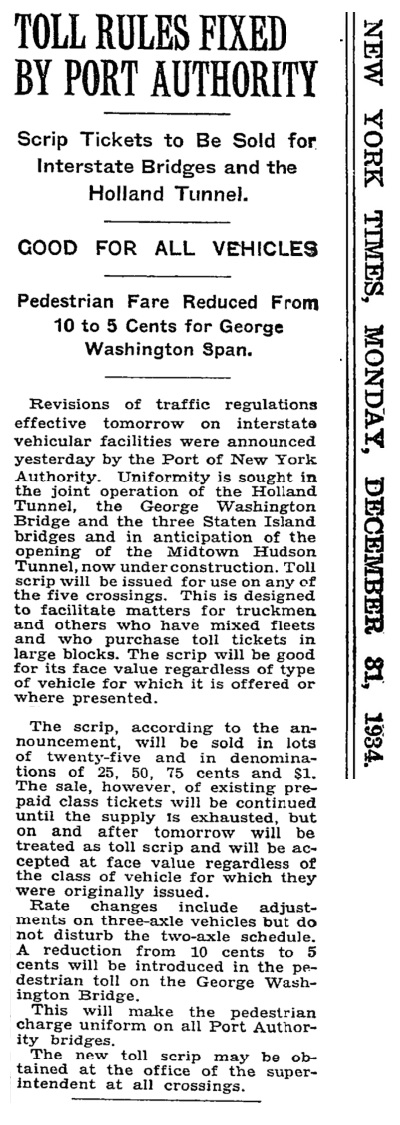 |
Please
note:
Before we progress further, you will notice I have displayed
the issues grouped by denomination, not
by issue year (1935, 1951, 1960, etc). I have organized them in
this fashion, so as to more easily show the differences of design
between issues of the same denomination, instead of the reader having
to scroll up and down this page to compare.
|
Here is where the scrip history gets interesting
and is probably going to be a learning curve for all of us.
Note the Series TS1 - 1935 on the twenty-five cent; then
TS2 - 1935 on the fifty cent, TS3 - 1935 on the seventy five cent,
etcetera, etcetera. The Series TS number advances from TS1 to TS2 to
TS3 based on the denomination, not the year. The date remains
unchanged.
With the acquisition of the following Traffic Rules & Toll
Rates brochure printed by and released by the Port of New York
Authority; dated January 1, 1939; we learn there was also a $1.25
denomination of toll scrip issued. But this denomination raises a
couple of questions:
1)
What TS series did this $1.25 denomination carry, as TS1 through TS5 are accounted for, and
2)
Why the denomination of $1.25, if none of the tolls at that time were $1.25.
3) We also now can confirm the quantity of tickets in the commutation books and their respective time limits of validity.
We
can plainly see, there is a One and 50/100 Dollar ($1.50) marked
TS5-1951. This piece now confirms additional date issues.
In addition to this, a recently acquired TS1 - 25 Cents piece is marked
TS1-196o. So we know have three distinct issue dates. As for the new
design notes, we know 1969 and 1970 exist, but more about those later.
If other
years exist for the older design of the Port of New York Authority
scrip, they remain to be discovered.
So, it is safe to conclude that the TS code (TS1, TS2, etc) denotes the
denomination (and not an actual series year):
TS1 = 25¢
TS2
= 50¢
TS3
= 75¢
TS4
= $1.00
TS?
= $1.25
TS5
= $1.50
TS7
= $3.00
It is unknown at this time if TS6 exists - but it is believed to, and
the denomination should be in the $1.75 to $2.75 range.
And so, it
is the year that follows the TS number, which in fact denotes the series issue:
1935,
1951, 1960,
and 1969, 1970 (newer Statue of Liberty design)
.
One of the oddities of this brochure is it mentions a $1.25
scrip, but as we will see, from the next official document, none
appeared to have been issued.
.
The 1953 Toll Scrip / Toll Ticket Brochure:
Towards the end of June 2023, the following document appeared on eBay.
As I am sure you have figured out by now, I had to own it and fortunately for me the seller listed it with a Buy It Now.
Other than
actual examples of scrip; it has instantly become one of my favorite
things in my
collection. Not only does it contain visual representations of the
scrip, but it explains in detail the use and book quantity of each issue. I could not
ask for a more informative representation without a time machine!
It is dated November 1953 and obviously, the pages were 3 hole punched, but never put in a
binder. It was then bound with the heavy cardstock covers seen below
and stapled. At some point, the staples were removed, thereby making it
easier for me to scan here.
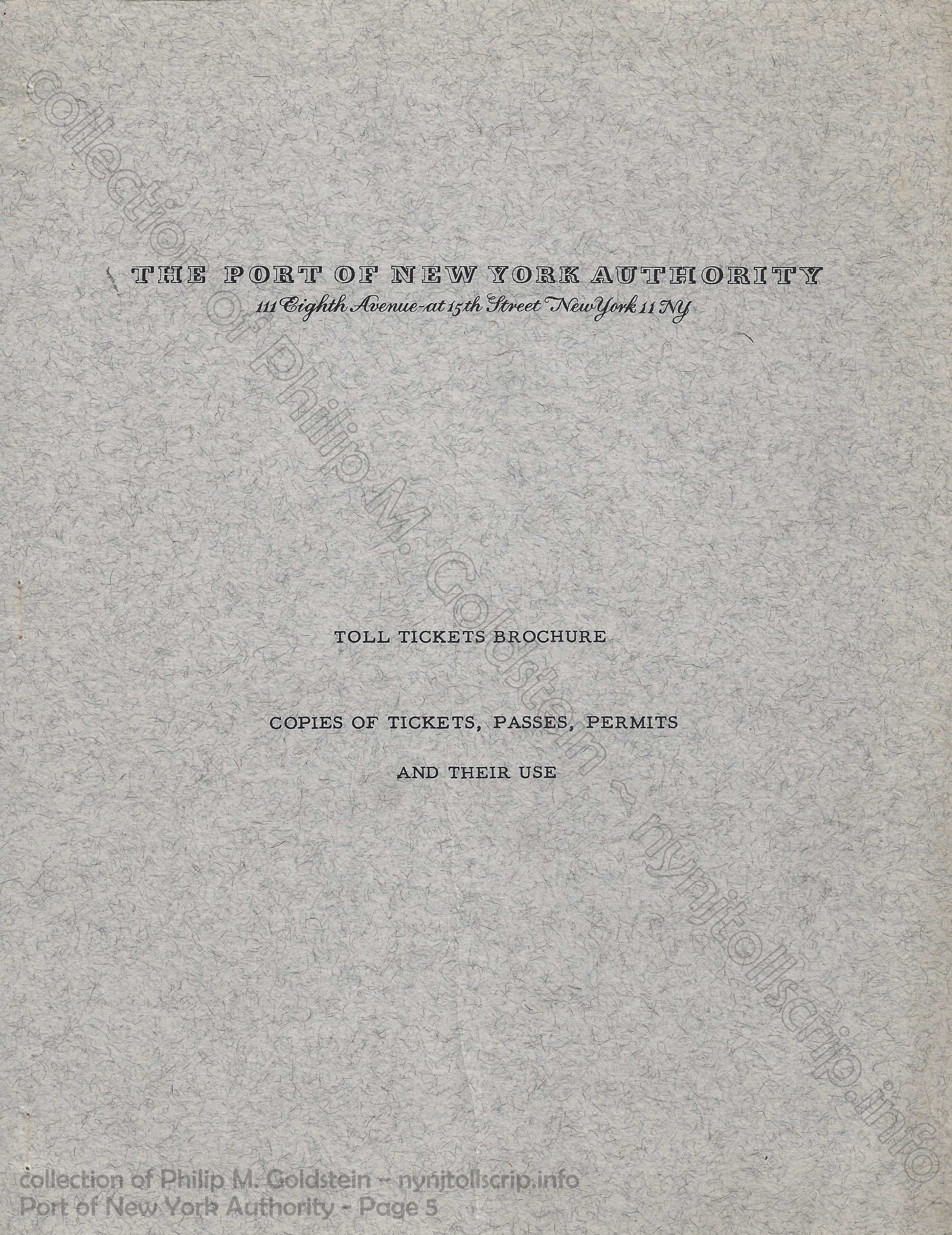 |
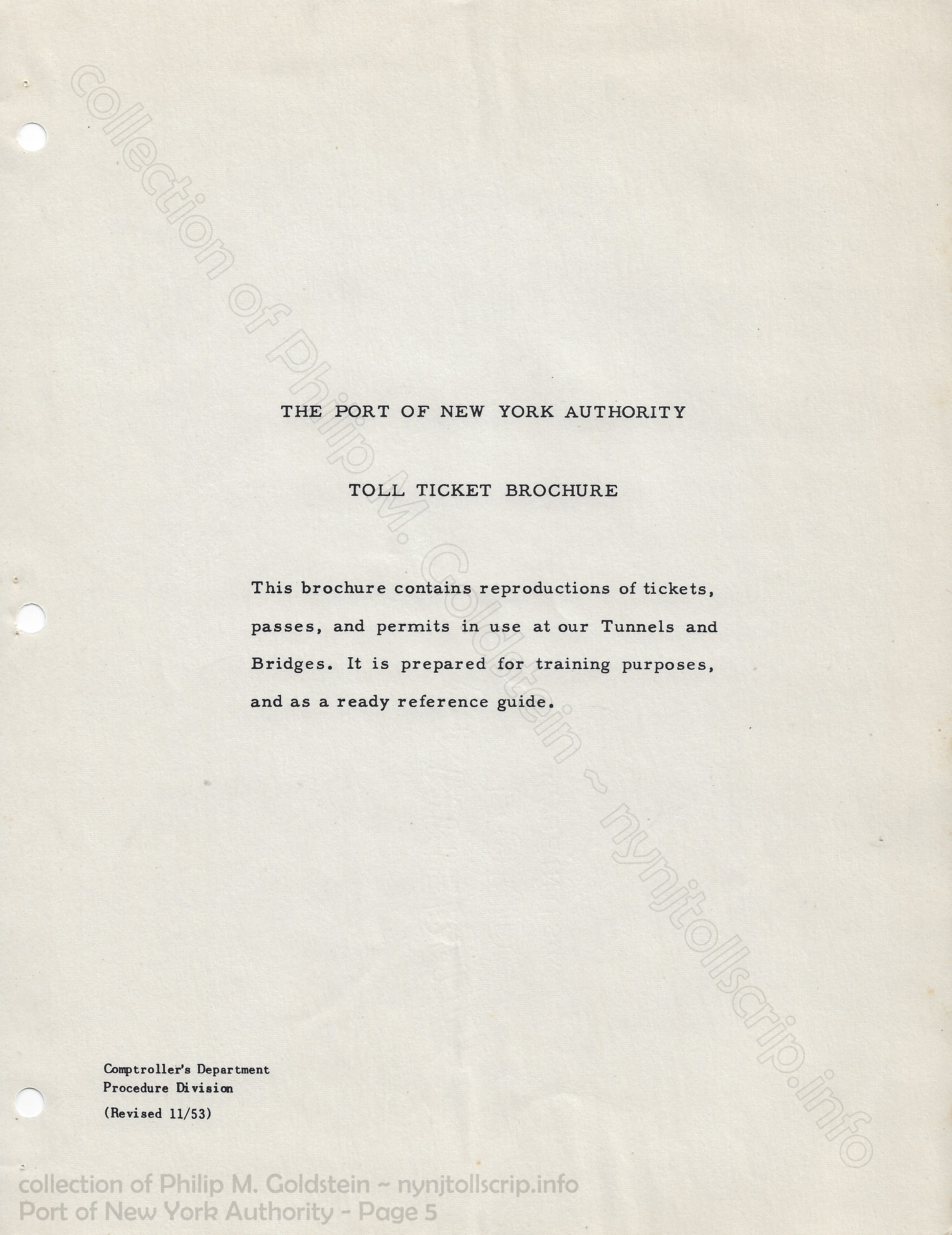 |
front cover
Port of New York Authority Toll Tickets Brochure - 1953
|
fly sheet:
Port of New York Authority Toll Tickets Brochure |
| . |
|
 |
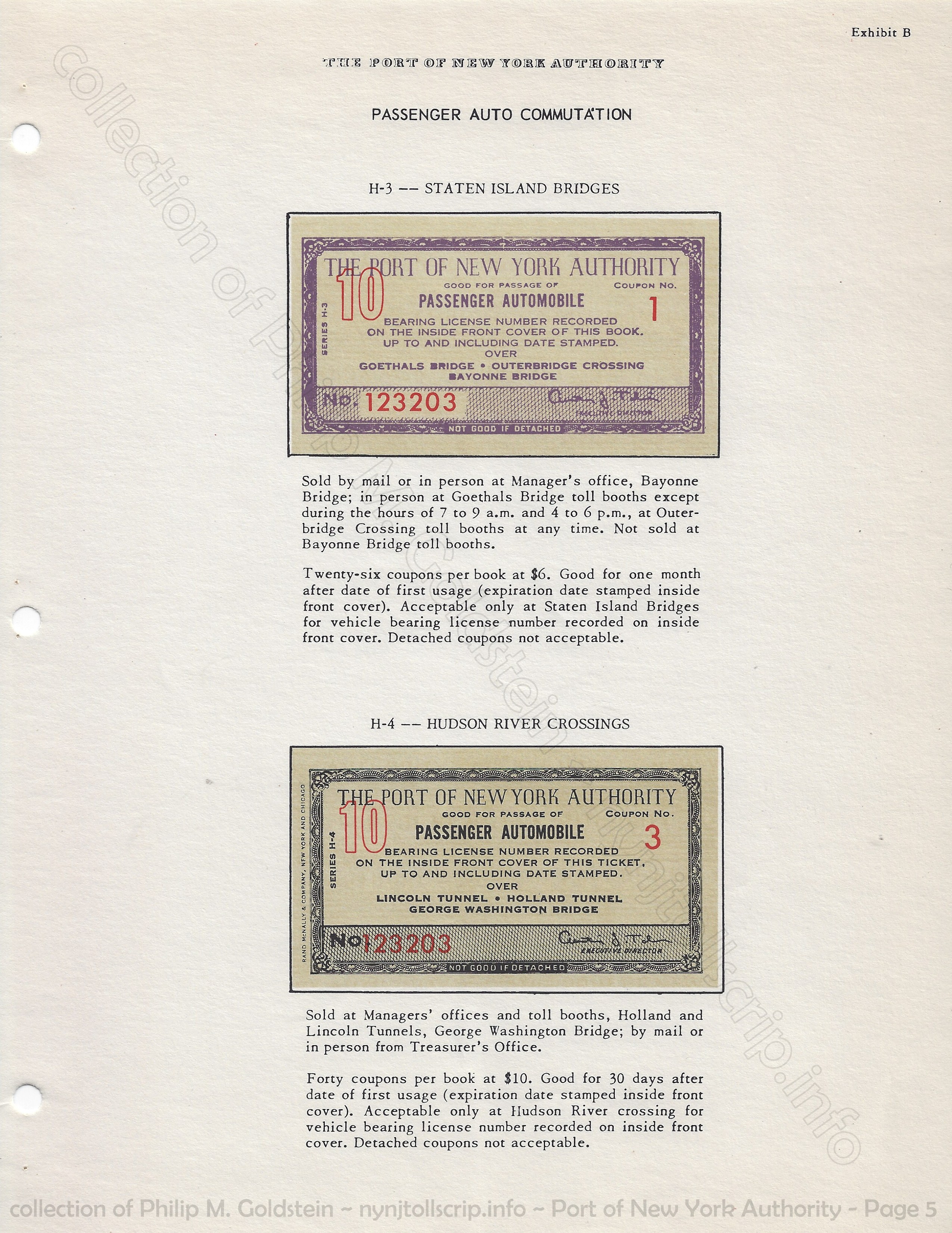 |
TS Series: (denominational issues)
- TS-1: .25 TS-2: .50
- TS-3: .75 TS-4: $1.00
- TS-5: $1.50
|
Series H - Passenger Auto Commutation Issues
- Series H-3: Staten Island Crossings
- Series H-4: Hudson River Crossings
|
| . |
|
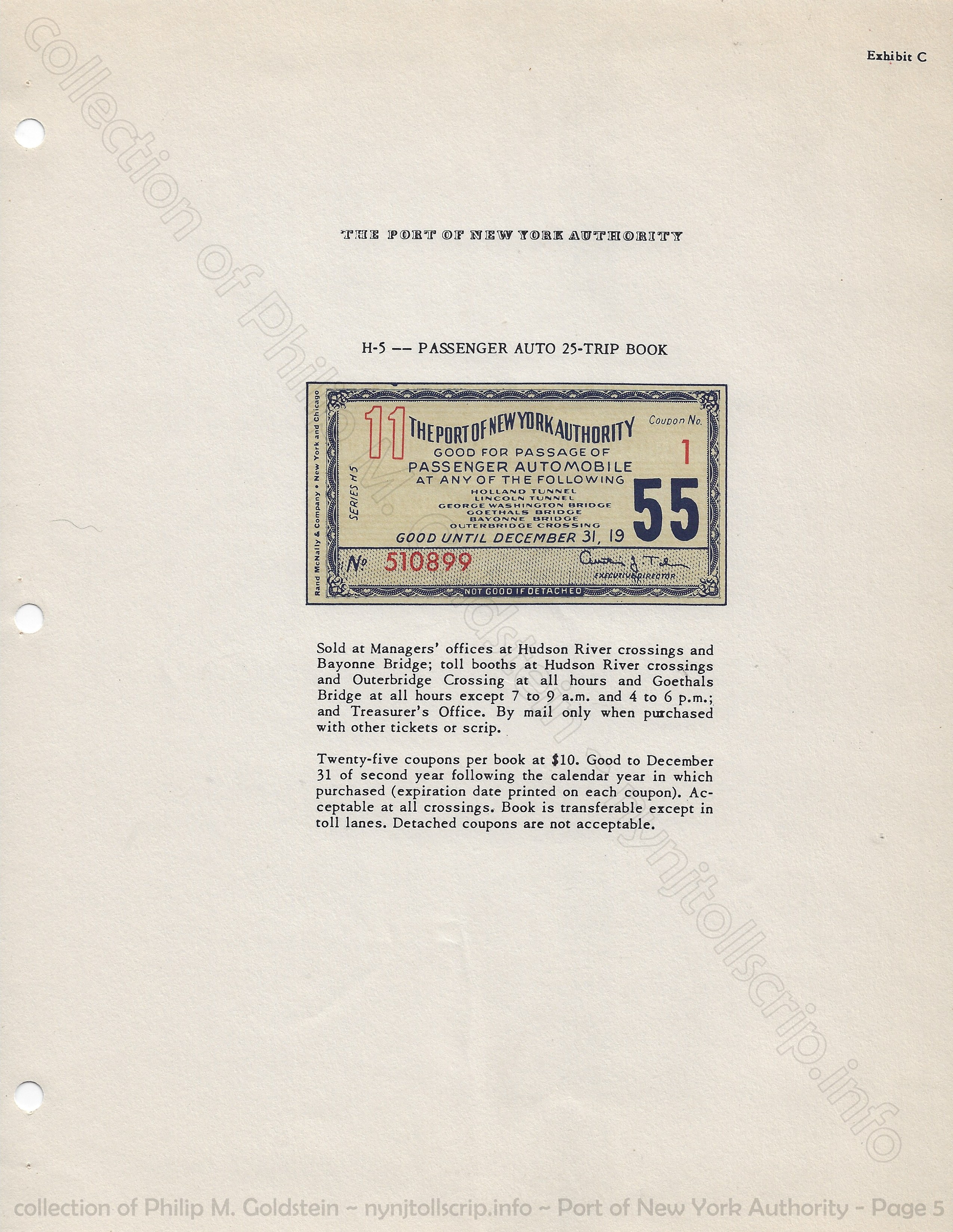 |
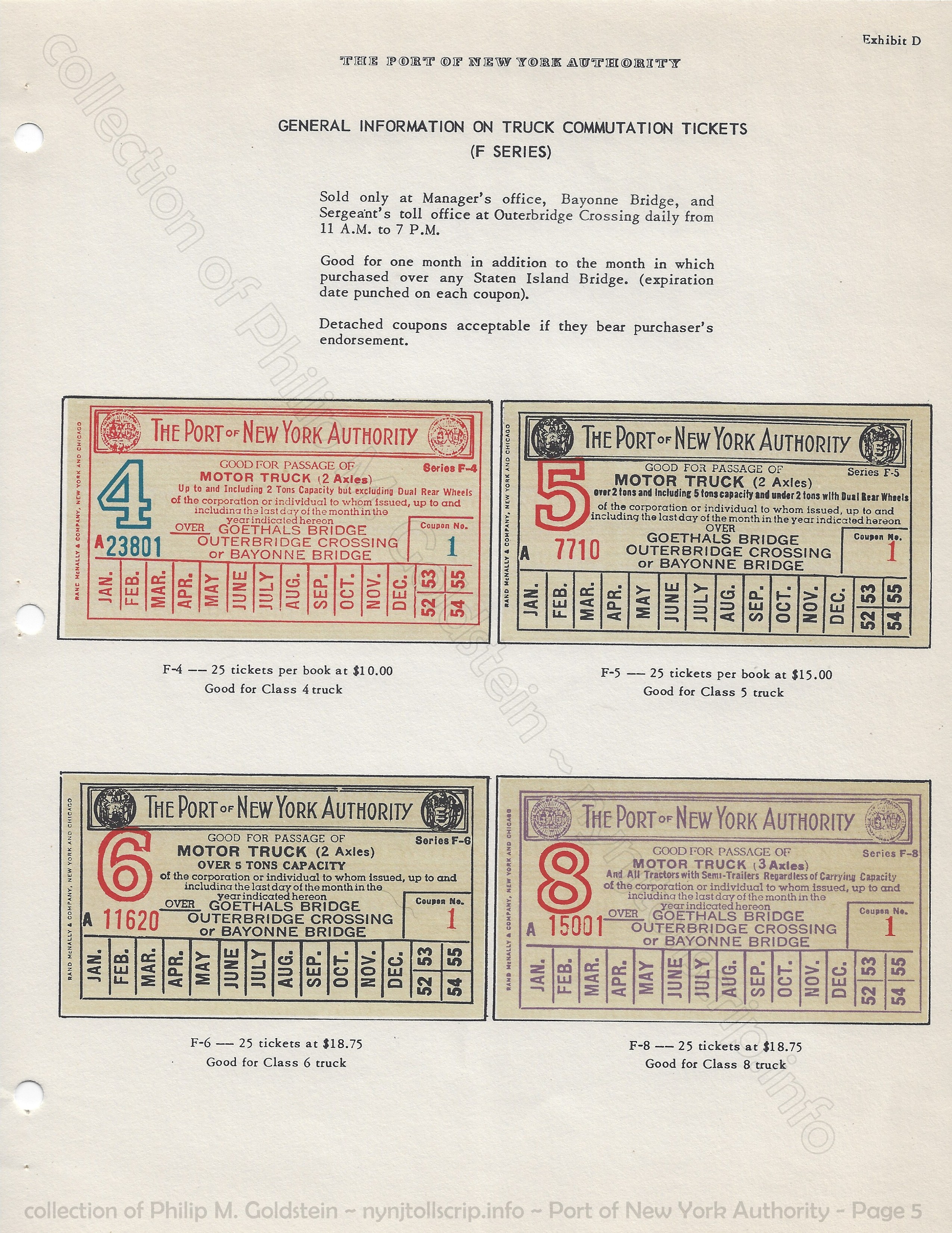 |
Series H (continued)
- H-5: Passenger Auto $10 - 25 Trip Book
|
Series F
- Series F-4 (Motor Truck 2 Axles, up to 2 tons) - Series F-5 (Motor Truck 2 Axles, 2 to 5 tons)
- Series F-6 (Motor Truck 2 Axles, over 5 tons) - Series F-8 (Motor Truck 3 Axles, tractors with semi-trailers)
|
| . |
|
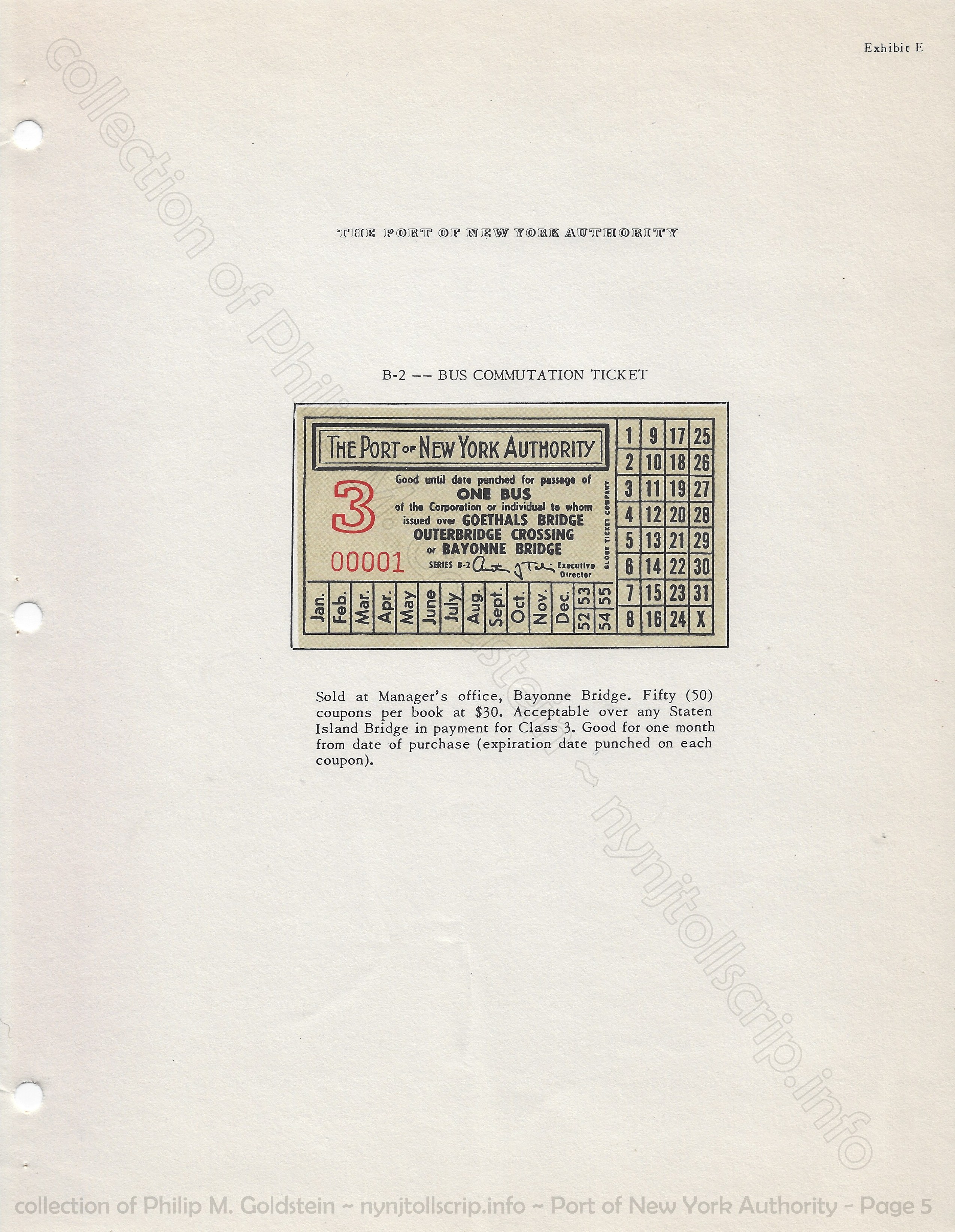 |
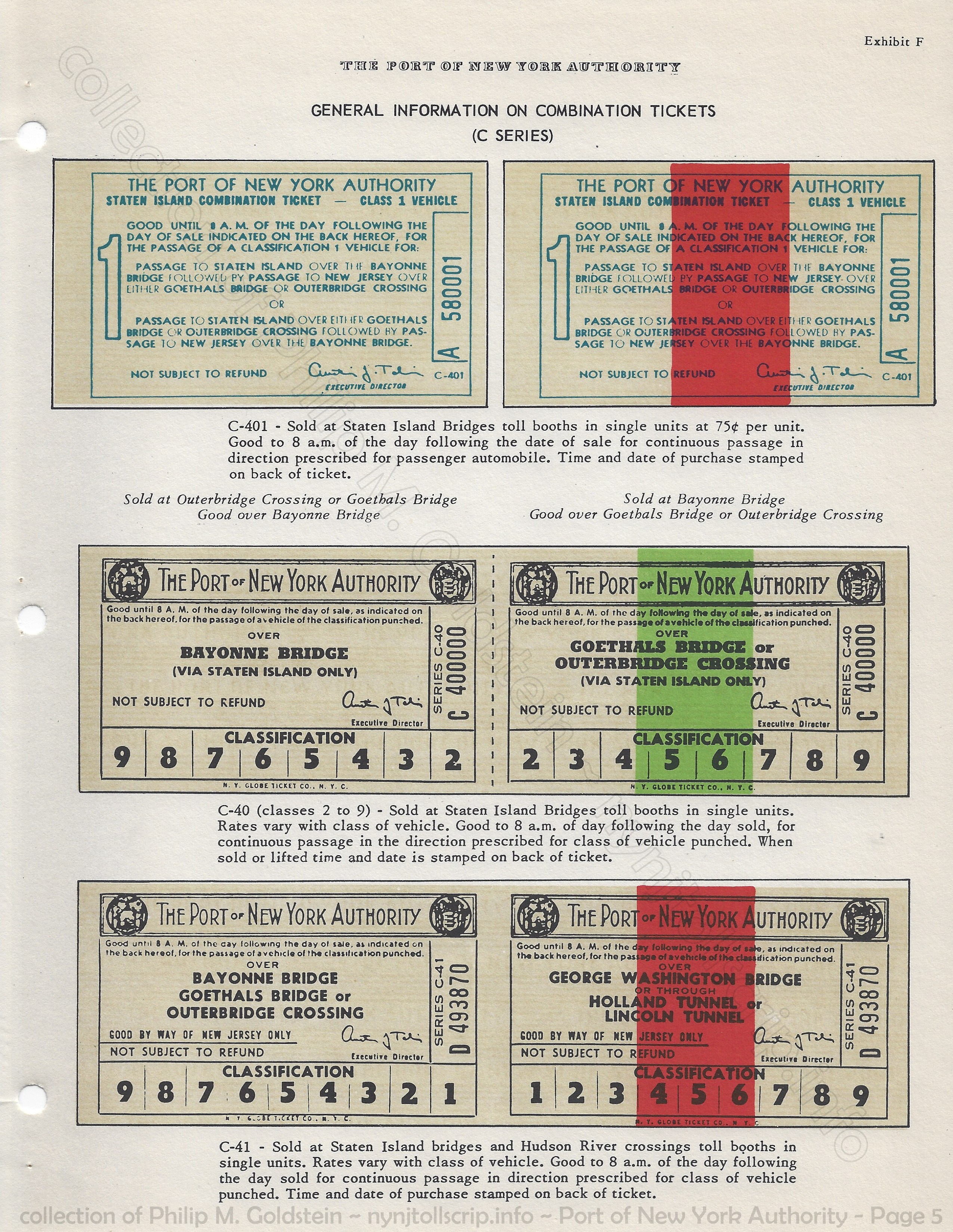 |
Series B - Bus Commutation Ticket
- Series B-2: One Bus, Staten Island Crossings
|
Combination Tickets - Series C
- Series C-401: Staten Island Combination Ticket, Class 1 vehicle only
- Series C-40: Staten Island Combination Ticket, Class 2 - 9 vehicles only
- Series C-41: Hudson River and Staten Island Combination Ticket, Class 1 - 9 vehicles
|
| . |
|
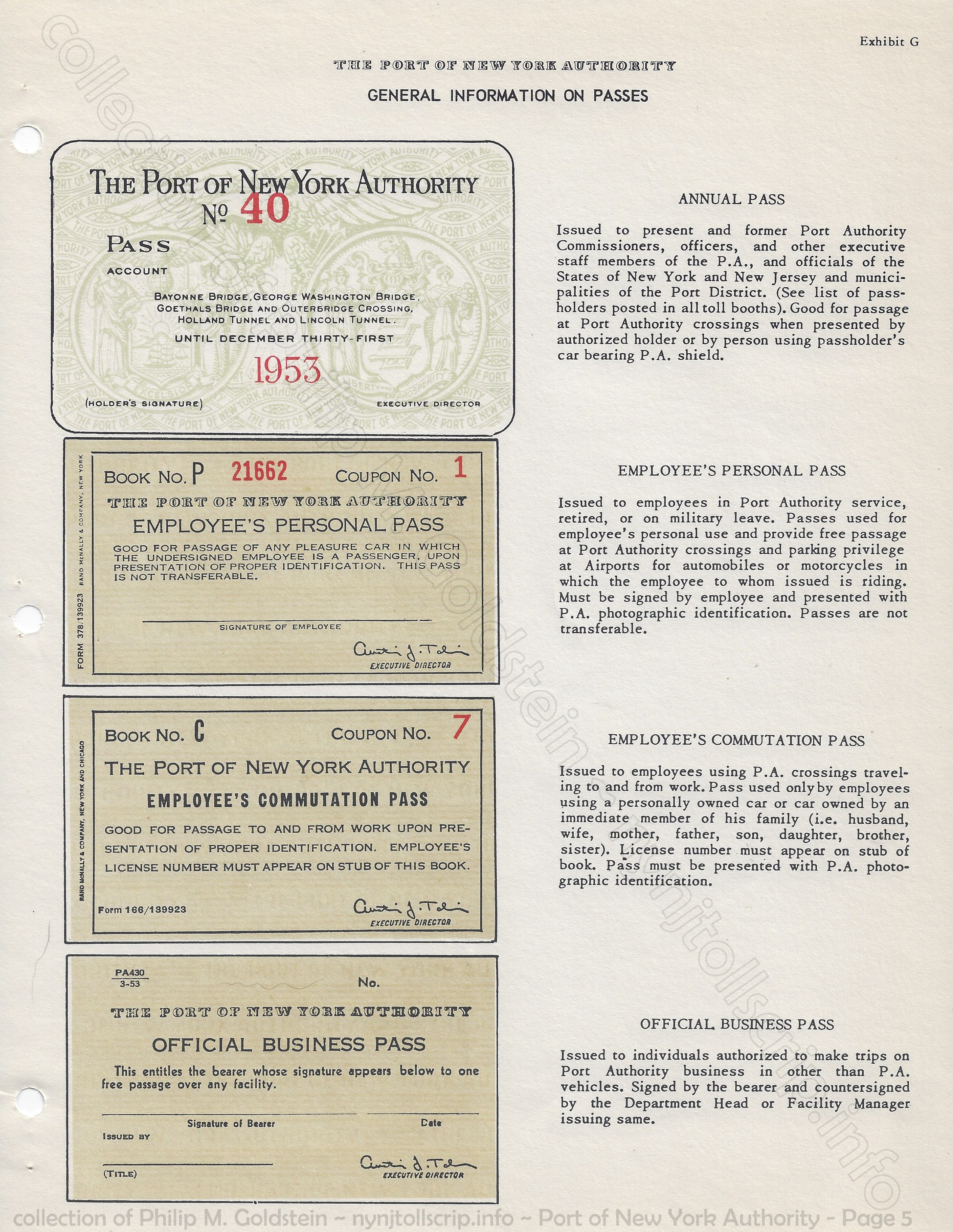 |
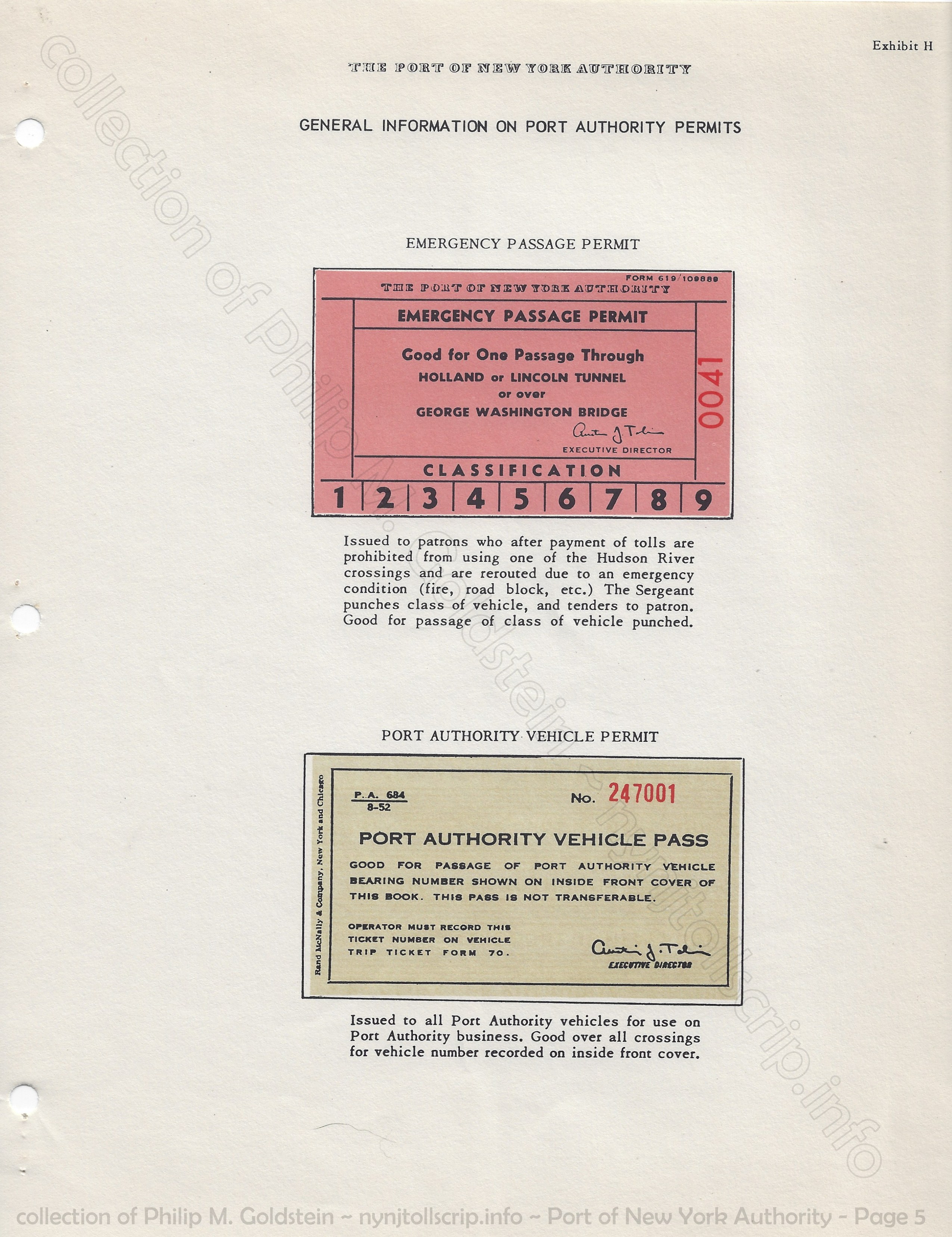 |
|
Passes
Annual Pass for present & former PA commissioners, executives, and executive staff
- officials of States of New York and New Jersey
- Book P: Employees Personal Pass
- Book C: Employee Commutation Pass
- Official Business Pass
|
Permits
- Emergency Passage
- Port Authority Vehicle Pass
|
| . |
|
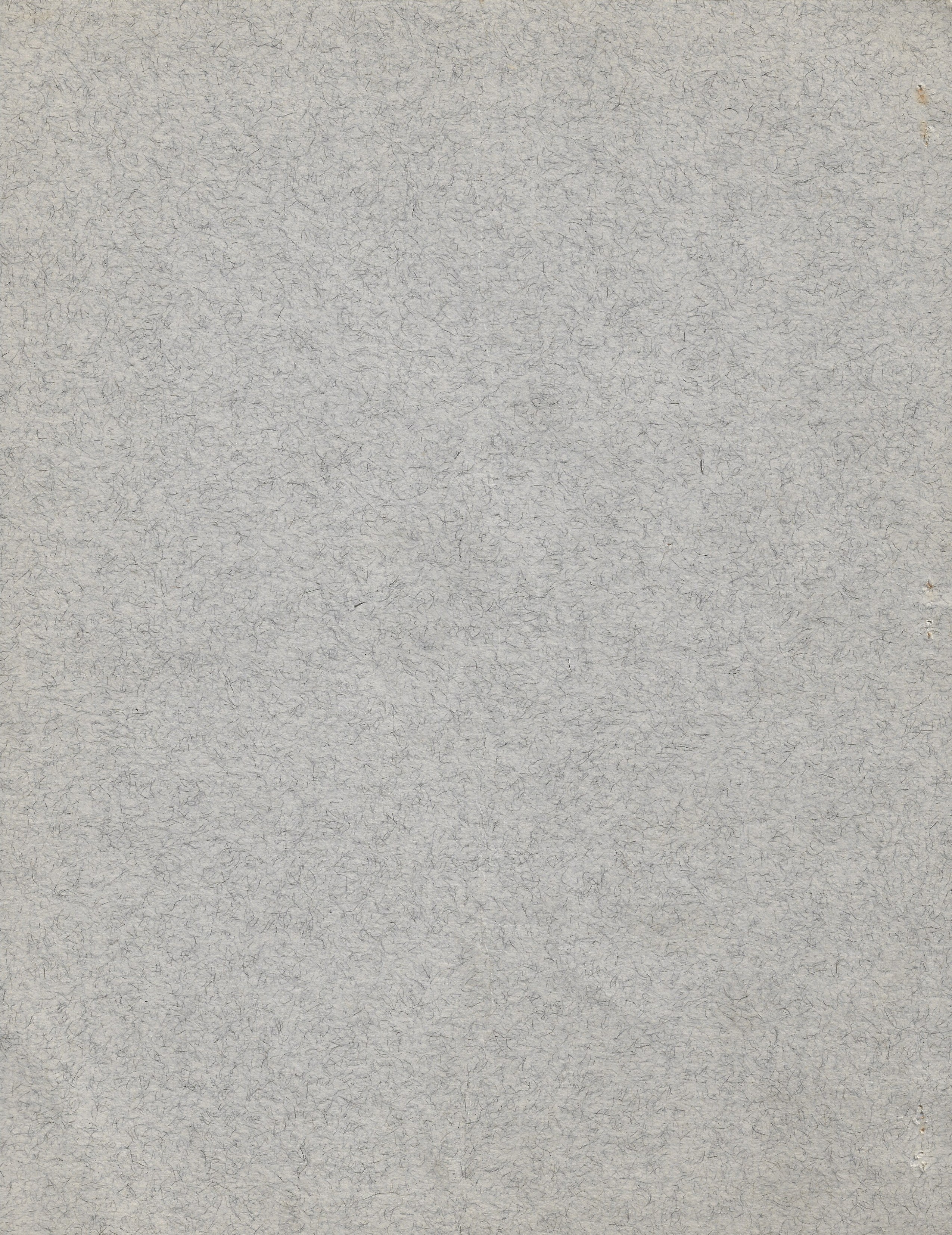 |
Printers:
The
printer observed for most of the TS series, was none other than the
renowned publishing firm of maps and atlases, Rand McNally; as these
issues carry their name in one form or another.
Their name is seen on the front left edge of note parallel
with perforation as "Rand McNally & Company, New York &
Chicago". It then appears to have been relocated to the back bottom of
the note. Then we see a simple "Rand McNally" in this location.
Finally, one series of notes does not have their name at
all; leaving the question open as to whether Rand McNally printed this
series at all.
Coming to light in March 2020, are a set of steel plates
for the Port of New York Authority scrip in .50, .75 and $1.00
denominations. Only the $1.00 plate is engraved "Security Banknote
Company". These plates were sold at an auction in 2008. These plates
yield a bit of other information to us, to be discussed later.
As for the Commutation Issues; most are printed by Rand
McNally as well, however at least one series: Series F-4 1934/1935 is
known to have been printed by another firm: International Ticket.
Intaglio & Offset
Lithography
There
are two known printing methods for the Port of New York Authority
scrip. The first is known as intaglio printing (pronounced
in-TAH-lee-OH - the "g" is silent. And after all these years, I find
out I've been pronouncing it wrong! )
Intaglio printing is
accomplished by intricately engraved metal plates usually made of
steel, but copper can be used also. As copper is softer, it is not
as durable as steel plates, but is suitable for lower quantity runs.
The image design and lettering is engraved in reverse or negative on
intaglio plates. When run through a printing press, the image when
transferred directly to paper, and therefore is now a positive image.
It gives the ink on the notes a slight relief (raised) feel, and also
results in very crisp designs. Intaglio engraving is also an expensive,
time consuming process; taking hundreds of hours of engraving per
design. And one slip or error, the plate can be ruined and needs to be
redone or at least hours of extensive repairs performed. This is the
method of printing used for United States currency (paper money)
as well as many other countries throughout the world. The intricacies
of the design and the texture or "feel" of the printing make it
difficult to counterfeit and the plates are durable for millions of
impressions.
Until the intaglio printing plates were seen in an old auction
catalog, the printer was unknown. With their discovery, we can now
determine the intaglio printed notes were produced by Security Banknote
Company.
The other printing method known to have been used in
printing the scrip, is the offset lithography process. Offset
lithography printing is a method of mass-production printing in which
the images are etched in negative onto a thin metal plate by a
photographic and chemical process. Once the metal plate is installed on
the press; the process utilizes the immiscibility
of oil based inks and water based "fountain" solution - the image
etched on the plate which will hold the ink, and the unprinted
area or "unetched", which does not. This is then transferred
(offset) to rubber blankets or rollers and once again to the print
media (paper). The print media, usually paper, does not come into
direct contact with the metal plate as it does in the intaglio process.
This
lithographic process is much cheaper and less labor intensive for
documents and printed matter of mass production but of a disposable or
replaceable value. Most of the "quick print" shops that existed and
some still do today, are based on this offset process. This was all
prior to the advent of cheap color copies and stores that offered mass
production printing such as Kinkos, Staples and OfficeMax.
To date, the lithography printed script is either marked
Rand McNally, International Ticket Company or unmarked for printer.
Delving
further into the intricacies of the designs of Port of New York
Authority scrip, there are many unique features of the TS1 - 1935 25
cent note that bear pointing out, when compared to notes of following
series:
- Only the Series TS1 - 1935 notes is known to
have been printed via the intaglio method.
.
- The
facsimile signature in lower right corner is believed to be that
of John E. Ramsey, who held the position of General Manager of the Port
of New York Authority, from 1930 through 1942. It was not until 1942
that Austin J. Tobin became executive director, and he held the
position from 1942 – 1972. His signature appears on Series
TS2 50 cent and all subsequent denomination issues.
.
- The
Series TS1-1935 (on right edge of note) has the same color red ink as
the serial number. As the serial number (as well as any additional
colors (if any) in the design would be printed by numbering machines in
a second "pass" of the uncut sheets of notes through another printing
press. It therefore appears that both the serial number AND Series
TS1-1935 was imprinted after the main printing of the note. (On
subsequent issues, the series number and year is the same color as main
face printing of the note and therefore the series &
year appear to have added to the main design, with only the red
serial number being added in a second pass.
.
- Only this TS1-1935 issue is printed on light card stock -
measuring .010" thick. (Paper
thickness is .005" on all following lithography issues.)
The
Printing Plates from the Security Banknote Company
As I scour the web and encounter old auction catalogs, I am sometimes
rewarded with nuggets of history. On March 11, 2020; I encountered the
following set of plates for three of the four denominations of Port of
New York Authority Toll Script that had been auctioned by Stacks Bowers
in February 2008; and formerly of the Rich Uhrich collection.
From these intaglio plates, we glean these design details:
1. There were
intaglio issues for .50, .75 and $1.00; and while the plate is not in this
auction, the .25 intaglio note in my collection confirms one existed.
.
2.
These plates were for the earliest issues as they carry John E.
Ramsey's signature as general manager, and of whom held that
position from 1930 to 1942;
3.
As the Lincoln Tunnel is listed on these plates (but not on the
25 cent note in my collection), it is presumed these plates were
engraved in 1936 or 1937 prior to the opening of, and to
include the Lincoln Tunnel on the
scrip issues. This
now leads us to conclude a prior set of plates also existed, without
the Lincoln Tunnel and bearing the legend Interstate Crossings
(used prior to the Lincoln Tunnel opening and which would have been
used for printing the 25¢ in my collection).
.
4. The design intricacies of
these
three plates: 4 lines per "ray", rays extending to the border, and
the "crowns" flanking the written out denomination,
and matches those details on the
.25 note in my collection;.
.
5.
However, while the security field design is the same
amongst the .50, .75 and $1.00, it is different from the .25 note.
The
.50, .75 and $1.00 security fields have lenticular ovals
(footballs), triangles and six pointed stars. The .25 uses a
circle, square, and diamond security field.
Unfortunately,
it appears the back plates were not included in the sale, but is
presumed to be the guilloché back. I would like to ask whomever
currently has the privilege of owning these plates, please get in touch
with me at bedt14@aol.com
and as I would like to the opportunity to acquire more images of
the plate design (backs, sides, dimensions).
 |
 |
|
courtesy
of Stacks Bowers auction catalog; Rich Uhrich
collection; February
27, 2008
(shown slightly enlarged)
|
Other details now
observed are different geometric security patterns for the signature field. As
of January 2020, four different security designs have been observed:
- the circle, square &
diamond design has only been seen on the .25 cent intaglio note
- the
lenticular ovals (footballs), triangles and six pointed stars on the
.50, .75, and $1.00 notes, as seen from printing plates in previous
chapter.
- the crescent,
wedge & line; as well as
- the cross
design
Furthermore, these designs are broken down:
- notes without
GOOD UNTIL USED have been observed in the following combinations:
- intaglio
with circles, squares & diamonds security field on the .25 with
guilloché back and
- intaglio
with lenticular ovals (footballs), triangles & six pointed stars
security field on the .50, .75, and $1.00 notes with guilloché
back,
- lithograph
with crescent, wedge & line security pattern and guilloché back;
.
- lithograph
notes with (sans-serif) Optima
GOOD UNTIL USED,
cross security pattern
on the face is seen with the (serif)
Bank Roman numerals
on the back,
.
- lithograph notes with
(serif) Roman GOOD
UNTIL USED
and
crescent wedge & line security pattern on the face are now
seen with (serif)
Bank Roman numerals
AND
(sans-serif) Agency
numerals
on back.
Also take note that with the cross style security field,
there is an unprinted area conforming around the signature to help it
stand out. This "buffer zone" is not evident on the other designs.
The
following is graphic compilation of the design differences amongst the
basic issues. I do wish to emphasize; there is a very good likelihood
that despite my attempt to account for the design
differences chronologically, the differences may have occurred
within date groups and as scrip was reordered as a result
of attrition over time.
If this is the case, then the "year" issues will have
multiple printings which will exhibit the variances. This remains to be
confirmed or disproved as more notes surface and are cataloged.
Also please note that names of typefaces / fonts used in
descriptions are the closest approximation found in typeface catalogs.
Signatures: J. E.
Ramsey and Austin J. Tobin
As
we see on the notes, two different signatures are observed on the
various series of notes. The first signature, is that of John E.
Ramsey, and would have been in effect when he held the position of
General Manager of the Port of New York Authority. He would hold this
position from his initial appointment in 1926 through 1942.
In 1942,
Austin J. Tobin was appointed to replace him, in the position of
Executive Director of the Port of New York Authority, and the signature
on the script was changed to reflect this. He would hold this position
until 1972.
As such, we obviously see the issues of toll scrip dated
1935 but yet carrying Austin J. Tobin's signature. These
notes would have had to have been printed in, or very shortly after;
1942. Therefore those notes dated 1935, but carrying Tobin's signature;
are cataloged below as 1935 (1942). The 1951 and 1960 dated issues
eliminate this ambiguity.
Also of particular note, there are two styles of Tobin's
signature. One, with a "P" shaped cursive letter A in Austin, and a
diagonal line connecting the horizontal and vertical segments of the
letter T in Tobin. (see at right below). These differences can be
compared in the above chapter if need be. So far only notes bearing
this type of signature, are those with Optima "GOOD UNTIL USED" on
front left edge of face and with double frame back with banknote roman
.25, .50, .75 or 1.00 numerals.
The
second style (seen at left below), the A in Austin is a simple oval,
and the T in Tobin lacks the diagonal connector. This style appears on
all other Tobin era notes.

The
reasons for the differences in signature style are not known, but it
has been observed that in some cases executive secretaries are known to
have been authorized to affix their superiors signatures in
performance of official duties. It is not known for certain if this
was indeed the case. The most logical reason is, people's "flourishes"
in their
signatures do vary to some degree.
Back Design Differences on same series notes
As this research
digs deeper; it now appears there are FIVE distinct back designs
for the TS series:
- Guilloché Back, (both
intaglio and lithograph printed notes)
- Single Frame
Back with Banknote
Roman Numerals,
- Double Frame
Back with Banknote
Roman Numerals,
- Frame Back with
Agency (Square
Block) Numerals
- and Frame
Back - no numerals
|
Single Frame w/
Guilloché Back
|
Single
Frame w/
Banknote Roman (serif) Numerals |
Double
Frame w/
Banknote Roman (serif) Numerals |
Single Frame w/
Agency (sans-serif square block) Numerals |
Single Frame only
no Numerals |
|
|
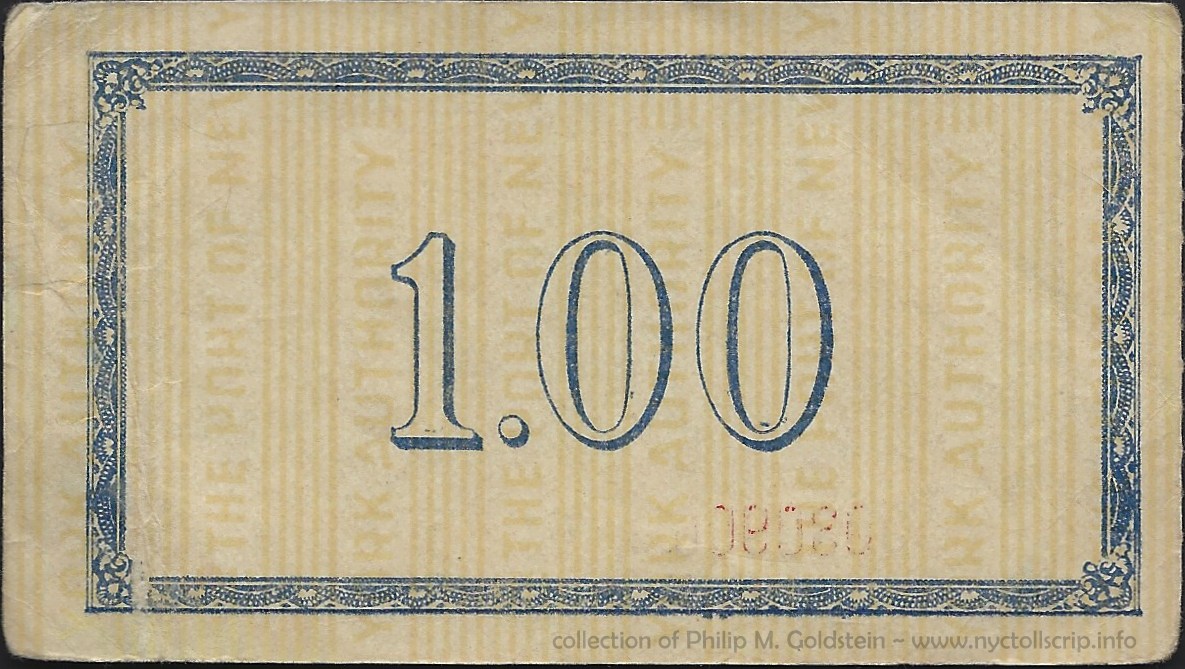 |
|
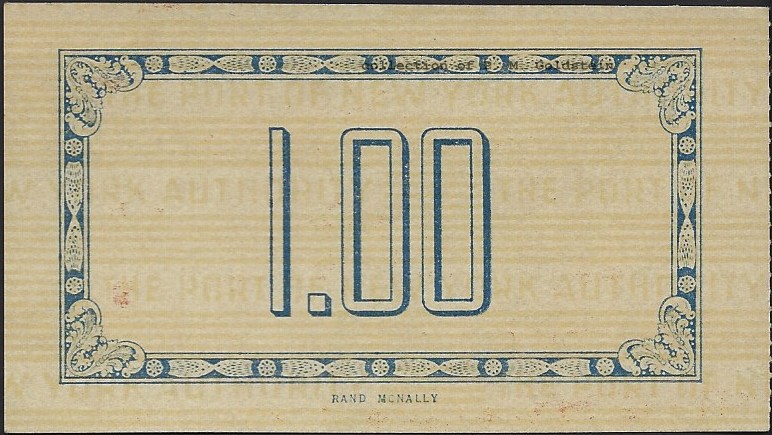 |
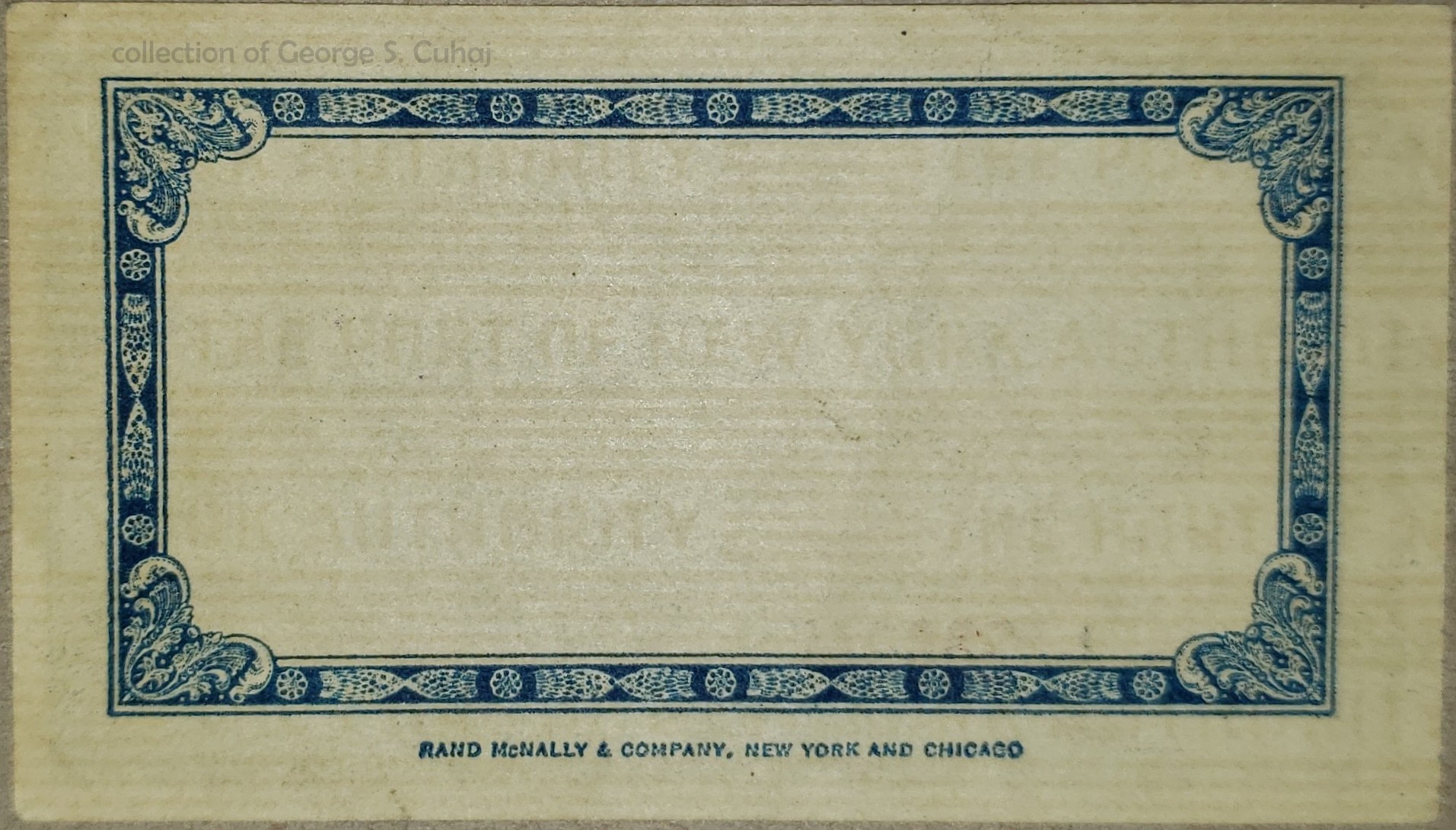 |
confirmed
denominations:
1935 - .25
- intaglio
1935 - .50 - intaglio & litho
1935 - .75 - intaglio & litho
1935 - 1.00 - intaglio & litho
1951 - 1.50 - litho
|
confirmed
denominations:
1935 - $1.00 |
confirmed
denominations:
1935 - .50
1935 - .75
1935 - $1.00
1935 - $1.50 |
confirmed
denominations:
1935 - .25
1960 - .25
1935 - .50
1935 - .75
1935 - $1.00
1951 - $1.50 |
confirmed
denominations:
1935 - .50 |
While
it was originally thought the guilloché back was exclusive to the
intaglio printed notes, my purchase of two complete books of $1.00 -
1935 and $1.50 - 1951, both of which have guilloché backs. Therefore
this is obviously
no longer the case.
The
double frame back so far, is only seen on those lithographed notes with
Bank Roman numerals in both 1935 (1942) and 1951 series, and the single
frame back with both Bank Roman numerals on 1935 series, and Agency
square block numerals on 1935, 1951 and 1960 series notes.
Security Paper
Other than the intaglio .25 in my collection, all
other notes are most definitely lithographed. Lithographed notes are
printed on security paper that carries a slightly ultraviolet
reactive printing of 5 parallel lines with PORT OF NEW YORK
AUTHORITY. This appears to have been applied to the paper prior to the
printing of the main design. This security mark is seen in both
vertical and horizontal directions, depending on the issue. I hesitate
from calling it an actual watermark as it is not viewable through the
paper, but on it.
This security mark can be seen on both the face and the back
of the note; but it is reversed on the face (meaning it appears as if a
mirror image on the face). The printing is seen with more ease on
the back of the note, due to the large unprinted areas. I have
recreated the security underprint and darkened it for review:
| Security
paper for lithographed TS Series 1935, 1951 and 1960 notes: |
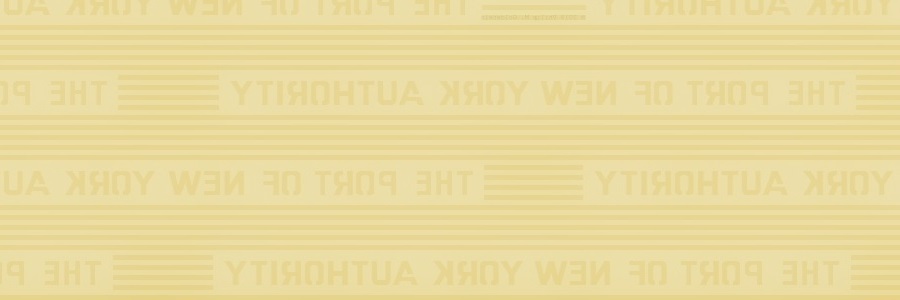 |
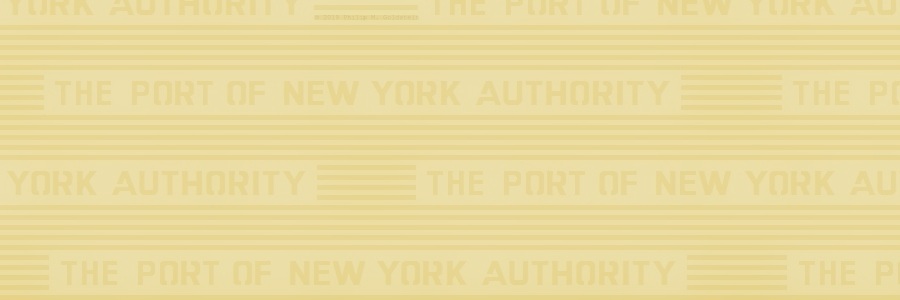 |
| (as
it appears on the face of the note) |
(as it appears on
the back of the note) |
For the Commutation Issues, both the Port of New York Authority
security paper above is seen, as well as one other: that bearing the
mark of National Safety Paper as seen
on the Series F-4 - 1934/1935 Motor Truck, 2 Axles, up to and including
2 tons as printed by International Ticket Company, Newark, NJ.
| Security paper for
lithographed F-4 Series Commutation Issue for 2 Axle Trucks 1934/35 notes: |
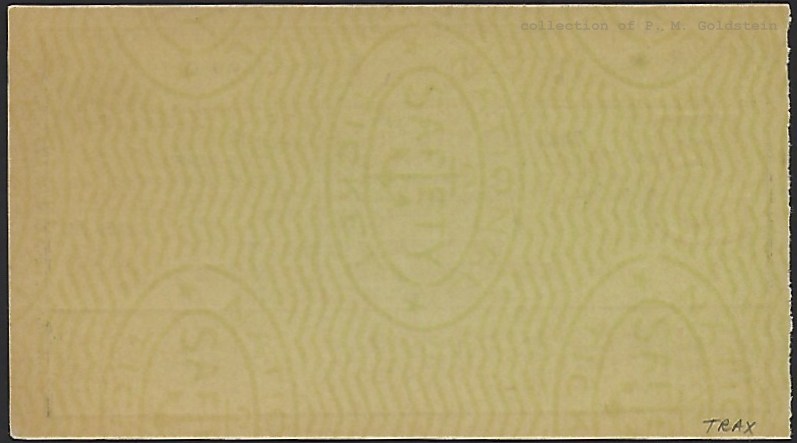 |
| (as
it appears on the back of the note) |
Overstamped / Overtyped
/ Perforated Issues
Another interesting variety of, and seen on scrip; are those
issues that have been either typed upon or overstamped with an operator
name; or in some cases perforated for a specific user. These were in
all likelihood; done so by an employee of a trucking or bus firm so that employees did not
use company issued scrip for their personal use in their private
automobile.
Judging from the crudity and different fonts used in the
various stamps, it appears that in the cases of trucking and bus
companies the company themselves applied their overstamp to each issue,
not the issuing agency (TBTA or PANYNJ).
In the
case of military overstamps or perforations, this would also apply so a
service member could not use government issued scrip for personal use;
but even more so, it is known when tolls were first collected, military
vehicles (as well as vehicles of Police and Fire Departments) passed
through the toll barriers free on charge. So, the "U. S." perforation
seen on issues may have been a way to account internally within the
agency for some of those "no charge" issues.
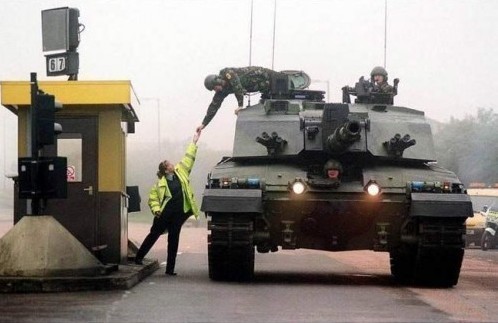 Somehow,
I just don't see this happening at the George Washington Bridge! What I
want to know, is how many axles that tank constitutes..
Somehow,
I just don't see this happening at the George Washington Bridge! What I
want to know, is how many axles that tank constitutes..
Seriously though, not all vehicles used in military
service wore olive drab or navy gray and a lot of regular production
black sedans were used by officials in the course of their duties. And
at this time, I am uncertain if the issuing agency did the perforating
or the military.
Serial Numbering on the Commutation Books
As I acquire
Commutation Books of the Series H-5 (25 tickets, good for 2 years,
$10.00) from different years,
it has now been observed that the serial
prefix letters appear on consecutive years.
This now leads me to
believe that prefix letters were not uniquely individual to the year of
issue, i.e.: A = 1964, B = 1965, C = 1966, etc; but prefix letters were assigned to printing runs of 999,999 books.
As can be seen at right, the 1966 book carries serial number C 457294. The 1967 book
bears C 927387 (also a C prefix but a higher number),
however, the 1968
book in my possession carries D 132281 (D prefix in the low range); and the 1969 book a D prefix in the high range.
The 1970 book in my collection bears an E prefix and an E prefix seen
on Worthpoint also has a E prefix with a slight lower number; and the
1971 book also has an E prefix but with a significantly higher number.
And, while I
have not many of the Series H-4 Commutation Books (40 tickets, good for
30 days, $10.00) it appears they were numbered in the same fashion. |
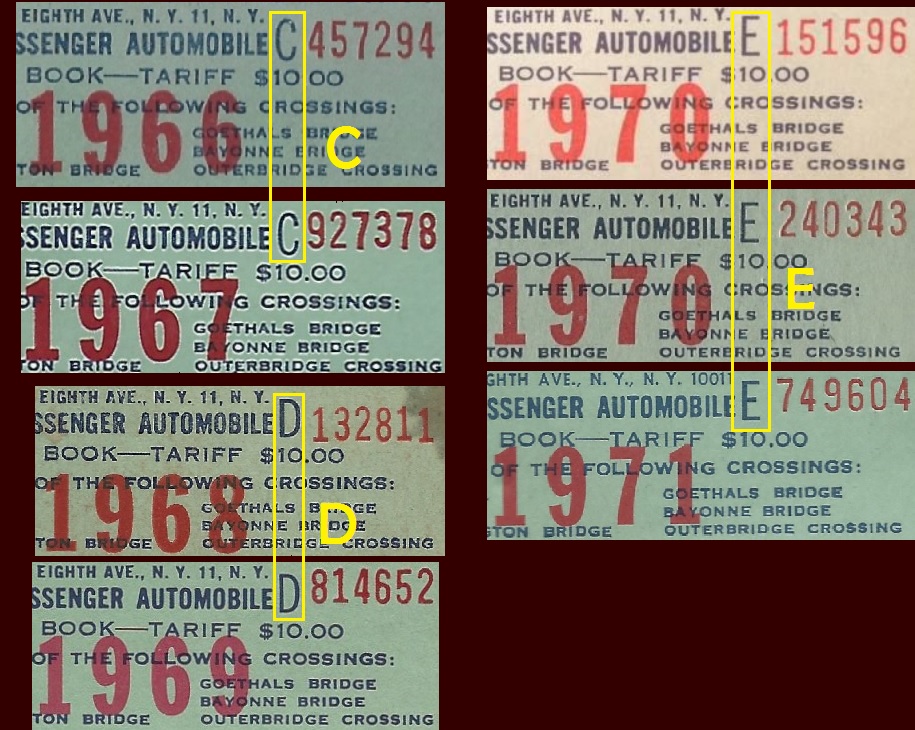 |

Index to PoNYA and
PANYNJ Issues of Scrip:
Port of New York
Authority (PoNYA) Scrip & Commutation Issues - 1935 to 1972:
Port
of New York Authority "original design"
TS1, TS2,
TS3, TS4, TS5, TS6?, TS7
F-4, H-3, H-4,
H-5, P
|
1935,
1951, 1960, 1969 |
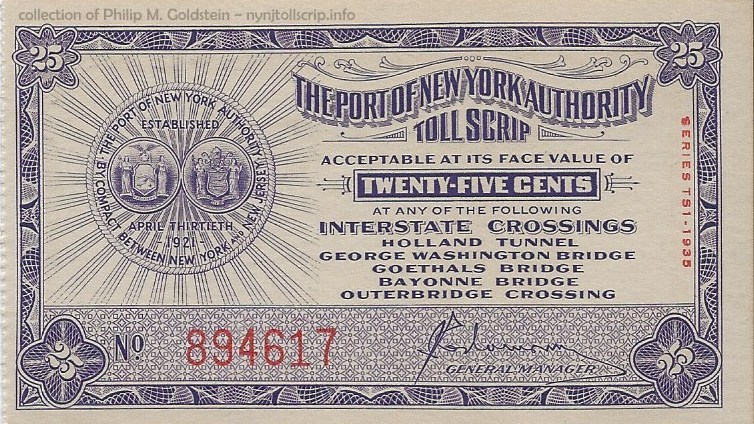 |
Port
of New York Authority "new design"
TS2, TS3?, TS4,
TS5?, TS6?, TS7
H-4, |
1969
- 1972 |
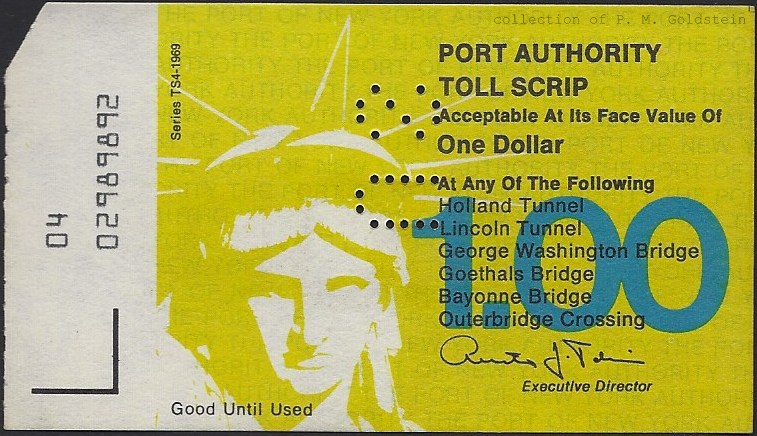 |
Port Authority of New
York and New Jersey (PANYNJ) Scrip & Commutation Issues: 1972 - 2012
"First"
Series Scrip
|
1972
- ca. 1976 |
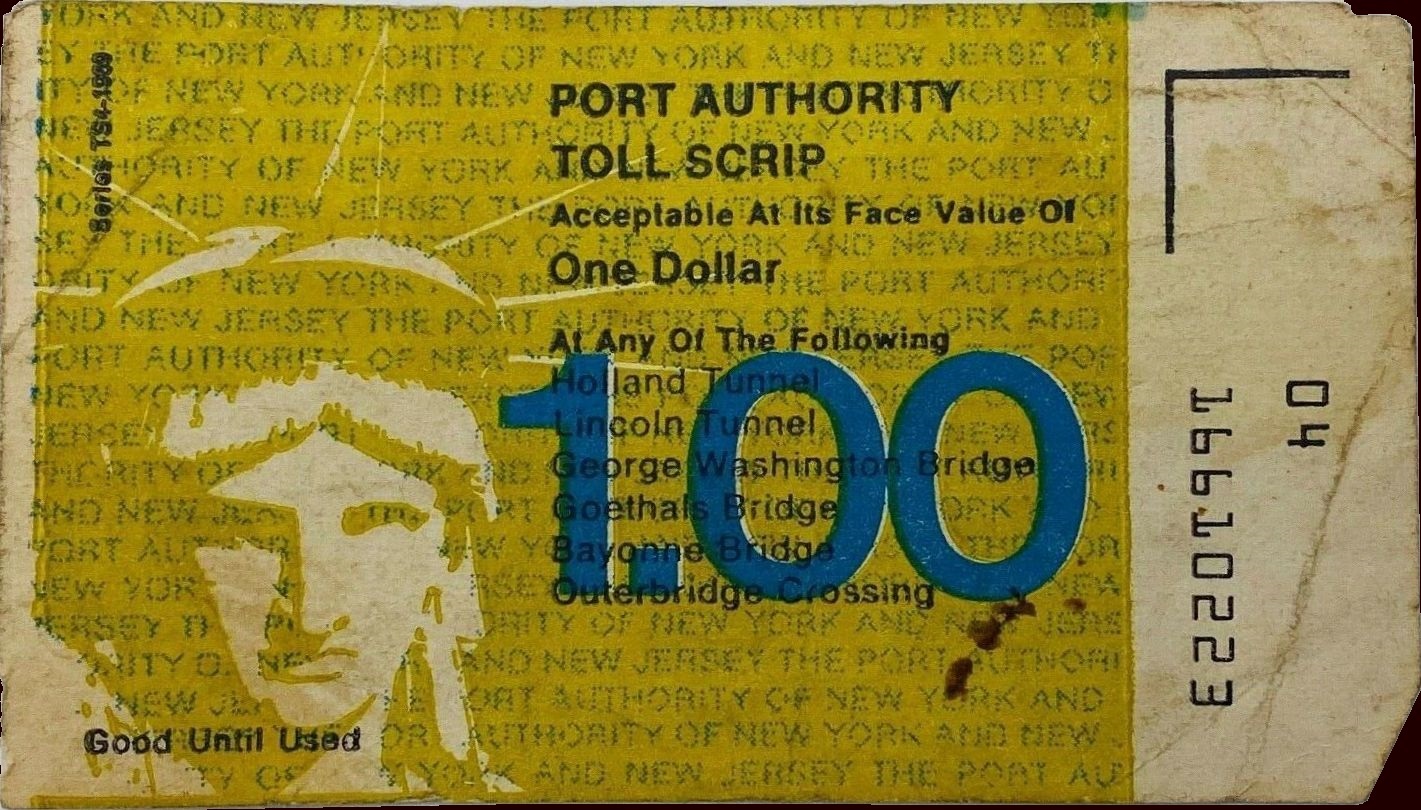 |
"Second" Series Scrip
|
ca.
1976 - ca. 1986 |
 |
"Third"
Series Scrip
|
ca.
1986 - ca. 1989 |
 |
| "Fourth"
Series Scrip |
ca.
1989 - ca. 1993 |
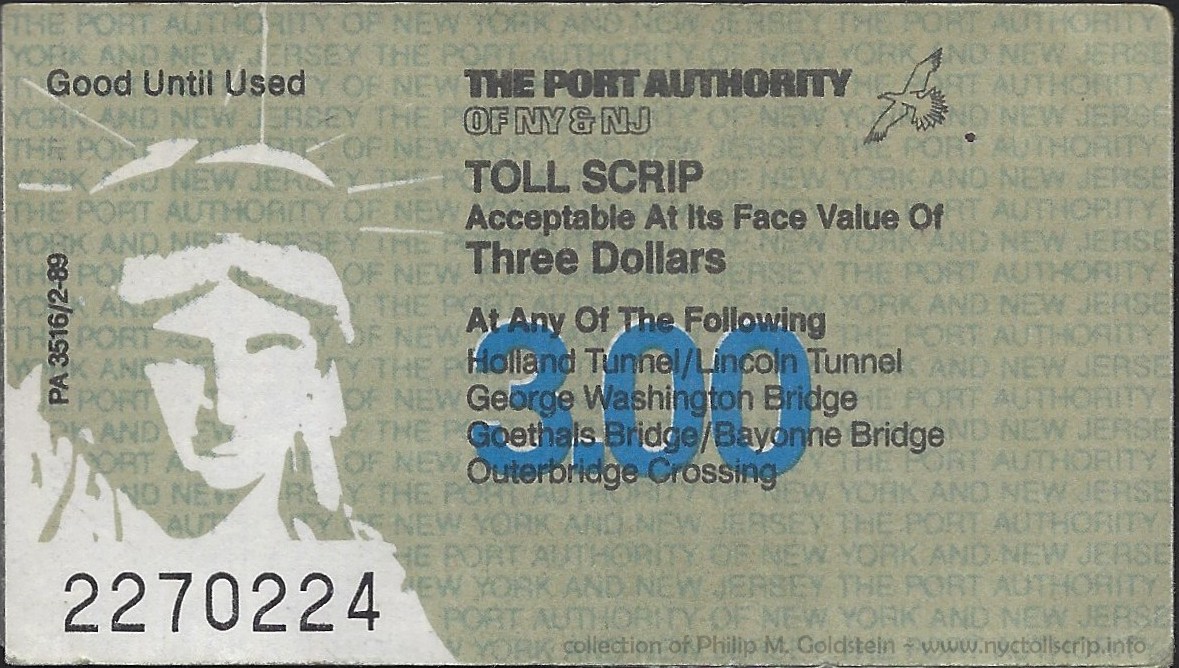 |
"Universal"
Commuter
|
ca.
1991 - 2012 |
 |
"Fifth"
Series Scrip
|
ca.
1993 - 2012? |
.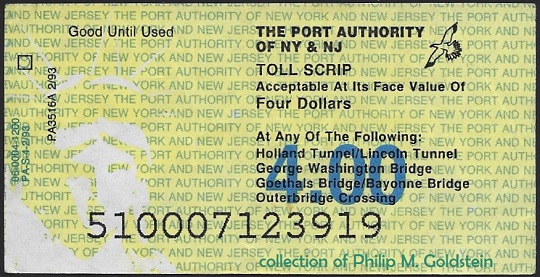
|
Port
of New York Authority Scrip - Original
Design
TS
Series 1, 2, 3, 4, 5, 6?, 7 - 1935,
1951, 1960, 1969
|
.25 cents
|
 |
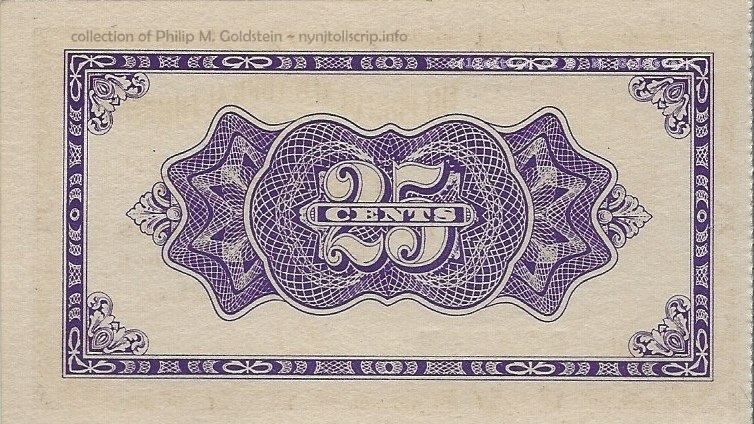 |
PoNYA - Series TS1 - 1935 - 25 cents
collection of
Philip M. Goldstein |
printer:
printing
method:
security printing, paper / watermark:
design colors,
face:
design
notes, face:
security underprinting, signature field:
facsimile
signature:
serial number:
design colors, back:
design notes, back:
notes, other:
size: |
unknown
- Security Banknote Company?
intaglio
none
purple
"INTERSTATE CROSSINGS" listed, no Lincoln Tunnel,
series number in red (presumably printed at time of s/n)
circles, squares & diamonds
J. E. Ramsey, General Manager
red, no prefix
purple
bowtie frame w/ guilloche
white
cardstock
3 ¾" (width) - 2 ⅛" (height) - 0.010" (thickness) |
.
.
|
|
existence
currently undetermined
PoNYA - Series TS1 - 1935 - 25 cents
Optima GOOD UNTIL USED; frame back with Banknote
Roman numerals - lithograph |
.
. |
|
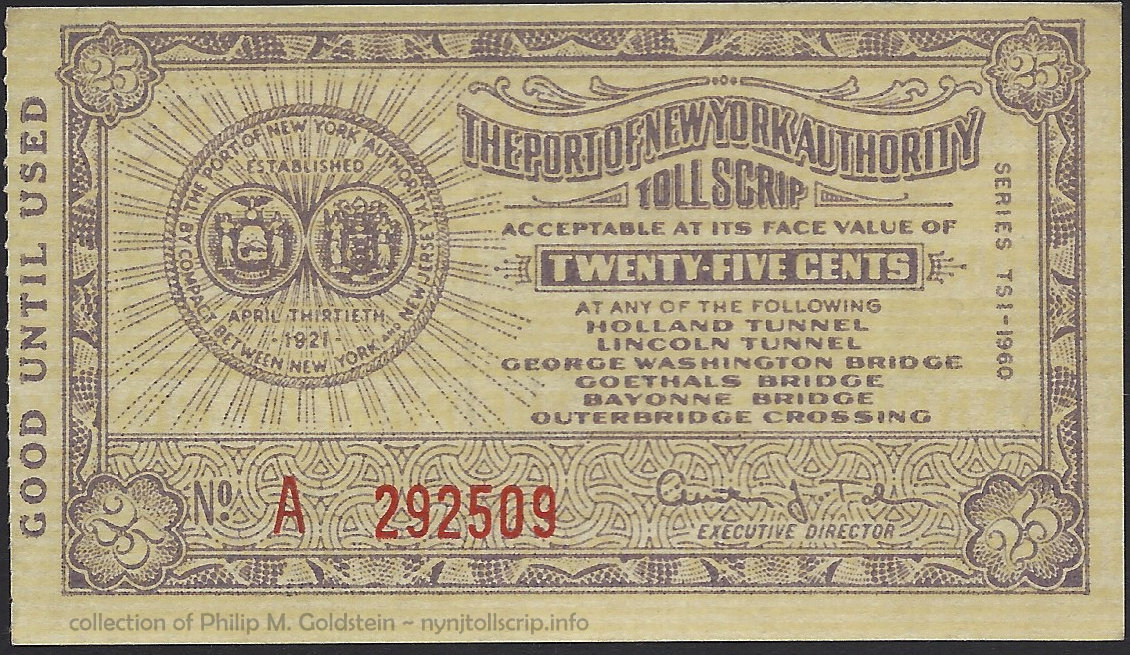 |
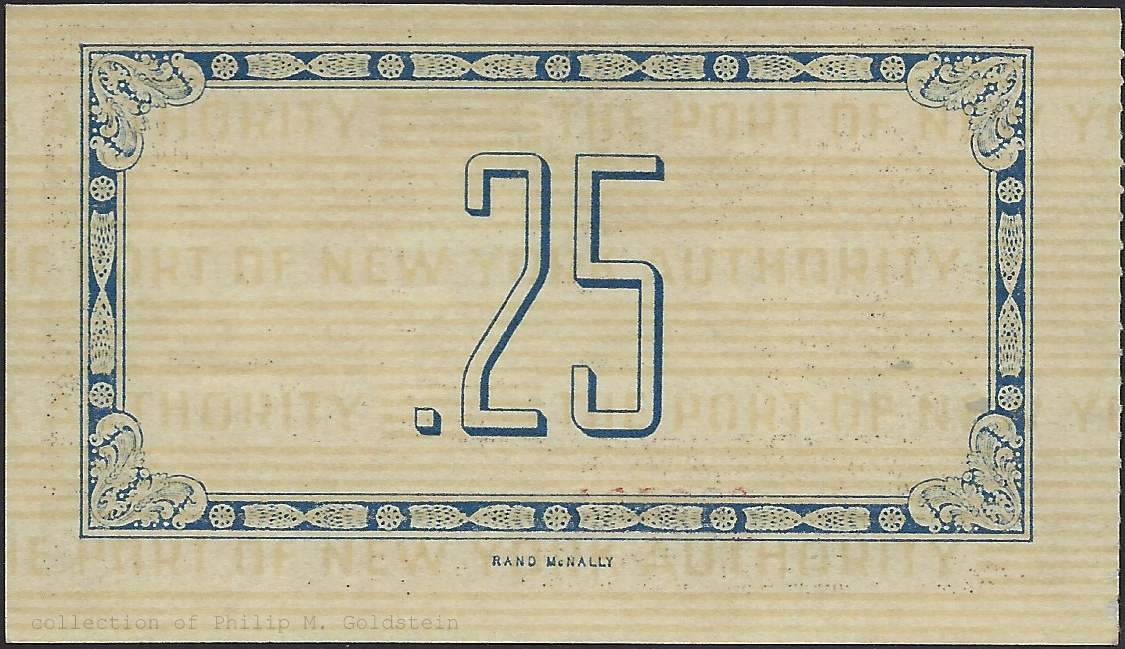 |
PoNYA - Series TS1 - 1960 - 25
cents
collection of
Philip M. Goldstein |
printer:
printing
method:
security printing, paper / watermark:
design colors,
face:
design
notes, face:
security underprinting, signature field:
facsimile
signature:
serial number:
design colors, back:
design notes, back:
notes, other:
size: |
Rand McNally
lithograph
alternating 5 lines with Port of New York
Authority in horizontal format
lavender
8 pt. Gloucester (serif) "GOOD UNTIL USED"
"INTERSTATE CROSSINGS" removed, "LINCOLN TUNNEL"
added
series number in face color,
crescent, wedge & line
Austin J. Tobin, Executive Director
red prefix and serial number
blue
twist & floret frame w/ Agency square block
numerals;
beige paper
3 ¾" (width) - 2 ⅛" (height) - 0.005"
(thickness) |
.
.
|
|
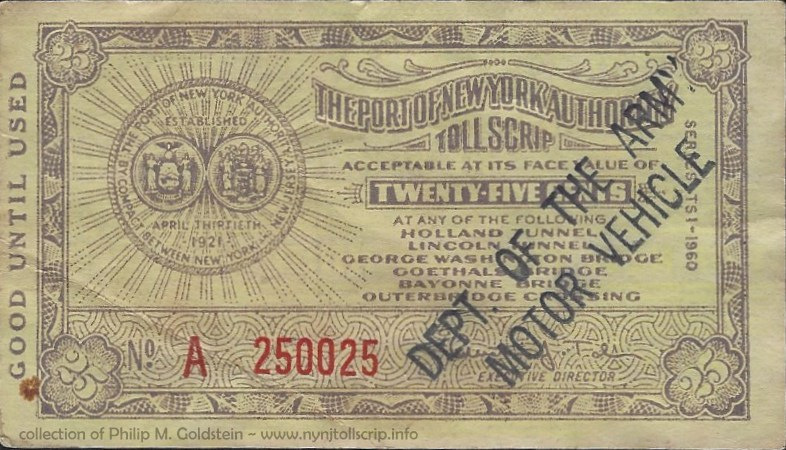 |
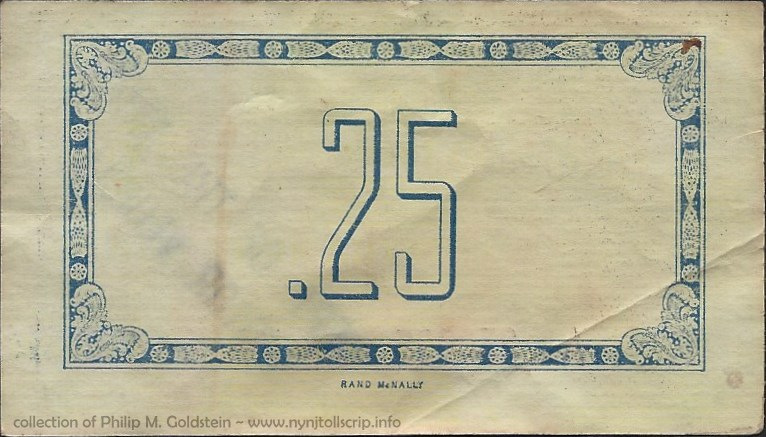 |
PoNYA - Series TS1 - 1960 - 25
cents
overstamped on face: "DEPARTMENT OF THE ARMY - MOTOR VEHICLE
collection of
Philip M. Goldstein |
printer:
printing
method:
security printing, paper / watermark:
design colors,
face:
design
notes, face:
security underprinting, signature field:
facsimile
signature:
serial number:
design colors, back:
design notes, back:
notes, other:
size: |
Rand McNally
lithograph
alternating 5 lines with Port of New York
Authority in horizontal format
lavender
8 pt. Gloucester (serif) "GOOD UNTIL USED"
"INTERSTATE CROSSINGS" removed, "LINCOLN TUNNEL"
added
series number in face color,
DEPARTMENT OF THE ARMY - MOTOR VEHICLE overstamp on face
crescent, wedge & line
Austin J. Tobin, Executive Director
red prefix and serial number
blue
twist & floret frame w/ Agency square block
numerals;
beige paper
3 ¾" (width) - 2 ⅛" (height) - 0.005"
(thickness) |
| .50 cents |
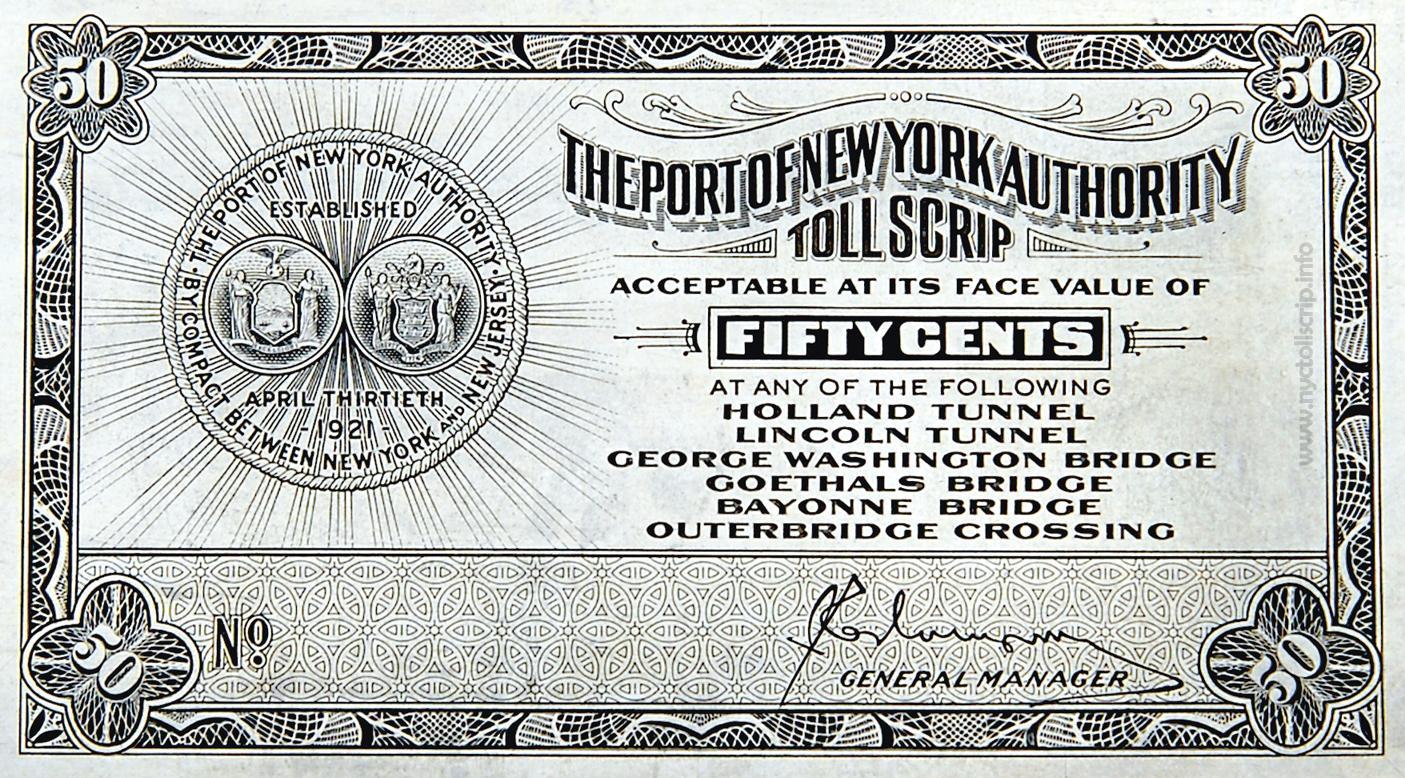 |
|
PoNYA - Series TS2 - 1935 - 50
cents
|
printer:
printing
method:
security printing, paper / watermark:
design colors,
face:
design
notes, face:
security underprinting, signature field:
facsimile
signature:
serial number:
design colors, back:
design notes, back:
notes, other:
size: |
unknown - Security Banknote
Company?
intaglio
unknown
unknown (believed to be in blue), series believed to
be in red
no "GOOD UNTIL USED"
"INTERSTATE CROSSINGS" removed, "LINCOLN TUNNEL"
added
lenticular ovals (footballs), triangles & 6 point
stars
J. E. Ramsey, General Manager
prefix and serial number presumed to be in red
unknown (believed to be in blue)
unknown - presumably
frame with guilloche
3 ¾" (width) - 2 ⅛" (height) - thickness
unknown |
.
. |
|
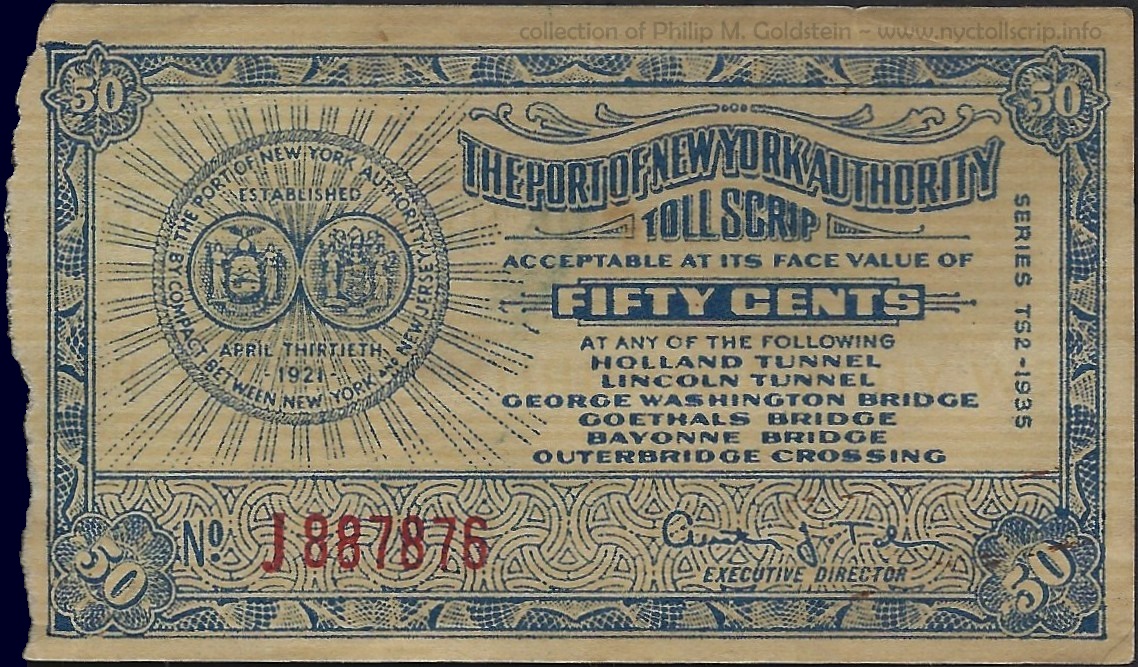 |
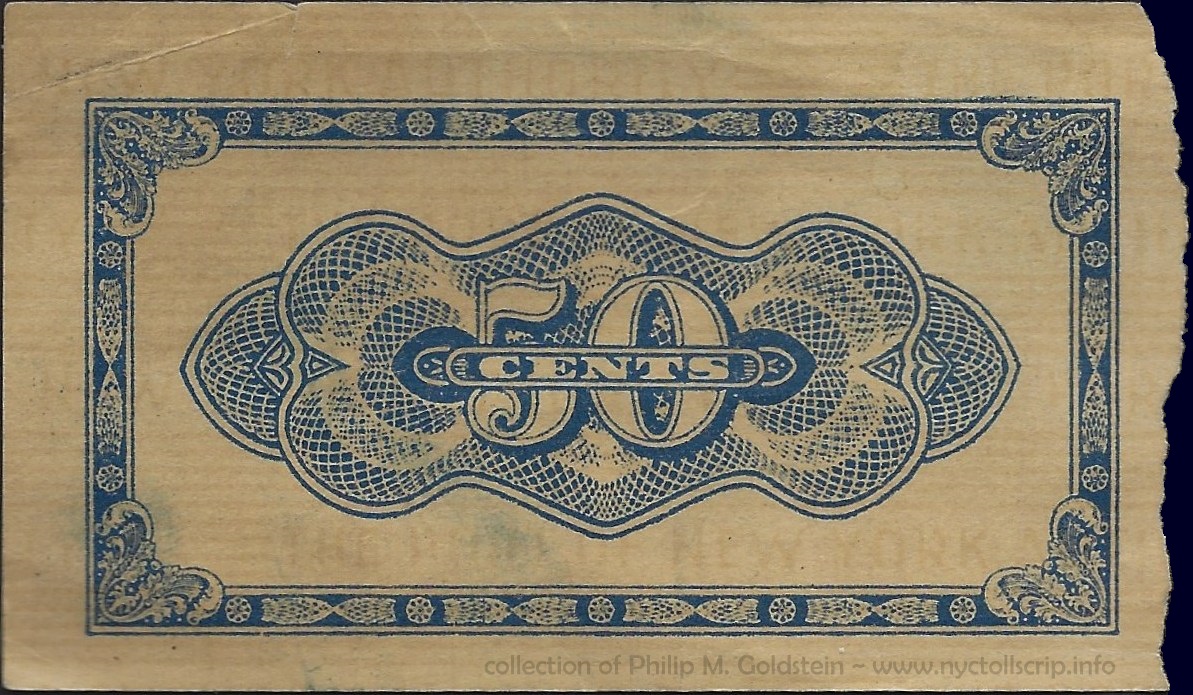 |
PoNYA - Series TS2 - 1935
(1942) - 50 cents
collection of
Philip M. Goldstein |
printer:
printing
method:
security printing, paper / watermark:
design colors,
face:
design
notes, face:
security underprinting, signature field:
facsimile
signature:
serial number:
design colors, back:
design notes, back:
notes, other:
size: |
unknown
lithography
alternating 5 lines with PORT OF NEW YORK AUTHORITY
in horizontal format
blue
no "GOOD UNTIL USED"
crescent, wedge & line
Austin J. Tobin, Executive Director
red prefix and serial number
blue
twist &
floret frame with guilloche
3 ¾" (width) - 2 ⅛" (height) -
- 0.005" (thickness) |
.
. |
|
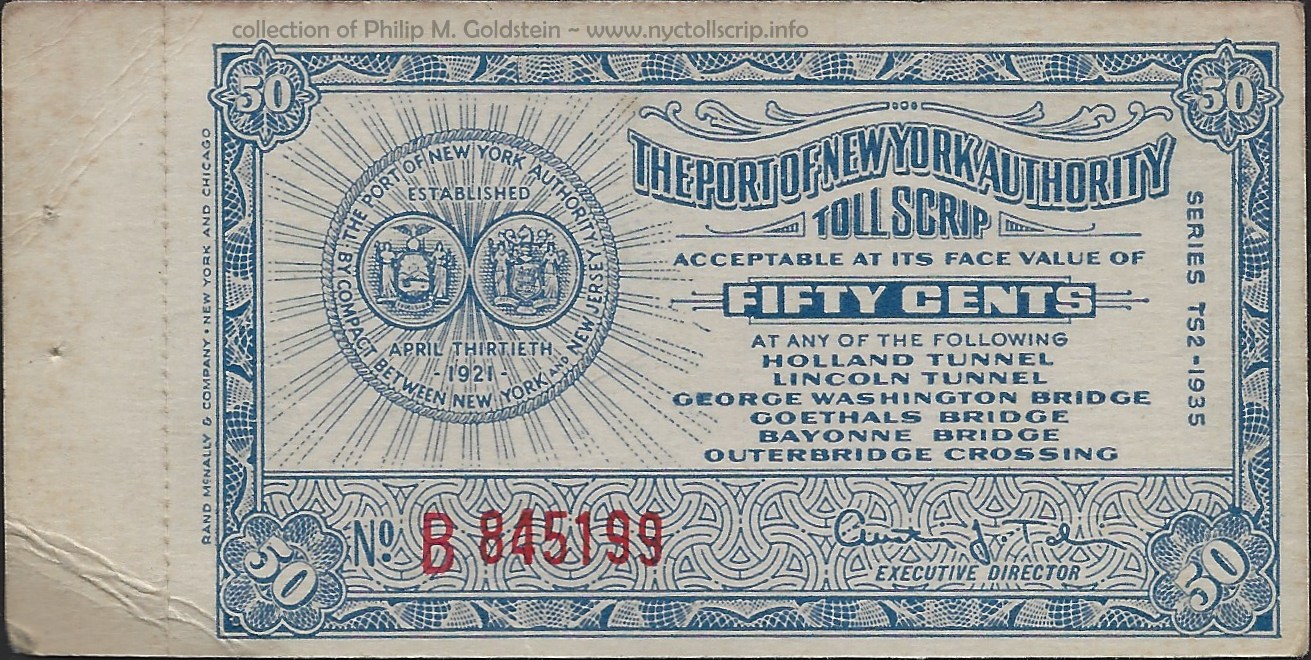 |
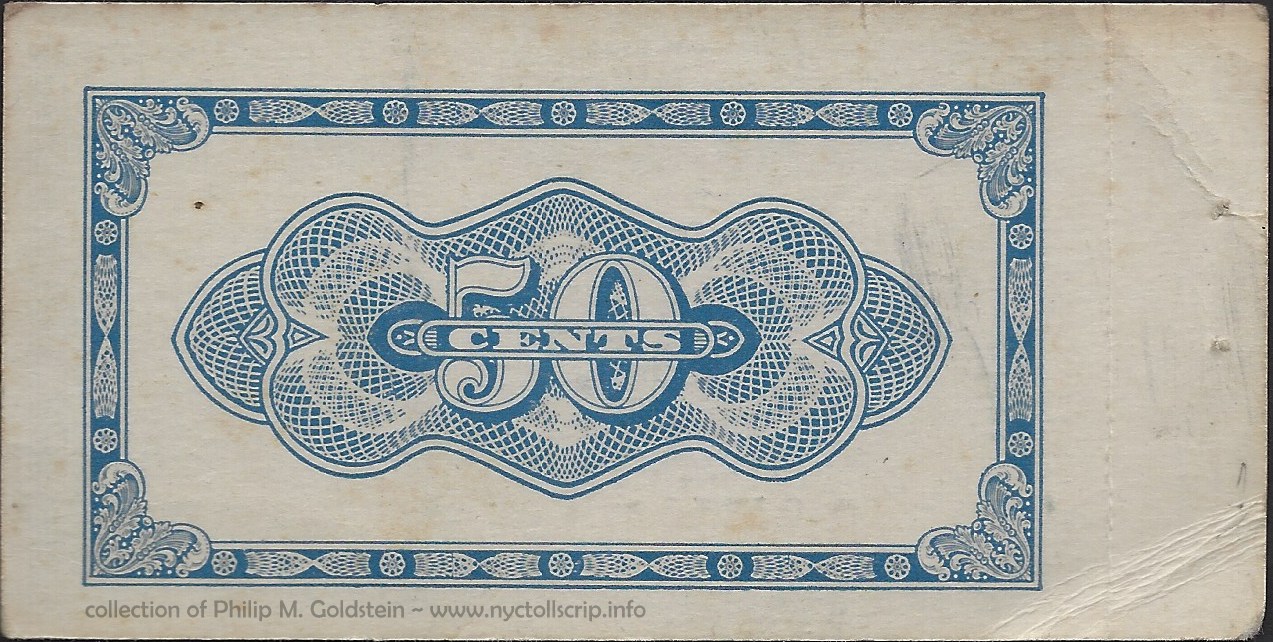 |
 |
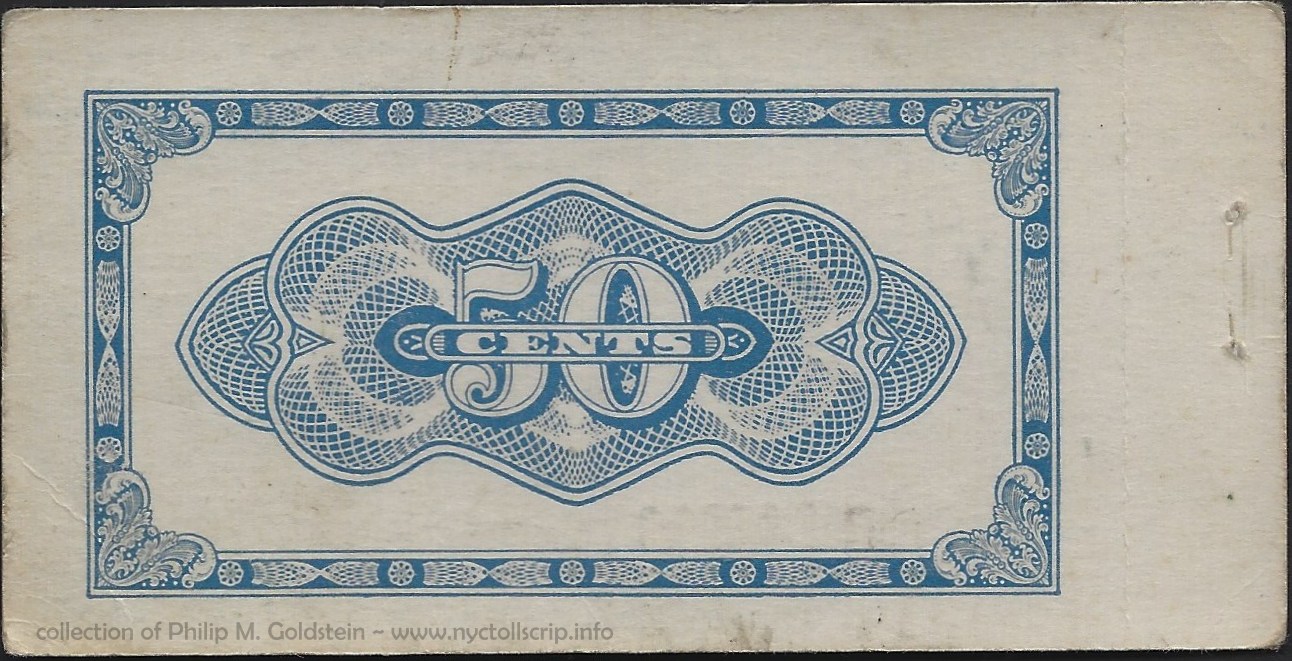 |
PoNYA - Series TS2 - 1935 (1942) - 50
cents
These
pieces are unique as they are printed on cardstock. It was unknown
if all tickets of the book were card stock or just the cover pieces.
If
my estimations are correct by judging from the serial number all
tickets might have been cardstock. As books of tickets started with 01,
26, 51, 76, and ended on the even: 25, 50, 75, 100, having a serial
number of 199 should mean it was the next to last serial number in the
book, therefore should not have been a cover. This piece shares that
similarity to the War Department piece below.
Update: with the the acquisition of the following sequential ticket a month after the first, the above is confirmed.
Also,
the defined imprint and rust staining of the staple legs on the back
the "200" note confirms this to have been the back cover.
collection of
Philip M. Goldstein
added 03 February & 17 April 2021
|
printer:
printing
method:
security printing, paper / watermark:
design colors,
face:
design
notes, face:
security underprinting, signature field:
facsimile
signature:
serial number:
design colors, back:
design notes, back:
notes, other:
size: |
Rand McNally & Company,
New York & Chicago
lithograph
none
blue
no "GOOD UNTIL USED"
crescent, wedge & line
Austin J. Tobin, Executive Director
red prefix and serial number
blue
twist &
floret frame with guilloche
cardstock, 7/32" stub
3 ¾" (width) - 2 ⅛" (height) - .010" |
.
. |
|
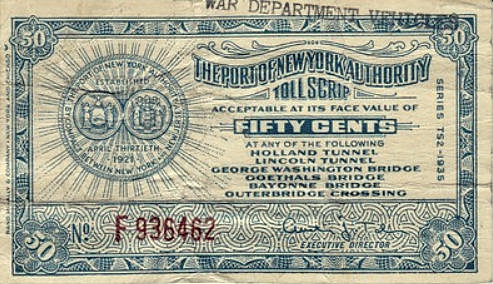 |
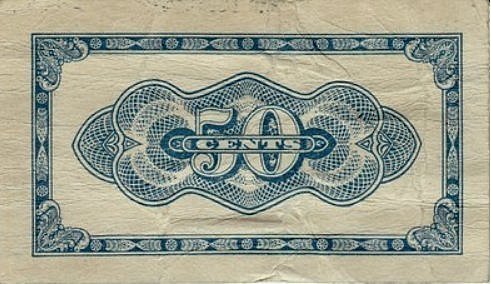 |
PoNYA - Series TS2 - 1935 (1942) - 50
cents
overtyped on face: WAR DEPARTMENT VEHICLES
The War Department was dissolved under the National Security Act,
September 18, 1947. |
printer:
printing
method:
security printing, paper / watermark:
design colors,
face:
design
notes, face:
security underprinting, signature field:
facsimile
signature:
serial number:
design colors, back:
design notes, back:
notes, other:
size: |
Rand McNally & Company,
New York & Chicago
lithograph?
none?
blue
no "GOOD UNTIL USED"
crescent, wedge & line
Austin J. Tobin, Executive Director
red prefix and serial number
blue
twist &
floret frame with guilloche
seen w/ manual overtyping: WAR DEPARTMENT VEHICLES
3 ¾" (width) - 2 ⅛" (height) - thickness
unknown (possible cardstock?) |
.
. |
|
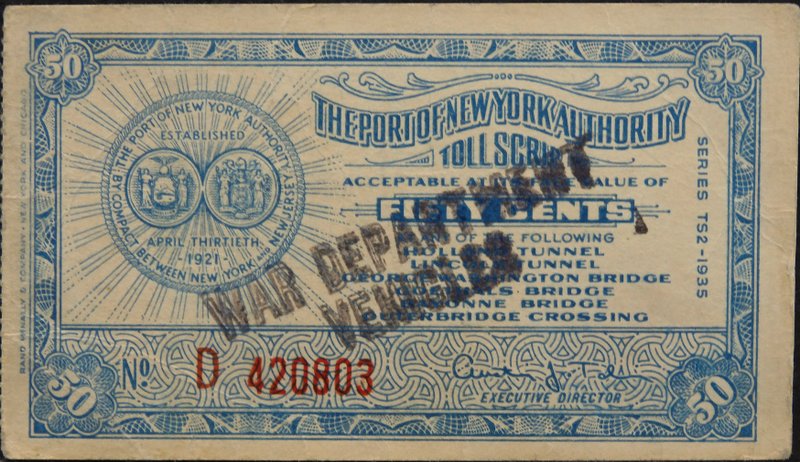 |
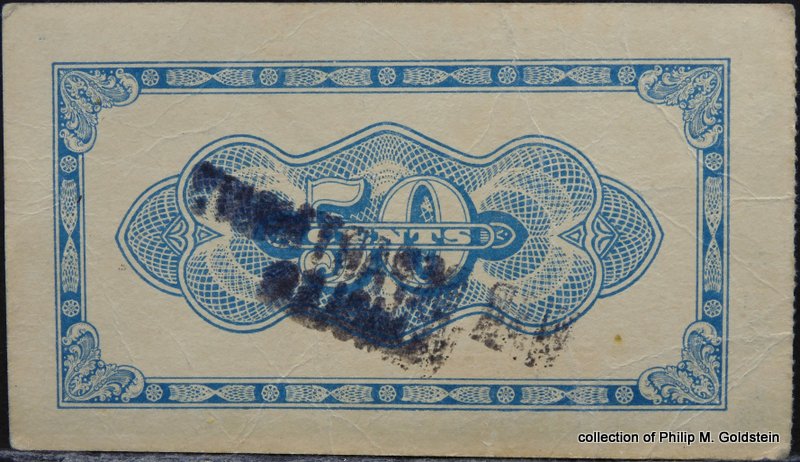 |
PoNYA - Series TS2 - 1935 (1942) - 50 cents
overstamped on face "WAR DEPARTMENT VEHICLES"
The War Department was dissolved under the National Security Act,
September 18, 1947.
Worthpoint |
printer:
printing
method:
security printing, paper / watermark:
design colors,
face:
design
notes, face:
security underprinting, signature field:
facsimile
signature:
serial number:
design colors, back:
design notes, back:
notes, other:
size: |
Rand McNally & Company,
New York & Chicago
lithograph?
none?
blue
no "GOOD UNTIL USED"
crescent, wedge & line
Austin J. Tobin, Executive Director
red prefix and serial number
blue
twist &
floret frame with guilloche
seen w/ manual overtyping: WAR DEPARTMENT VEHICLES
3 ¾" (width) - 2 ⅛" (height) - thickness
unknown (possible cardstock?) |
.
.
|
|
.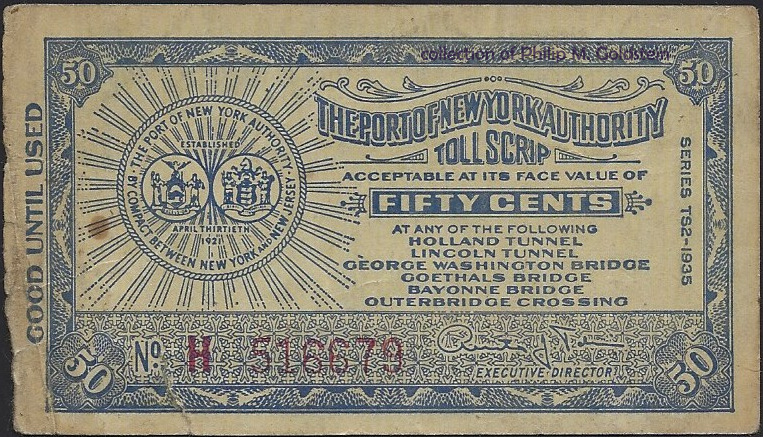 |
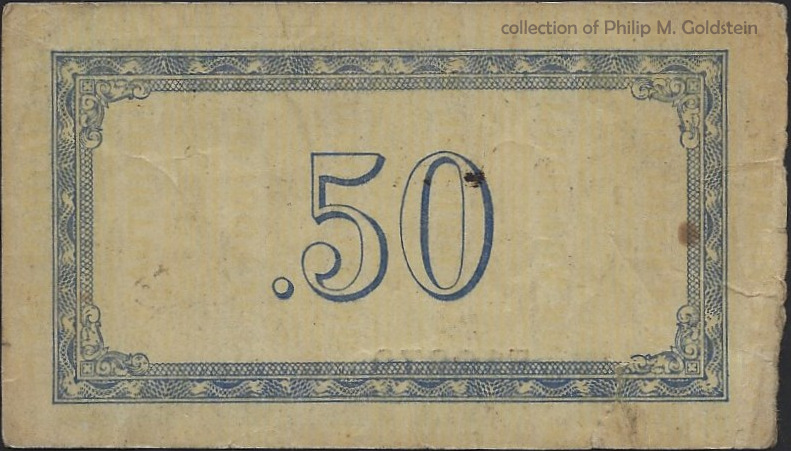 |
PoNYA - Series TS2 - 1935 (1942) -
50 cents
frame back with Banknote
Roman numerals - lithograph
collection of
Philip M. Goldstein |
printer:
printing
method:
security printing, paper / watermark:
design colors,
face:
design
notes, face:
security underprinting, signature field:
facsimile
signature:
serial number:
design colors, back:
design notes, back:
notes, other:
size: |
unknown
lithograph
alternating 5 lines with PORT OF NEW YORK
AUTHORITY in vertical format
blue
Optima (sans-serif) "GOOD UNTIL USED"
crosses
Austin J. Tobin, Executive Director
red prefix and serial number
blue
wave double
frame with Banknote Roman numerals
3 ¾" (width) - 2 ⅛" (height) - 0.005"
(thickness) |
.
.
|
|
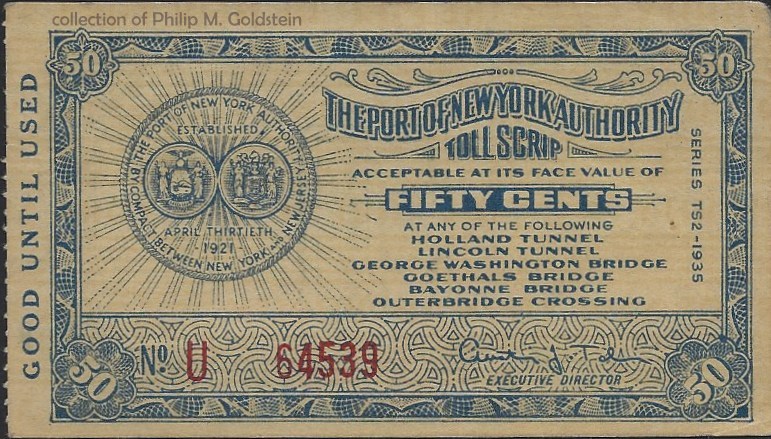 |
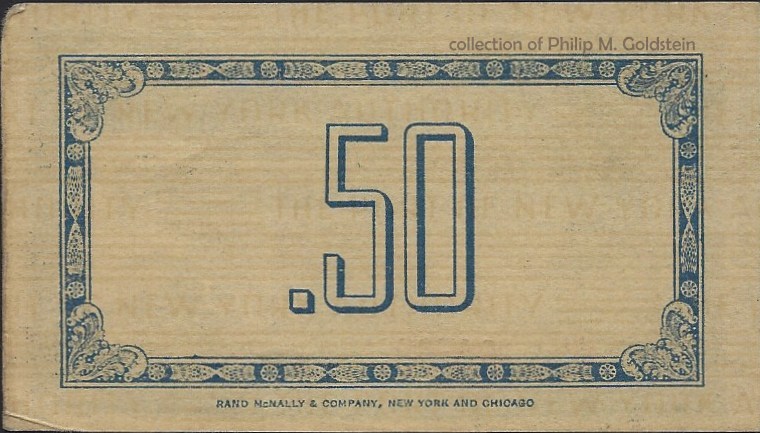 |
PoNYA - Series TS2 - 1935
(1942) - 50 cents
collection
of Philip M. Goldstein |
printer:
printing
method:
security printing, paper / watermark:
design colors,
face:
design
notes, face:
security underprinting, signature field:
facsimile
signature:
serial number:
design colors, back:
design notes, back:
notes, other:
size: |
Rand McNally & Company,
New York & Chicago
lithograph
alternating 5 lines with PORT OF NEW YORK
AUTHORITY in horizontal format
blue
8 pt. Gloucester (serif) "GOOD UNTIL USED"
crescent, wedge & line
Austin J. Tobin, Executive Director
red prefix and serial number
blue
twist &
floret single frame w/
Agency numerals
3 ¾" (width) - 2 ⅛" (height) - 0.005"
(thickness) |
.
.
|
|
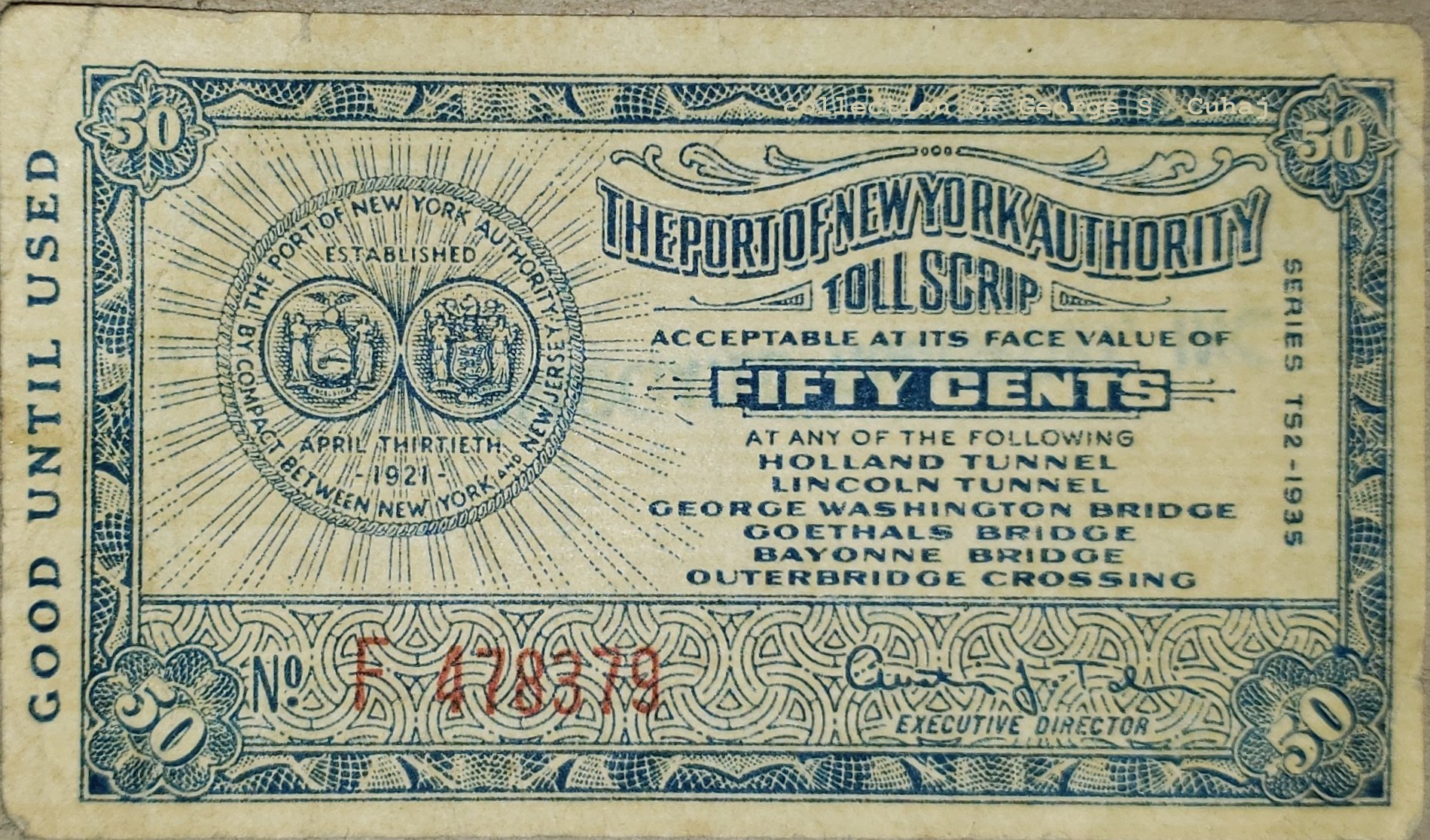 |
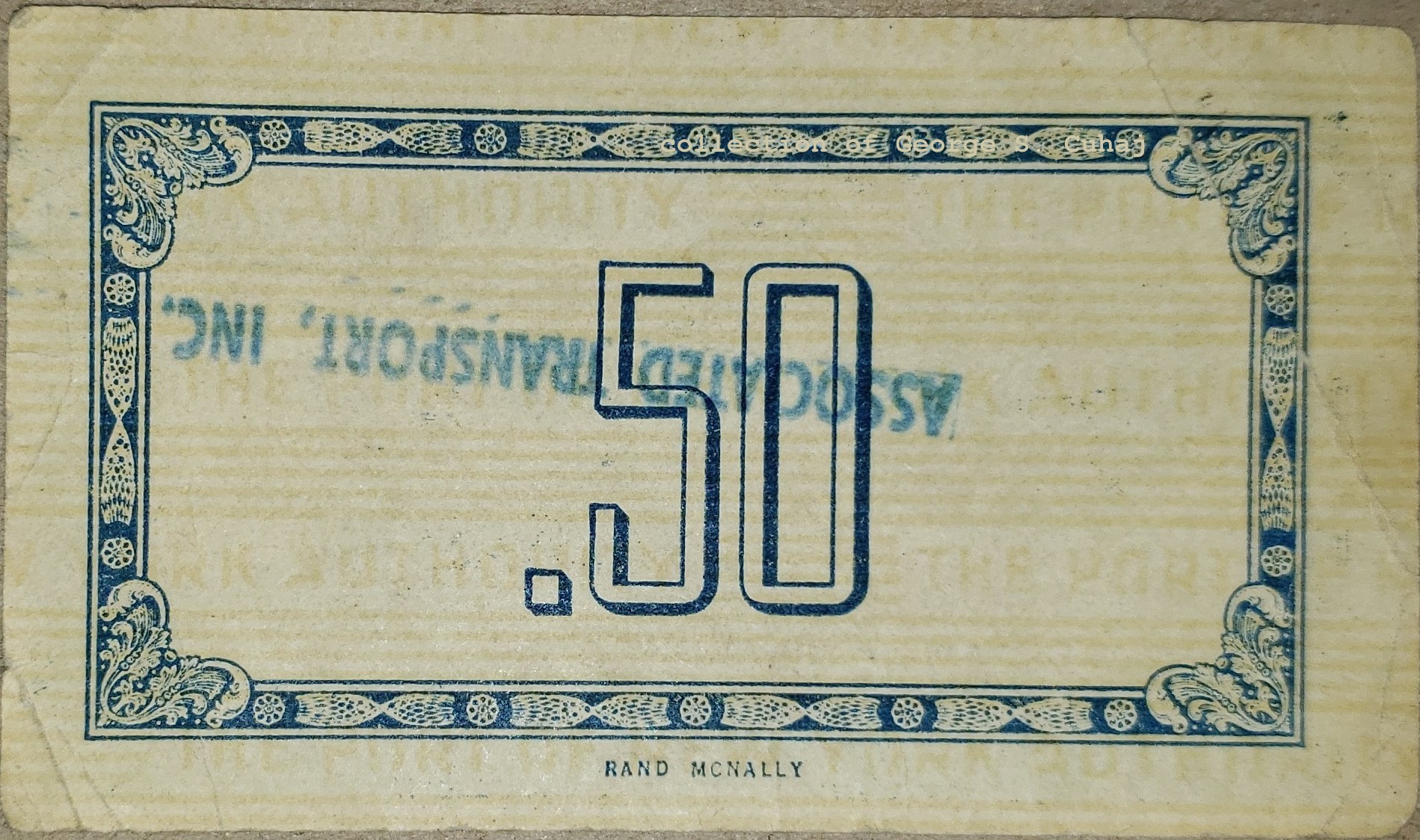 |
PoNYA - Series TS2 - 1935 (1942) - 50 cents
overstamp on back: "Associated
Transport, Inc"
(Associated Transport was a
trucking firm)
collection
of George S. Cuhaj |
printer:
printing
method:
security printing, paper / watermark:
design colors,
face:
design
notes, face:
security underprinting, signature field:
facsimile
signature:
serial number:
design colors, back:
design notes, back:
notes, other:
size: |
Rand McNally
lithograph
alternating 5 lines with PORT OF NEW YORK
AUTHORITY in horizontal format
blue
8 pt. Gloucester (serif) "GOOD UNTIL USED"
crescent, wedge & line
Austin J. Tobin, Executive Director
red prefix and serial number
blue
twist &
floret single frame w/
Agency numerals
overstamped:
"ASSOCIATED TRANSPORT, INC" (trucking firm)
3 ¾" (width) - 2 ⅛" (height) - 0.005"
(thickness) |
|
|
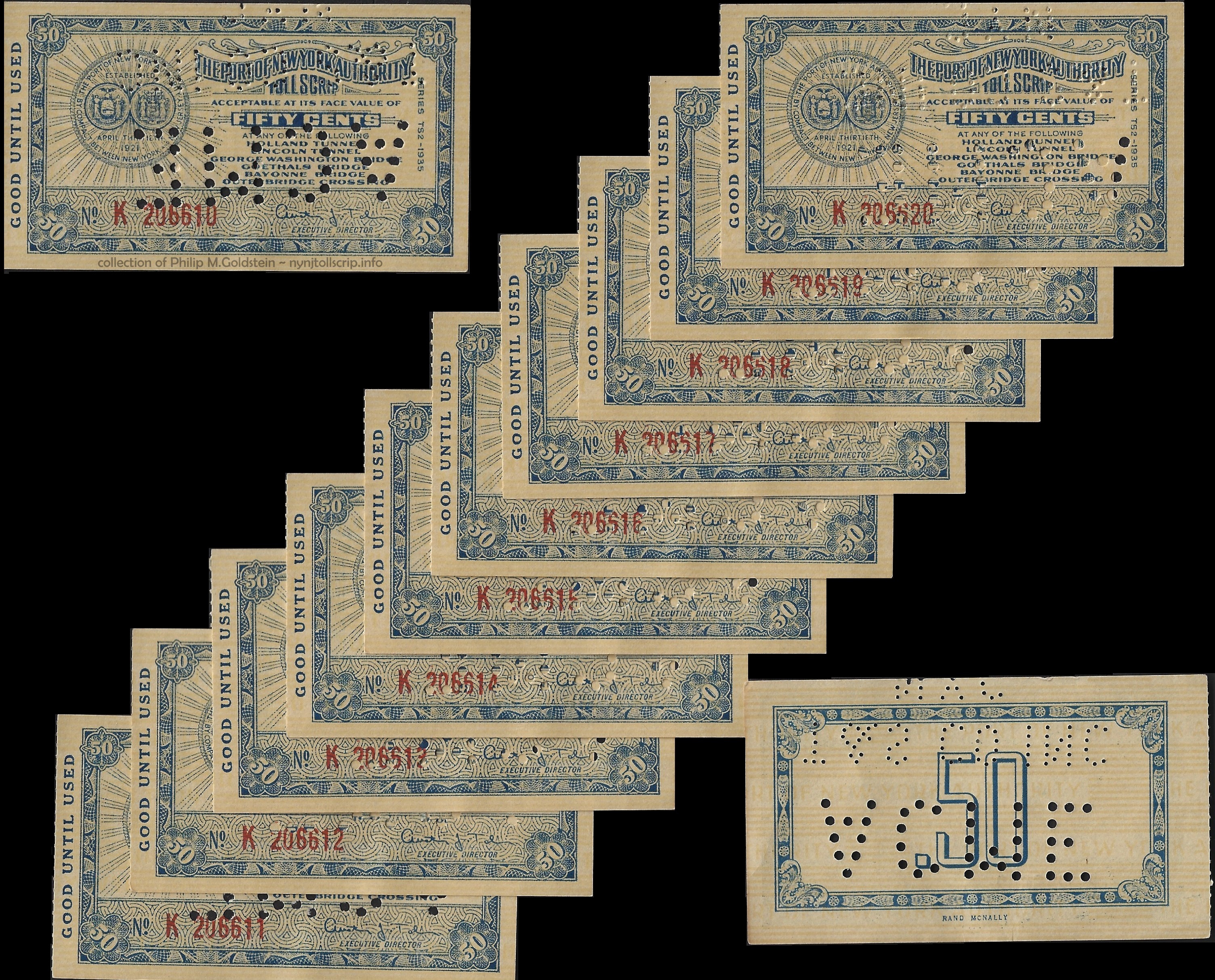 |
PoNYA - Series TS2 - 1935 (1942) - 50 cents
perforated: "ACME T&S CO INC NYC"
collection
of Philip M. Goldstein |
printer:
printing
method:
security printing, paper / watermark:
design colors,
face:
design
notes, face:
security underprinting, signature field:
facsimile
signature:
serial number:
design colors, back:
design notes, back:
notes, other:
size: |
Rand McNally
lithograph
alternating 5 lines with PORT OF NEW YORK
AUTHORITY in horizontal format
blue
8 pt. Gloucester (serif) "GOOD UNTIL USED"
crescent, wedge & line
Austin J. Tobin, Executive Director
red prefix and serial number
blue
twist &
floret single frame w/
Agency numerals
perforated: ACME T&S CO INC NYC (trucking & shipping)
3 ¾" (width) - 2 ⅛" (height) - 0.005"
(thickness) |
.
.
|
|
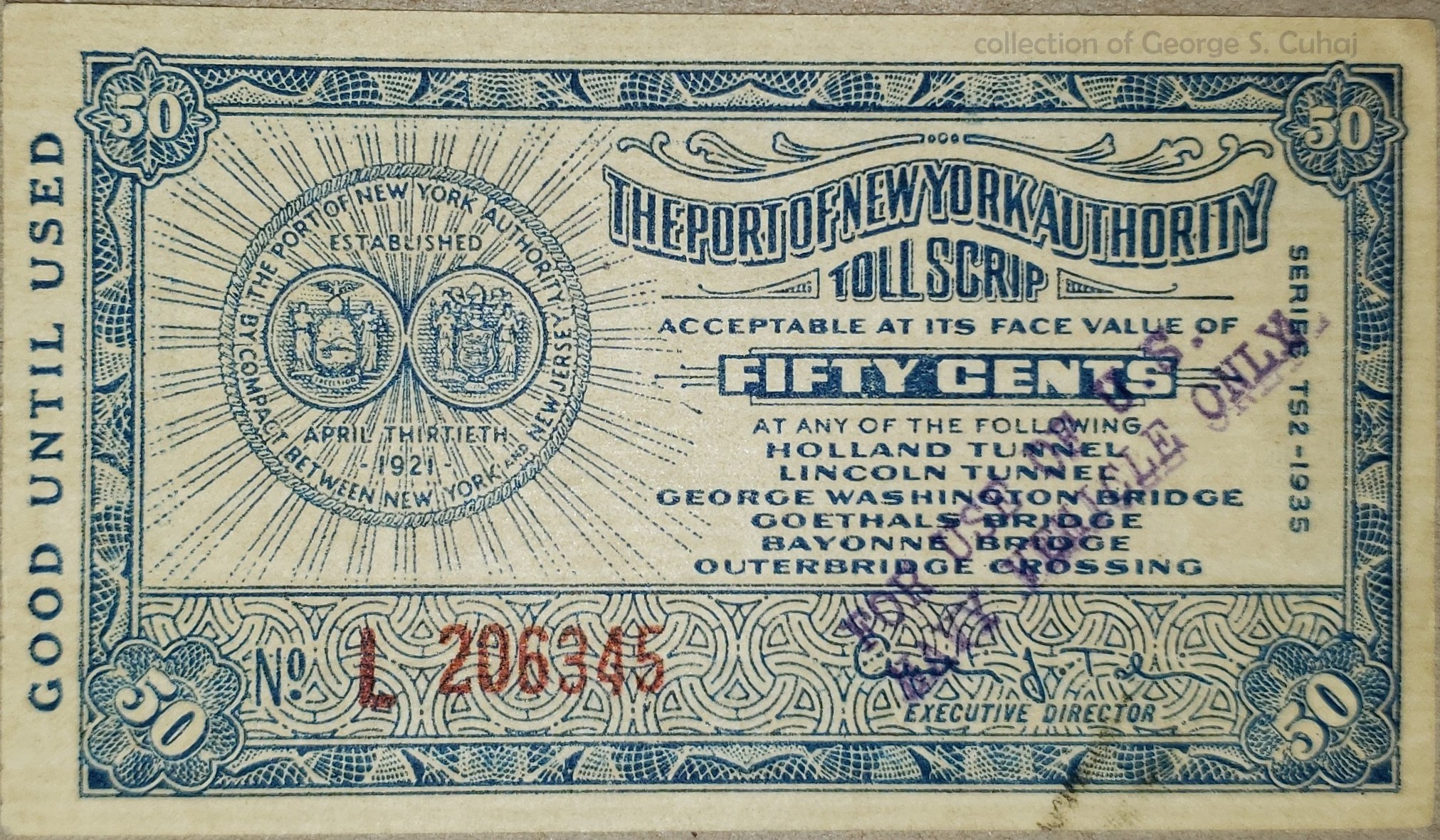 |
 |
PoNYA - Series TS2 - 1935 (1942) - 50 cents
overtype on face "FOR USE OF
U.S. NAVY VEHICLE ONLY"
empty frame - no .50
denomination of back of note
collection
of George S. Cuhaj |
printer:
printing
method:
security printing, paper / watermark:
design colors,
face:
design
notes, face:
security underprinting, signature field:
facsimile
signature:
serial number:
design colors, back:
design notes, back:
notes, other:
size: |
Rand McNally & Company,
New York & Chicago
lithograph
alternating 5 lines with PORT OF NEW YORK
AUTHORITY in horizontal format
blue
8 pt. Gloucester (serif) "GOOD UNTIL USED"
crescent, wedge & line
Austin J. Tobin, Executive Director
red prefix and serial number
blue
twist &
floret single frame only - NO numerals
manually
overtyped: "FOR USE OF U.S. NAVY VEHICLE ONLY"
3 ¾" (width) - 2 ⅛" (height) - 0.005"
(thickness) |
.
.
|
|
 |
 |
PoNYA - Series TS2 - 1935 (1942) - 50 cents
empty frame - no .50
denomination of back of note
collection of
Philip M. Goldstein |
printer:
printing
method:
security printing, paper / watermark:
design colors,
face:
design
notes, face:
security underprinting, signature field:
facsimile
signature:
serial number:
design colors, back:
design notes, back:
notes, other:
size: |
Rand McNally & Company,
New York & Chicago
lithograph
alternating 5 lines with PORT OF NEW YORK
AUTHORITY in horizontal format
blue
8 pt. Gloucester (serif) "GOOD UNTIL USED"
crescent, wedge & line
Austin J. Tobin, Executive Director
red prefix and serial number
blue
twist &
floret single frame only - NO numerals
3 ¾" (width) - 2 ⅛" (height) - 0.005"
(thickness) |
| .75 cents |
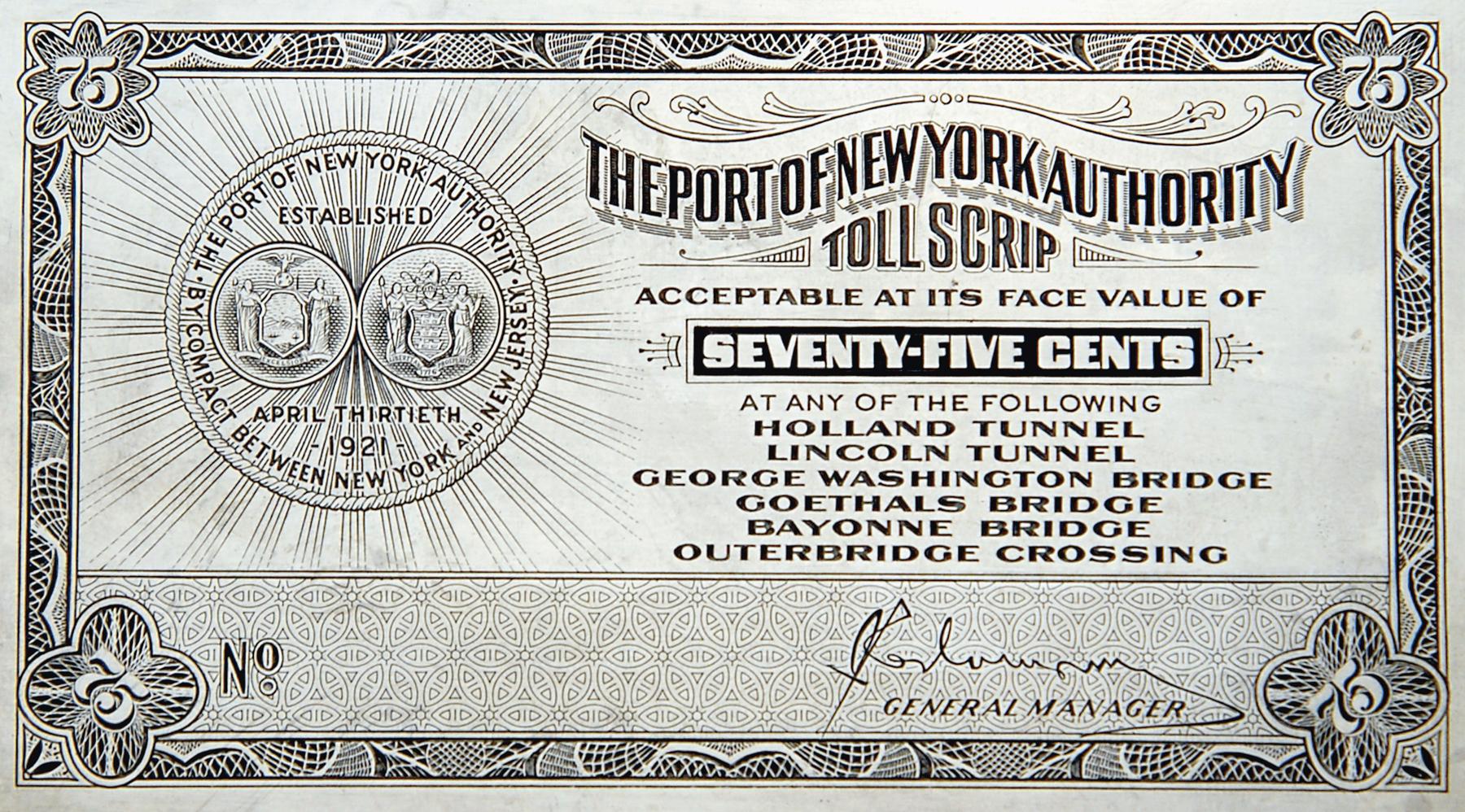 |
|
|
PoNYA - Series TS3 - 1935 - 75 cents
|
printer:
printing
method:
security printing, paper / watermark:
design colors,
face:
design
notes, face:
security underprinting, signature field:
facsimile signature:
serial number:
design colors, back:
design notes, back:
notes, other:
size: |
unknown - Security Banknote Company?
intaglio
unknown
unknown (believed to be in green), series believed to be in red
no "GOOD UNTIL USED"
lenticular ovals (footballs), triangles & 6 point stars
"INTERSTATE CROSSINGS" removed, "LINCOLN TUNNEL" added
J. E. Ramsey, General Manager
red prefix and serial number
unknown (believed to be in green)
unknown - presumably frame with guilloche
3 ¾" (width) - 2 ⅛" (height) - thickness unknown |
.
. |
|
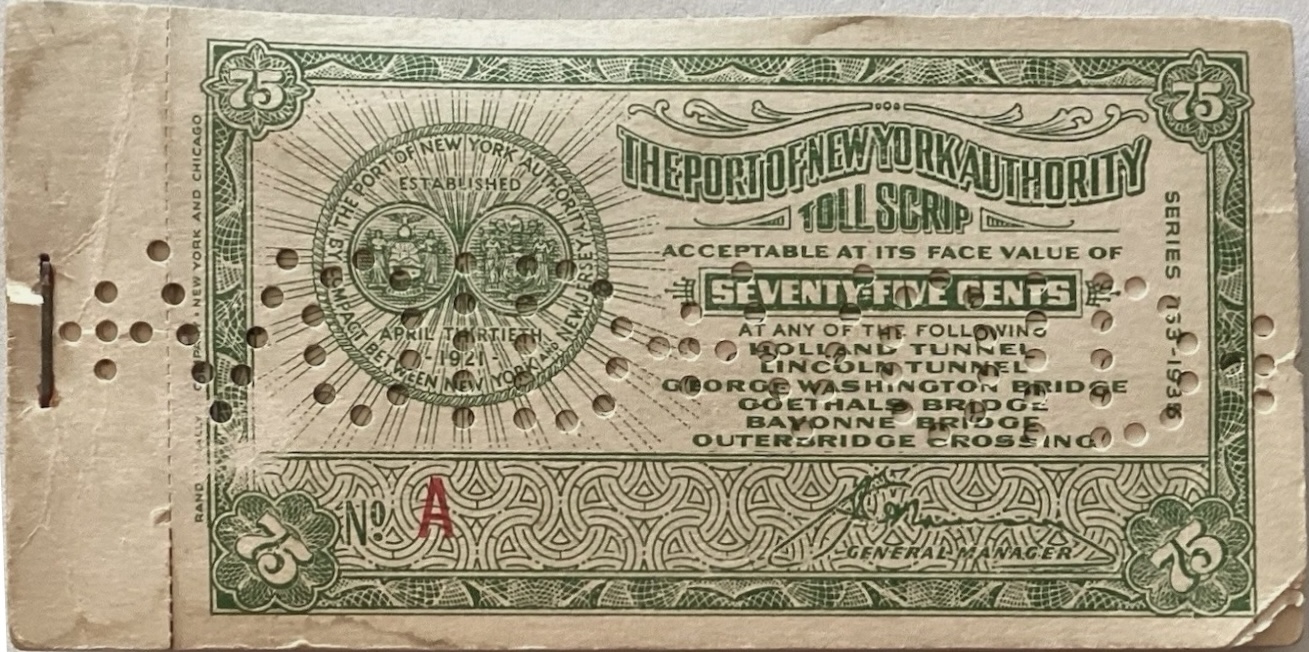 |
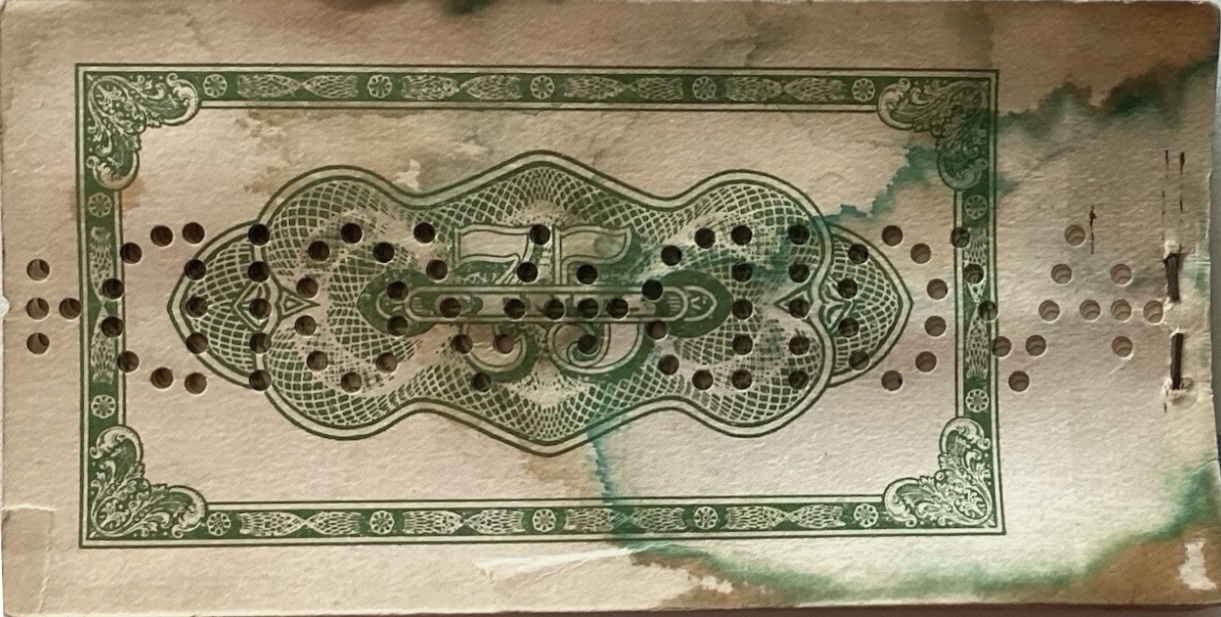 |
| PoNYA - Series TS3 - 1935 - 75 cents - Specimen Book? (tickets missing) |
printer:
printing
method:
security printing, paper / watermark:
design colors,
face:
design
notes, face:
security underprinting, signature field:
facsimile signature:
serial number:
design colors, back:
design notes, back:
notes, other:
size:
|
Rand McNally
lithography
none
green
no "GOOD UNTIL USED"
crescent, wedge and
line security field
J. E. Ramsey, General Manager
red prefix - no serial number
green
guilloche
perforated: +VOID+VOID+
This is possibly a second printing or a second contracting of the initial 1935 .75 cent ticket.
It bears the Ramsey signature, but does not conform to the security underprinting design seen on the Security
Banknote plates. By the existence of this
book, we can also conclude the prefix letter was NOT printed at the
time of serial number crashing.
3 ¾" (width) - 2 ⅛" (height) - cardstock: thickness
unknown
sold on eBay 6/26/2025 |
.
.
|
|
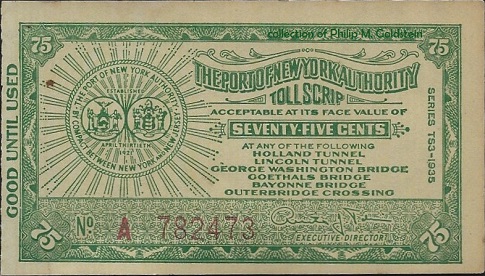 |
 |
PoNYA - Series TS3 - 1935 (1942) - 75
cents
frame back, Banknote Roman numerals -
lithograph
collection
of Philip M. Goldstein |
printer:
printing
method:
security printing, paper / watermark:
design colors,
face:
design
notes, face:
security underprinting, signature field:
facsimile
signature:
serial number:
design colors, back:
design notes, back:
notes, other:
size: |
unknown
lithography
alternating 5 lines with Port of New York
Authority in vertical format
green
Optima (sans-serif) "GOOD UNTIL USED",
series in face color
crosses
Austin J. Tobin, Executive Director,
see below
red
blue
wave double frame with Banknote Roman numerals
signature field on the above note is slightly narrower.
Also noted was a slightly different facsimile signature of Austin J.
Tobin (note the "P" shaped
A and T with ligature).
3 ¾" (width) - 2 ⅛" (height) - 0.005"
(thickness) |
.
.
|
|
|
crescent, wedge and
line security field |
cross security field
|
. 
. |
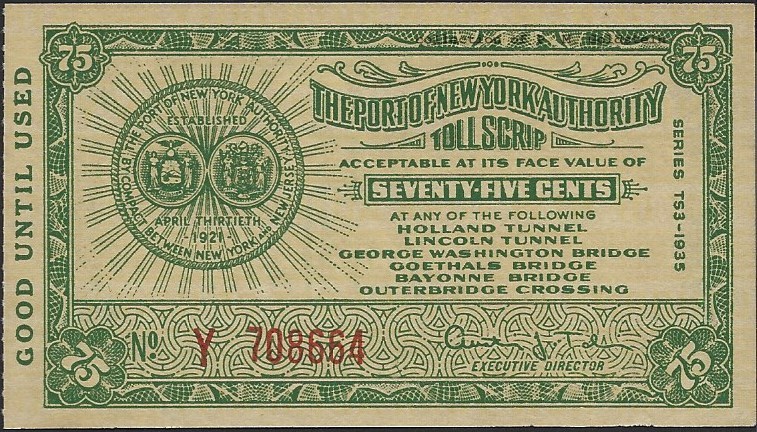 |
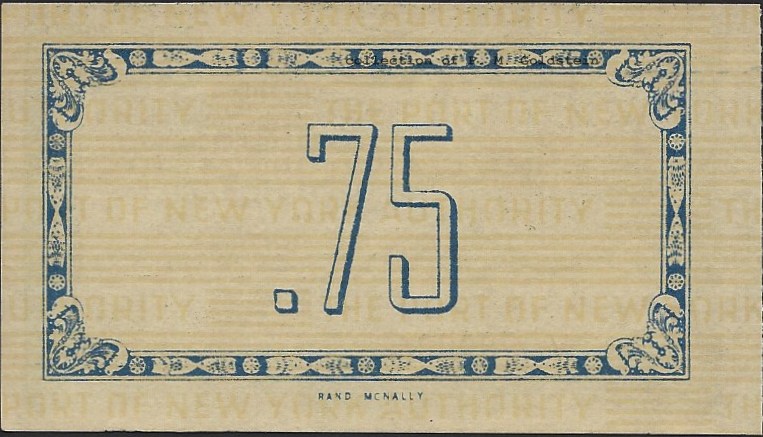 |
PoNYA - Series TS3 - 1935
(1942) - 75 cents
collection
of Philip M. Goldstein |
printer:
printing
method:
security printing, paper / watermark:
design colors,
face:
design
notes, face:
security underprinting, signature field:
facsimile
signature:
serial number:
design colors, back:
design notes, back:
notes, other:
size: |
Rand McNally
lithography
alternating 5 lines with Port of New York
Authority in horizontal format
green
8 pt Gloucester (serif) "GOOD UNTIL USED"
crescent, wedge & line
Austin J. Tobin, Executive Director,
see below
red prefix & serial number
blue
twist & floret single frame with Agency numerals
3 ¾" (width) - 2 ⅛" (height) - 0.005"
(thickness) |
| $1.00 |
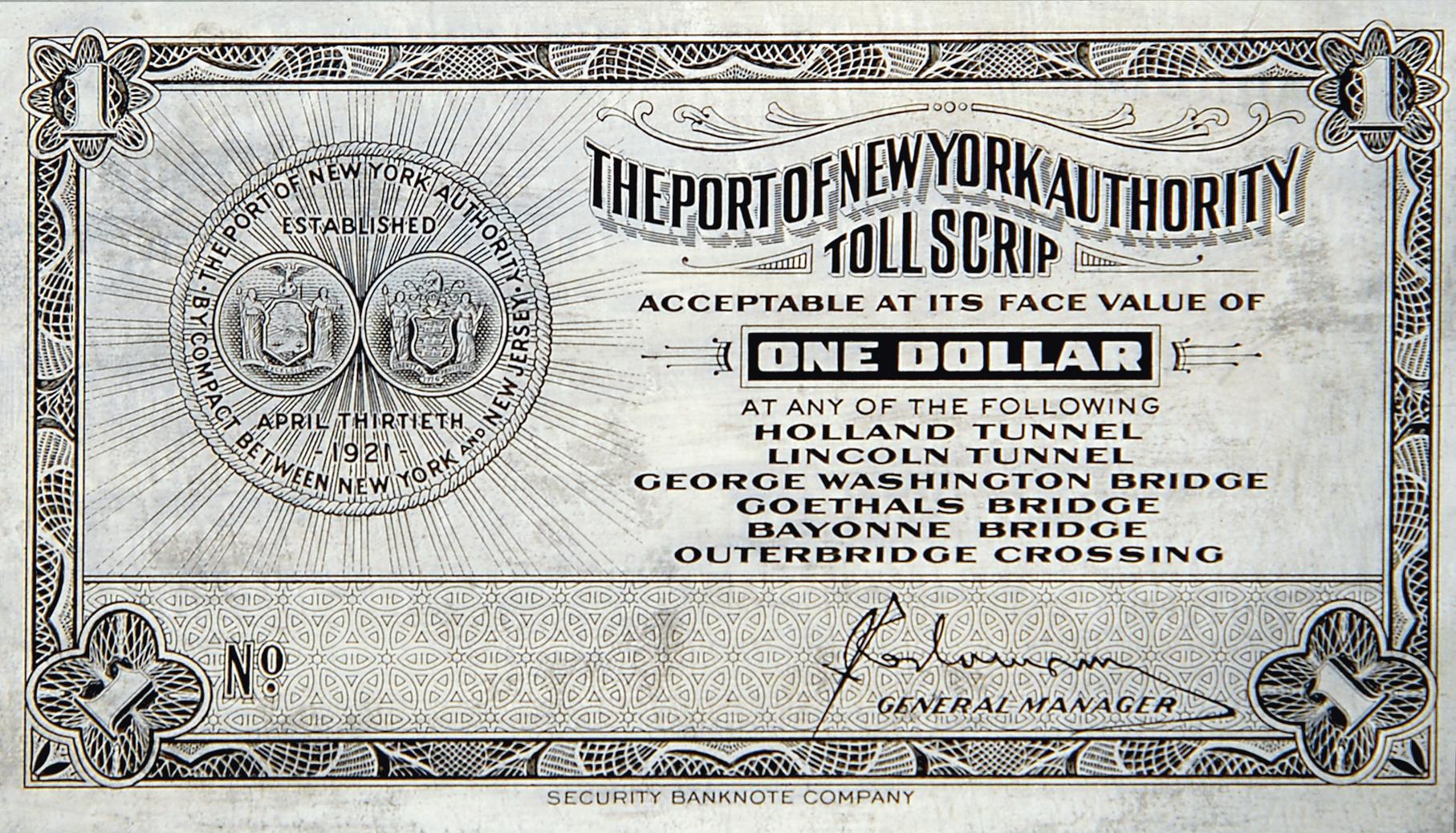 |
|
PoNYA -
Series TS3 - 1935 - $1.00
|
printer:
printing
method:
security printing, paper / watermark:
design colors,
face:
design
notes, face:
security underprinting, signature field:
facsimile
signature:
serial number:
design colors, back:
design notes, back:
notes, other:
size: |
Security Banknote Company
intaglio
unknown
unknown - presumed to be orange-red
series presumed to be in red, no
"GOOD UNTIL USED",
"INTERSTATE CROSSINGS" removed, "LINCOLN TUNNEL"
added,
lenticular ovals (footballs), triangles & 6 point
stars
J. E. Ramsey, General Manager
unknown - presumed to be red prefix & serial number
unknown - presumed to be orange-red
unknown - presumed to be frame with guilloche
3 ¾" (width) - 2 ⅛" (height) - unknown -
presumed to be cardstock |
.
.
|
|
 |
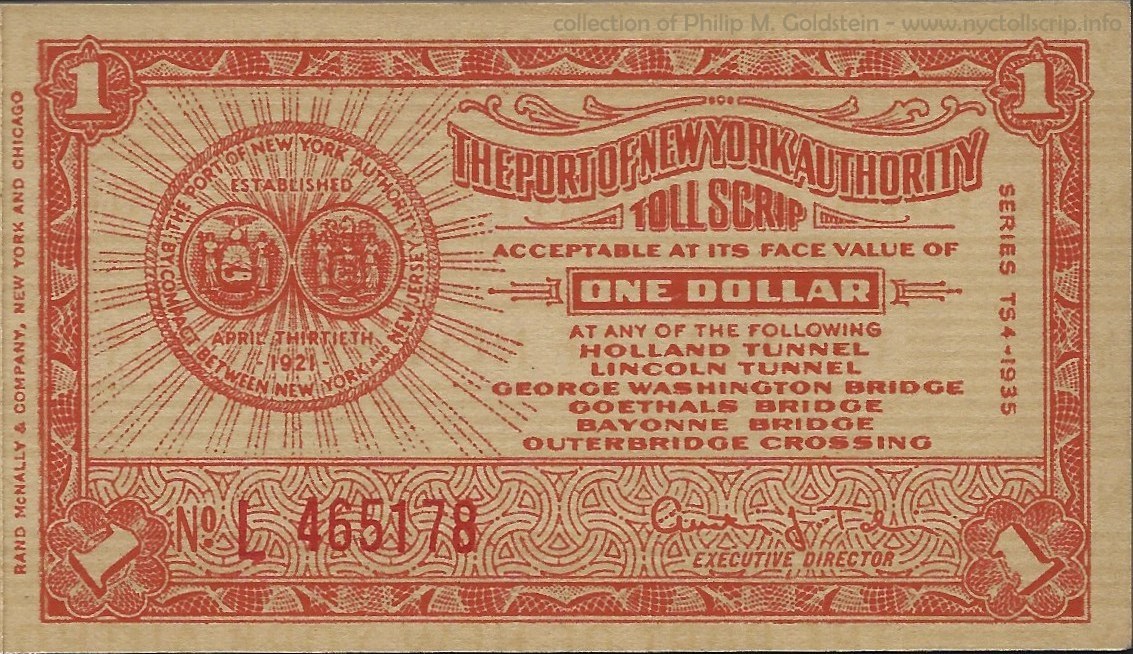 |
 |
PoNYA -
Series TS4 - 1935 (1942) - $1.00
collection
of Philip M. Goldstein |
printer:
printing
method:
security printing, paper / watermark:
design colors,
face:
design
notes, face:
security underprinting, signature field:
facsimile
signature:
serial number:
design colors, back:
design notes, back:
notes, other:
size: |
Rand McNally & Company,
New York & Chicago
lithography
alternating 5 lines with Port of New York
Authority in horizontal format
orange-red
no "GOOD UNTIL USED", series in face
color
crescent, wedge & line
Austin J. Tobin, Executive Director
red prefix & serial number
orange-red
twist & floret single frame with guilloche
3 ¾" (width) - 2 ⅛" (height) -
0.005" (thickness) |
.
.
|
|
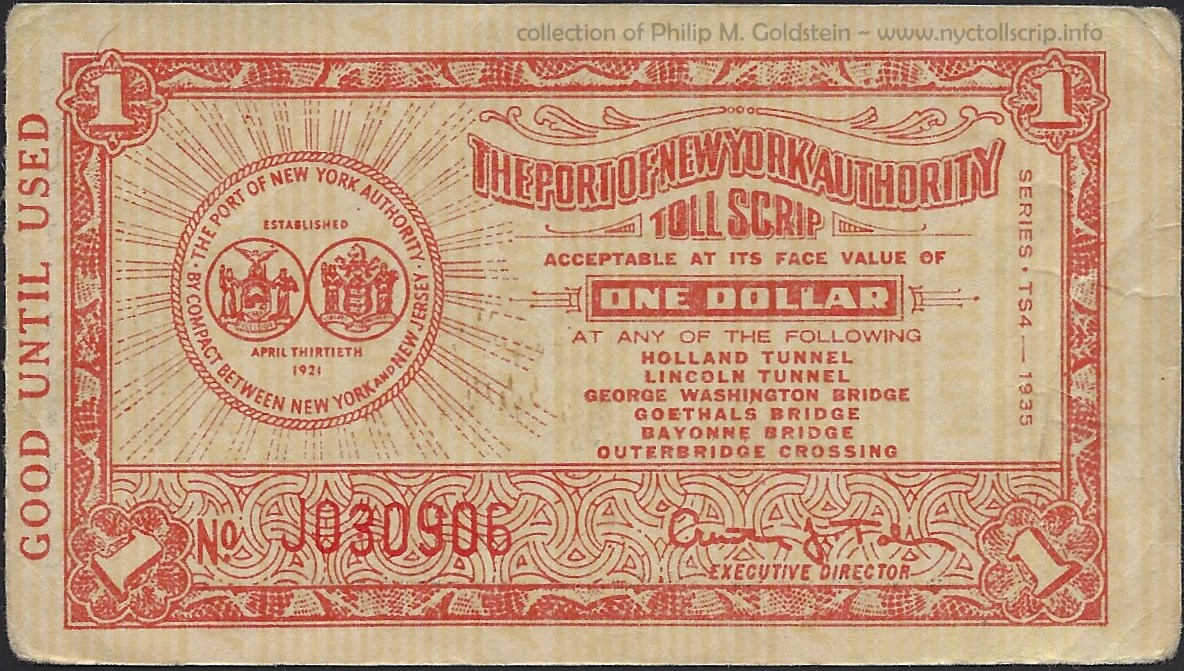 |
 |
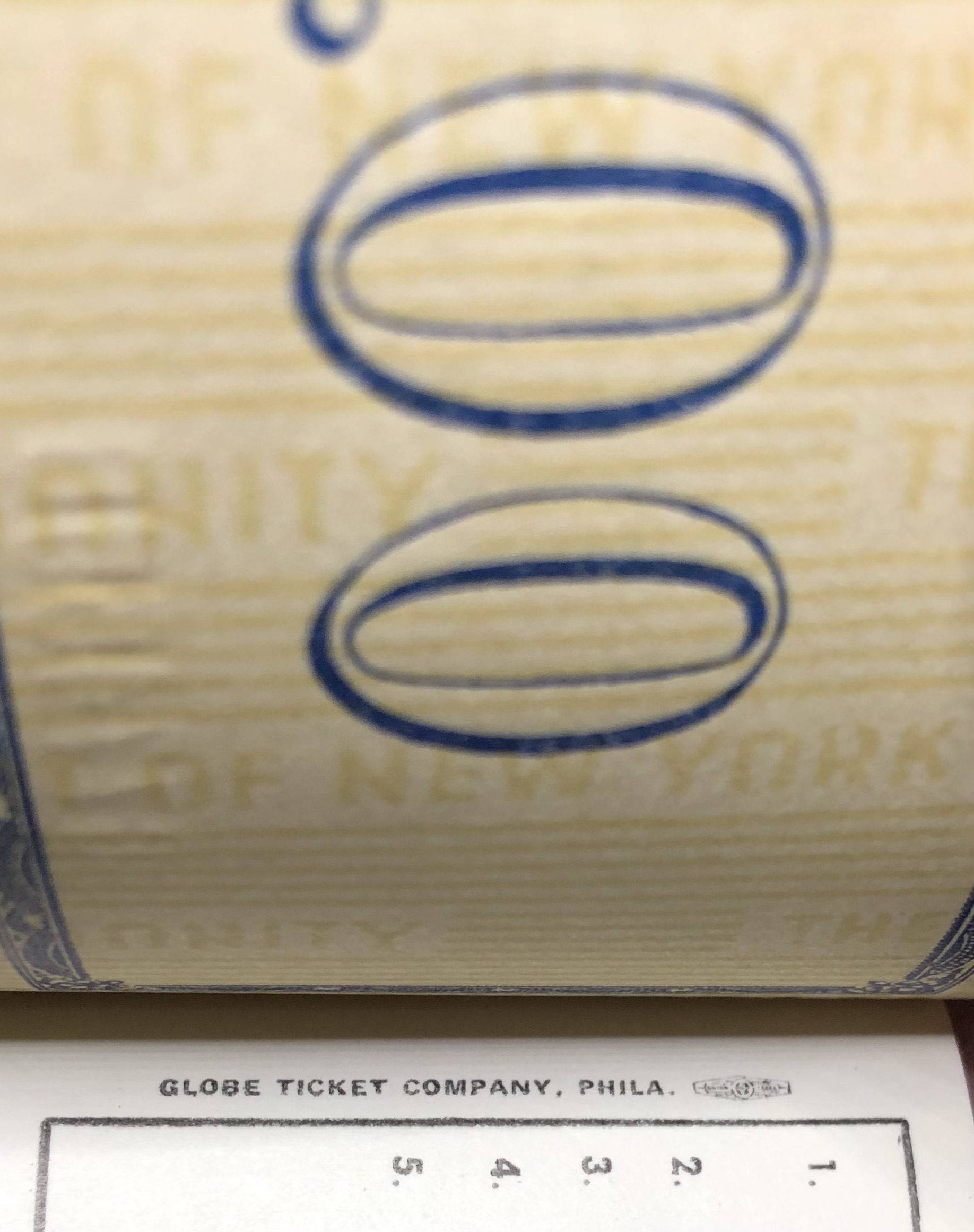 |
PoNYA - Series TS4 - 1935
(1942) - $1.00
single frame back, Banknote Roman serif
numerals - lithograph
different font for crossing
list, large "GOOD UNTIL USED"
collection of
Philip M. Goldstein |
printer:
printing
method:
security printing, paper / watermark:
design colors,
face:
design
notes, face:
security underprinting, signature field:
facsimile
signature:
serial number:
design colors, back:
design notes, back:
notes, other:
size: |
Globe Ticket (marked only on inside back cover of booklets)
lithography
alternating 5 lines with Port of New York
Authority in vertical format
orange-red
10 pt Gloucester (serif) "GOOD UNTIL USED" large
10 pt. Gloucester "GOOD UNTIL USED",
interpunct between SERIES and TS4, long
hyphen between TS4 and 1935, thick signature
"AT ANY OF THE FOLLOWING" and
list of Bridges & Tunnels in Franklin Gothic (sans-serif) font
crude crescent, wedge & line
Austin J. Tobin, Executive Director
(thick)
red prefix & serial number, no space between prefix & serial number
blue
wave single frame with Banknote Roman
note slightly larger than other issues
3 27/32" (width) - 2 5/32"
(height) - 0.005" (thickness) |
.
.
|
|
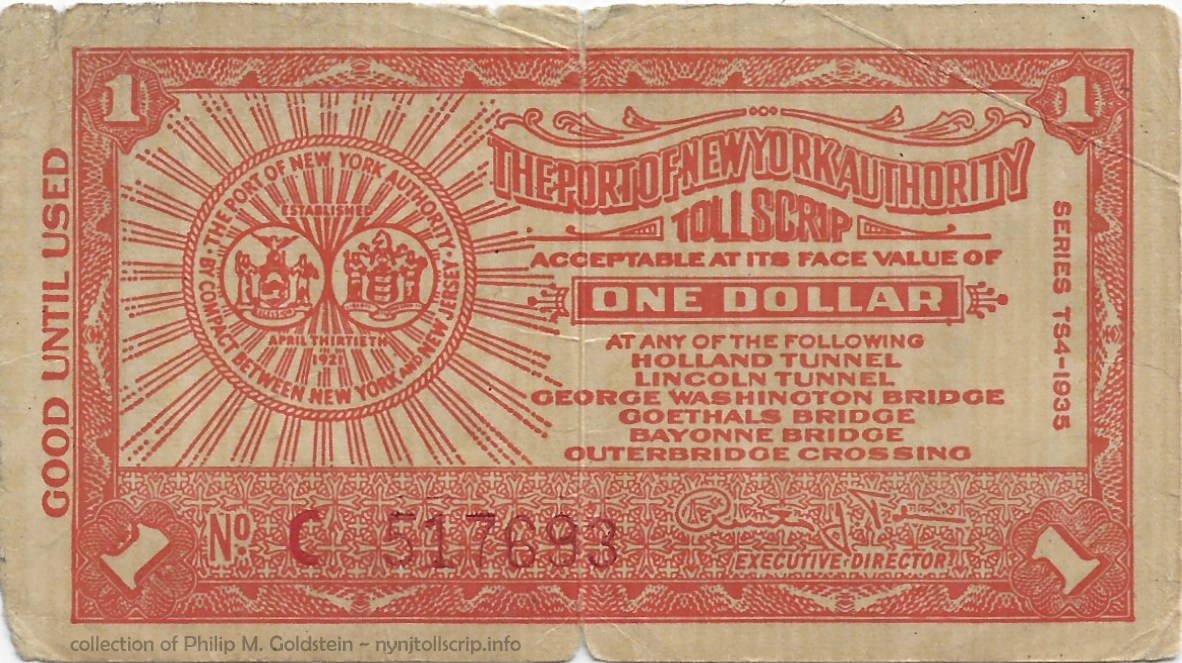 |
 |
PoNYA -
Series TS4 - 1935 (1942) - $1.00
also a birthday note 51769x!
|
printer:
printing
method:
security printing, paper / watermark:
design colors,
face:
design
notes, face:
security underprinting, signature field:
facsimile
signature:
serial number:
design colors, back:
design notes, back:
notes, other:
size: |
unknown
lithography
unknown
orange-red
Optima (sans-serif) "GOOD UNTIL USED"
crosses
Austin J. Tobin, Executive Director
red prefix & serial number, no space between prefix & serial number
blue
double frame with Banknote Roman
numerals
overstamp Orange And Black Bus Lines (Fairview, NJ) on back
3 ¾" (width) - 2 ⅛" (height) -
0.005" (thickness) |
.
.
|
|
 |
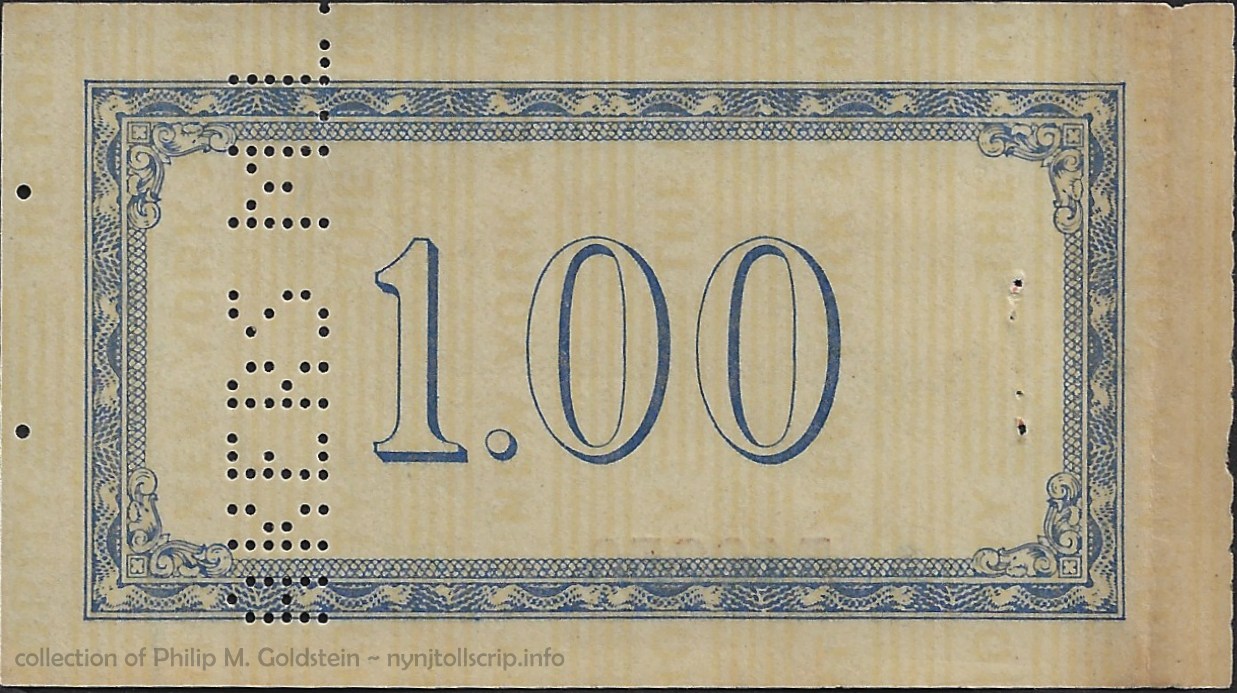 |
| PoNYA -
Series TS4 - 1935 (1942) - $1.00 |
printer:
printing
method:
security printing, paper / watermark:
design colors,
face:
design
notes, face:
security underprinting, signature field:
facsimile
signature:
serial number:
design colors, back:
design notes, back:
notes, other:
size: |
unknown
lithography
alternating 5 lines with Port of New York
Authority in vertical format
orange-red
Optima (sans-serif) "GOOD UNTIL USED"
crosses
Austin J. Tobin, Executive Director
red prefix & serial number, no space between prefix & serial number
blue
double frame with Banknote Roman
numerals
perforated for AKERS M. L. (Motor Lines), two dot perf on edge
3 ¾" (width) - 2 ⅛" (height) -
0.005" (thickness) |
.
. |
|
 |
 |
PoNYA - Series TS4 -
1935 (1942) - $1.00
frame back, Agency square block sans-serif
numerals - lithograph
collection
of Philip M. Goldstein |
printer:
printing
method:
security printing, paper / watermark:
design colors,
face:
design
notes, face:
security underprinting, signature field:
facsimile
signature:
serial number:
design colors, back:
design notes, back:
notes, other:
size: |
Rand McNally
lithography
alternating 5 lines with Port of New York
Authority in horizontal format
orange-red
8 pt Gloucester (serif) "GOOD UNTIL USED"
crescent, wedge & line
Austin J. Tobin, Executive Director
red prefix & serial number
blue
twist & floret frame with Agency numerals
3 13/16" (width) - 2 ⅛" (height)
- 0.005" (thickness) |
.
. |
|
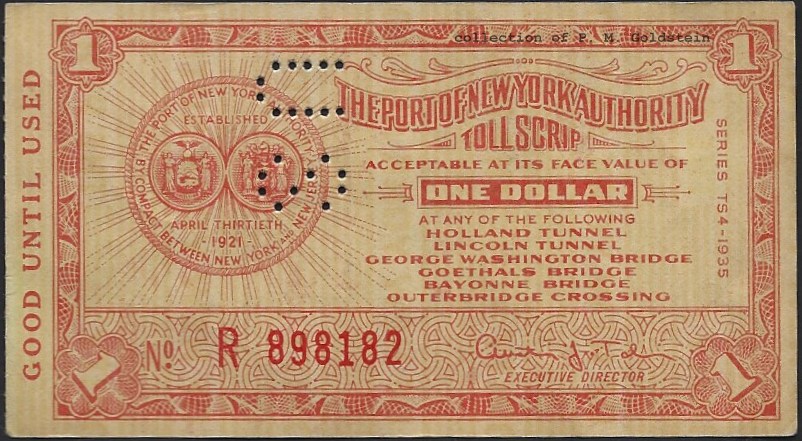 |
 |
|
PoNYA - Series TS4 - 1935 (1942) - $1.00
perforated: "U S " (presumably government issue)
collection
of Philip M. Goldstein
|
printer:
printing
method:
security printing, paper / watermark:
design colors,
face:
design
notes, face:
security underprinting, signature field:
facsimile
signature:
serial number:
design colors, back:
design notes, back:
notes, other:
size: |
Rand McNally
lithography
alternating 5 lines with Port of New York
Authority in vertical format
orange-red
8 pt Gloucester (serif) "GOOD UNTIL USED"
crescent, wedge & line
Austin J. Tobin, Executive Director
red prefix & serial number
blue
twist & floret frame with Agency numerals
perforated U S
3 ¾" (width) - 2 ⅛" (height) -
0.005" (thickness) |
| $1.50 |
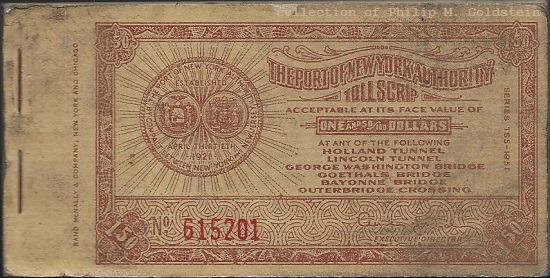 |
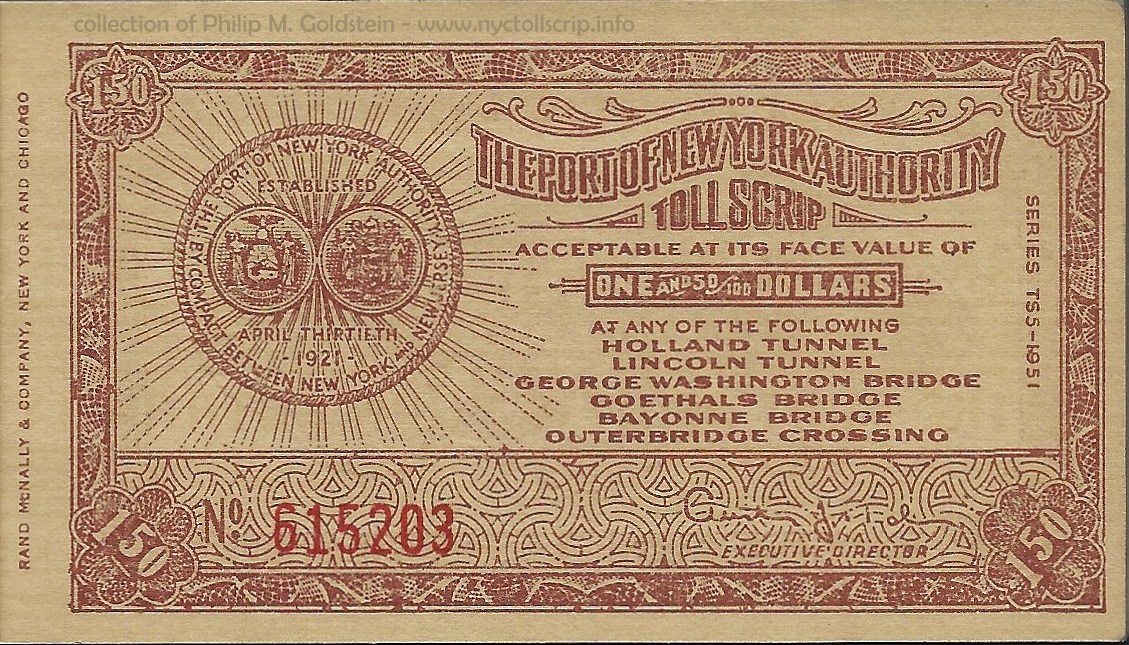 |
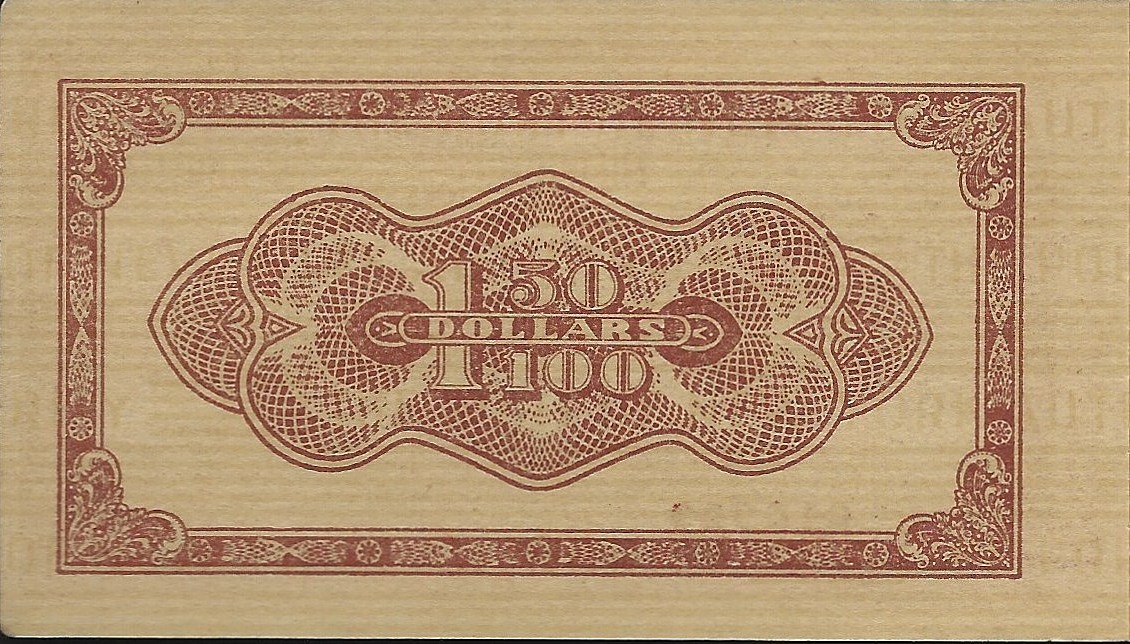 |
PoNYA -
Series TS5 - 1951 - $1.50 dollar
guilloché back
- lithograph
collection
of Philip M. Goldstein |
printer:
printing
method:
security printing, paper / watermark:
design colors,
face:
design
notes, face:
security underprinting, signature field:
facsimile
signature:
serial number:
design colors, back:
design notes, back:
notes, other:
size: |
Rand McNally & Company,
New York & Chicago
lithography
alternating 5 lines with Port of New York
Authority in horizontal format
maroon
no "GOOD UNTIL USED"
crescent, wedge & line
Austin J. Tobin, Executive Director
no prefix, red serial number
maroon
twist & floret frame with guilloche
3 ¾" (width) - 2 ⅛" (height) -
0.005" (thickness) |
.
.
|
|
same
design as 75 & 1.00 cent note
with
sans-serif "GOOD UNTIL USED" and
crosses security
field for signature area |
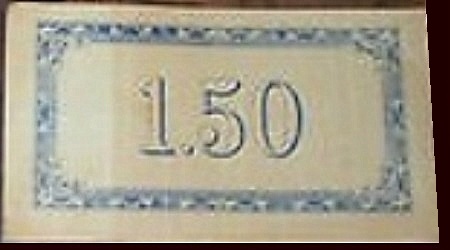 |
PoNYA -
Series TS5 - 1951 - $1.50 dollar
frame back w/ Banknote Roman serif
numerals - lithograph? |
printer:
printing
method:
security printing, paper / watermark:
design colors,
face:
design
notes, face:
security underprinting, signature field:
facsimile
signature:
serial number:
design colors, back:
design notes, back:
notes, other:
size: |
unknown
lithography
unknown - believed to be crosses
maroon
Optima (sans-serif) "GOOD UNTIL USED"
crosses
Austin J. Tobin, Executive Director
red prefix & serial number
blue
double frame with Banknote Roman numerals
3 ¾" (width) - 2 ⅛" (height) -
0.005" (thickness) |
.
.
|
|
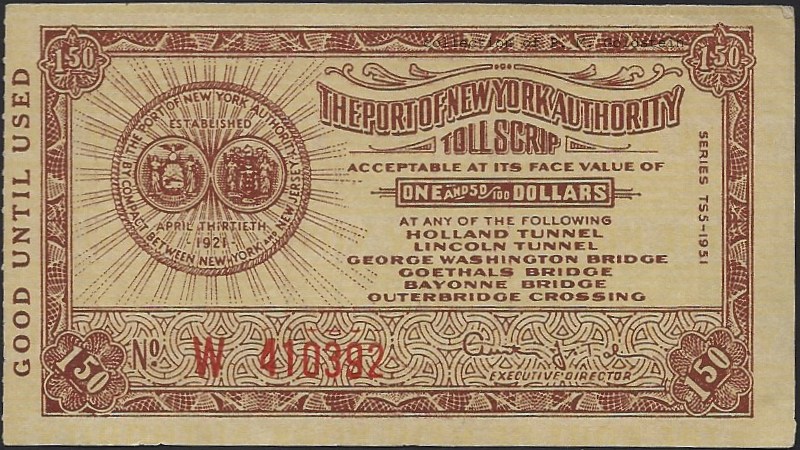 |
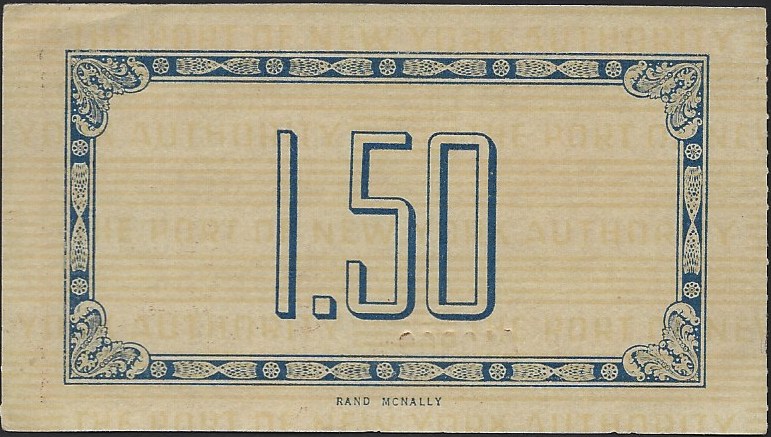 |
PoNYA - Series TS5 -
1951 - $1.50
frame back, Agency
square block sans-serif numerals - lithograph
collection
of Philip M. Goldstein |
printer:
printing
method:
security printing, paper / watermark:
design colors,
face:
design
notes, face:
security underprinting, signature field:
facsimile
signature:
serial number:
design colors, back:
design notes, back:
notes, other:
size: |
Rand McNally
lithography
alternating 5 lines with Port of New York
Authority horizontal format
maroon
8 pt. Gloucester (serif) "GOOD UNTIL USED"
crescent, wedge & line
Austin J. Tobin, Executive Director
red prefix & serial number
blue
twist & floret single frame with Agency
numerals
3 ¾" (width) - 2 ⅛" (height) -
0.005" (thickness) |
Port of New York
Authority "original design" - Commutation Books & Passes
In addition to the TS Series 1-2-3-4-5 scrip above, we
know of other series issued at this time: F-4, H-3, H-4, H-5, and
P. These were known as Commutation Tickets.
Where
commuter tickets differ from toll scrip is, toll scrip was good until
used (with no expiration date) and offered a minimal discount in
consideration of advance purchase; whereas commutation tickets had an
expiration date. The shorter the expiration the date, the greater the
discount offered. In this manner, it was hoped that if you did not
use all of the scrip purchased, the revenue from the unredeemed tickets
would be a windfall to the issuing agency. Likewise, the longer period
of time you had to use your tickets, ensured a higher redemption rate
and therefore were issued at a lower discount rate.
In short, a commutation
book contain a supply of tickets, usually only good for a set period of
time, and were offered at a discount below the singular one way or
round trip toll and further below the discount of scrip. This made it
convenient for the commuter who drove to work on average 20
business day per month and who was almost certainly going to use all
the scrip in that period of time.
Series H - Passenger
Automobiles
Referencing the Annual Reports of the Port of New York Authority,
as well as comparing covers and tickets in my collection, I was able to
ascertain some definition of the assigned series nomenclature.
The Series H-3, H-4, H-5 are understood to
be Commutation Scrip for Passenger Automobiles.
Series H-4 is mentioned in the 1950 Annual Report as first
being issued June 15, 1950 in the form of ticket for $10.00, valid for 30 days. Also mentioned are commutation
issues for Staten Island Crossings that had been available for over 20
years. These are believed to be, Series H-3 as the tickets and covers
witnessed are for Goethals, Outerbridge or Bayonne Bridges.
This leaves Series H-5. While not mentioned in the annual
reports by that designation, the report mentions a commutation issue in
the form of booklets containing 25 tickets for $10.00 good for two
years. Again, covers in my collection are witnessed to be marked H-5
that conform to this tariff and time period.
There is no mention of Series H-1 or H-2 commutation
issues, however. Delving into older Port of New York Authority Annual
Reports does reveal there were other proposed commutation ticket
issues.
In 1928 however, a proposal for
the following commutation issues:
- 12
tickets, good for one week and sold for $4.20 (35¢ per trip),
- 12
tickets, valid for two weeks and sold for $4.80 (40¢ per trip).
Response
to this proposal was favorable
yet limited and the report states they were not implemented.
In the 1930 Annual Report, two more issues were proposed:
- 26
tickets good for 30 days, sold for $6.00 (23¢) and
- 60
tickets good for 30 days, sold for $15.00 (25¢).
These issues were
implemented. It is therefore believed (but unconfirmed) that these are
the Series H-1 and H-2 issues. |
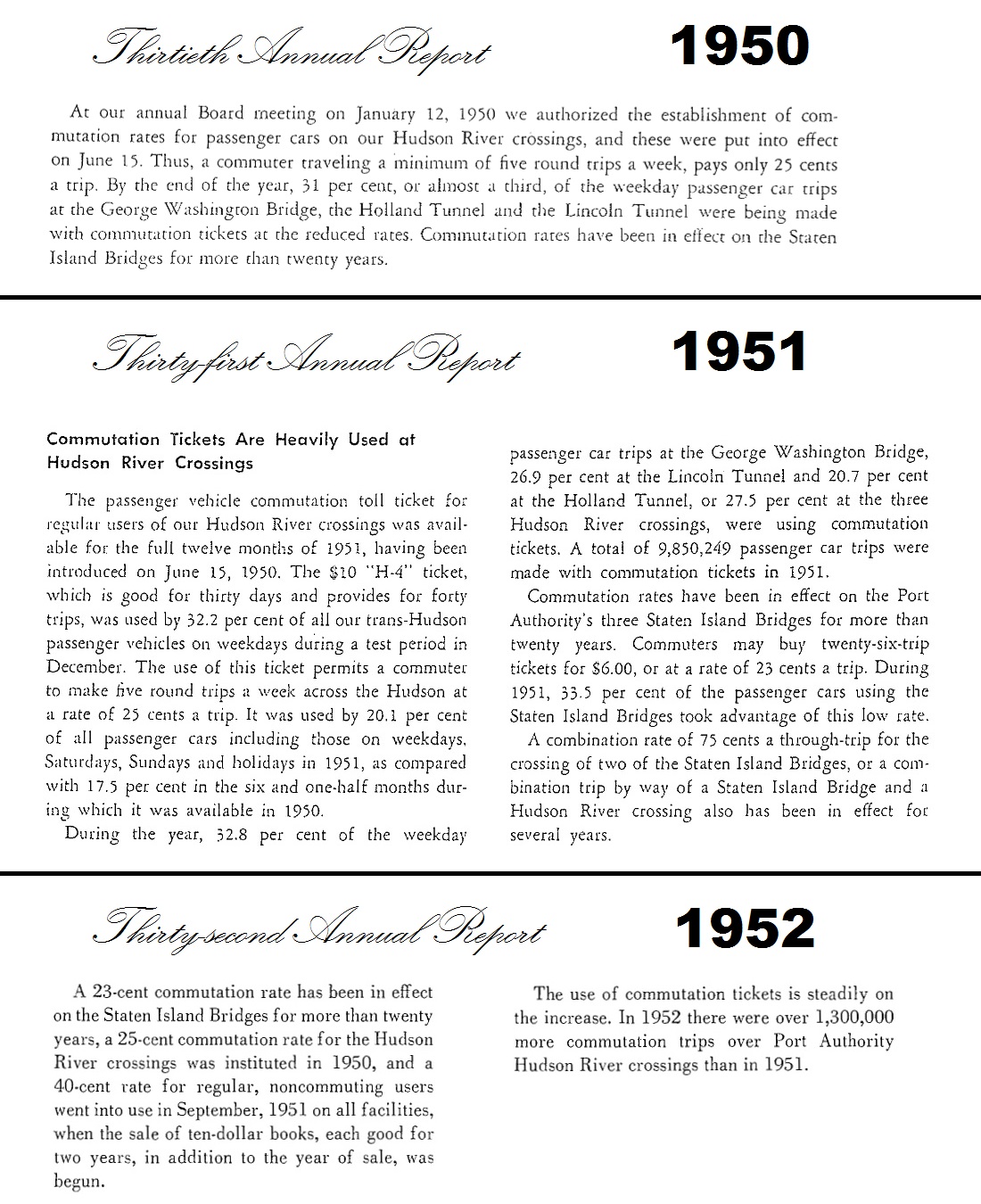 |
Acquired
by the author in February 2023, the following question and answer
brochure not only explains the rules and regulations of using the new
Series H-4 Commutation Ticket as issued in June 1950, but also contains
a photograph of said Commutation ticket! This format of ticket is not
what we would have come to expect. It was not a quantity of tickets
bound in booklet form as would appear later in the issues; but it
consisted of a single ticket that contained a grid of 40 boxes to be
punched or marked by the toll collector.
Series H-3
26 Trips good for 30 days? - $6.00
Staten Island Crossings only |
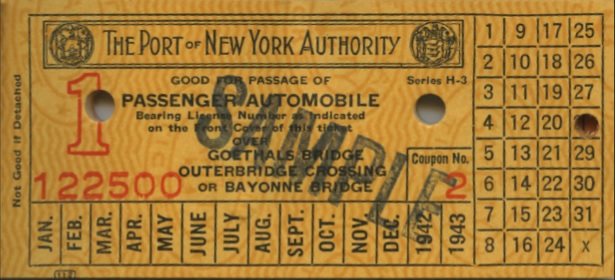
ticket
|
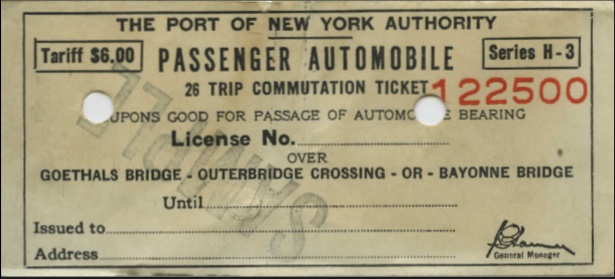
booklet
cover
|
|
PoNYA Series H-3 - Passenger Automobile Commutation - 1942/1943
30 day / 26 trip / $6.00 - Staten Island Crossings only
collection
of MTA Archives
|
printer:
printing
method:
security printing, paper / watermark:
design colors,
face:
design
notes, face:
security underprinting, signature field:
facsimile
signature:
serial number:
design colors, back:
design notes, back:
notes, other:
size: |
International
Ticket Company, Newark, NJ
lithography
wavy lines with National Security Ticket logo, vertical format
black
coupon number & vehicle class in red
n/a
none
red
unknown
unknown
twelve months,
two year along bottom
31 days punch tabs on right
unknown |
.
.
|
|
Series H-4
40 Trips good for 30 days, $10.00
Hudson River Crossings only |
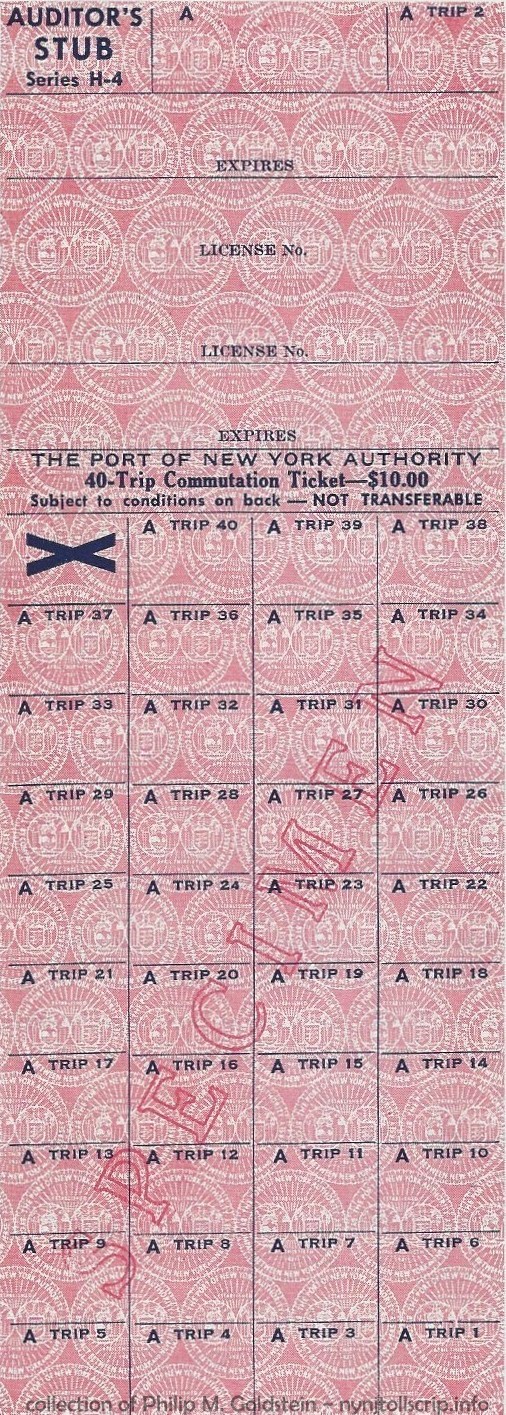 |
 |
PoNYA Series H-4 - Passenger Automobile Commutation (1950)
40 trip / 30 day / $10.00 - Hudson River Crossings only
|
.
. |
|
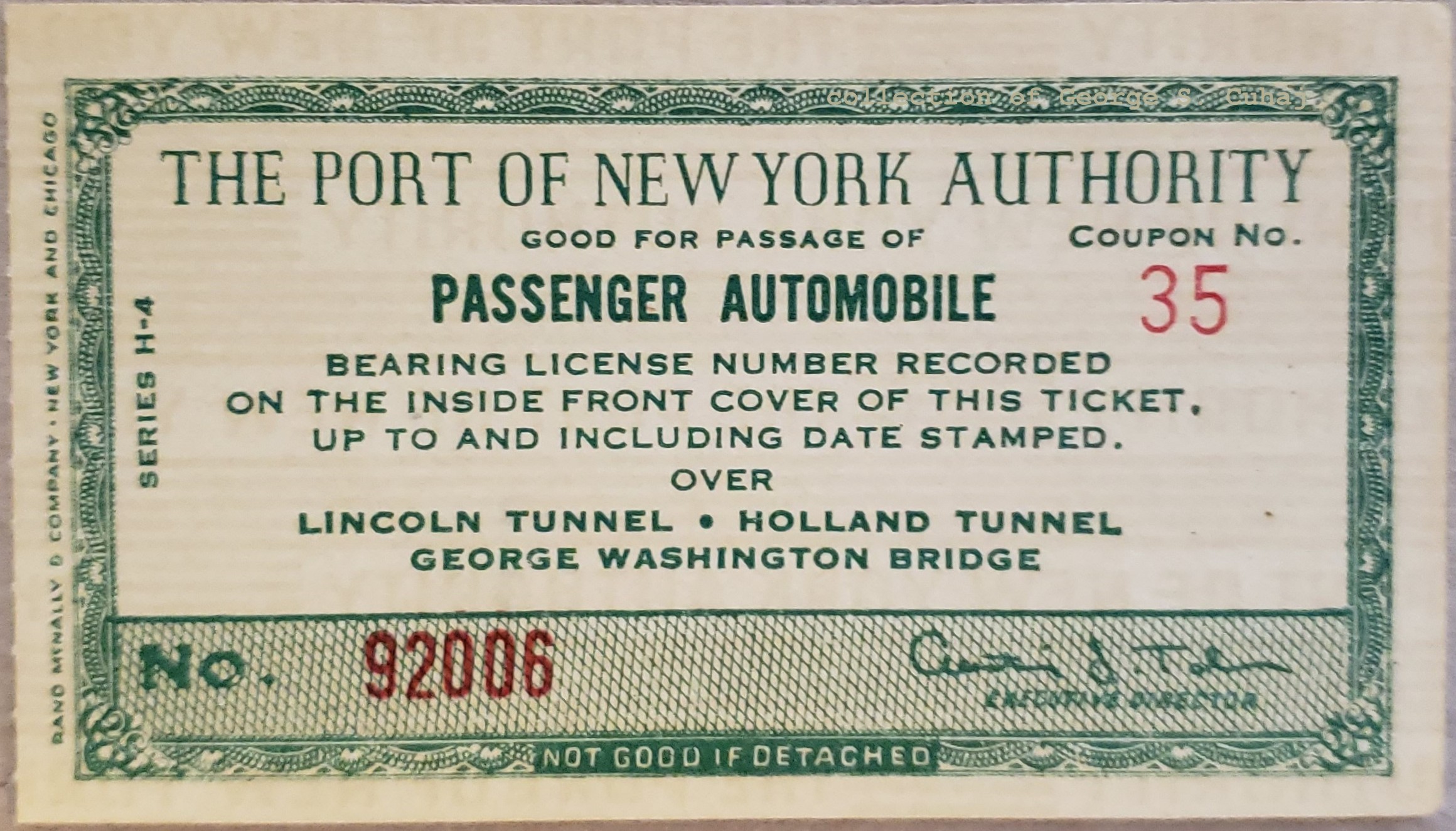 |
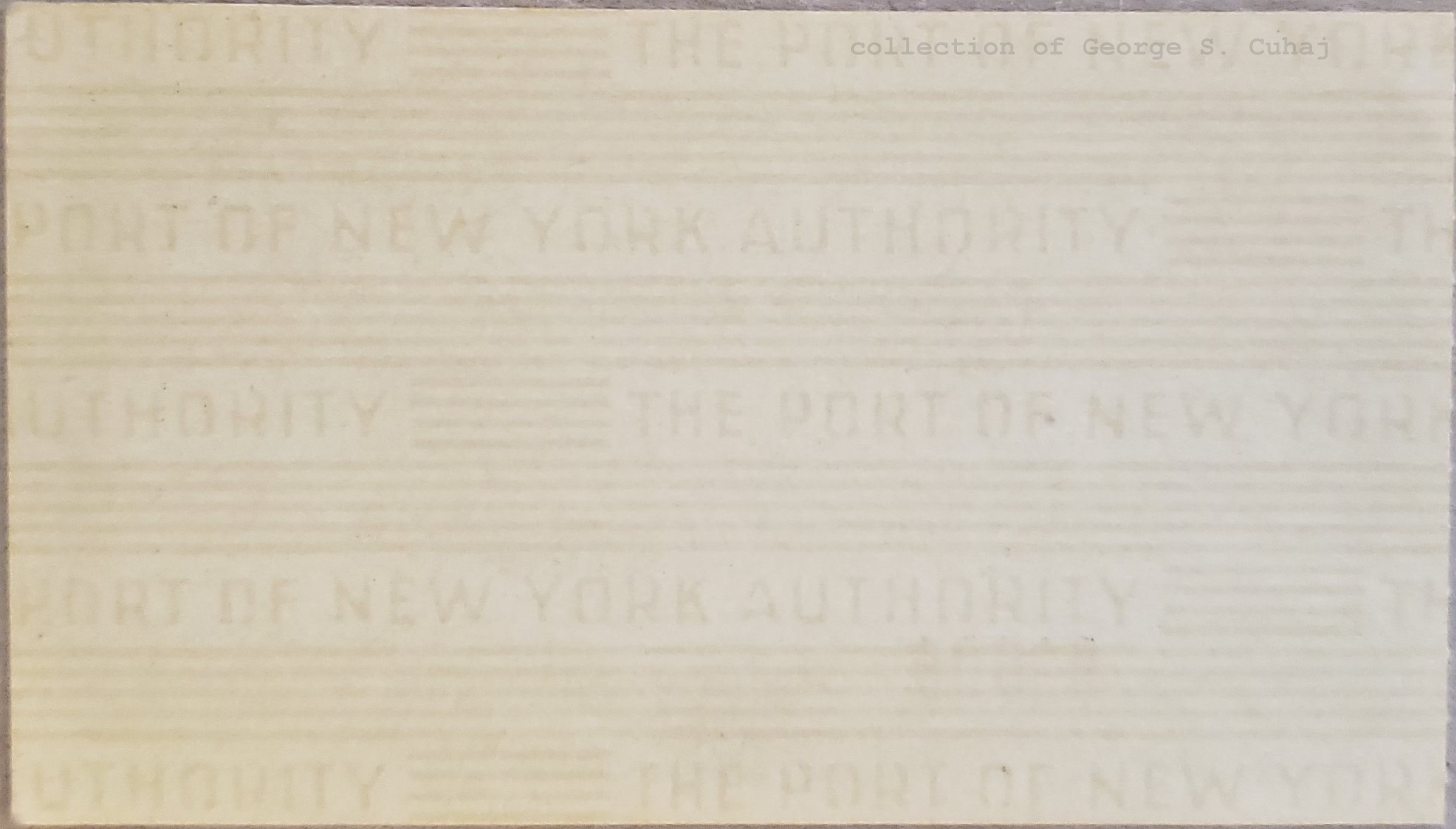 |
PoNYA Series H-4 - Passenger Automobile, Hudson River Commutation (1965)
40 trip / 30 day / $10.00 - Hudson River Crossings only
collection
of George S. Cuhaj |
printer:
printing
method:
security printing, paper / watermark:
design colors,
face:
design
notes, face:
security underprinting, signature field:
facsimile
signature:
serial number:
design colors, back:
design notes, back:
notes, other:
size: |
Rand
McNally & Company, New York & Chicago
lithography
alternating 5 lines with Port of New
York Authority horizontal format
green
coupon number in red
crosshatch
Austin J.
Tobin, Executive Director
red
n/a
blank
30 day
commutation - 40 trips, $10
unknown |
.
.
|
|
Series H-4
40 Trips good for 30 days, $10.00
all Crossings |
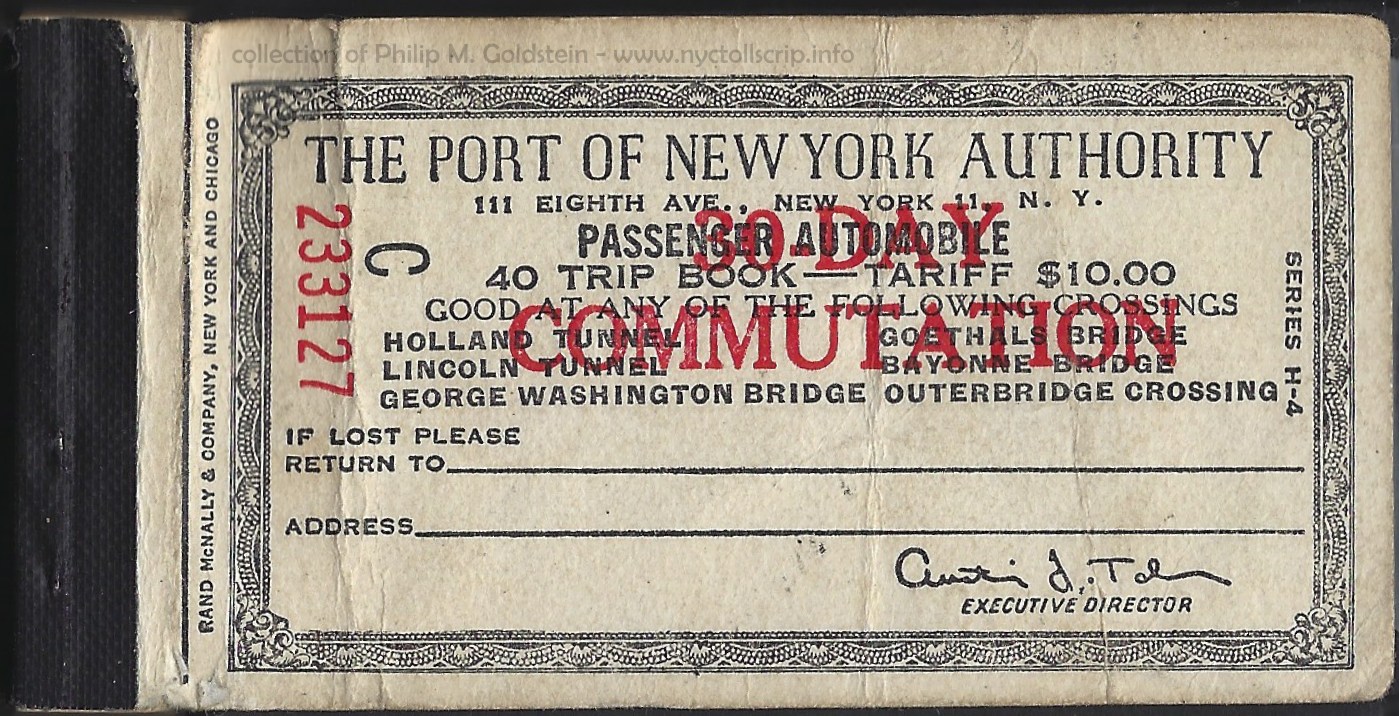
|
|
|
|
|
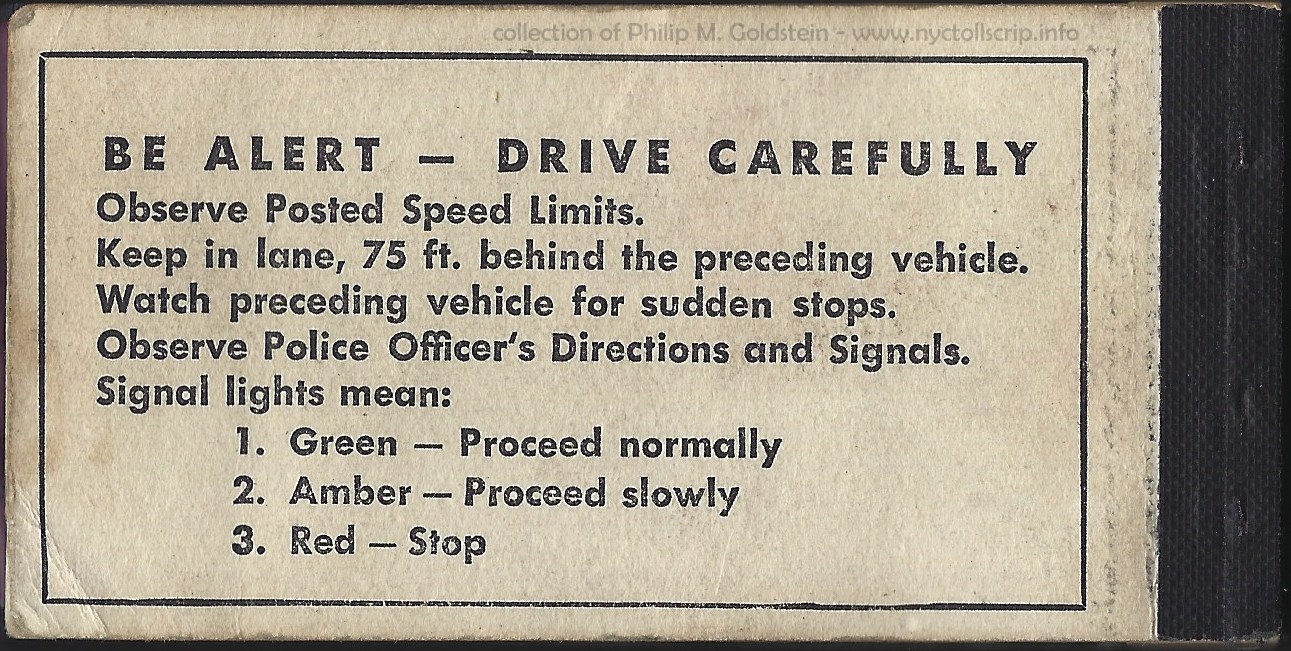 |
PoNYA Series H-4 (8/20/1960)
40 trip / 30 day / $10.00 - All Crossings
collection
of Philip M. Goldstein |
printer:
printing
method:
security printing, paper / watermark:
design colors,
face:
design
notes, face:
security underprinting, signature field:
facsimile
signature:
serial number:
design colors, back:
design notes, back:
colors,
face (cover):
colors, back (cover):
notes, other:
size: |
Rand
McNally
lithography
alternating 5
lines with Port of New York Authority horizontal format
black
coupon number & book value in red
crosshatch
Austin J.
Tobin, Executive Director
red prefix & serial
number on notes*
blue
single twist & floret
frame, blank
black on white
with red 30 DAY COMMUTATION
black on white,
contract on inner back cover
30 day commutation - 40 trips, $10
*black
prefix letter with red serial number on front cover, inner front cover
& flyleaf receipt
3 ¾" (width) - 2 ⅛"
(height) - 0.005" (thickness) |
.
. |
|
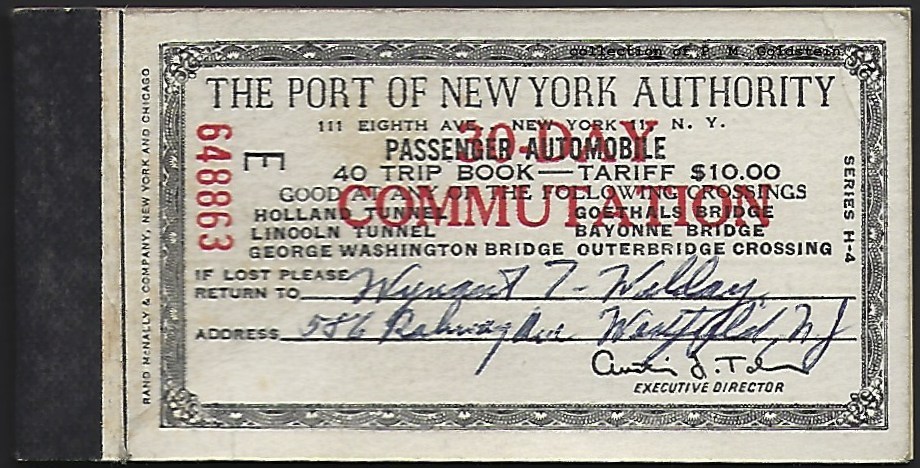
|
 |
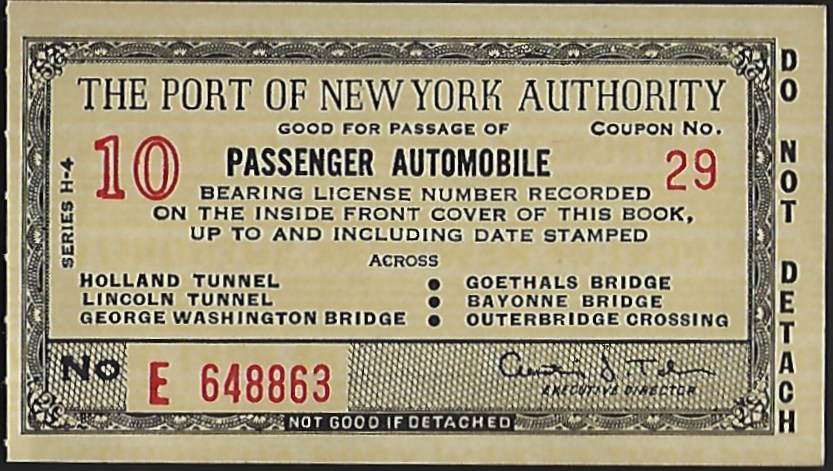 |
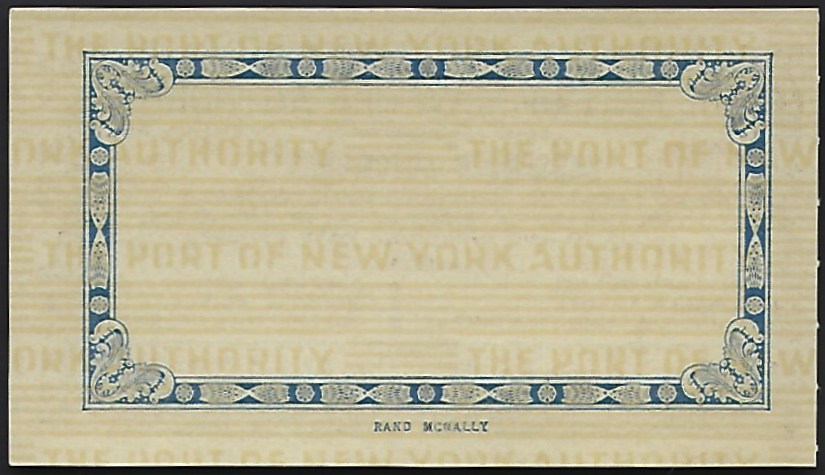 |
 |
 |
 |
PoNYA Series H-4 (7/14/1965)
40 trip / 30 day / $10.00 - all crossings
collection
of Philip M. Goldstein |
printer:
printing
method:
security printing, paper / watermark:
design colors,
face:
design
notes, face:
security underprinting, signature field:
facsimile
signature:
serial number:
design colors, back:
design notes, back:
colors,
face (cover):
colors, back (cover):
notes, other:
size: |
Rand
McNally
lithography
alternating 5
lines with Port of New York Authority horizontal format
black
serial, coupon number & book value in red
crosshatch
Austin J.
Tobin, Executive Director
red prefix & serial
number on notes*
blue
single twist & floret
frame, blank
black on white
with red 30 DAY COMMUTATION
black on white,
contract on inner back cover
30 day commutation - 40 trips, $10
*black
prefix letter with red serial number on front cover, inner front cover
& flyleaf receipt
3 ¾" (width) - 2 ⅛"
(height) - 0.005" (thickness) |
.
.
|
|
Series H-5
25 Trips good for 2 years, $10.00 |
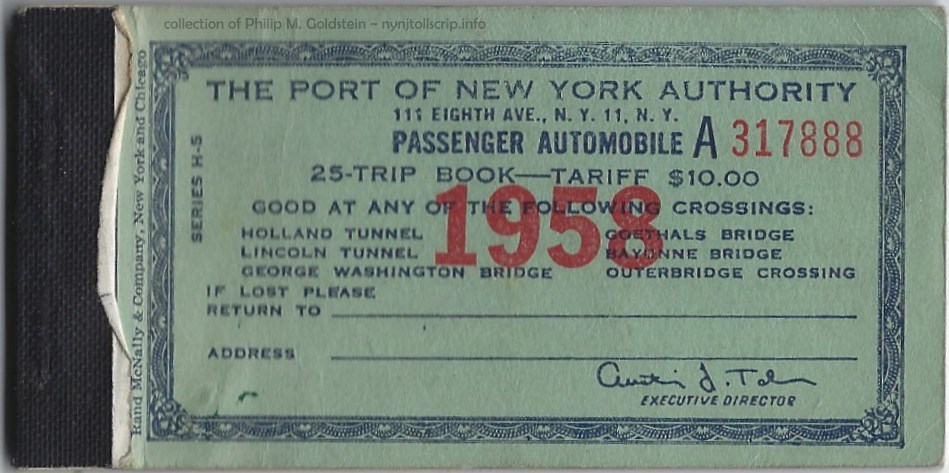 |
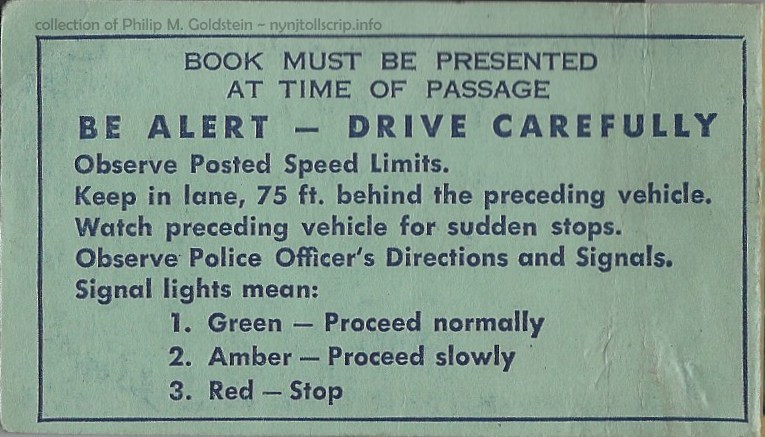 |
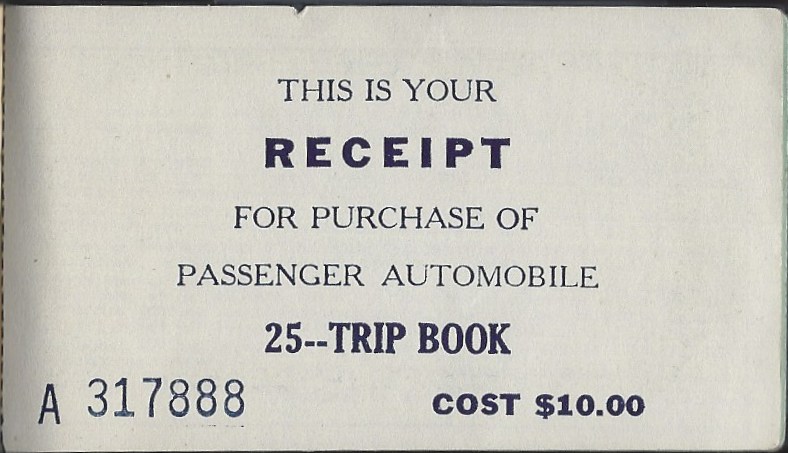 |
|
|
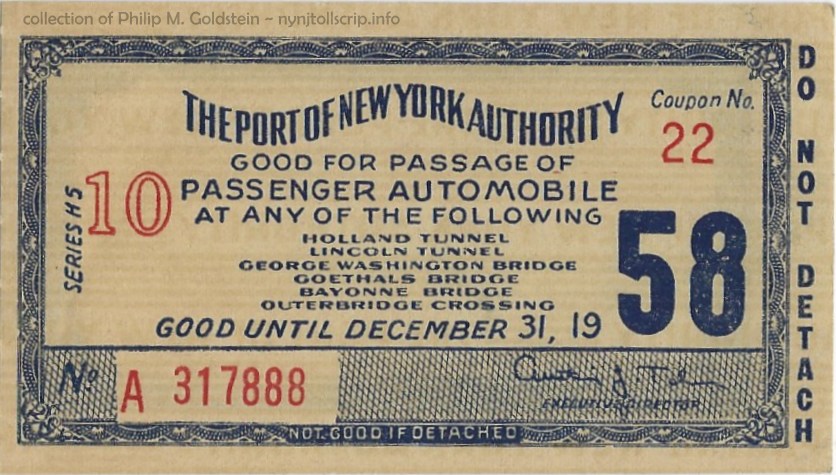 |
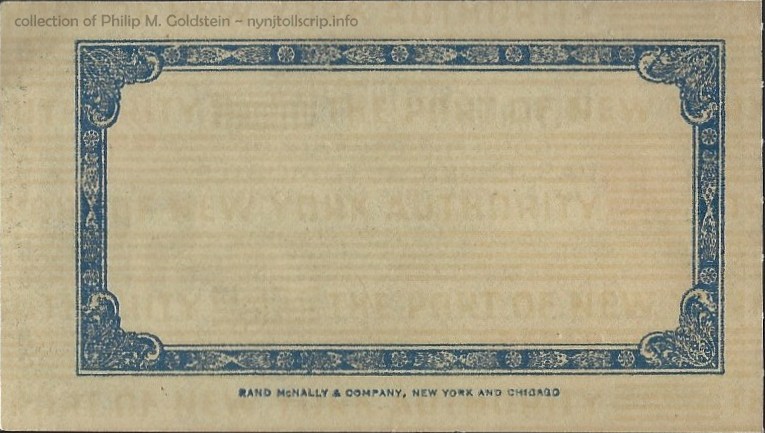 |
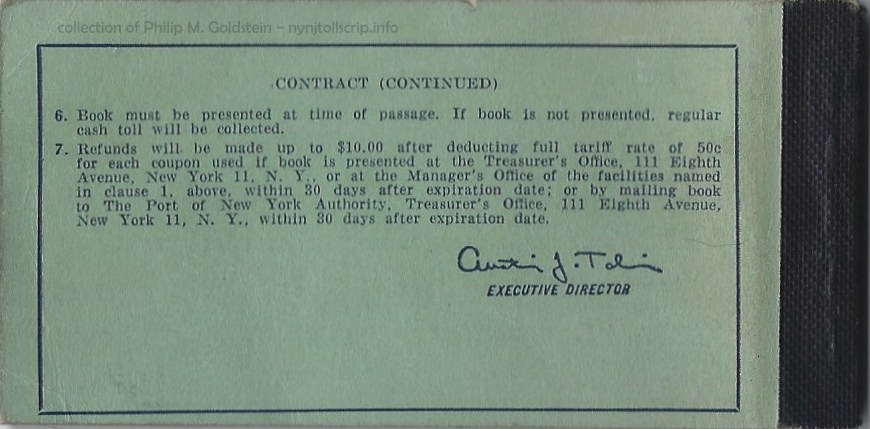 |
PoNYA Series H-5 - Passenger Automobile Commutation - 1958
25 trip / 2 Years / $10.00
collection
of Philip M. Goldstein
added 26 January 2023 |
printer:
printing
method:
security printing, paper / watermark:
design colors,
face:
design
notes, face:
security underprinting, signature field:
facsimile
signature:
serial number:
design colors, back:
design notes, back:
colors,
face (cover):
colors, back (cover):
notes, other:
size: |
Rand
McNally & Company, New York & Chicago
lithography
alternating 5
lines with Port of New York Authority horizontal format
serial, coupon number & book value in red
crosshatch
Austin J.
Tobin, Executive Director
C prefix & serial
number on notes
blue
blank twist & floret
single frame
dark blue on
blue with red 1967 & serial number, wave frame
dark blue on blue,
contract on inner & outer back cover
25 trip / 2 year commutation / $10
dark blue
prefix letter with dark blue serial number on flyleaf receipt
3 ¾" (width) - 2 ⅛"
(height) - 0.005" (thickness) |
|
|
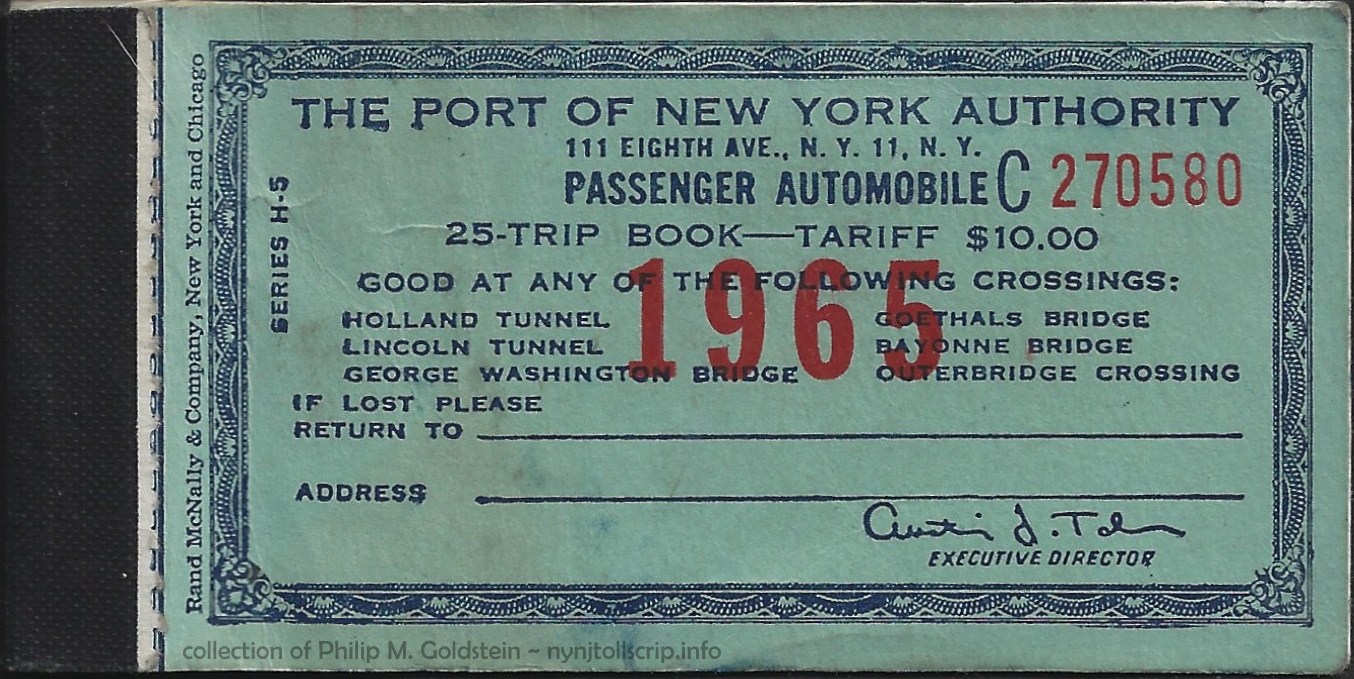 |
 |
 |
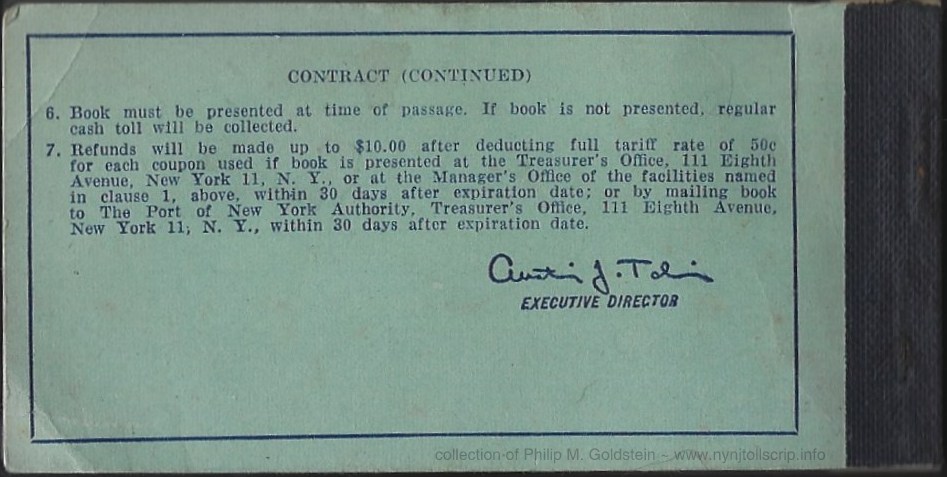 |
PoNYA Series H-5 - Passenger Automobile Commutation - 1965
25 trip / 2 Years / $10.00
collection
of Philip M. Goldstein |
printer:
printing
method:
security printing, paper / watermark:
design colors,
face:
design
notes, face:
security underprinting, signature field:
facsimile
signature:
serial number:
design colors, back:
design notes, back:
colors,
face (cover):
colors, back (cover):
notes, other:
size: |
Rand
McNally & Company, New York & Chicago
lithography
alternating 5
lines with Port of New York Authority horizontal format
serial, coupon number & book value in red
crosshatch
Austin J.
Tobin, Executive Director
C prefix & serial
number on notes
blue
blank twist & floret
single frame
dark blue on
blue with red 1967 & serial number, wave frame
dark blue on blue,
contract on inner & outer back cover
25 trip / 2 year commutation / $10
dark blue
prefix letter with dark blue serial number on flyleaf receipt
3 ¾" (width) - 2 ⅛"
(height) - 0.005" (thickness) |
.
. |
|
 |
 |
 |
 |
PoNYA Series H-5 - Passenger Automobile Commutation - 1966
25 trip / 2 Years / $10.00
collection
of Philip M. Goldstein |
printer:
printing
method:
security printing, paper / watermark:
design colors,
face:
design
notes, face:
security underprinting, signature field:
facsimile
signature:
serial number:
design colors, back:
design notes, back:
colors,
face (cover):
colors, back (cover):
notes, other:
size: |
Rand
McNally & Company, New York & Chicago
lithography
alternating 5
lines with Port of New York Authority horizontal format
serial, coupon number & book value in red
crosshatch
Austin J.
Tobin, Executive Director
C prefix & serial
number on notes
blue
blank twist & floret
single frame
dark blue on
blue with red 1967 & serial number, wave frame
dark blue on blue,
contract on inner & outer back cover
25 trip / 2 year commutation / $10
dark blue
prefix letter with dark blue serial number on flyleaf receipt
3 ¾" (width) - 2 ⅛"
(height) - 0.005" (thickness) |
.
. |
|
| booklet
cover only |
booklet
cover only |
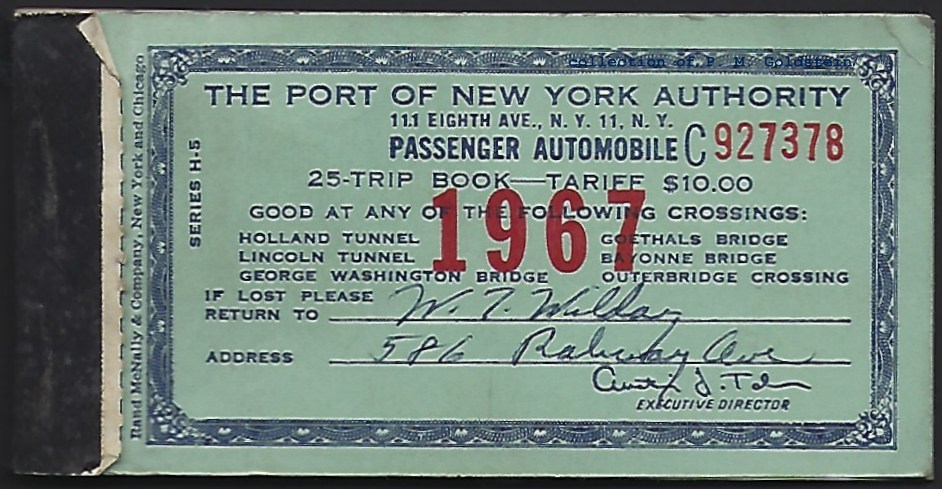 |
 |
 |
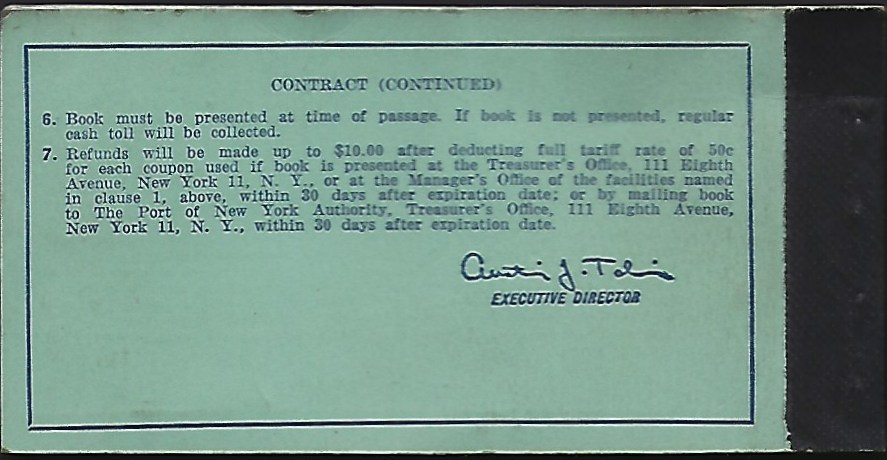 |
PoNYA Series H-5 - Passenger Automobile Commutation - 1967
25 trip / 2 Years / $10.00
collection
of Philip M. Goldstein |
printer:
printing
method:
security printing, paper / watermark:
design colors,
face:
design
notes, face:
security underprinting, signature field:
facsimile
signature:
serial number:
design colors, back:
design notes, back:
colors,
face (cover):
colors, back (cover):
notes, other:
size: |
Rand
McNally & Company, New York & Chicago
lithography
alternating 5
lines with Port of New York Authority horizontal format
dark blue ink; serial, coupon number & book value in red
crosshatch
Austin J.
Tobin, Executive Director
red C prefix & serial
number on notes
blue
blank twist & floret
single frame
dark blue on
blue with red 1967 & serial number, wave frame
dark blue on blue,
contract on inner & outer back cover
25 trip / 2 year commutation / $10
dark blue
prefix letter with dark blue serial number on flyleaf receipt
3 ¾" (width) - 2 ⅛"
(height) - 0.005" (thickness) |
.
. |
|
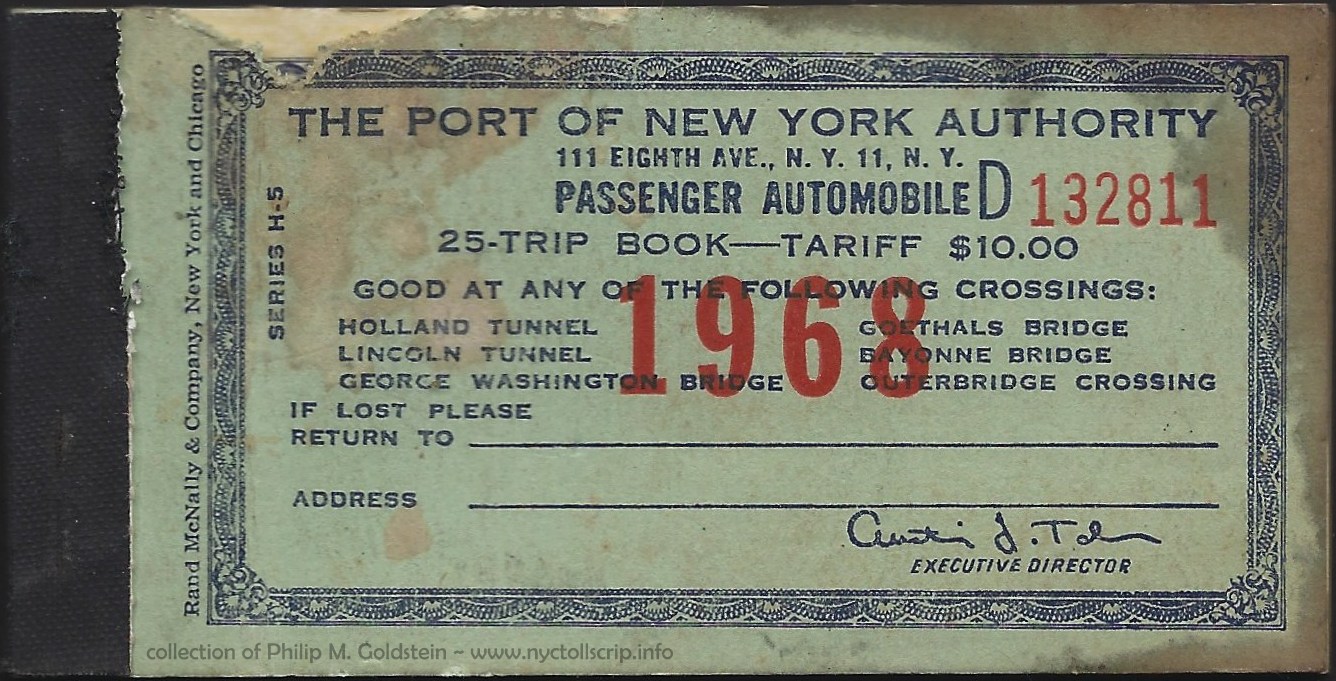 |
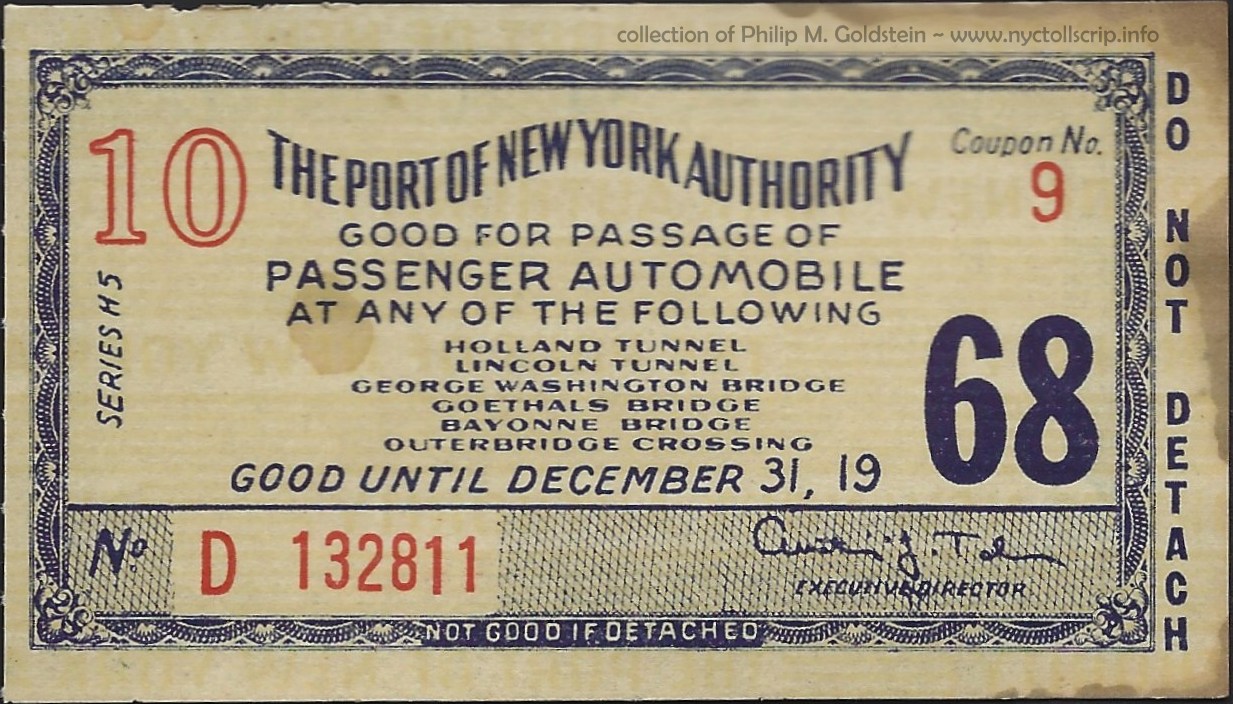 |
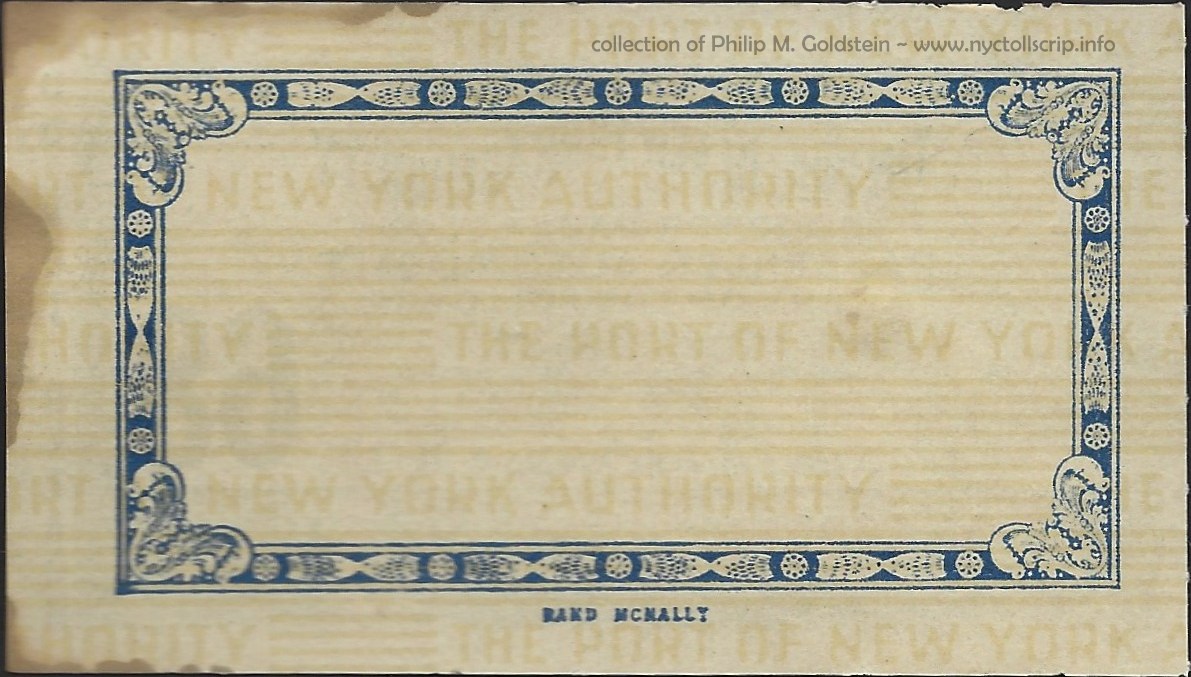 |
 |
 |
 |
PoNYA Series H-5 - Passenger Automobile Commutation - 1968
25 trip / 2 Years / $10.00
collection
of Philip M. Goldstein |
printer:
printing
method:
security printing, paper / watermark:
design colors,
face:
design
notes, face:
security underprinting, signature field:
facsimile
signature:
serial number:
design colors, back:
design notes, back:
colors,
face (cover):
colors, back (cover):
notes, other:
size: |
Rand
McNally & Company, New York & Chicago
lithography
alternating 5
lines with Port of New York Authority horizontal format
dark blue ink; serial, coupon number & book value in red
coupon number & book value in red
crosshatch
Austin J.
Tobin, Executive Director
red D prefix & serial
number on notes
blue
blank twist & floret
single frame
dark blue on
blue with red 1967 & serial number, wave frame
dark blue on blue,
contract on inner & outer back cover
25 trip / 2 year commutation / $10
dark blue
prefix letter with dark blue serial number on flyleaf receipt
3 ¾" (width) - 2 ⅛"
(height) - 0.005" (thickness) |
.
. |
|
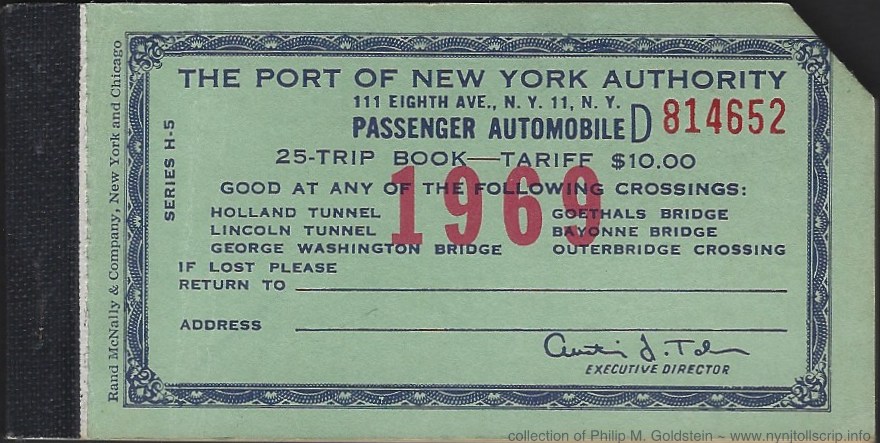 |
 |
 |
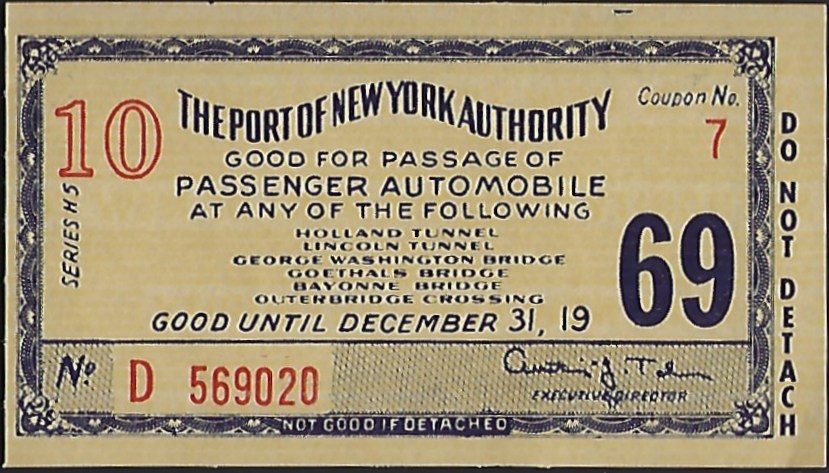 |
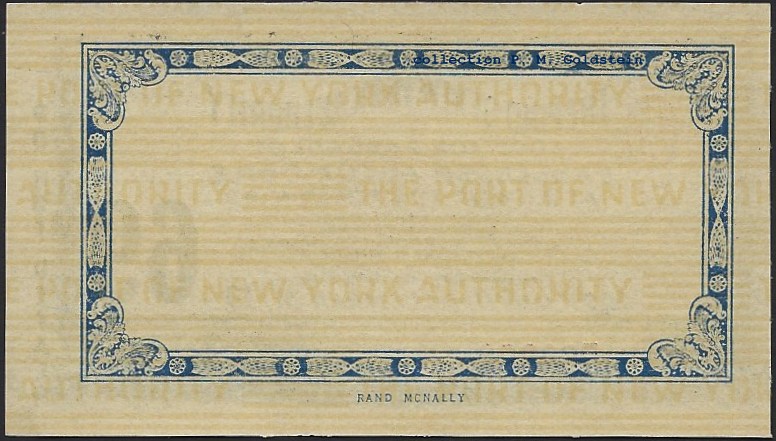 |
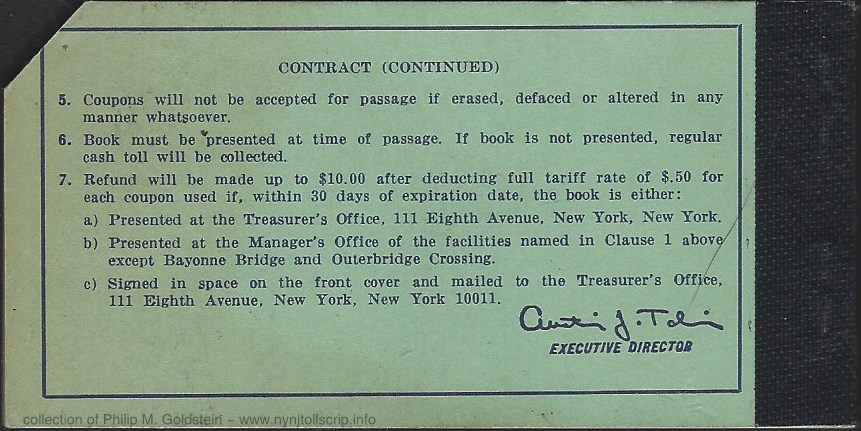 |
PoNYA Series H-5 - Passenger Automobile Commutation - 1969
25 trips / 2 Years / $10.00
collection
of Philip M. Goldstein |
printer:
printing
method:
security printing, paper / watermark:
design colors,
face:
design
notes, face:
security underprinting, signature field:
facsimile
signature:
serial number:
design colors, back:
design notes, back:
colors,
face (cover):
colors, back (cover):
notes, other:
size: |
Rand
McNally
lithography
alternating 5
lines with Port of New York Authority horizontal format
dark blue ink; serial, coupon number & book value in red
seen with and without clipped corner
crosshatch
Austin J.
Tobin, Executive Director
red D prefix & serial
number on notes
blue
blank twist & floret
single frame
unknown
(presumed to be similar to previous year)
unknown (presumed to be similar to previous
year)
25 trip / 2 year commutation /
$10
dark blue
prefix letter with dark blue serial number on flyleaf receipt
3 ¾" (width) - 2 ⅛"
(height) - 0.005" (thickness) |
.
.
|
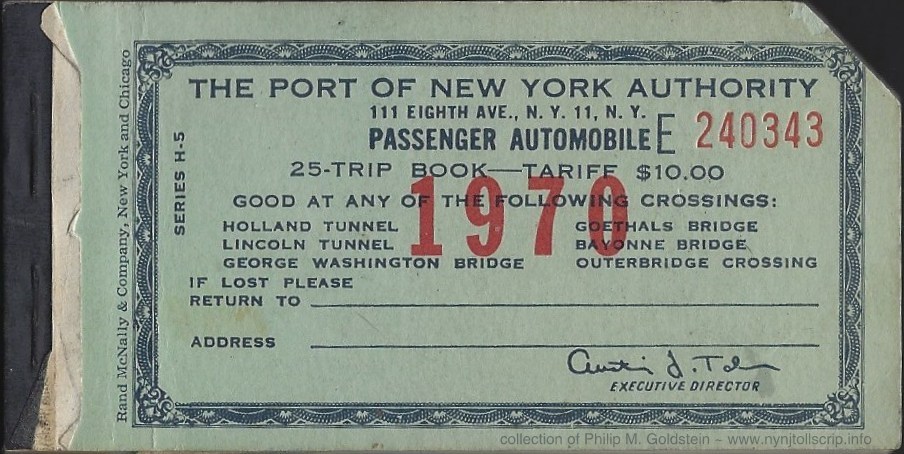 |
 |
 |
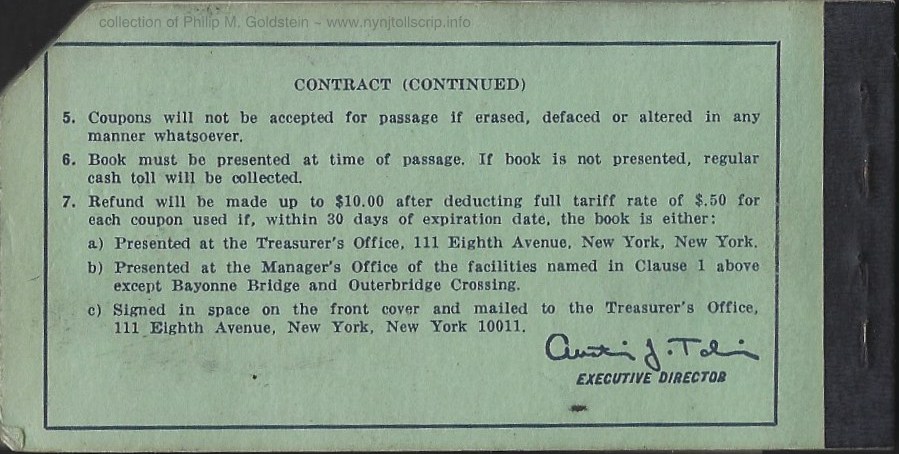 |
PoNYA Series H-5 - Passenger
Automobile Commutation - 1970
25 trips / 2 Year / $10.00
lithograph
Pinterest |
|
printer:
printing
method:
security printing, paper / watermark:
design colors,
face:
design
notes, face:
security underprinting, signature field:
facsimile
signature:
serial number:
design colors, back:
design notes, back:
colors,
face (cover):
colors, back (cover):
notes, other:
size:
|
Rand
McNally & Company, New York & Chicago
lithography
alternating 5
lines with Port of New York Authority horizontal format
dark blue ink; serial, coupon number & book value in red
clipped corner
crosshatch
Austin J.
Tobin, Executive Director
red E prefix & serial
number on notes
blue
blank twist & floret
single frame
dark blue on
blue with red 1971 & serial number, wave frame
dark blue on blue,
contract on inner & outer back cover
25 trip / 2 year commutation / $10
dark blue
prefix letter with dark blue serial number on flyleaf receipt
3 ¾" (width) - 2 1/8"
(height) - 0.005" (thickness)
|
.
.
|
|
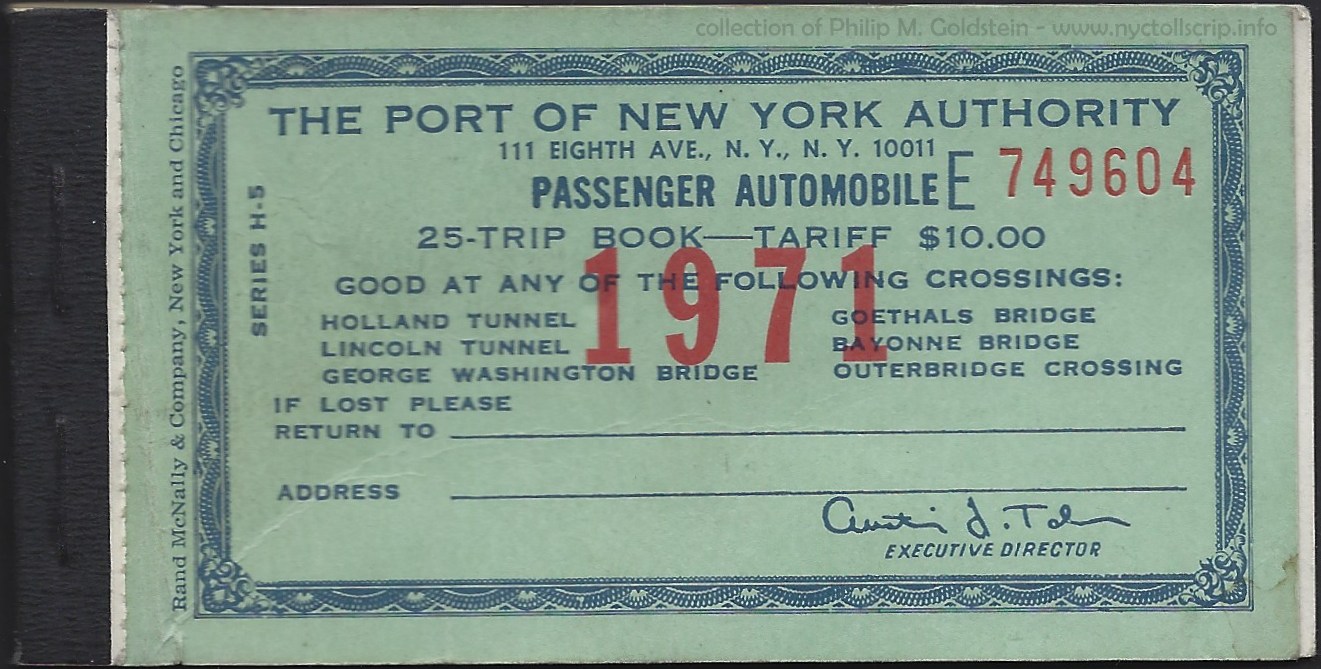 |
 |
 |
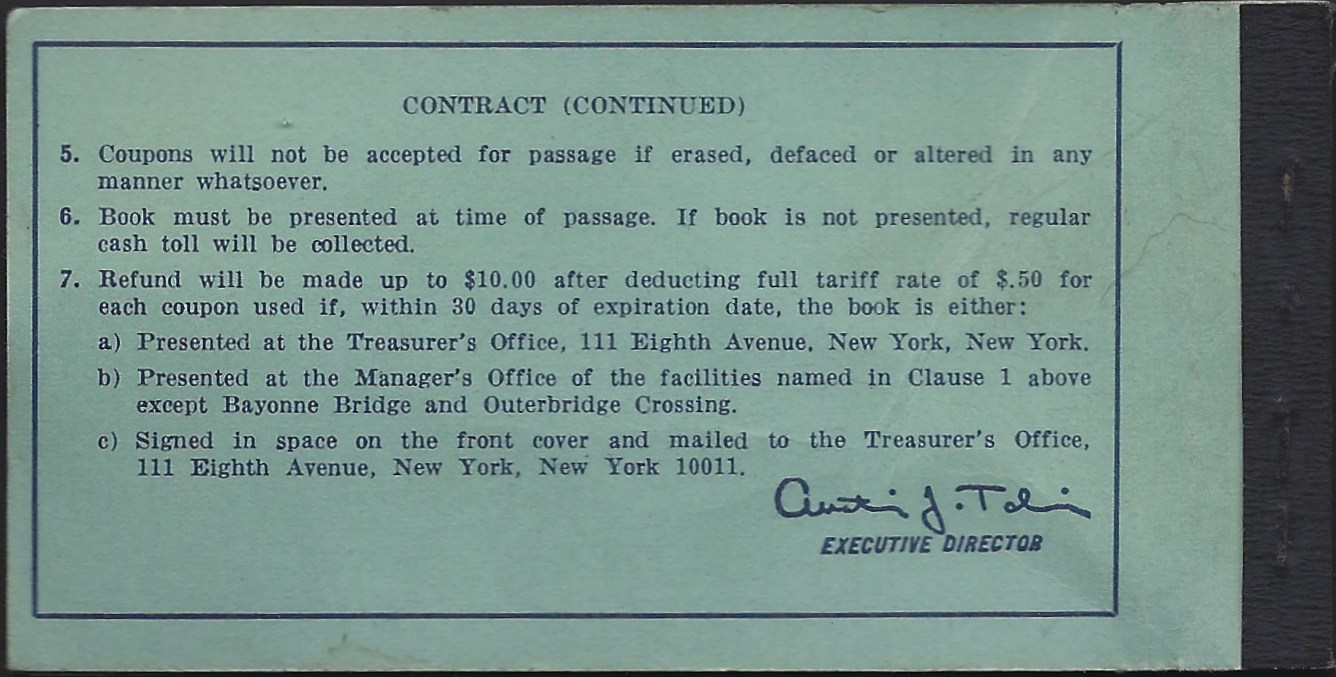 |
PoNYA Series H-5 - Passenger
Automobile Commutation - 1971
25 trips / 2 Year / $10.00
lithograph
collection
of Philip M. Goldstein |
printer:
printing
method:
security printing, paper / watermark:
design colors,
face:
design
notes, face:
security underprinting, signature field:
facsimile
signature:
serial number:
design colors, back:
design notes, back:
colors,
face (cover):
colors, back (cover):
notes, other:
size: |
Rand
McNally & Company, New York & Chicago
lithography
alternating 5
lines with Port of New York Authority horizontal format
dark blue ink; serial, coupon number & book value in red
crosshatch
Austin J.
Tobin, Executive Director
red E prefix & serial
number on notes
blue
blank twist & floret
single frame
dark blue on
blue with red 1971 & serial number, wave frame
dark blue on blue,
contract on inner & outer back cover
25 trip / 2 year commutation / $10
dark blue
prefix letter with dark blue serial number on flyleaf receipt
3 ¾" (width) - 2 1/8"
(height) - 0.005" (thickness) |
.
.
Series F - Motor Trucks /
Commercial Vehicles
As originally issued, Series F-4 is an issue for Motor Trucks, 2 axles, up
to and including 2 ton capacity, good for two years. It has punch boxes
for the twelve months and years 1934 and 1935 (much like a railroad
conductors ticket). This issue was printed by International Ticket
Company, Newark, NJ.
This issue is only good for Goethals, Outerbridge
and Bayonne Bridges. As the Verrazano was not yet to be built for 30
more years, this issue may very well be considered the first Staten
Island issue.
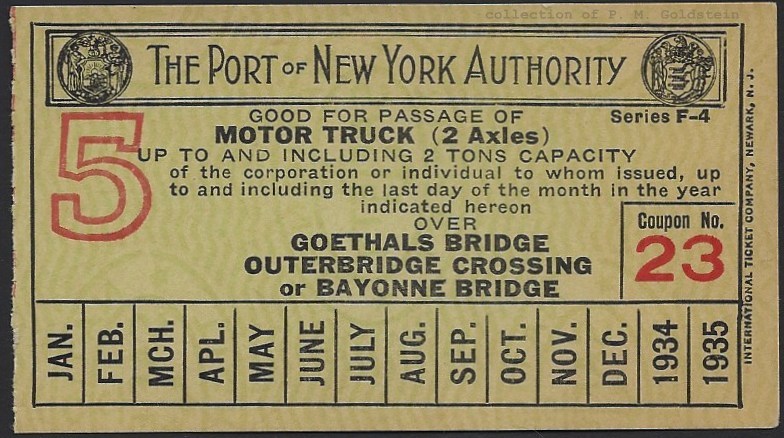 |
 |
PoNYA Series F-4 - Class 5 Motor Truck Commutation - 1934/1935
Valid for issued month and one month after
Motor Truck, 2 Axles, up to and including 2 tons - Staten Island
Crossings only
collection
of Philip M. Goldstein |
printer:
printing
method:
security printing, paper / watermark:
design colors,
face:
design
notes, face:
security underprinting, signature field:
facsimile
signature:
serial number:
design colors, back:
design notes, back:
notes, other:
size: |
International
Ticket Company, Newark, NJ
lithography
wavy lines with National Security Ticket logo, vertical format
black
coupon number & vehicle class in red
n/a
none
none
blank
n/a
twelve months,
two year punch tabs along bottom; Staten Island Crossings only
3 ¾" (width) - 2 3/32"
(height) - 0.005" (thickness) |
As mentioned and shown in the 1953 Toll Scrip / Ticket Brochure, we do know additional issues
were sold and circulated. Series F Truck Commutation Tickets appear to
be issued only for Staten Island Crossings, as there is no mention of
Truck Commutation Rates or tickets for Hudson River Crossings.
By that year of that publication, the following issues are known:
- Series
F-4 was for 2 Axle Motor Trucks, under 2 tons, without dual rear
wheels. Tickets were valid until the last day of the month after the
month punched. Sold in books of 25 tickets for $10.00.
- Series F-5 was for 2 Axle Motor Truck, 2 to 5 tons, with dual rear wheels. Sold in books of 25 for $15.00.
- Series F-6 was for 2 axle Motor Trucks, over 5 tons; sold in books of 25 for $18.75.
- Series
F-8 were for 3 axle Motor Trucks, and all Tractors with Semi-trailers,
regardless of weight; which were also sold in books of 25, and also for
$18.75.
Bus Series - (Series B)
Mentioned in the 1928 Annual Report is a Bus Commutation Issues for
Passenger Buses. The booklet contained 600 tickets valid for a month and sold for $360.
This configuration was revised by the 1953 Toll Scrip / Ticket
Brochure, and now contained 50 tickets per book for $30.00 for Class 3
(Bus) over Staten Island Island Bridges. Good until the last day
following the month punched.
There is no mention for Bus issues for the Hudson River Bridges.
Bus Operation -The Goethals Bridge
On
June 29, 1928, the Public Service Coordinated Transport commenced
operations between the Winfield Scott Hotel, Elizabeth, and St.
George, Staten Island, using the Goethals Bridge. The fare was 40c each
way. This service was discontinued on September 15, 1928, as it was
claimed by the operators to have been unprofitable. Subsequently,
the Elizabeth Chamber of Commerce took up the question of
re-establishing a regular bus
service over the bridge, between Elizabeth and Staten Island. The
proposition interested the Nevin Bus Company who agreed to make the
venture provided that some arrangement could be made whereby the rate
of $1.00 assessed as a toll over bridge could be adjusted.
Believing
that the establishment of a regular bus service would tend to build up
the local communities served, and further that its existence would
provide additional bridge revenues, the Port Authority agreed to sell
600-trip monthly bus tickets for $360. In establishing this rate, the
Port Authority adhered to its policy of granting no franchises or other
exclusive rights to anyone wishing to use the bridges. Any bus owner
may buy a 600-trip ticket, but no rebates are made if the minimum of
600 trips are not made within the month. As a result of this action,
regular bus service between Staten Island and New Jersey dated from
December 1, 1928, and has since continued. The fare being charged for
passengers is 25c one way, instead of 40c as formerly.

Combination Tickets - Series C
Series C tickets were issued for combined trips over two of the
Staten Island Bridges or over one Hudson River Crossing and one Staten
Island Bridge.
They were valid until 8 am following the day sold.
Series C-401 was issued for any combination of Staten Island
Bridges for a passenger automobile only. Issued as individual tickets.
Series C-40 was issued for any combination of Staten Island
Bridges for Class 2 through 9 vehicles only (trucks of various weights,
axles, buses), and sold in two part tickets.
Series
C-41 was issued for a combination of one Hudson River Crossing with one
Staten Island Crossing. Good for all classes of vehicles (1 through 9).
Also a two part ticket.
Employees
Pass - Series P
Series P is an Employees Personal Pass. Non-transferable,
and must show proper photo identification. Issued to present and retired employees, as well as those on military leave.
 |
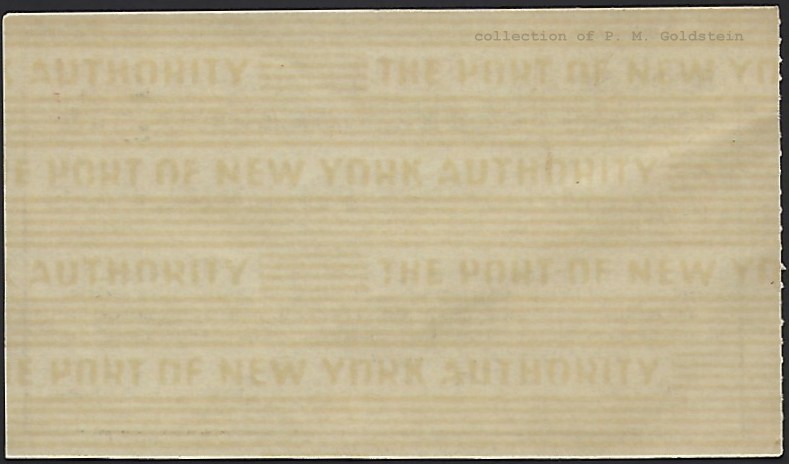 |
PoNYA Employee's Personal Pass (1964)
lithograph
collection
of Philip M. Goldstein |
printer:
printing
method:
security printing, paper / watermark:
design colors,
face:
design
notes, face:
security underprinting, signature field:
facsimile
signature:
serial number:
design colors, back:
design notes, back:
notes, other:
size: |
Rand
McNally
lithography
alternating 5
lines with Port of New York Authority horizontal format
black
coupon number & class? in red
none
Austin J.
Tobin, Executive Director
black "BOOK No. P", red
serial number
n/a
n/a
Employees Personal Pass
PA-378 / 10-64
3 ¾" (width) - 2 5/32"
(height) - 0.005" (thickness) |
Also known to exist as seen in the 1953 Toll Scrip / Ticket
Brochure, Book C tickets were issued to PoNYA employees for commuting
to and from work in their personal automobile.
There were also:
- Official Business Pass, good for one trip only by non-PoNYA vehicles;
- Annual
Passes for PoNYA commissioners, executive staff members and officials
of the State of New York or New Jersey and their municipalities;
- Port
Authority Vehicle Pass, for PoNYA vehicles in the course of their
duties. Issued to license plate on vehicle and recorded inside front
cover of ticket booklet;
- Emergency
Passage Permits (good for one crossing via Holland or Lincoln Tunnels
or the George Washington Bridge) in case of an emergency condition
(fire, road block) etc. Issued to motorists who have already paid their
toll but must reroute. Issued by a PoNYA Sergeant who punches the
class of vehicle and issues ticket to motorist. (Similar in concept to
the "Block Tickets" as used on the New York City Subway)
PoNYA Scrip &
Commutations Books - the "new design"
This new design veered away from the "stock certificate"
look with ornate border of the original design; and now carried an
overexposed (for lack of a better term) styled silhouette image of the
head of the Statue of Liberty on the left side. The main body of the
note is printed in lime green with light blue security underprinting
"PORT ON NEW YORK AUTHORITY". Large 11/16" numerals in blue are
also carried on the face for easier denominational identification. The
font is now an easier to read sans-serif Helvetica style.
In keeping
with its predecessors, these issues retained the TS code to denote
denominations: TS2 (.50), TS4 ($1.00) and a new TS7 for $3.00. It is unknown at
this time, if a TS6 issue in either 2.00 or 2.25 denominations, and if
the printing of TS5 ($1.50) was included in the new design, and if
higher denominations than $3.00 were printed. It is presumed so.
Also, noted on the new design is a 3/4" wide
unprinted white area one side of the scrip, which is now reserved
for the Series number: 04 = TS4, 07 = TS7, etc;
and the serial number.
Optical Character
Recognition
On this new design of scrip, both the series and serial
number are now printed in Optical Character Recognition - A font
(shortened to OCR-A) and in black ink.
|
"Many of the typefaces used today are derived from medieval
calligraphy, only slightly modified by the limitations of early
printing technologies (wood blocks and movable type). To imitate fine
penmanship, vertical strokes are thick compared to horizontal strokes,
and NW-SE diagonals are thicker than NE-SW diagonals.
Therefore curved strokes may vary in width according to their
local orientation. In contrast, typefaces specifically designed for
accurate OCR, such as OCR-A and OCR-B fonts, have uniform stroke widths
and exaggerated distinctions between similar symbols such as Ο and 0 or
1 and l:

OCR-A font
.
The next step in the evolution of the OCR font was to make it
more visually pleasing. With this accomplishment, the font assumed
an even easier to read
character similar to Helvetica or Arial Condensed.

OCR-B font
"OCR-A was not the first font to tackle these machine-scanning
issues, but it was a major step forward in that it was a complete
alphabet that was readable by both machines and humans. Previously, the
most well-known use for such technology involved something you’re
probably familiar with, if you have cashed a check sometime in the last 60
years: Magnetic Ink Character Recognition, or MICR:"

MICR
E13-B font - used in North America
OCR-A, which you might have seen on a piece of junk mail or two
over the years, expanded on the basic idea of MICR by creating a
character set that could be detected by either a computer or a set of
eyes. The problem was, however, that it was a better fit for computers
and had a strongly stylized design, which some found not so appealing."
Selected
excerpts above credit to: "Typography - History of Optical
Character Recognition"; Tedium
by Ernie Smith,
March 22, 2017:
|
While
Optical Character Recognition programming is common today on modern
computers and image scanner programs, its history can be traced back to
being first developed in 1912 by Emanuel Goldberg, as an aid for
reading for the visually impaired.
By 1966, OCR programs evolved to the degree to be adopted
for widespread use by the US Post Office for letter sorting. The actual
font (OCR-A) was developed from MICR font by none other than Adrian
Frutiger, who is a world renowned designer of typefaces.
As for the
OCR-A font itself, (which can be read by that article above), the font
was a further developmental step from, and similar to the MICR
E13B font that routing and account numbers are printed in, which
can be seen on the bottom of your checks from your local bank.
As for
the technical aspects of MICR, each character is magnetically readable
due to the composition of the ink and the unique shape or "magnetic
fingerprint" each numeral has and not by the optical appearance,
although by incorporating the magnetic signal into an optically
recognizable Arabic numeral; aids in readability.
The trial of MICR E13B font was shown to the American
Bankers Association (ABA) in July 1956, which adopted it in 1958 as the
MICR standard for negotiable documents in the United States. The ABA
adopted MICR as its standard because machines could read MICR
accurately, and MICR could be printed using existing technology. In
addition, MICR remained machine readable, even when overstamped,
marked, and minor mutilation. The first checks using MICR were printed
by the end of 1959. Although compliance with MICR standards was
voluntary in the United States, it had been almost universally adopted
in the United States by 1963.
And as we now see; this new PoNYA issue of scrip was not
released until 1969. It should be noted:
- MICR readers don’t "see" the characters optically; only
the amount of magnetic signal present in a vertical line at any given point; and
- the odd print styles of MICR fonts are designed to give
each character a distinctive signal shape.
whereas:
- OCR-A readers are strictly optical.
With
the evolution of computer programming and optics, the "mechanical"
appearance of the OCR-A font has evolved to being usable with most
sans-serif fonts.
Another interesting feature accompanying the OCR-A font
and seen on this new design, is the 1/2" 90 degree right angle device.
Its actual purpose currently unconfirmed, but I believe it to be for
the optical reader and associated with the serial number printing area;
as it is only seen on this design issue of scrip utilizing the
OCR-A characters. This "angle device" appears regardless of whether the
serial number is printed on the left or right hand side of the notes;
nor is this "angle device" seen on any previous or subsequent issues
with other types of serial numbering. It is therefore possible it is a
"check digit" or "check character" for the OCR readers.
Returning to new design of the scrip, a change is seen on
the TS7-1970 (3.00 denomination), with the unprinted area is on the
right, yet with same OCR-A font for series and serial number.
On the back of the note, in bronze ink; a simple large
11/16" block style 1.00 graces the note; as well as the Port of New
York Authority seal repeating as a security underprinting.
A variety encountered, is TS4 -
1969 scrip perforated with the letters "US" (I only have the "US"
perforated variety, I need an unperforated regular issue). It is
believed, but as yet unconfirmed that these were issues to US
governmental agencies and / or the military. This US perforation is
seen in a earlier issue of scrip at well: Series TS4 - 1935:
PoNYA "new design" Toll Scrip - 1969-1972
|
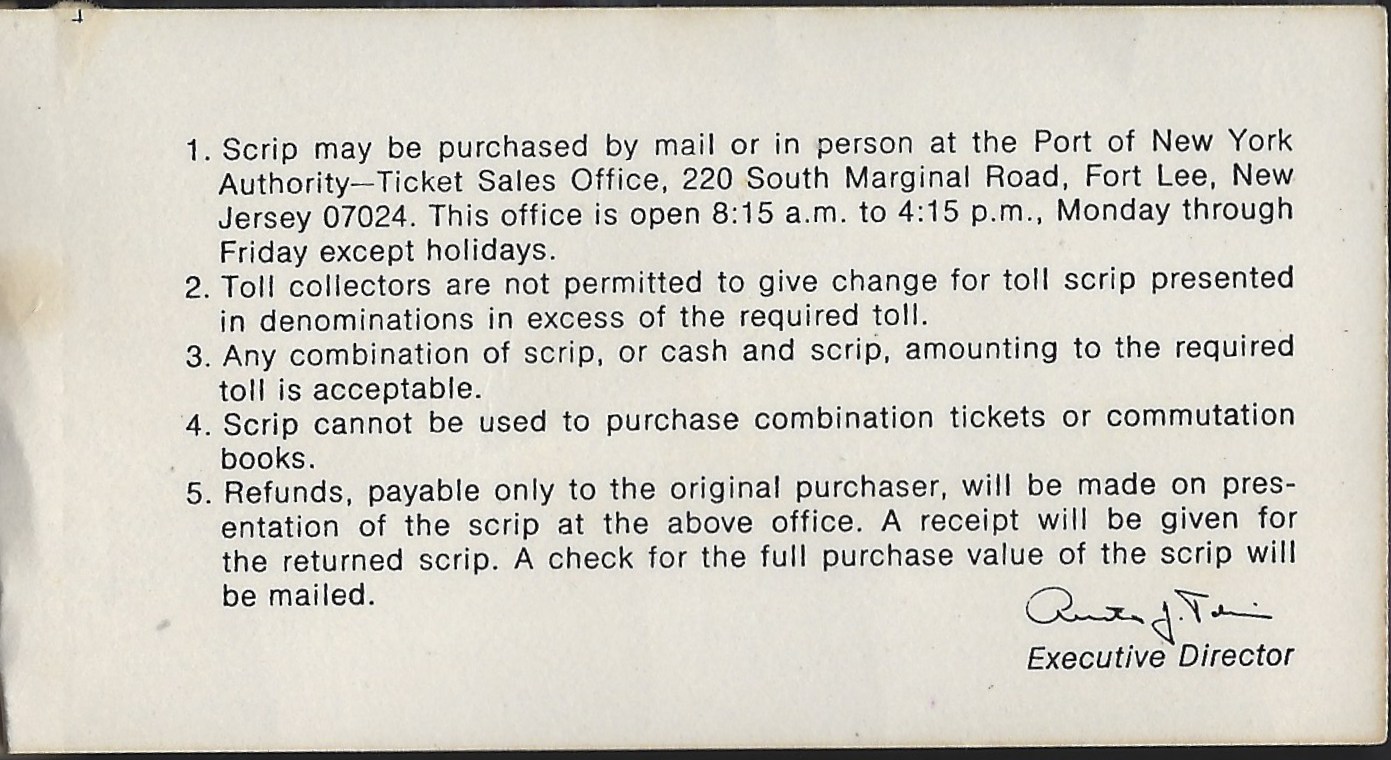 |
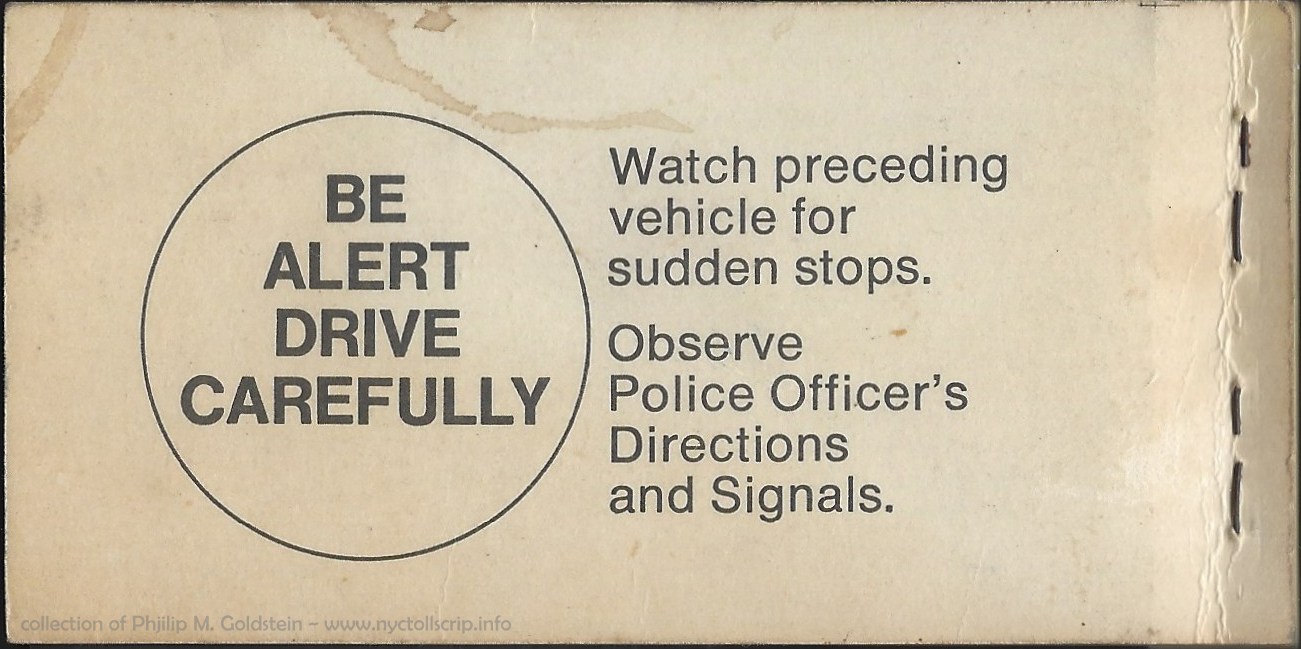 |
 |
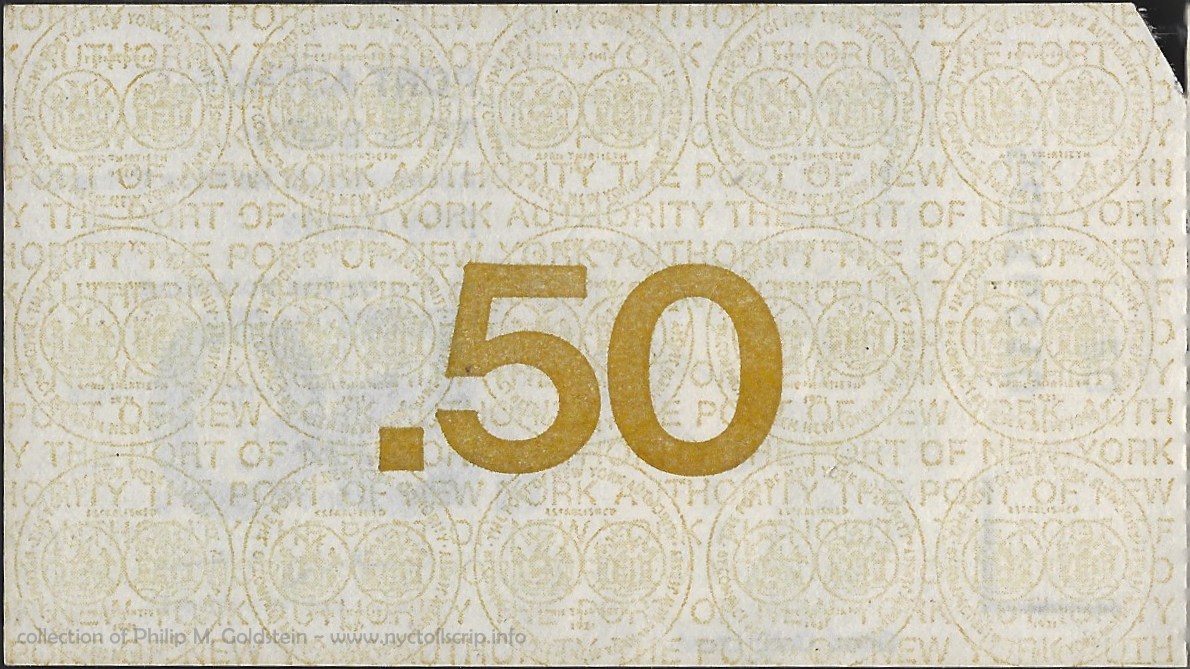 |
PoNYA (new design) Series TS2 - 1969 - .50
|
printer:
printing
method:
security printing, paper / watermark:
design colors,
face:
design
notes, face:
security underprinting, signature field:
facsimile
signature:
serial number:
design colors, back:
design notes, back:
notes, other:
size: |
unknown
lithography
repeating text
& seal "PORT OF NEW YORK AUTHORITY"
lime green, white head of Statue of Liberty, blue numerals
unprinted
area for serial number on left
n/a
Austin J. Tobin,
Executive Director
OCR registration angle, black
series number and serial number in OCR-A font in unprinted margin on left,
bronze
large sans-serif
denomination numerals in bronze
3
¾" (width) - 2 5/32" (height) -
0.005" (thickness) |
|
|
 |
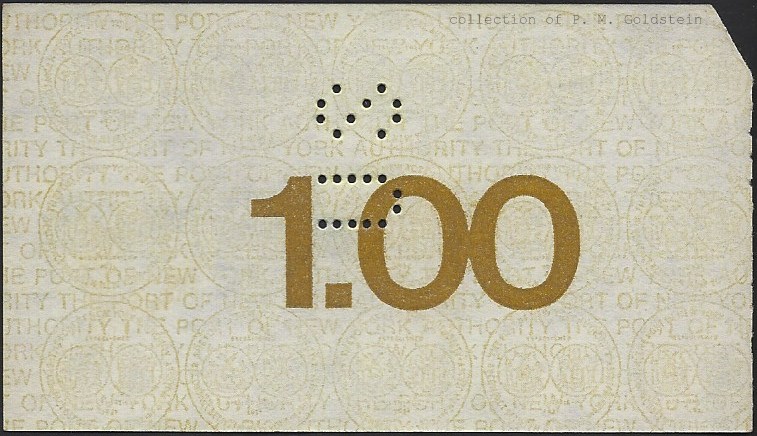 |
PoNYA (new design) Series TS4 - 1969 -
$1.00
perforated "U S " (presumably government issue)
collection of
Philip M. Goldstein |
printer:
printing
method:
security printing, paper / watermark:
design colors,
face:
design
notes, face:
security underprinting, signature field:
facsimile
signature:
serial number:
design colors, back:
design notes, back:
notes, other:
size: |
unknown
lithography
repeating text
& seal "PORT OF NEW YORK AUTHORITY"
lime green, white head of Statue of Liberty, blue numerals
unprinted
area for serial number on left
n/a
Austin J. Tobin,
Executive Director
OCR registration angle, black
series number and serial number in OCR-A font in unprinted margin on left,
bronze
large sans-serif
denomination numerals in bronze
perforated U S
3
¾" (width) - 2 5/32" (height) -
0.005" (thickness) |
.
. |
|
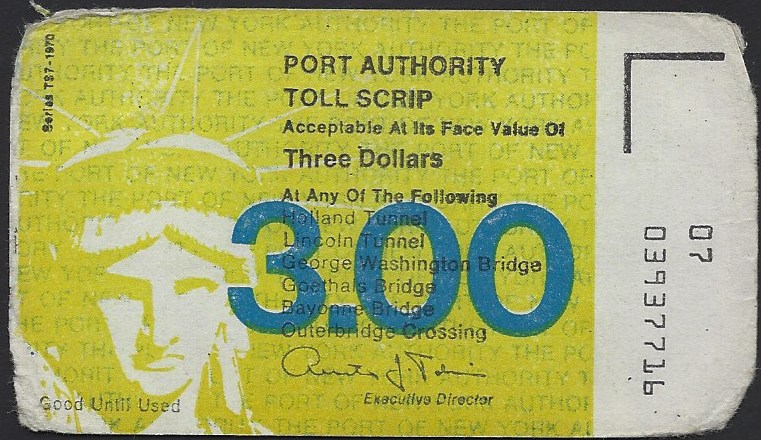 |
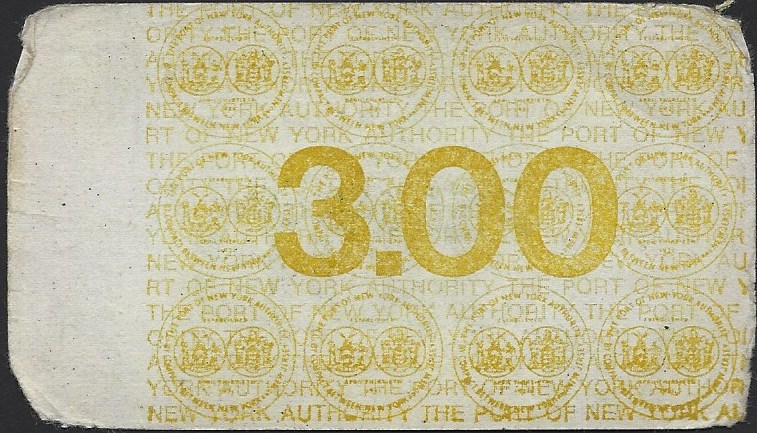 |
|
PoNYA (new design) Series TS7 - 1970
- $3.00
collection of
Philip M. Goldstein
|
printer:
printing
method:
security printing, paper / watermark:
design colors, face:
design
notes, face:
security underprinting, signature field:
facsimile
signature:
serial number:
design colors, back:
design notes, back:
notes, other:
size: |
unknown
lithography
repeating text
"PORT OF NEW YORK
AUTHORITY" on face
repeating text & seal "PORT
OF NEW YORK AUTHORITY"
on back
lime green, white head of Statue of Liberty, blue numerals
unprinted
area for serial number on right
n/a
Austin J. Tobin,
Executive Director
OCR registration angle, black
series number and serial number in OCR-A font in unprinted margin on right
bronze
large sans-serif
denomination numerals in bronze
3
¾" (width) - 2 5/32" (height) -
0.005" (thickness) |
.
. |
|
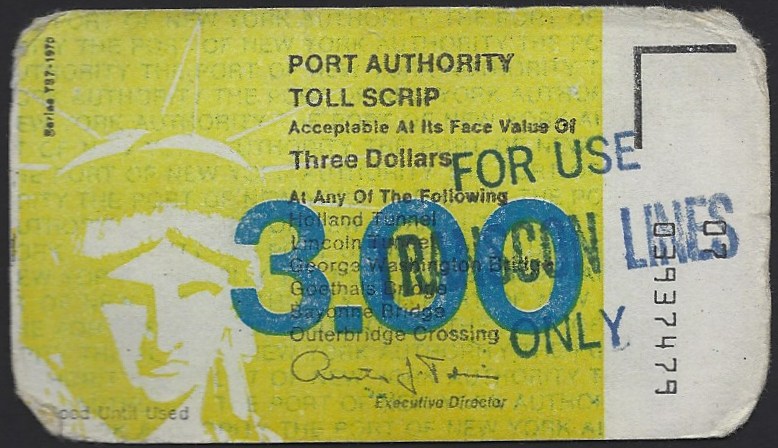 |
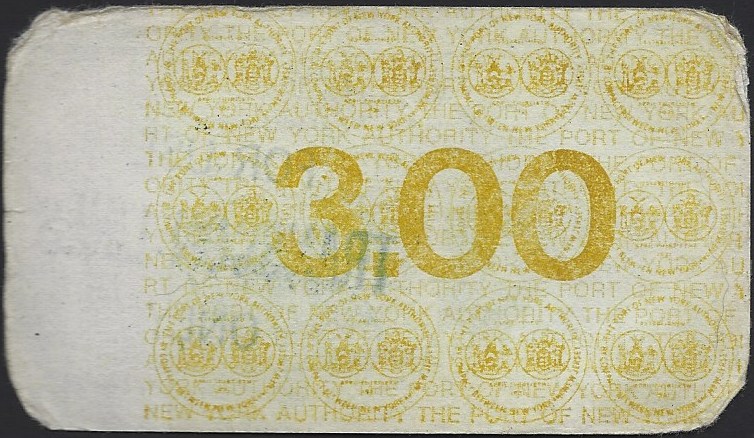 |
PoNYA (new design) Series TS7 - 1970 -
$3.00
overstamp "FOR USE / TRANSCON LINES / ONLY"
collection of
Philip M. Goldstein |
printer:
printing
method:
security printing, paper / watermark:
design colors, face:
design
notes, face:
security underprinting, signature field:
facsimile
signature:
serial number:
design colors, back:
design notes, back:
notes, other:
size: |
unknown
lithography
repeating text
"PORT OF NEW YORK
AUTHORITY" on face
repeating text & seal "PORT
OF NEW YORK AUTHORITY"
on back
lime green, white head of Statue of Liberty, blue numerals
unprinted
area for serial number on right
n/a
Austin J. Tobin,
Executive Director
OCR registration angle, black
series number and serial number in OCR-A font in unprinted margin on right
bronze
large sans-serif
denomination numerals in bronze
blue overstamp for FOR
USE TRANSCON LINES ONLY"
3
¾" (width) - 2 5/32"
(height) - 0.005" (thickness) |
Transcon
was originally founded 1946 in California as a local shipper. With
the opening of the Eisenhower Interstate System across the United
States, Transcon grew rapidly into the long distance / over the
road trucking field through acquisitions starting in 1950. /The company
enjoyed immense success 1980 following ICC deregulation. By 1990
Transcon was losing about $5 million a month, and sold to Growth
Financial Corporation in April 1990 for a token $12. A detailed history
of Transcon Lines may be read here: Transcon
History - US1 Industries.
Is is presumed Transcon purchased toll scrip in bulk, (possibly, but
not likely at a small discount); and either they or the Port New York
Authority overstamped their script for their use only when redeeming at
the Port Authority crossings to prevent unauthorized use. |
| PoNYA "new design"
Commutation Books - H-4 / 30 Day / 20 ticket - 1969-1972 |
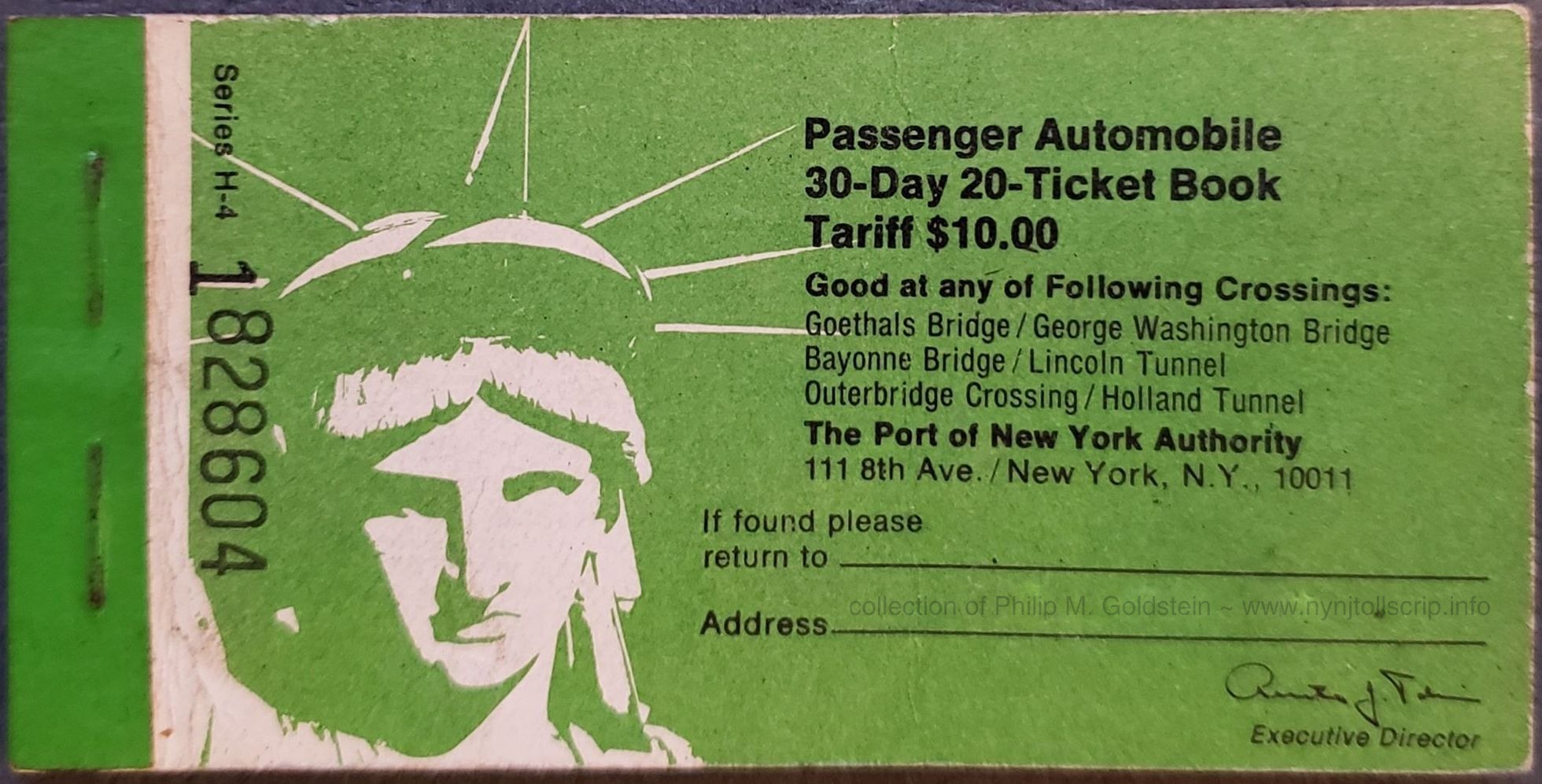 |
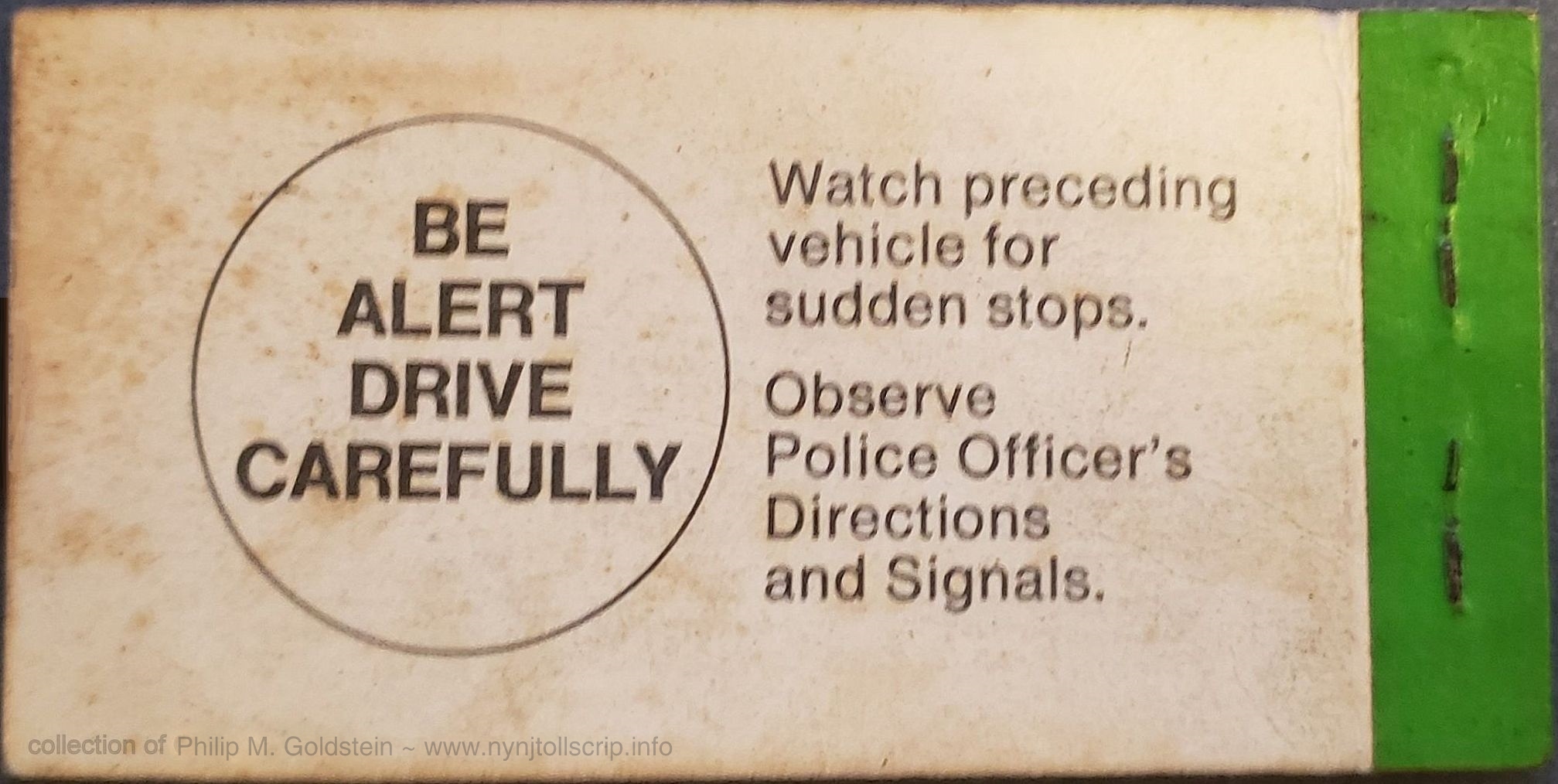 |
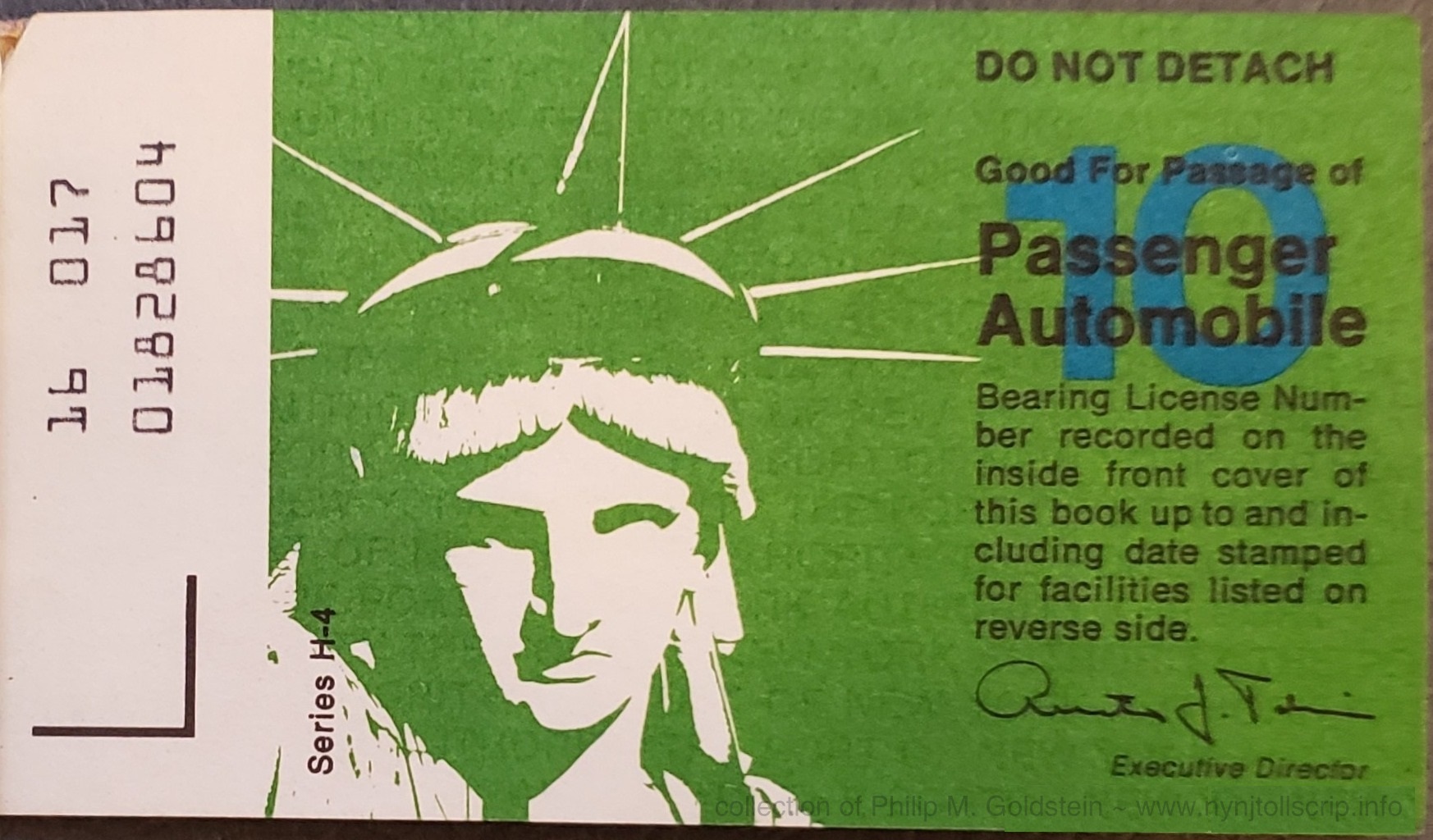 |
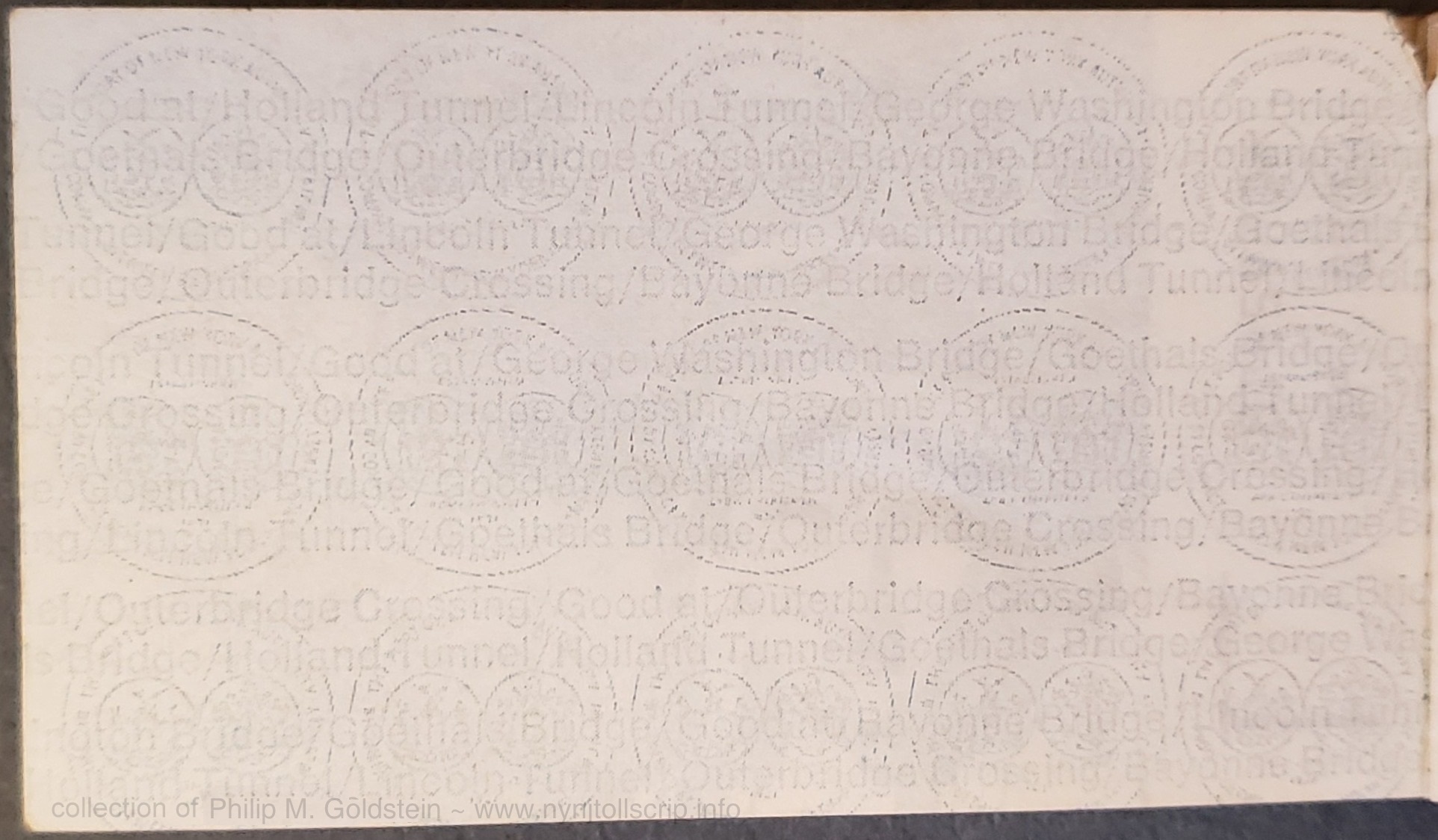 |
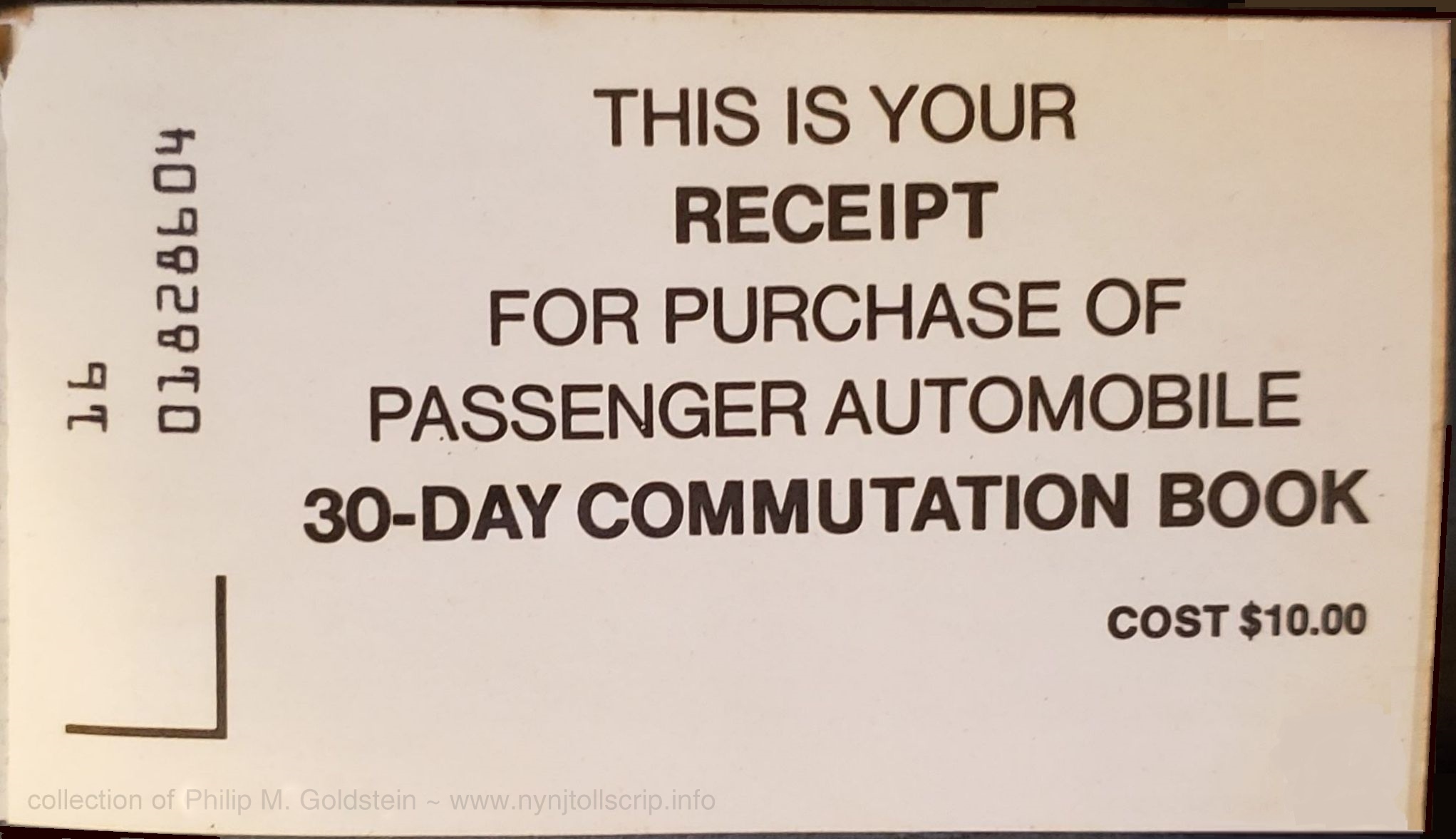 |
 |
PoNYA (new design) Series H-4 - February 1972
30 day / 20 ticket / $10.00
lithograph
collection
of Philip M. Goldstein |
facsimile signature:
printer:
colors, face:
colors, back:
serial number:
.
notes: .
security
underprinting, face:
security
underprinting, back:
.
security underprinting:
size: |
Austin
J. Tobin
Rand McNally
green with white head of Statue of Liberty
light blue underprinting
coupon: black OCR-A font
cover: prefix 1, large gothic serial number in unprinted margin on left
repeating "PORT OF NEW YORK AUTHORITY" (very
faint)
repeating PoNYA seal, repeating: Good at / George Washington Bridge / Goethals
Bridge / Outerbridge Crossing / Bayonne Bridge / Holland Tunnel /
Lincoln Tunnel
PoNYA seal on back of ticket
3 ¾" (width) - 2 ⅛" (height) - 0.005"
(thickness) |
| . |
|
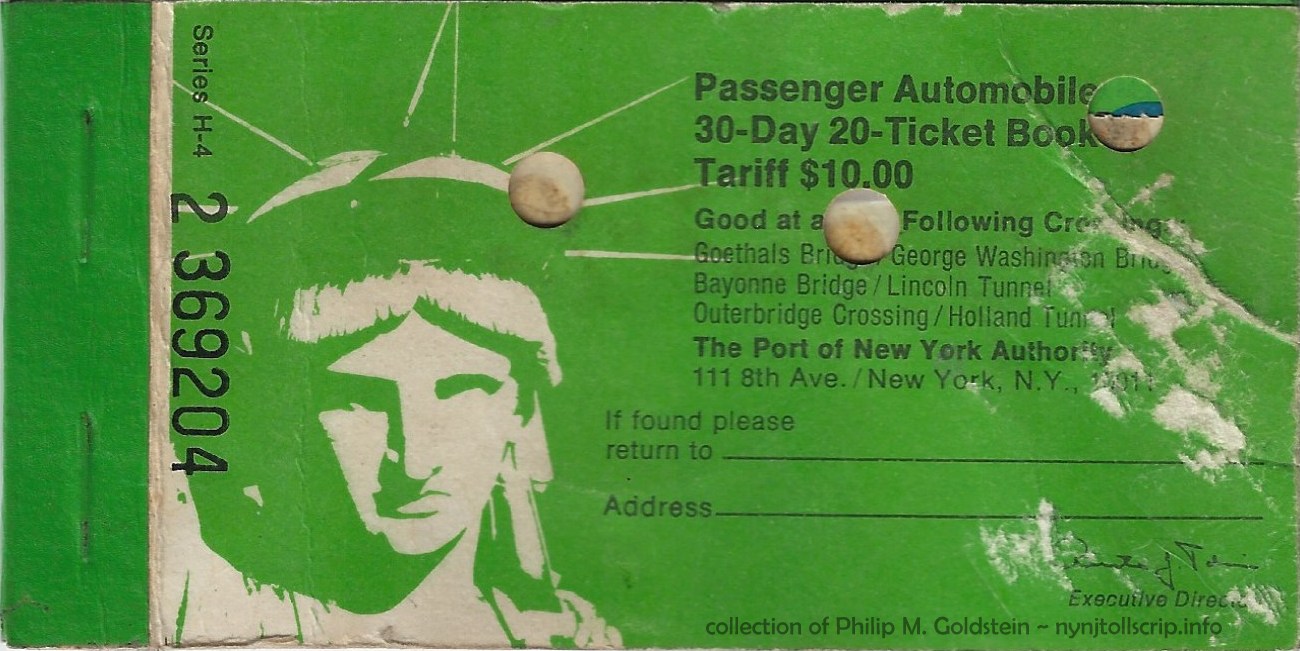 |
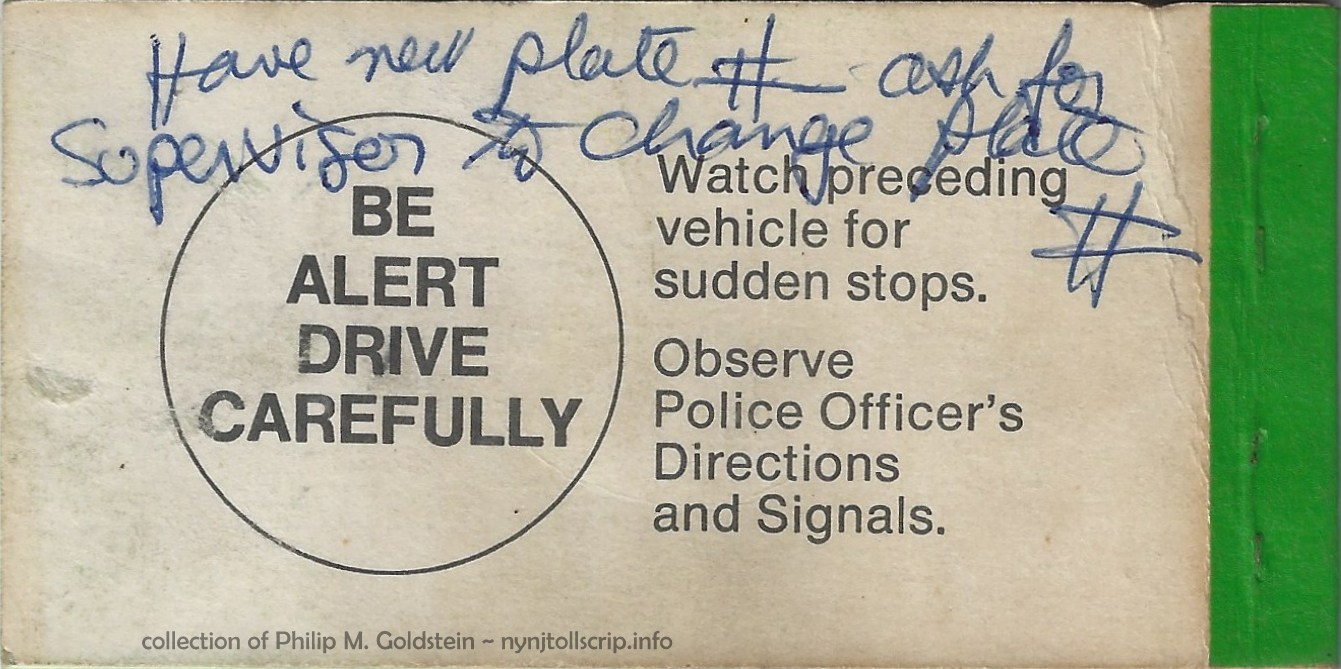 |
 |
PoNYA (new design) Series H-4 - September 1972
30 day / 20 ticket / $10.00
lithograph - with license plate change affix & punch cancellation
collection
of Philip M. Goldstein |
facsimile signature:
printer:
colors, face:
colors, back:
serial number:
.
notes: .
security
underprinting, face:
security
underprinting, back:
.
security underprinting:
size: |
Austin
J. Tobin
Rand McNally
green with white head of Statue of Liberty
light blue underprinting
coupon: black OCR-A font
cover: prefix 2, large gothic serial number in unprinted margin on left
with license plate change affix & punch cancellation
repeating "PORT OF NEW YORK AUTHORITY" (very
faint)
repeating PoNYA seal, repeating: Good at / George Washington Bridge / Goethals
Bridge / Outerbridge Crossing / Bayonne Bridge / Holland Tunnel /
Lincoln Tunnel
PoNYA seal on back of ticket
3 ¾" (width) - 2 ⅛" (height) - 0.005"
(thickness) |
| PoNYA "new design" -
Commutation Books - H-5 / 1 Year / 25 ticket |
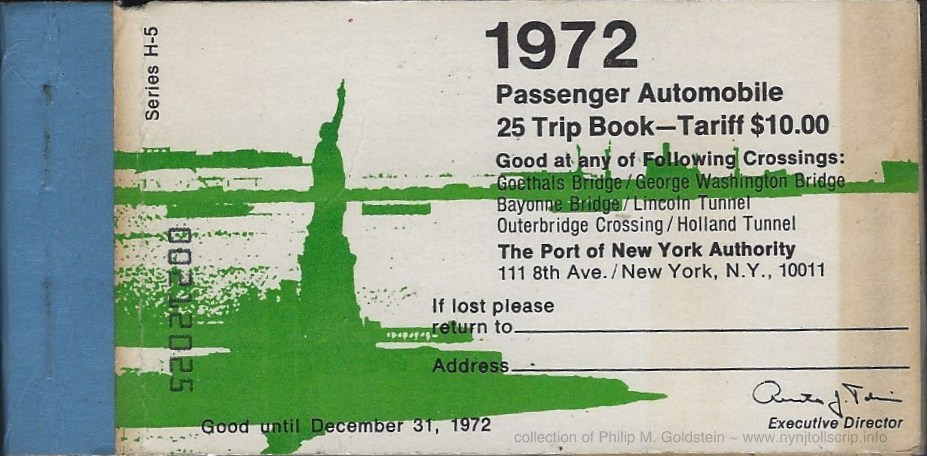 |
 |
 |
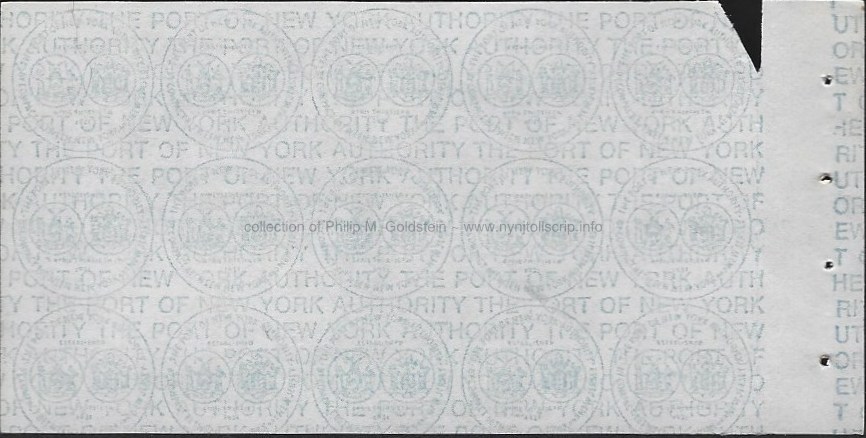 |
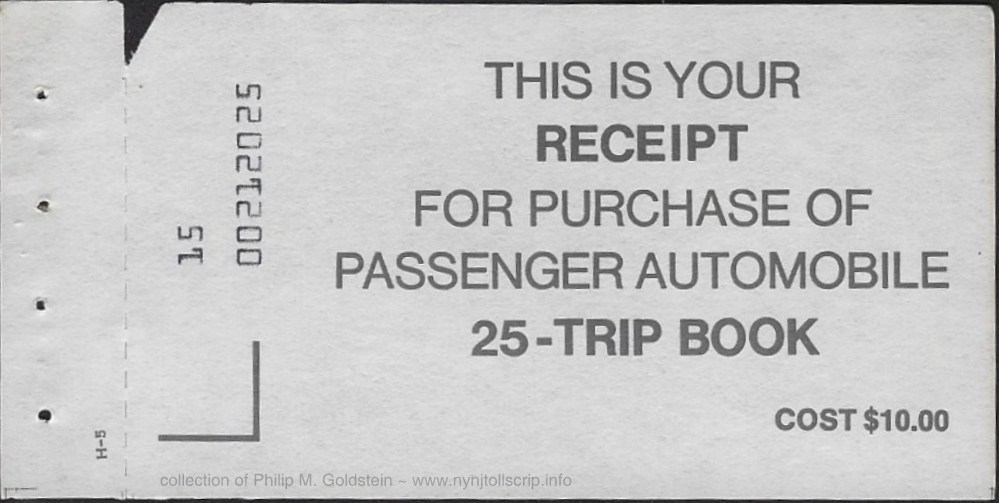 |
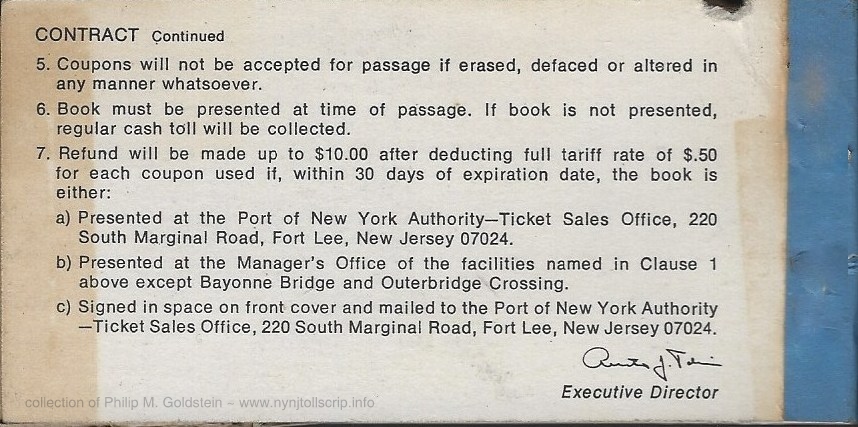 |
PoNYA (new design) Series H-5 - Passenger
Automobile Commutation - 1972
25 trips / 1 Year / $10.00
lithograph
collection
of Philip M. Goldstein |
printer:
printing
method:
security printing, paper / watermark:
design colors,
face:
security underprinting, signature field:
facsimile
signature:
serial number:
design colors, back:
design notes, back:
colors,
face (cover):
colors, back (cover):
notes, other:
size: |
unknown
lithography
repeating text
& seal "PORT OF NEW YORK AUTHORITY"
green, blue, black
same
Austin J.
Tobin, Executive Director
OCR registration angle, black
series number and serial number in OCR-A font in unprinted margin on left,
light blue
none
white, green, black
white, black
book now expires in 1 year, as opposed to 2 years for previous issues.
25 trip / 1 year commutation / $10
3
¾" (width) - 2 5/32" (height) -
0.005" (thickness)
|
| PoNYA "new design" - Employee's Personal Pass |
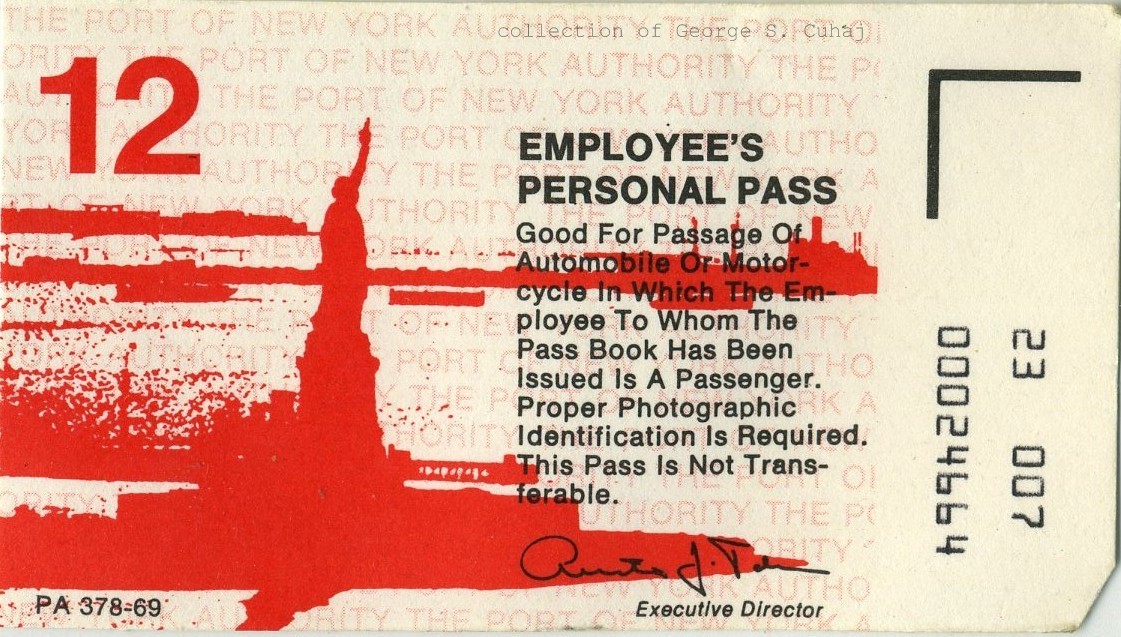 |
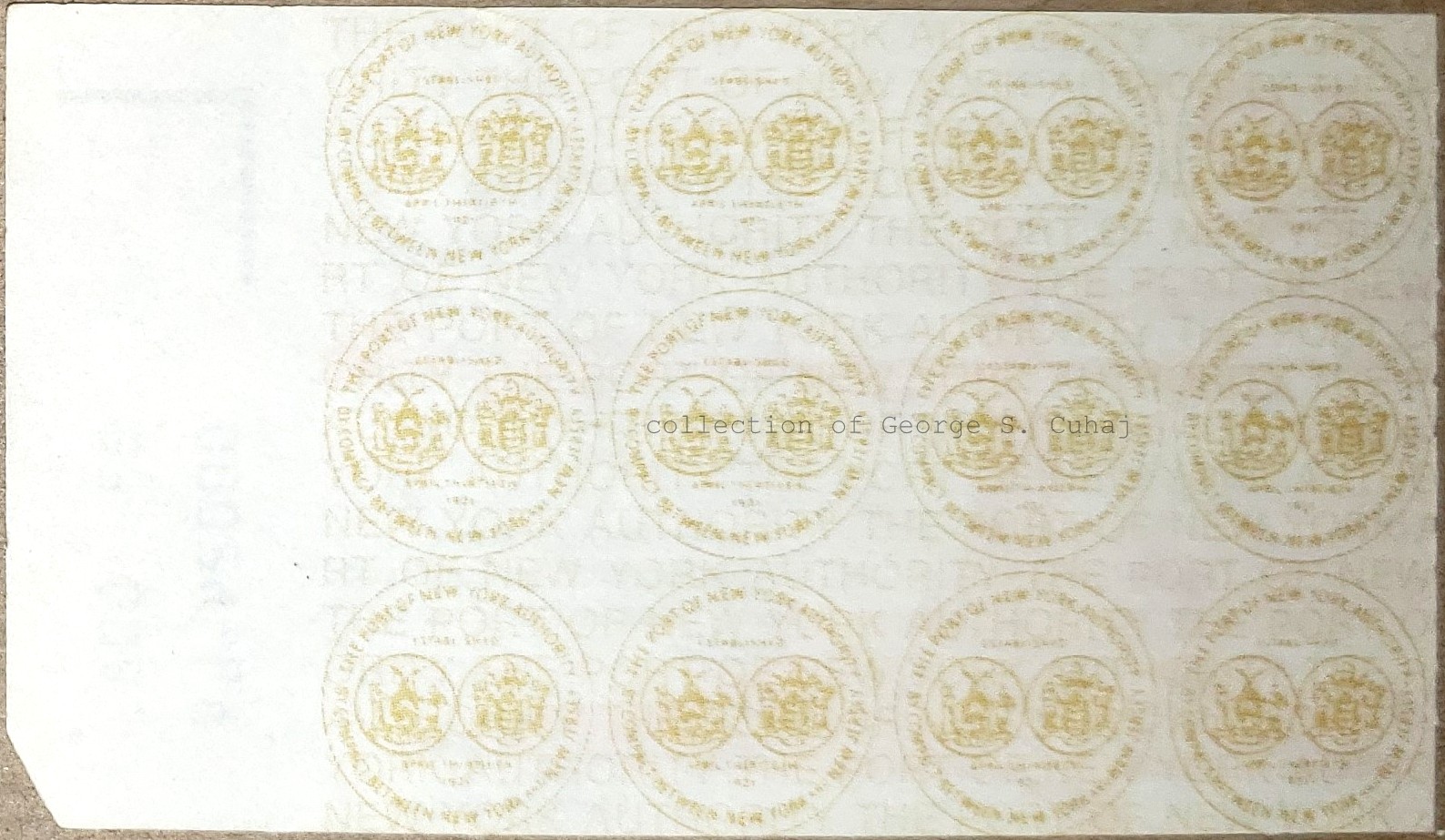 |
PoNYA (new design) Employees Personal
Pass - ca. 1969 to 1972
Note this design carries the same design
(silhouette view of Liberty Island and NY harbor)
as the PANYNJ
First Issue Series H-5 Commutation Book Cover - 1977
OCR-A
font serial number
PA 378-69
collection of
Philip M. Goldstein |
facsimile signature:
printer:
colors, face:
colors, back:
serial number:
notes:
security
underprinting, face:
security
underprinting, back:
size:
|
Austin
J. Tobin, Executive Director
unknown
red silhouette
view of Liberty Island and NY harbor,
numerals red, text black
bronze
serial number in black OCR-A font, in unprinted margin on right,
sans-serif denomination numbers on face and back.
repeating "PORT OF NEW YORK AUTHORITY"
repeating emblem / seal of Port of New York Authority and
"PORT
OF NEW YORK AUTHORITY"
3 ¾" (width) - 2 ⅛" (height) - 0.005" (thickness) |
Port of New York Authority Receipts
|
| PoNYA Form 163 / 35950 Receipt |
|
PoNYA PA 163 / 9-54 Receipt |
|
|
|
|
PoNYA Toll Receipt - October 7, 1936 - $1.25
George Washington Bridge
Form 163 35905
2 1/8" x 4"
collection of
Philip M. Goldstein |
|
PoNYA Toll Receipt - October 19, 1955 - $.50
HT-7 (Holland Tunnel)
PA 163 9-54
2 1/2" x 4 3/16"
collection of
Philip M. Goldstein |
|
|
|
|
|
| PoNYA PA 163 / 5-57 Receipt A-45631 |
|
PoNYA PA 163 / 5-57 Receipt A-45631 |
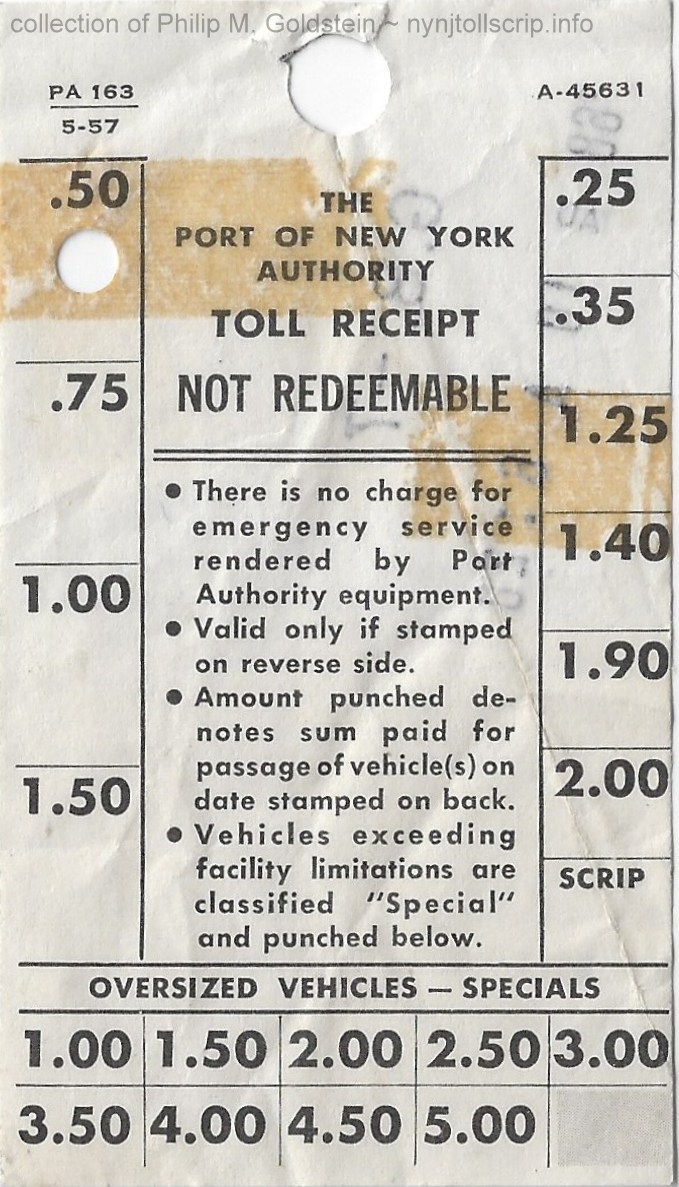 |
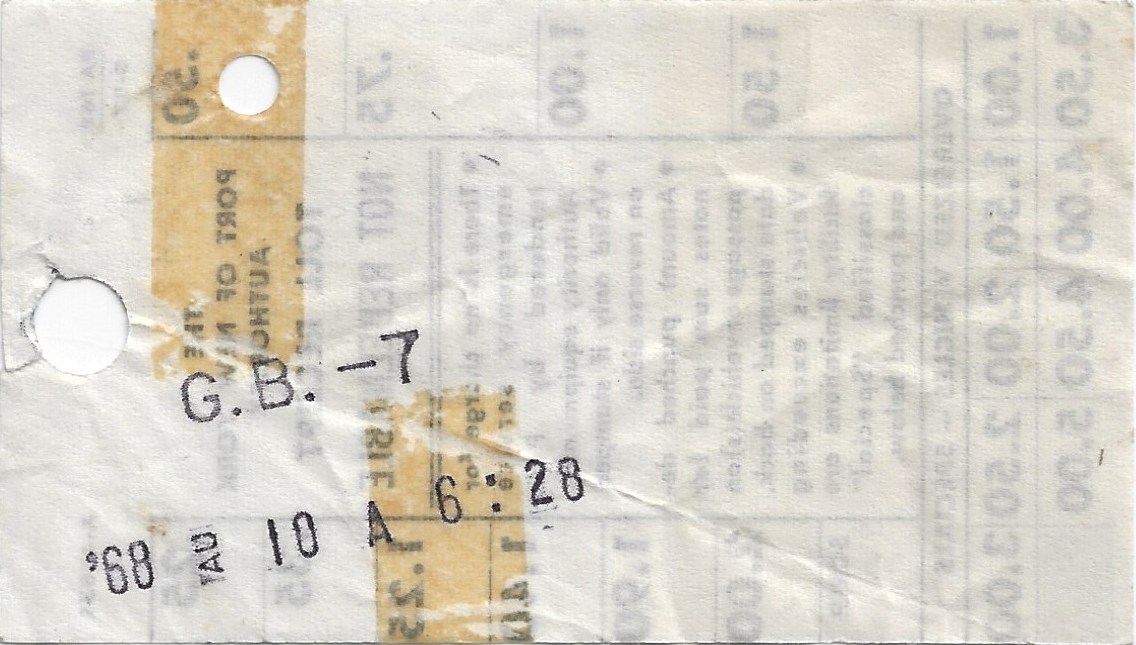 |
|
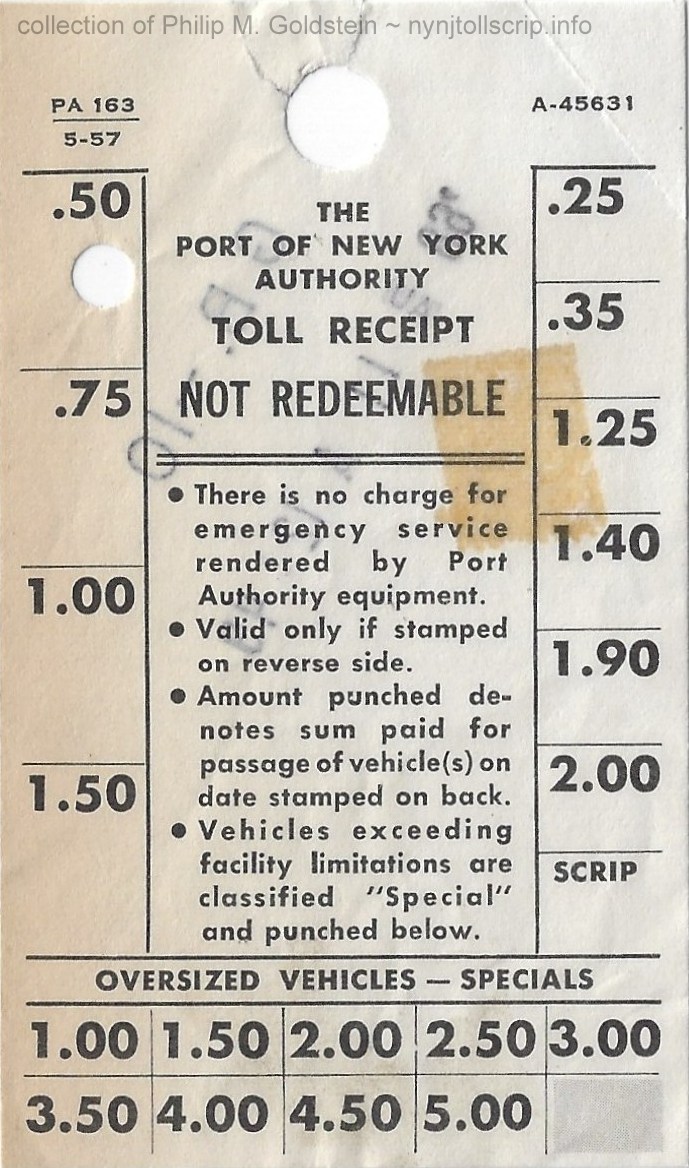 |
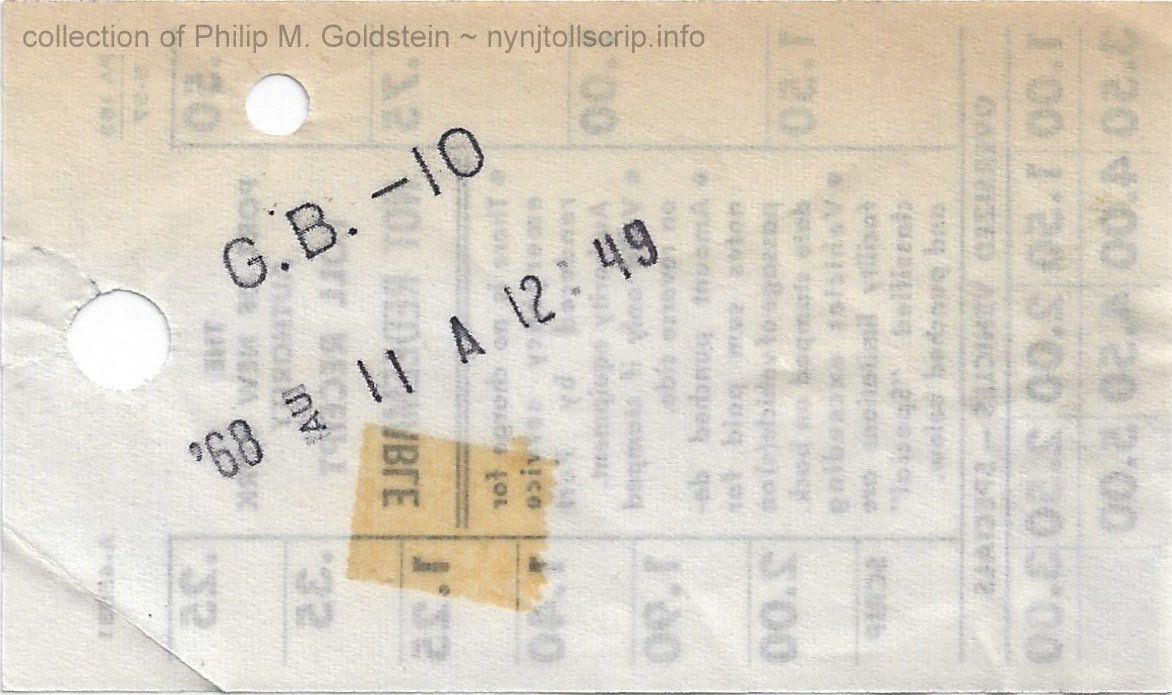 |
PoNYA Toll Receipt - August 11, 1968 6:28 AM - $.50
G.B.-7 (Goethals Bridge)
Form PA 163 5-57 A-45631
2 1/8" x 4"
collection of
Philip M. Goldstein |
|
PoNYA Toll Receipt - August 11, 1968 - $.50
G.B.-10 (Goethals Bridge)
Form PA 163 5-57 A-45631
2 1/8" x 4"
collection of
Philip M. Goldstein |
|
|
|
|
|
| PoNYA PA 163 / 5-69 A-68044 Receipt |
|
PoNYA PA 163 / 7-70 76117 Receipt |
|
|
|
|
PoNYA Toll Receipt - August 8, - $1.50
PA 163 - A68044
2 1/4" x 3/4"
collection of
Philip M. Goldstein |
|
PoNYA Toll Receipt - November 10, 1975 - $1.50
GW (George Washington Bridge)
PA 163 - 7-70 - 76117
2 1/4" x 3/4"
collection of
Philip M. Goldstein |

PoNYA Scrip & Commutation Book - Serial Number Prefixes
& Designs Observed
The following is a tabulation of observed (or lack of prefix) letters,
with serif, sans-serif or lack of "GOOD UNTIL USED"; and security field
designs for all known Port of New York Authority issues.
If you have an issue with a letter prefix not listed, you are
invited to contact me to add it here: bedt14@aol.com or (936) 396-6103.
Scrip - Port of New York Authority Issues
|
| denom |
series |
year |
notes |
n/p |
A |
B |
C |
D |
E |
F |
G |
H |
I |
J |
K |
L |
M |
N |
O |
P |
Q |
R |
S |
T |
U |
V |
W |
X |
Y |
Z |
printer |
.25
|
TS1 |
1935 |
intaglio, guilloché
back, no s/n prefix
does not have Lincoln Tunnel
no GOOD UNTIL USED
diamond, circle & square security field
light card stock |
n/p |
- |
- |
- |
- |
- |
- |
- |
- |
- |
- |
- |
- |
- |
- |
- |
- |
- |
- |
- |
- |
- |
- |
- |
- |
- |
- |
unknown |
| . |
|
|
|
|
|
|
|
|
|
|
|
|
|
|
|
|
|
|
|
|
|
|
|
|
|
|
|
|
|
|
|
.25
|
TS1 |
1935 |
litho,
plain back w/ Banknote Roman numerals: .25
has Lincoln Tunnel,
security field ? |
presumed to exist, not yet observed |
|
| . |
|
|
|
|
|
|
|
|
.. |
|
|
|
...... |
...... |
|
|
|
|
|
|
|
|
... |
|
|
|
|
|
|
... |
|
.25
|
TS1 |
1935 |
litho,
plain back w/ Agency numerals: .25
has Lincoln Tunnel,
crescent, wedge & line security field |
presumed to exist, not yet observed |
|
| . |
|
|
|
|
|
|
|
|
|
|
|
|
|
|
|
|
|
|
|
|
|
|
|
|
|
|
|
|
|
|
|
.25
|
TS1 |
1960 |
litho,
frame back w/ Agency numerals: .25
has Lincoln Tunnel,
Gloucester GOOD
UNTIL USED
crescent, wedge & line security field
A250025 seen with Department of the Army - Motor Vehicle overstamp |
|
A |
|
|
|
|
|
|
|
|
|
|
|
|
|
|
|
|
|
|
|
|
|
|
|
|
|
Rand
McNally |
| . |
|
|
|
|
|
|
|
|
|
|
|
|
|
|
|
|
|
|
|
|
|
|
|
|
|
|
|
|
|
|
|
.50
|
TS2 |
1935 |
litho,
guilloché back
no GOOD
UNTIL USED
F936462 w/ WAR DEPT VEHICLES overtype |
|
|
|
|
|
|
F
|
|
|
|
|
|
|
|
|
|
|
|
|
|
|
|
|
|
|
|
|
Rand
McNally |
| . |
|
|
|
|
|
|
|
|
|
|
|
|
|
|
|
|
|
|
|
|
|
|
|
|
|
|
|
|
|
|
|
.50
|
TS2 |
1935 |
litho,
guilloché back
no GOOD
UNTIL USED
crescent, wedge & line security field
|
|
|
B |
|
|
E |
|
|
|
|
J |
|
|
|
|
|
|
|
|
|
|
|
|
|
|
|
|
unknown |
| . |
|
|
|
|
|
|
|
|
|
|
|
|
|
|
|
|
|
|
|
|
|
|
|
|
|
|
|
|
|
|
|
| .50 |
TS2 |
1935 |
litho,
frame back w/ Banknote Roman numerals: .50
Optima GOOD
UNTIL USED
cross
security field |
|
|
|
|
|
|
|
G |
H |
|
|
|
|
|
|
|
|
|
|
|
|
|
|
|
|
|
|
Rand
McNally |
|
|
|
|
|
|
|
|
|
|
|
|
|
|
|
|
|
|
|
|
|
|
|
|
|
|
|
|
|
|
|
|
| .50 |
TS2 |
1935 |
litho,
frame back w/ Agency numerals:
.50
Gloucester
GOOD
UNTIL USED
crescent,
wedge & line security field
F478379 has Associated Transport
o/p
L589577 has Chesapeake Motor Lines o/p on back
K 206601-24 has ACME T&S Co Inc NYC perforated |
|
A |
|
C |
D |
|
F |
|
|
|
J |
K |
L |
M |
N |
|
|
|
R |
S |
T |
U |
V |
W |
X |
Y |
Z |
Rand
McNally |
| . |
|
|
|
|
|
|
|
|
|
|
|
|
|
|
|
|
|
|
|
|
|
|
|
|
|
|
|
|
|
|
|
| .50 |
TS2 |
1935 |
litho,
blank frame back
Gloucester GOOD
UNTIL USED
L206345 w/ typed "FOR USE OF NAVY VEHICLE ONLY"
|
|
|
|
|
|
|
|
|
|
|
|
|
L |
|
|
|
|
|
|
|
|
|
|
|
|
|
|
Rand
McNally |
|
|
|
|
|
|
|
|
|
|
|
|
|
|
|
|
|
|
|
|
|
|
|
|
|
|
|
|
|
|
|
|
| .50 |
TS2 |
1935 |
litho,
blank
frame back
Gloucester GOOD
UNTIL USED
M208179
|
|
|
|
|
|
|
|
|
|
|
|
|
|
M |
|
|
|
|
|
|
|
|
|
|
|
|
|
Rand
McNally |
| . |
|
|
|
|
|
|
|
|
|
|
|
|
|
|
|
|
|
|
|
|
|
|
|
|
|
|
|
|
|
|
|
.50
|
TS2 |
1969 |
Statue
of Liberty design,
OCR-A font for series and s/n on left
side |
|
|
|
|
|
|
|
|
|
|
|
|
|
|
|
|
|
|
|
|
|
|
|
|
|
|
|
unknown |
| . |
|
|
|
|
|
|
|
|
|
|
|
|
|
|
|
|
|
|
|
|
|
|
|
|
|
|
|
|
|
|
|
.75
|
TS3
|
1935 |
litho,
guilloché back
security field ? |
presumed
to exist, not yet observed
|
|
| . |
|
|
|
|
|
|
|
|
|
|
|
|
|
|
|
|
|
|
|
|
|
|
|
|
|
|
|
|
|
|
|
| .75 |
TS3 |
1935 |
litho,
frame back w/ Banknote Roman numerals: .75
Optima GOOD
UNTIL USED
cross
security field |
|
A |
|
|
|
|
|
|
|
|
|
|
|
|
|
|
|
|
|
|
|
|
|
|
|
|
|
|
| . |
|
|
|
|
|
|
|
|
|
|
|
|
|
|
|
|
|
|
|
|
|
|
|
|
|
|
|
|
|
|
|
.75
|
TS3
|
1935 |
litho,
frame back w/ Agency numerals: .75
Gloucester GOOD
UNTIL USED
crescent, wedge & line security field |
|
|
|
|
|
|
|
|
|
|
|
|
|
|
|
|
|
|
|
|
|
|
|
W |
|
Y |
Z |
Rand
McNally |
| . |
|
|
|
|
|
|
|
|
|
|
|
|
|
|
|
|
|
|
|
|
|
|
|
|
|
|
|
|
|
|
|
1.00
|
TS4 |
1935 |
litho,
guilloché back: 1 DOLLAR
no GOOD
UNTIL USED
crescent, wedge & line security field |
|
|
|
|
|
|
|
|
|
|
|
|
L |
|
|
|
|
|
|
|
|
|
|
|
|
|
|
Rand
McNally |
| . |
|
|
. |
|
|
|
|
|
|
|
|
|
|
|
|
|
|
|
|
|
|
|
|
|
|
|
|
|
|
|
|
|
|
|
litho,
single frame back w/ Banknote Roman numerals: 1.00 |
|
|
|
|
|
|
|
|
|
|
|
|
|
|
|
|
|
|
|
|
|
|
|
|
|
|
|
|
| 1.00 |
TS4 |
1935 |
large
10 pt Gloucester GOOD
UNTIL USED, dot &
long hyphen |
|
|
|
|
|
|
F
|
G
|
|
|
J |
|
|
|
|
|
|
|
|
|
|
|
|
|
|
|
|
Globe Ticket |
|
|
|
crude
crescent, wedge & line security field |
|
|
|
|
|
|
|
|
|
|
|
|
|
|
|
|
|
|
|
|
|
|
|
|
|
|
|
|
.
|
|
|
|
|
|
|
|
|
|
|
|
|
|
|
|
|
|
|
|
|
|
|
|
|
|
|
|
|
|
|
|
1.00
|
TS4 |
1935 |
litho,
double frame back w/ Banknote Roman numerals: 1.00
Optima GOOD
UNTIL USED
security field ? |
|
A |
|
|
|
|
|
|
|
|
|
|
|
|
|
|
|
|
|
|
|
|
|
|
|
|
|
Rand
McNally |
| . |
|
|
. |
|
|
|
|
|
|
|
|
|
|
|
|
|
|
|
|
|
|
|
|
|
|
|
|
|
|
|
|
1.00
|
TS4 |
1935 |
litho,
frame back w/ Agency numerals:
1.00
Gloucester GOOD
UNTIL USED
*R898182 perfed "US" |
|
A |
|
|
|
|
|
G |
|
|
|
K |
|
|
|
O |
P
|
Q |
R* |
|
|
U |
V |
|
|
|
|
Rand
McNally |
| . |
|
|
|
|
|
|
|
|
|
|
|
|
|
|
|
|
|
|
|
|
|
|
|
|
|
|
|
|
|
|
|
1.00
|
TS4 |
1969 |
Statue
of Liberty design,
OCR-A font for series and s/n on left
side |
n/p |
|
|
|
|
|
|
|
|
|
|
|
|
|
|
|
|
|
|
|
|
|
|
|
|
|
|
unknown |
| . |
|
|
|
|
|
|
|
|
|
|
|
|
|
|
|
|
|
|
|
|
|
|
|
|
|
|
|
|
|
|
|
1.50
|
TS5 |
1951 |
litho,
guilloché back:
1 50/100 DOLLARS
no GOOD
UNTIL USED
crescent, wedge & line security field |
n/p |
|
|
|
|
|
|
|
|
|
|
|
|
|
|
|
|
|
|
|
|
|
|
|
|
|
|
Rand
McNally |
| . |
|
|
|
|
|
|
|
|
|
|
|
|
|
|
|
|
|
|
|
|
|
|
|
|
|
|
|
|
|
|
|
1.50
|
TS5 |
1951 |
litho,
frame back w/ Banknote Roman numerals: 1.50
Optima GOOD
UNTIL USED
security field ? |
|
|
|
|
|
|
|
|
|
|
|
|
|
|
|
|
|
|
|
|
|
|
|
|
X |
|
|
Rand
McNally |
|
|
|
|
|
|
|
|
|
|
|
|
|
|
|
|
|
|
|
|
|
|
|
|
|
|
|
|
|
|
|
|
|
1.50 |
TS5 |
1951 |
litho,
frame back
w/ square numerals: I.00
Gloucester GOOD
UNTIL USED
crescent, wedge & line security field |
|
|
|
|
|
|
|
|
|
|
|
|
|
|
|
|
|
|
|
|
|
U |
V |
W |
|
|
|
Rand
McNally |
| . |
|
|
|
|
|
|
|
|
|
|
|
|
|
|
|
|
|
|
|
|
|
|
|
|
|
|
|
|
|
|
|
|
1.75?
2.00?
2.25? 2.50?
|
TS6 |
1969?
1970? |
|
|
|
|
|
|
|
|
|
|
|
|
|
|
|
|
|
|
|
|
|
|
|
|
|
|
|
|
|
| presumed
to exist, not yet observed |
|
|
|
|
|
|
|
|
|
|
|
|
|
|
|
|
|
|
|
|
|
|
|
|
|
|
|
|
|
|
|
|
|
|
|
|
|
| . |
|
|
|
|
|
|
|
|
|
|
|
|
|
|
|
|
|
|
|
|
|
|
|
|
|
|
|
|
|
|
|
| 3.00 |
TS7 |
1970 |
Statue
of Liberty design,
OCR-A font for
series and s/n on
right side
overprinting seen for Transcon trucking line
|
n/p |
|
|
|
|
|
|
|
|
|
|
|
|
|
|
|
|
|
|
|
|
|
|
|
|
|
|
unknown |
..
Commutation
Tickets & Books - Port
of New York Authority Issues
|
|
|
F-4 |
1934/
1935 |
Motor
Truck (2 axles) up to 2 tons -
Goethals, Outerbridge or Bayonne Bridges
$10.00 - 7 months (6 months in addition to month purchased)
no serial number - coupon #23 |
|
|
|
|
|
|
|
|
|
|
|
|
|
|
|
|
|
|
|
|
|
|
|
|
|
|
|
Int'l
Ticket Co |
| . |
|
|
|
|
|
|
|
|
|
|
|
|
|
|
|
|
|
|
|
|
|
|
|
|
|
|
|
|
|
|
|
|
|
|
Motor Truck (2 axles) 2 to 5 tons
Tractor w/ semi trailer (3 axles) less than 5 tons
Passenger Auto w/ semi trailer (3 axles)
$15.00 - 7 months (6 months in addition to month purchased) |
|
|
|
|
|
|
|
|
|
|
|
|
|
|
|
|
|
|
|
|
|
|
|
|
|
|
|
|
| . |
|
|
|
|
|
|
|
|
|
|
|
|
|
|
|
|
|
|
|
|
|
|
|
|
|
|
|
|
|
|
|
|
|
|
Motor Truck (2 axles) more than 5 tons
Tractor w/ Semi Trailer (3 axles)
Truck Tractor (3 Axles)
$18.75 - 7 months (6 months in addition to month purchased) |
|
|
|
|
|
|
|
|
|
|
|
|
|
|
|
|
|
|
|
|
|
|
|
|
|
|
|
|
| . |
|
|
|
|
|
|
|
|
|
|
|
|
|
|
|
|
|
|
|
|
|
|
|
|
|
|
|
|
|
|
|
|
H3 |
1942/
1943 |
Passenger
Auto
Goethals, Outerbridge or Bayonne Bridges only
$6.00 - good until December 31, 1943
s/n 122500 |
|
|
|
|
|
|
|
|
|
|
|
|
|
|
|
|
|
|
|
|
|
|
|
|
|
|
|
|
| . |
|
|
|
|
|
|
|
|
|
|
|
|
|
|
|
|
|
|
|
|
|
|
|
|
|
|
|
|
|
|
|
| new design |
H4 |
1970 |
Passenger
Auto - 40 ticket / 30 day / $10.00
good until August 12, 1970
s/n 14 00226223 |
14 xxxxxx |
Rand McNally
|
| . |
|
|
|
|
|
|
|
|
|
|
|
|
|
|
|
|
|
|
|
|
|
|
|
|
|
|
|
|
|
|
|
|
H4
black |
1960
1965 |
Passenger
Auto - 40 trip / 30 day / $10.00
all crossings
good until August 20, 1960 - s/n C 233127
good until July 14, 1965 - s/n E 648863 |
|
|
C
1960 |
|
E
1965 |
|
|
|
I
unk |
|
|
|
|
|
|
|
|
|
|
|
|
|
|
|
|
|
|
Rand McNally |
| . |
|
|
|
|
|
|
|
|
|
|
|
|
|
|
|
|
|
|
|
|
|
|
|
|
|
|
|
|
|
|
|
| new design |
H4 |
1970 |
Passenger
Auto - 40 ticket / 30 day / $10.00
good until August 12, 1970
s/n 14 00226223 |
14 xxxxxx |
Rand McNally
|
| . |
|
|
|
|
|
|
|
|
|
|
|
|
|
|
|
|
|
|
|
|
|
|
|
|
|
|
|
|
|
|
|
| new design |
H4 |
1972 |
Passenger
Auto - 20 ticket / 30 day / $10.00
good until February 17, 1972
s/n 1 828604 (gsc) |
16 xxxxxx |
Rand McNally
|
|
|
|
|
|
|
|
|
|
|
|
|
|
|
|
|
|
|
|
|
|
|
|
|
|
|
|
|
|
|
|
|
|
H5 |
1958 |
Passenger
Auto
good until December 31, 1958
s/n A 317888 |
A
|
|
|
|
|
|
|
|
|
|
|
|
|
|
|
|
|
|
|
|
|
|
|
|
|
|
|
Rand
McNally |
|
|
|
|
|
|
|
|
|
|
|
|
|
|
|
|
|
|
|
|
|
|
|
|
|
|
|
|
|
|
|
|
|
H5 |
1965 |
Passenger
Auto
good until December 31, 1969
s/n C 270580 |
|
|
C |
|
|
|
|
|
|
|
|
|
|
|
|
|
|
|
|
|
|
|
|
|
|
|
|
Rand
McNally |
| . |
|
|
|
|
|
|
|
|
|
|
|
|
|
|
|
|
|
|
|
|
|
|
|
|
|
|
|
|
|
|
|
|
H5 |
1966 |
Passenger
Auto
good until December 31, 1969
s/n C 457294 |
|
|
C |
|
|
|
|
|
|
|
|
|
|
|
|
|
|
|
|
|
|
|
|
|
|
|
|
Rand
McNally |
.
|
|
|
|
|
|
|
|
|
|
|
|
|
|
|
|
|
|
|
|
|
|
|
|
|
|
|
|
|
|
|
|
|
H5 |
1967 |
Passenger
Auto
good until December 31, 1969
s/n C 927378 |
|
|
C |
|
|
|
|
|
|
|
|
|
|
|
|
|
|
|
|
|
|
|
|
|
|
|
|
Rand
McNally |
| . |
|
|
|
|
|
|
|
|
|
|
|
|
|
|
|
|
|
|
|
|
|
|
|
|
|
|
|
|
|
|
|
|
H5 |
1968 |
Passenger
Auto
good until December 31, 1969
s/n D 252957 |
|
|
|
D
|
|
|
|
|
|
|
|
|
|
|
|
|
|
|
|
|
|
|
|
|
|
|
|
Rand
McNally |
.
|
|
|
|
|
|
|
|
|
|
|
|
|
|
|
|
|
|
|
|
|
|
|
|
|
|
|
|
|
|
|
|
|
H5 |
1969 |
Passenger
Auto - 25 trip / 2 Year /
$10.00
good until December 31, 1969
s/n D 569020 |
|
|
|
D |
|
|
|
|
|
|
|
|
|
|
|
|
|
|
|
|
|
|
|
|
|
|
|
Rand
McNally |
| . |
|
|
|
|
|
|
|
|
|
|
|
|
|
|
|
|
|
|
|
|
|
|
|
|
|
|
|
|
|
|
|
|
H5 |
1970 |
Passenger
Auto - 25 trip / 2 Year /
$10.00
good until December 31, 1970
s/n E 240343 |
|
|
|
|
E
|
|
|
|
|
|
|
|
|
|
|
|
|
|
|
|
|
|
|
|
|
|
|
Rand
McNally |
.
|
|
|
|
|
|
|
|
|
|
|
|
|
|
|
|
|
|
|
|
|
|
|
|
|
|
|
|
|
|
|
|
|
H5 |
1971 |
Passenger
Auto - 25 trip / 2 Year / $10.00
good until December 31, 1969
s/n E 749604 |
|
|
|
|
E |
|
|
|
|
|
|
|
|
|
|
|
|
|
|
|
|
|
|
|
|
|
|
Rand
McNally |
| . |
|
|
|
|
|
|
|
|
|
|
|
|
|
|
|
|
|
|
|
|
|
|
|
|
|
|
|
|
|
|
|
| new design |
H5 |
|
Passenger
Auto - 25 trip / 1 Year / $10.00
good until December 31, 1972
s/n 00212025 |
|
|
|
|
15 |
|
|
|
|
|
|
|
|
|
|
|
|
|
|
|
|
|
|
|
|
|
|
|
| .. |
|
|
|
|
|
|
|
|
|
|
|
|
|
|
|
|
|
|
|
|
|
|
|
|
|
|
|
|
|
|
|
|
P |
1964? |
Employees
Personal Pass
P 89098 - coupon #24
form PA-378 10/64 |
|
|
|
|
|
|
|
|
|
|
|
|
|
|
|
|
P |
|
|
|
|
|
|
|
|
|
|
Rand
McNally |

Port Authority of New York
and New Jersey
In 1972, the Port of New York Authority was renamed to better
reflect its status and partnership concerning the two states, that
being of New York AND New Jersey.
As the PANYNJ was now involved in not just administering to
bridges and tunnels; but passenger bus routes and stations, commuter
rail facilities, freight railroad stations & terminals, maritime
shipping ports & facilities, helipads, airports & airfields as
well as commercial land ownership and leasing office space. As such,
the PANYNJ underwent a reorganization to better administer to and
reflect operation of all these entities, and the bi-state nature of
these properties.
As a result of and in relation to this new corporate identity, new printings of all
toll scrip and commutation books were changed to carry the agency's new
identity: The Port Authority of New York and New Jersey.
|
Please
note:
In consideration of the removal of a series number or issue years
from this and subsequent designs, the following scrip issue designs are
divided into tentative
First, Second, Third, Fourth and Fifth issues for either Scrip or
Commutation Books at this time. This series system is based on changes
in general appearance, use of PANYNJ logos and dates of use as either
written on the inside front cover, or in the printing codes on the
stubs. If information is received from official PANYNJ sources or
collectors, that an official series name or number exists, the
nomenclature on this website may change. |
Scrip was sold in booklets of 25 tickets, and were good until used.
Commutation tickets had an expiration date based on the use: 30 day 20 ticket , 6 month 60 tickets
For the
denominations of scrip issued; if my understanding is correct from what is
stated in the 60th Anniversary Goethals Bridge & Outerbridge
Crossing Map & Pamphlet; there should an issue of scrip in each
denomination that corresponds to each toll class for that toll schedule. When the tolls were
raised, the old lowest denomination was retired, and the new toll rates for each class up to the highest
denomination were printed in a new series.
|
|
scrip issue: |
TS-4 /
First |
Second |
Third |
Fourth |
Fifth |
Sixth? |
Seventh? |
Eighth? |
| class |
vehicle description |
wheel arrangement (front = right) |
1969* |
1976 |
1984 |
1987 |
1991 |
2001 |
2008 |
2011 |
| Class 1 |
two axle autos |
(o o) |
|
1.50 |
2.00 |
3.00 |
4.00 |
6.00 |
8.00 |
12.00 |
| Class 2 |
two axle trucks |
[o o] |
1.00 |
2.00 |
3.00 |
6.00 |
8.00 |
12.00 |
16.00 |
24.00 |
| Class 3 |
three axle trucks |
[o]+[o==o] |
|
3.00 |
4.50 |
9.00 |
12.00 |
18.00 |
24.00 |
36.00 |
| Class 4 |
four axles trucks |
[oo]+[o==o] or [o]+[oo==o] |
|
4.50 |
6.00 |
12.00 |
16.00 |
24.00 |
32.00 |
48.00 |
| Class 5 |
five axles trucks |
[oo]+[oo==o] |
|
6.00 |
7.50 |
15.00 |
20.00 |
30.00 |
40.00 |
60.00 |
| Class 6 |
six axle trucks |
[ooo]+[oo==o] |
|
7.50 |
15.00 |
18.00 |
24.00 |
36.00 |
48.00 |
72.00 |
| Class 7 |
two axle auto w/ single axle trailer or motorcycle with single axle trailer |
o+(o-o) or o+ o/o |
|
2.25 |
4.00 |
4.00 |
|
|
|
|
| Class 7 |
two axles auto w/ two axle trailer or motorcycle with two axle trailer |
oo+(o-o) or oo+ o/o |
|
3.00 |
6.00 |
6.00 |
|
|
|
|
| Class 8 |
two axle buses |
{o°°°°o} |
|
2.00 |
|
3.00 |
4.00 |
|
|
|
| Class 9 |
three axle buses |
{oo°°°°°o} or {°°o°°}-{o°°°o} |
|
2.00 |
|
3.00 |
4.00 |
|
|
|
| Class 11 |
motorcycles |
o/o |
|
.50 |
1.00 |
2.00 |
|
|
|
|
Only
colored cells are confirmed to exist (either in my collection or in official photos), and are so
colored in the main face color of the scrip.
Other
colors are presumed to
exist, but their denominations are not known and are not shown at this
time. As a denomination / color is confirmed, it will be added to the
chart.
Sixth,
Seventh and Eighth series have not been seen but are presumed to exist
in some fashion as toll scrip acceptance did not end until June 30,
2012; so it is therefore presumed (but not confirmed) that scrip was issued in
the denomination respective for the 2001, 2008 and 2011 toll
raises.
*
Even though notes of this issue bear the legend "Series TS4-1969"; this
issue was printed after the new name of the agency: "Port Authority of
New York and New Jersey" took effect in 1972. |
Please keep in mind, old denominations of scrip was still usable
"Good Until Used", and could be used in either in their full printed
denomination or in combinations of several scrip to total the exact
amount of the toll owed; or scrip and the difference made up in
currency could be used to pay the toll. No change was given for scrip tendered over the amount due.
Making things even more confusing; it appears that revisions were
made to certain book issues within a "Series", as can be witnessed with
yellow Passenger Vehicle 30 Day - 20 Ticket - $40.00 ticket books. We
see a Series H4 issued in 1986 (with serial numbers in the high 5
million range), which was changed to PA3521 S.C. 87 (with serial
numbers low 5 million range), then a third variety PA3521 / 1-88 (with
serial numbers in the high 5 to 8 million range).
As such, these issues should all fall into the Third Series issues
.
.
PANYNJ
Scrip - First Issue - ca. 1972 - Series of 1969
Please do
not hesitate to contact me either by email at bedt14@aol.com
or by telephone at (936) 396-6103.
As such, the lettering and underprinting of the scrip
was changed to reflect the new agency name. While the front design
appears unchanged, the color of the back of the scrip was changed to
green; and now, the underprinting was a smaller repeating version of
the Statue of Liberty (replacing the PoNYA seal) as well as the small
words "Port Authority of New York and New Jersey" of face and back.
 |
 |
PANYNJ
First Issue - Series TS4 - 1969 - $1.00
collection
of Philip M. Goldstein
|
printer:
printing
method:
security printing, paper / watermark:
design colors, face:
design
notes, face:
security underprinting, signature field, face:
facsimile
signature:
serial number:
design colors, back:
design notes, back:
security
underprinting, signature field, face:
notes, other:
size: |
unknown
lithographic
none
lime green, black text, blue numerals, white (unprinted) Statue of Liberty head
all text sans-serif
medium green security underprint "Port Authority of New York and New Jersey"
none
black OCR-A font, in unprinted margin on right, registration angle at top right
green
sans-serif denomination numbers on back,
wide unprinted area left, thin strip on right
repeating PORT AUTHORITY
OF NEW YORK AND NEW JERSEY" and Statue
of Liberty face
3 ¾" (width) - 2 ⅛" (height) - 0.005"
(thickness) |
Until now, all notes seen had fit neatly into either the final
1969 and 1970 Series of PoNYA scrip above or the issues of PANYNJ below.
But the appearance of the
$1.00 scrip directly above now presents a quandary. It clearly says
Port of New York and New Jersey, and front and back designs match those
in those series illustrated below. However, it still retains the
designation Series TS4 - 1969 in the upper left, and it has an OCR-A
series number (04), serial number and 90 degree registration angle as
with the final Port of New York Authority series from the previous
designs, as seen on notes in the chapter prior to this.
However the unprinted area for the serial number is on the right which conforms to following
PANYNJ issues (instead of left as with
those previous PoNYA issues).
It is unknown if there are other denominations conforming
to the above design, or if only the $1.00 note appeared like this, with
the $1.50 and higher denominations falling into below designs , which
would in actuality make them part of the First Issue. Until more
information surfaces or other notes appear, I will keep the designs
separated by issue.
Therefore,
the appearance of this above note now has been designated PANYNJ First
Issue, and those issue numbers of notes listed below have been advanced
by one (First becoming Second, Second becoming Third, etc).
All
subsequent PANYNJ issues appear to forgo the use of the Series TS
designation. Denominations in my collection are $2.25, $3.00 and $6.00.
Serial numbers remain in the unprinted area on right, but are now in a
larger easier to read sans-serif number font.
The serial number is no
longer in OCR-A font, and appears to a standard sans-serif numbering
font (but still can be optically recognized) applied via automatic
letterpress numbering crash numbering machines.
There is one variety worth noting: on the $6.00 issue,
there is seen a serial number without prefix, and one with a double
zero (00) prefix. The purpose or meaning of this 00 prefix is unknown
at this time.
Also, on notes higher than 9,999,999, the numeral 1
for the 10 million designation appears to have been printed in a
separate process from the rest of the serial number; perhaps even at
the time of the application of the black ink process for the main
design. Also seen is a double zero, 00 prefix.
This size of the scrip remains as with all previous issues: 3
¾" (width) - 2 ⅛" (height) - 0.005" (thickness).
| Series H-4 Commute Books - 30 day / 20 ticket |
 |
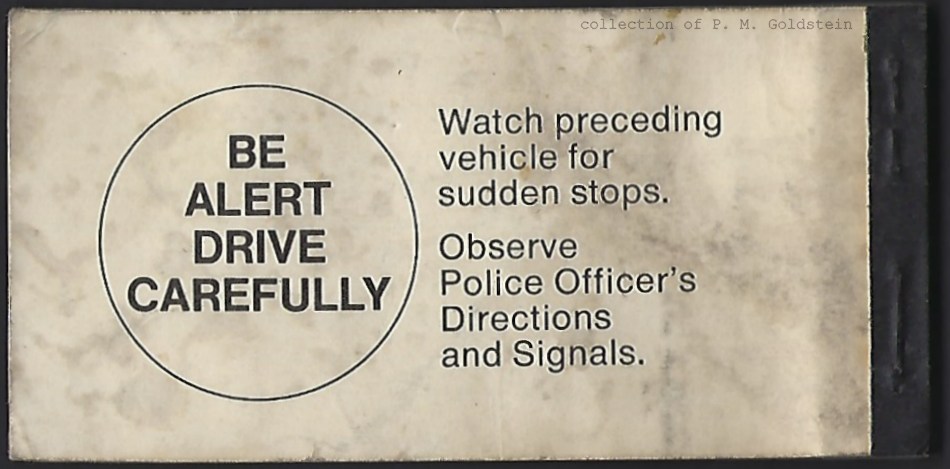 |
PANYNJ First Issue - Series H-4 -
October 1973
30 day / 20 ticket / $10.00
large gothic font serial number with 003 prefix to 5 digit serial number
collection of
Philip M. Goldstein |
facsimile
signature:
printer:
colors:
serial number:
notes:
security
underprinting, face:
security underprinting, back:
size: |
none
Rand McNally
face: purple, white head of Statue of Liberty
back: purple
gothic font; 003 prefix, black ink, in purple background
unknown
unknown
3 ¾" (width) - 2 ⅛" (height) - 0.005" (thickness) |
| . |
|
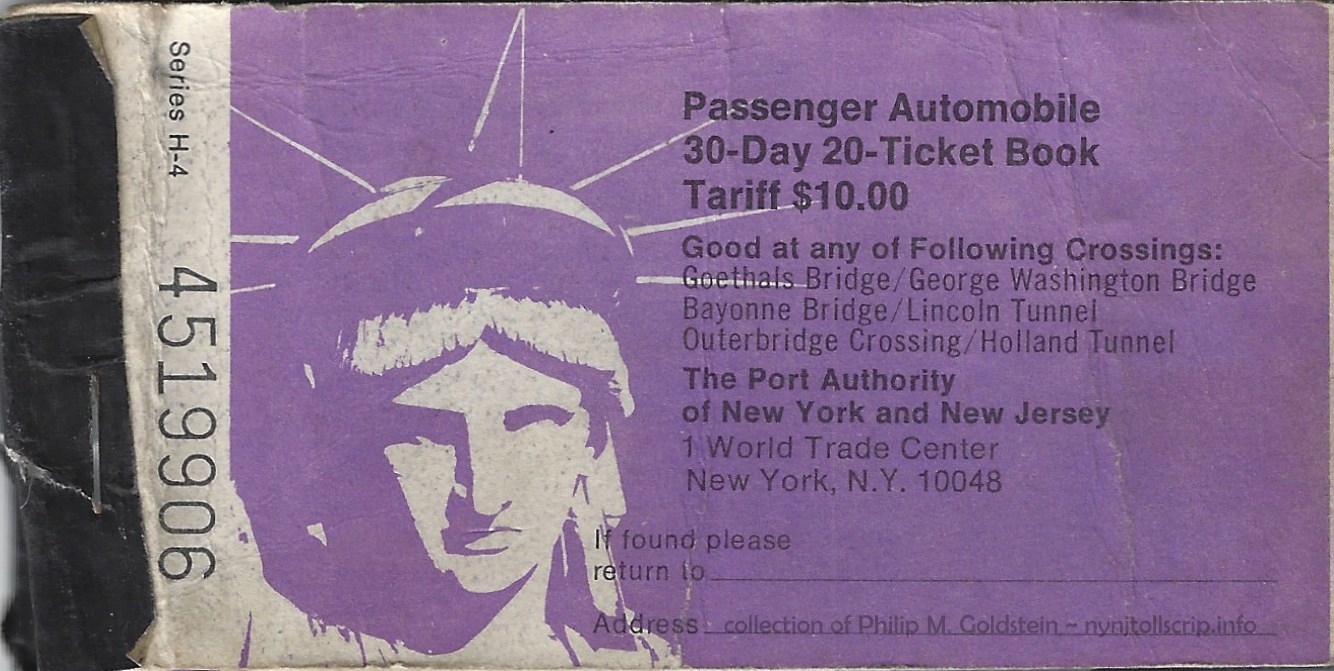 |
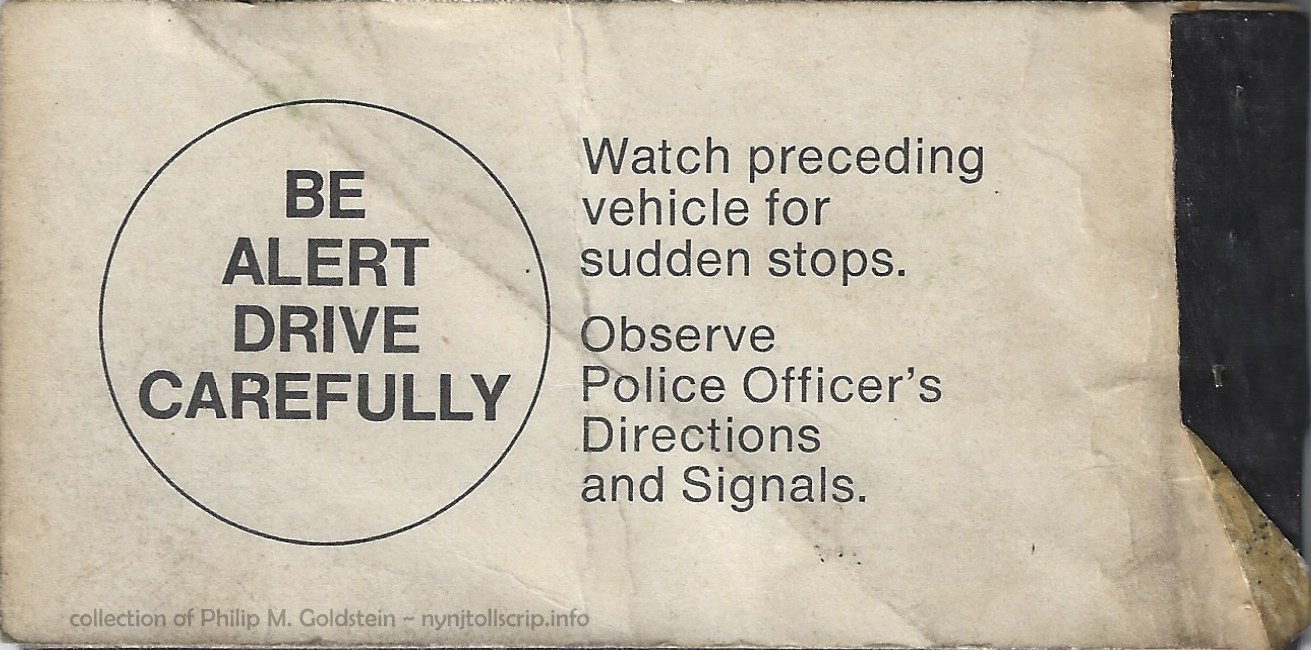 |
PANYNJ First Issue -
Series H-4 - September 1974
30 day / 20 ticket / $10.00
large gothic font serial number with no prefix to 6 digit serial number
collection of
Philip M. Goldstein |
facsimile
signature:
printer:
colors:
serial number:
notes:
security
underprinting, face:
security underprinting, back:
size: |
none
unknown
face: purple, white head of Statue of Liberty
back: purple
gothic font; black ink, in unprinted area
unknown
unknown
3 ¾" (width) - 2 ⅛" (height) - 0.005" (thickness) |
.
. |
|
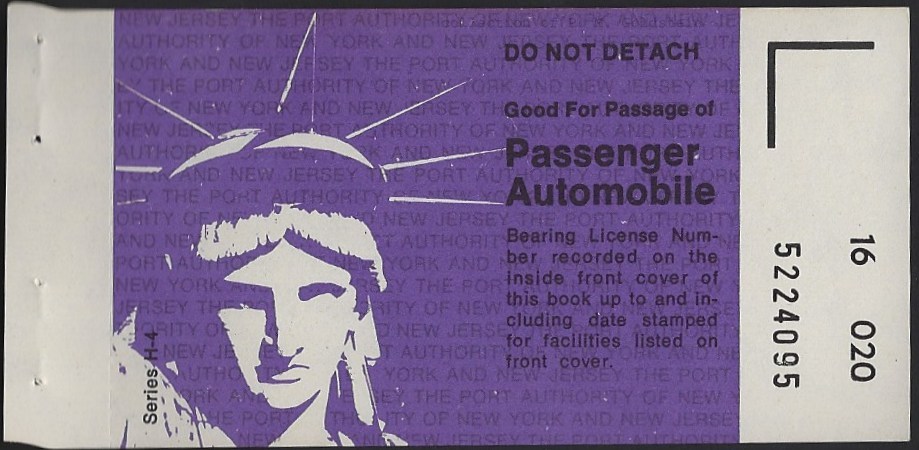 |
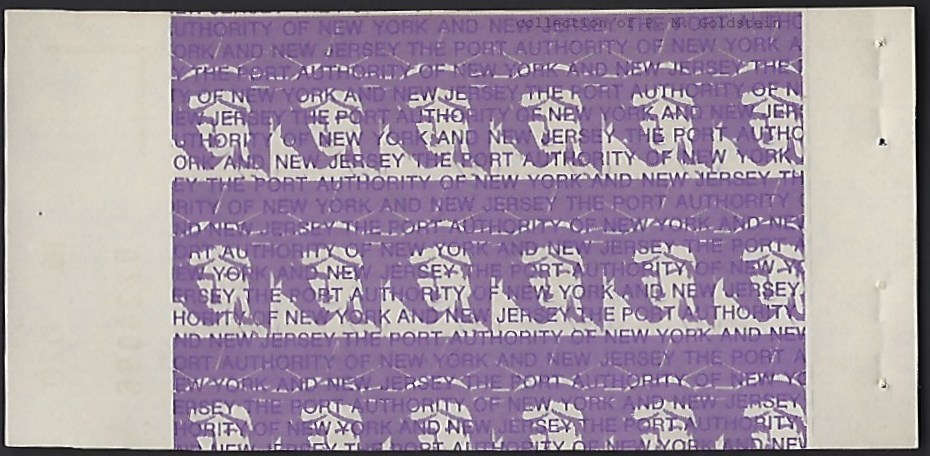 |
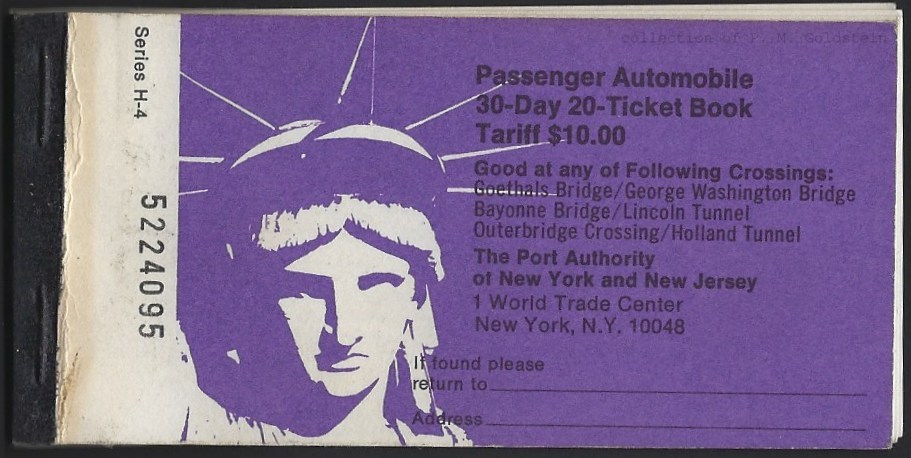 |
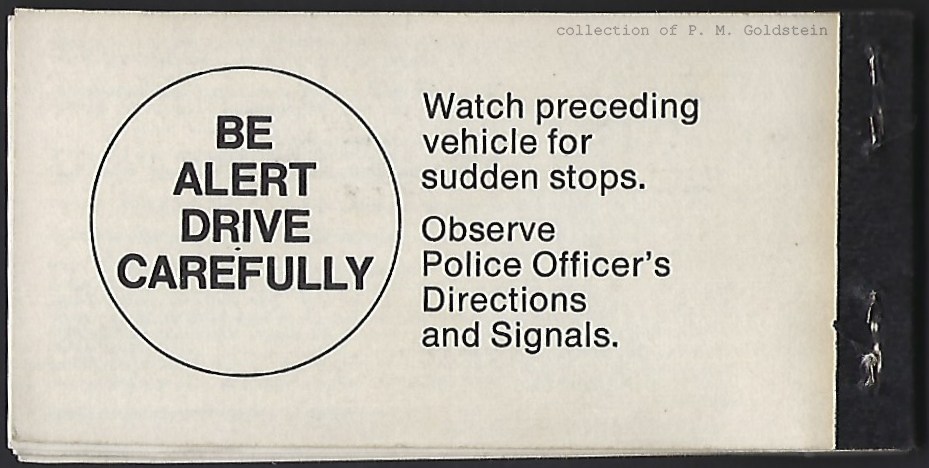 |
PANYNJ First Issue -
Series H-4 - June 1975
30 day / 20 ticket / $10.00
small OCR-B font, - no prefix to 6 digit serial number
collection of
Philip M. Goldstein
|
printer:
printing
method:
security printing, paper / watermark:
design colors, face:
design
notes, face:
security underprinting, signature field, face:
facsimile
signature:
serial number:
design colors, back:
design notes, back:
security
underprinting, signature field, face:
notes, other:
size: |
unknown
lithographic
none
purple, black text, white (unprinted) Statue of Liberty head
all text sans-serif
purple security underprint "Port Authority of New York and New Jersey"
none
black OCR-B font, in unprinted margin on right, registration angle at top right
purple
sans-serif denomination numbers on back,
unprinted area left, stub unprinted
repeating PORT
AUTHORITY OF NEW YORK AND NEW JERSEY" and
Statue of Liberty face
Class 16? 020 = ticket number
3 ¾" (width) - 2 ⅛" (height) - 0.005" (thickness) |
| Series H-5 Commute Books - 12 ticket / 1 year |
 |
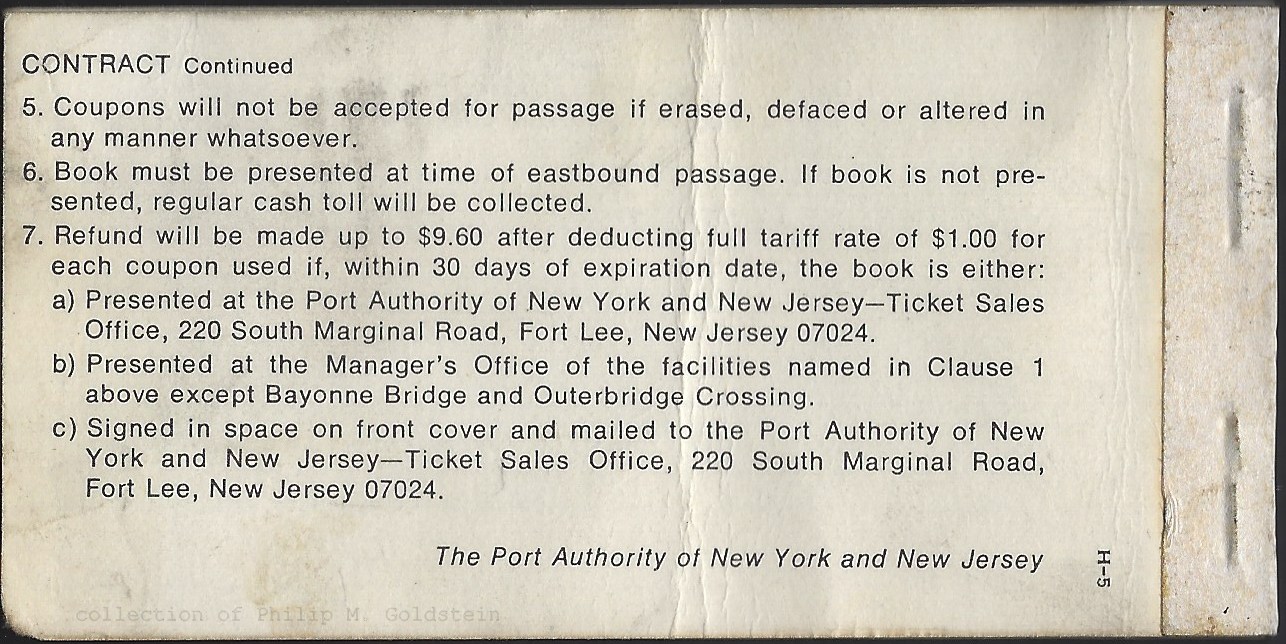 |
PANYNJ First Issue -
Series H-5 - 1976
1 year / 12 ticket / $9.60
large font serial number with 002 serial number prefix
collection of
Philip M. Goldstein |
printer:
printing
method:
security printing, paper / watermark:
design colors, face:
design
notes, face:
security underprinting, signature field, face:
facsimile
signature:
serial number:
design colors, back:
design notes, back:
security
underprinting, signature field, face:
notes, other:
size: |
Rand
McNally
lithographic
none
presumed purple, black text, white (unprinted) Statue of Liberty head
all text sans-serif
purple security underprint "Port Authority of New York and New Jersey"
none
black ink, sans-serif
font with 002
prefix on cover, OCR-A font on tickets ?
purple
unknown
repeating PORT
AUTHORITY OF NEW YORK AND NEW JERSEY" and
Statue of Liberty face
white cloth binding on booklet cover
3 ¾" (width) - 2 ⅛" (height) - 0.005" (thickness) |
.
. |
|
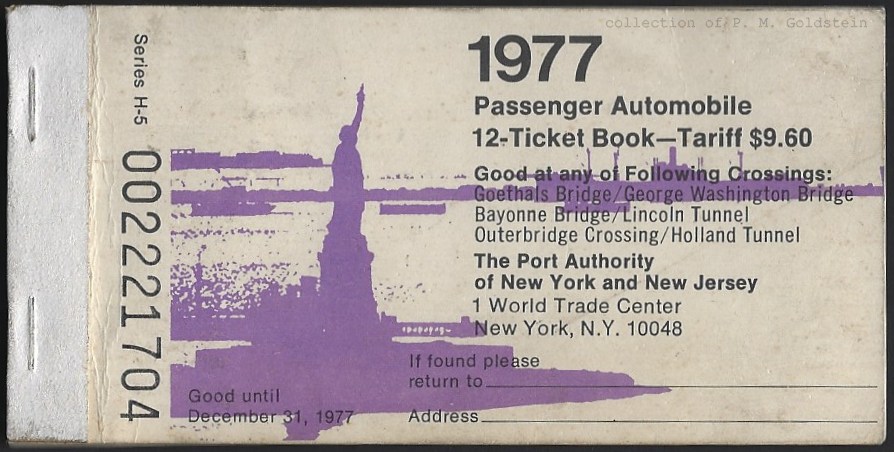 |
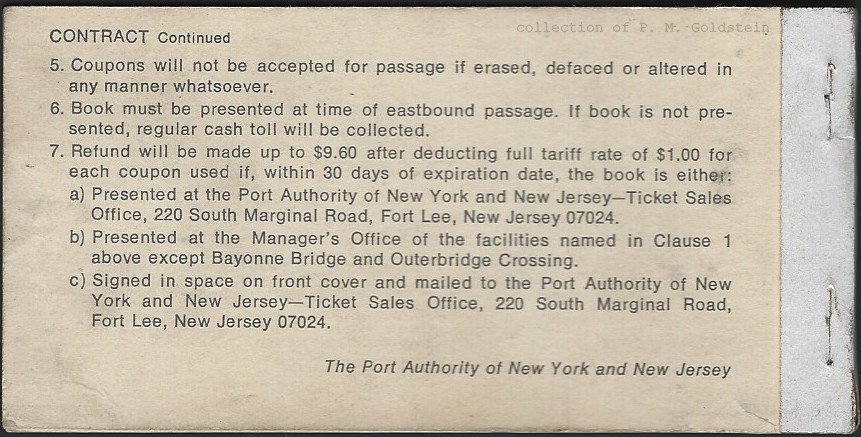 |
PANYNJ First Issue -
Series H-5 - 1977
1 year / 12 ticket / $9.60
large font serial number with 002 serial number prefix
collection of
Philip M. Goldstein
|
printer:
printing
method:
security printing, paper / watermark:
design colors, face:
design
notes, face:
security underprinting, signature field, face:
facsimile
signature:
serial number:
design colors, back:
design notes, back:
security
underprinting, signature field, face:
notes, other:
size: |
Osceola
Graphics
lithographic
none
presumed purple, black text, white (unprinted) Statue of Liberty head
all text sans-serif
purple security underprint "Port Authority of New York and New Jersey"
none
black ink, sans-serif
font with 002
prefix on cover, OCR-A font on tickets ?
purple
unknown
repeating PORT
AUTHORITY OF NEW YORK AND NEW JERSEY" and
Statue of Liberty face
white cloth binding on booklet cover
3 ¾" (width) - 2 ⅛" (height) - 0.005" (thickness) |

PANYNJ "Second Issue" Scrip - ca.
5/1976?
With this design,
the "TS Series" and year and the OCR-A serial number font no longer used.
It is also now seen that the books of scrip tickets are
bound with red padding compound, instead of wire (staple) stitching.
Commutation books remain wire (staple) stitched, covered with adhesive
cloth tape and tickets perforated for tear off.
 |
|
PANYNJ Second Issue -
$1.50
red padding compound
collection of
Philip M. Goldstein
|
.
.
|
|
 |
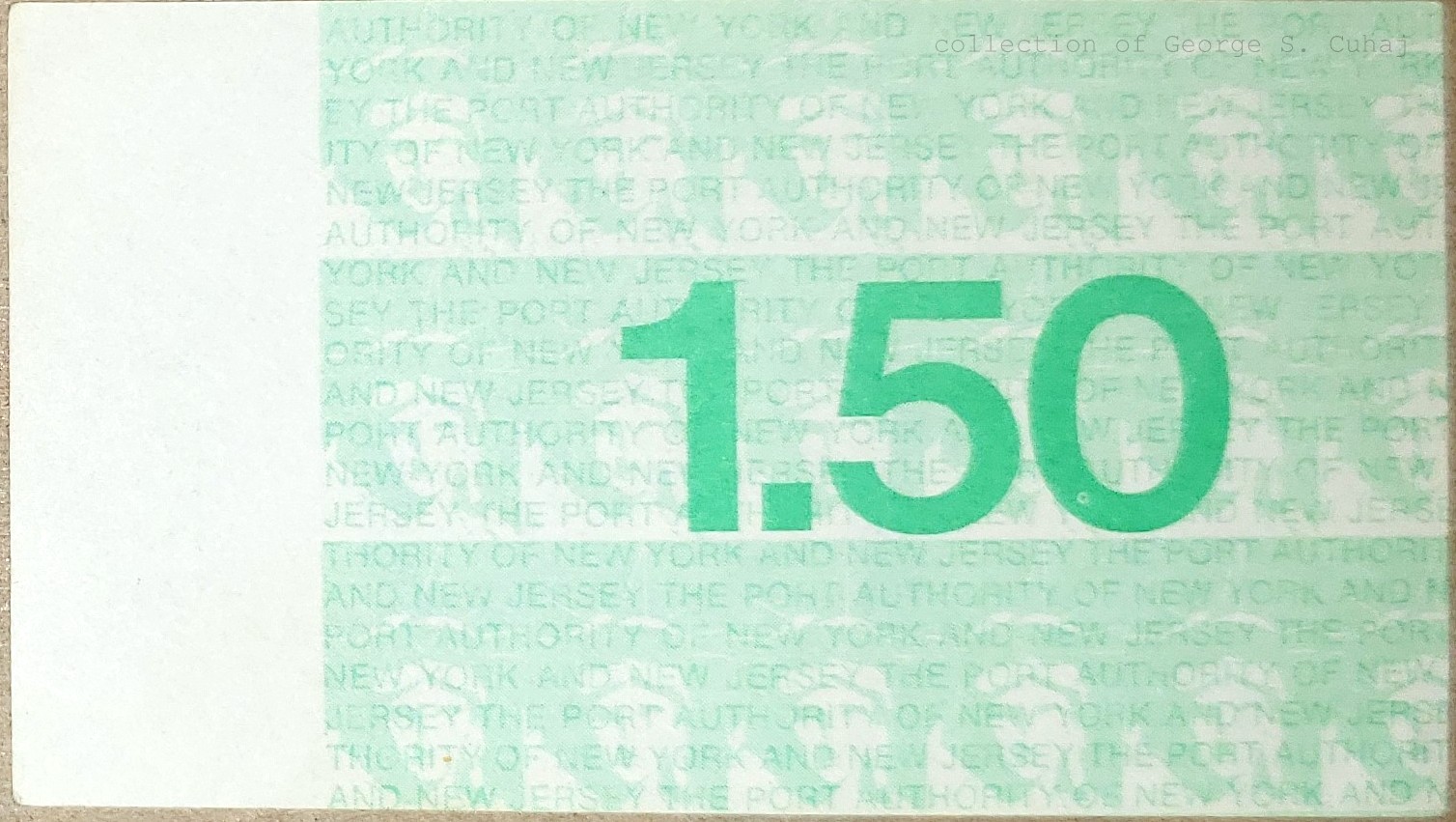 |
PANYNJ Second Issue - $1.50
collection of
Philip M. Goldstein |
facsimile
signature:
printer:
colors, face:
colors, back
serial number:
notes:
security
underprinting, face:
security
underprinting, back:
size: |
none
unknown
lime green, white head
of Statue of Liberty, blue numerals
medium green security underprint with large numerals
black sans-serif in unprinted margin on right
sans-serif denomination numbers on face and back.
repeating PORT AUTHORITY OF NEW
YORK AND NEW JERSEY"
repeating emblem of Statue of Liberty and
"PORT AUTHORITY OF NEW YORK AND NEW JERSEY"
3 ¾" (width) - 2 ⅛" (height) - 0.005"
(thickness) |
 |
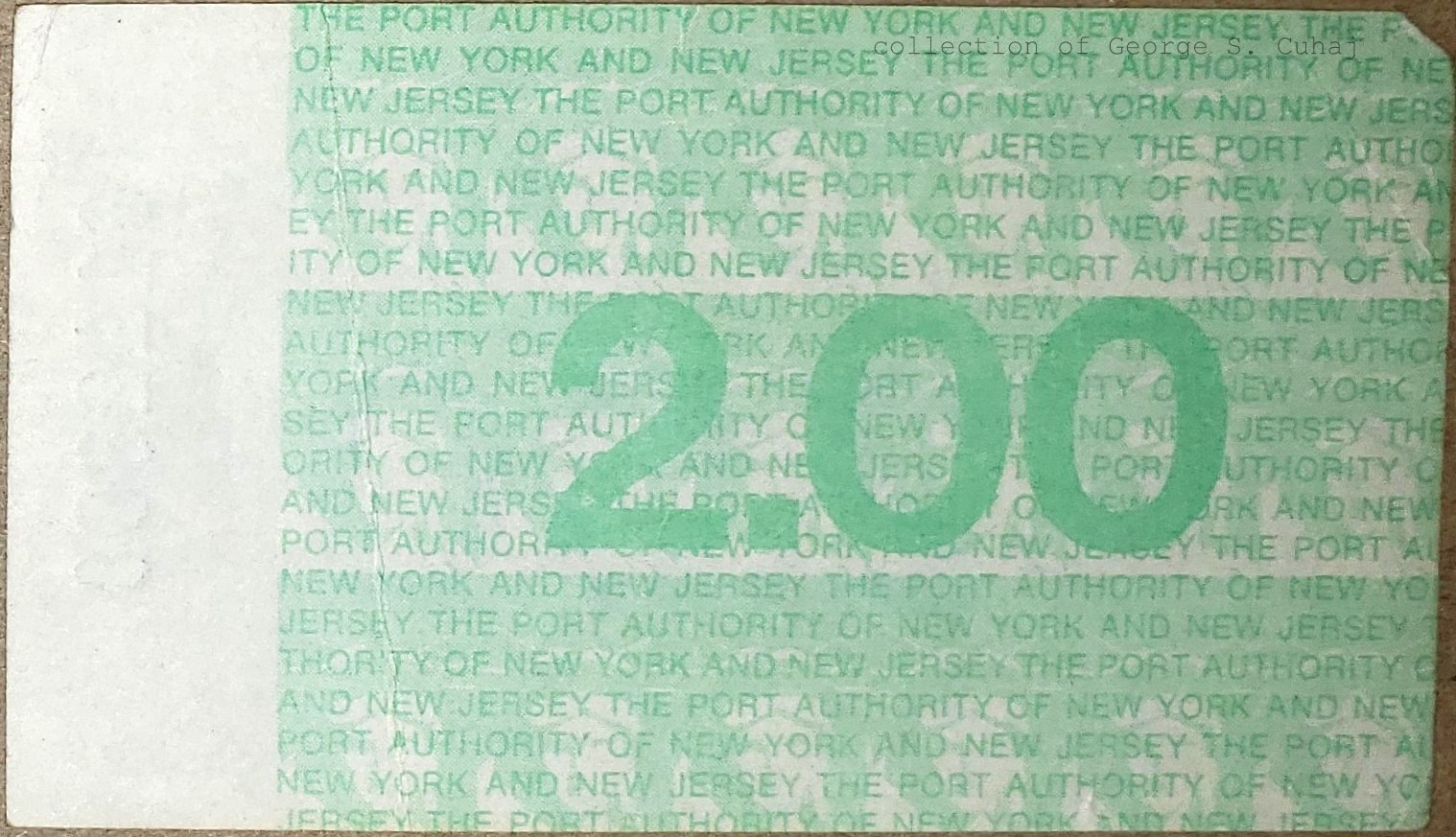 |
PANYNJ Second Issue - $2.00
collection of
Philip M. Goldstein |
facsimile
signature:
printer:
colors face:
colors, back:
serial number:
notes:
.
security
underprinting, face:
security
underprinting, back:
size: |
none
unknown
lime green, white head
of Statue of Liberty, blue numerals
medium green security underprint with large numerals
black sans-serif in unprinted margin on right
sans-serif denomination numbers on face and back.
1 prefix (greater than 10,000,000) out of register
repeating PORT AUTHORITY OF NEW
YORK AND NEW JERSEY" repeating
emblem of Statue of Liberty and
"PORT AUTHORITY OF NEW YORK AND NEW JERSEY"
3 ¾" (width) - 2 ⅛" (height) - 0.005"
(thickness) |
.
.
|
|
 |
 |
|
PANYNJ
Second Issue - $2.00
with overstamp
for Domenico Bus Service
collection
of Philip M. Goldstein
|
facsimile
signature:
printer:
colors, face:
colors, back:
serial number:
notes:
.
security
underprinting, face:
security
underprinting, back:
size: |
none
unknown
lime green, white head
of Statue of Liberty, blue numerals
medium green security underprint with large numerals
black sans-serif in unprinted margin on right
sans-serif denomination numbers on face and back.
1 prefix, overstamp for Domenico Bus Service
repeating PORT AUTHORITY OF NEW
YORK AND NEW JERSEY" repeating
emblem of Statue of Liberty and
"PORT AUTHORITY OF NEW YORK AND NEW JERSEY"
3 ¾" (width) - 2 ⅛" (height) - 0.005"
(thickness) |
.
. |
|
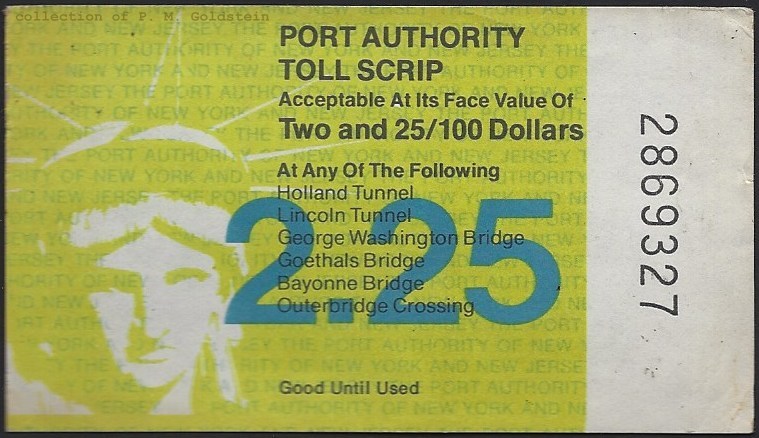 |
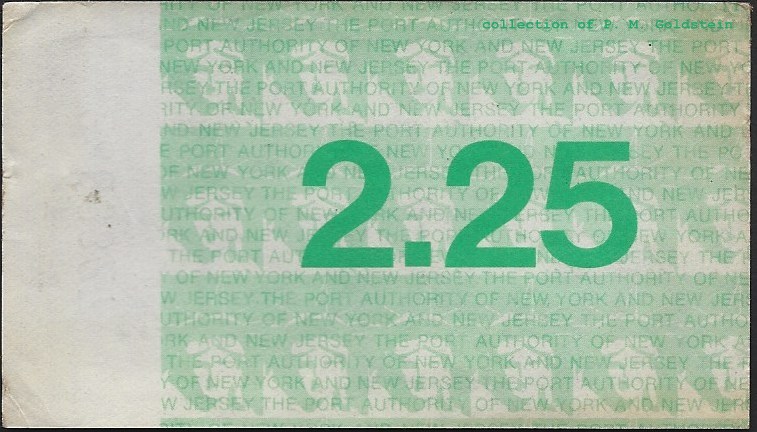 |
PANYNJ Second Issue - $2.25
collection of
Philip M. Goldstein |
facsimile
signature:
printer:
colors, face:
colors, back:
notes:
.
security
underprinting, face:
security
underprinting, back:
size: |
none
unknown
lime green, white head
of Statue of Liberty, blue numerals
medium green security underprint with large numerals
black sans-serif in unprinted margin on right
sans-serif denomination numbers on face and back.
repeating PORT AUTHORITY OF NEW
YORK AND NEW JERSEY"
repeating emblem of Statue of Liberty and
"PORT AUTHORITY OF NEW YORK AND NEW JERSEY"
3 ¾" (width) - 2 ⅛" (height) - 0.005"
(thickness) |
.
.
|
|
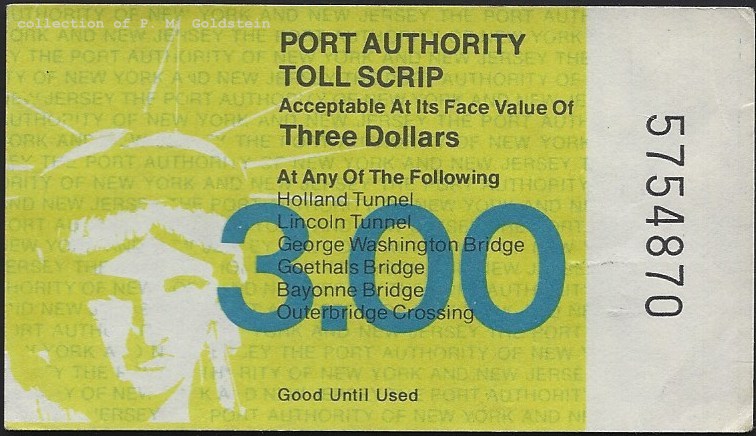 |
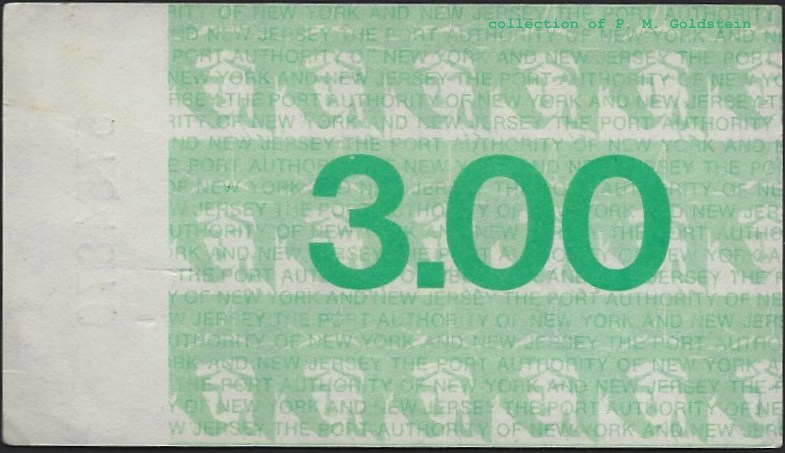 |
PANYNJ Second Issue - $3.00
collection of
Philip M. Goldstein |
facsimile
signature:
printer:
colors, face:
colors, back:
serial number:
notes:
security underprinting,
face:
security underprinting, back:
.
size: |
none
unknown
lime green, white head
of Statue of Liberty, blue numerals
medium green security underprint with large numerals
black sans-serif in unprinted margin on right
sans-serif denomination numbers on face and back.
repeating PORT AUTHORITY OF NEW
YORK AND NEW JERSEY"
repeating emblem of Statue of Liberty and
"PORT AUTHORITY OF NEW YORK AND NEW JERSEY"
3 ¾" (width) - 2 ⅛" (height) - 0.005"
(thickness) |
.
. |
|
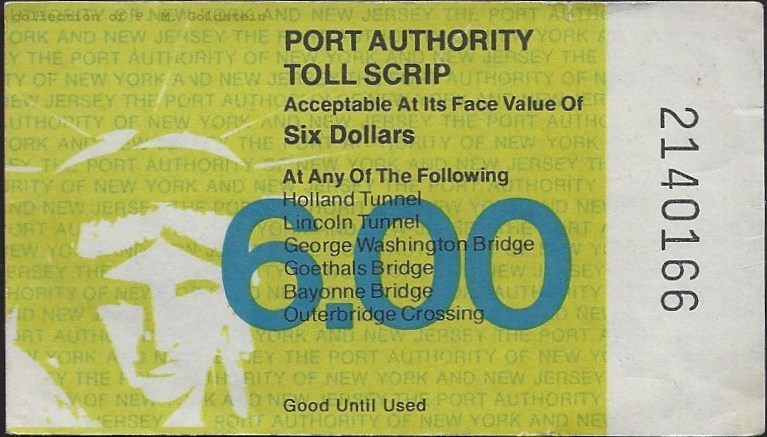 |
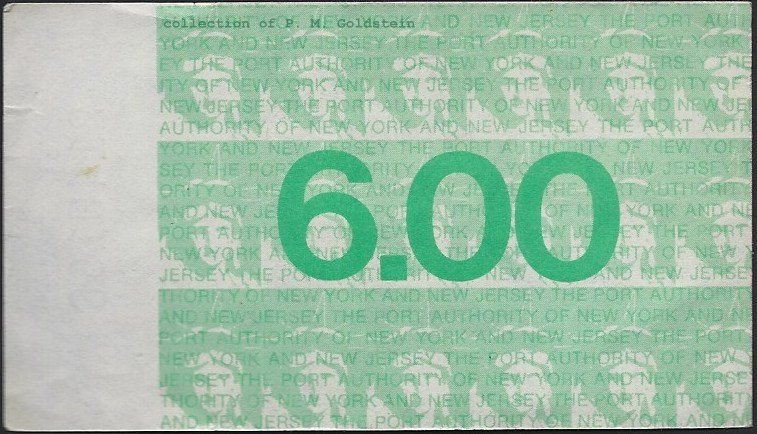 |
PANYNJ Second Issue - $6.00
collection of
Philip M. Goldstein |
facsimile
signature:
printer:
colors, face:
colors, back:
serial number:
notes:
security
underprinting, face:
security
underprinting, back:
size: |
none
unknown
lime green, white head
of Statue of Liberty, blue numerals
medium green security underprint with large numerals
black sans-serif in unprinted
margin on right
sans-serif denomination numbers on face and back.
repeating PORT AUTHORITY OF NEW
YORK AND NEW JERSEY" repeating emblem of
Statue of Liberty and
"PORT AUTHORITY OF NEW YORK AND NEW JERSEY"
3 ¾" (width) - 2 ⅛" (height) - 0.005"
(thickness) |
.
. |
|
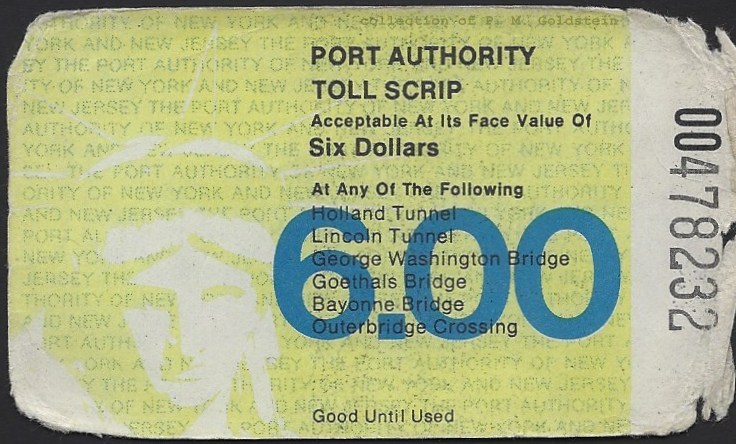
|
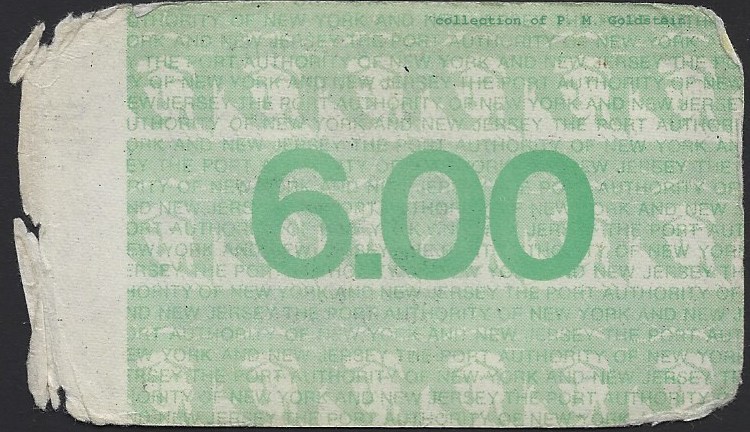 |
PANYNJ Second Issue - $6.00
with 00 serial number prefix
collection of
Philip M. Goldstein |
facsimile
signature:
printer:
colors, face:
colors, back:
serial number:
notes:
security
underprinting, face:
security
underprinting, back:
size: |
none
unknown
lime green, white head
of Statue of Liberty, blue numerals
medium green security underprint with large numerals
00 prefix (preprinted?) - unusual
font for serial number
black ink sans-serif font in unprinted margin on
right
sans-serif denomination numbers on face and back.
repeating PORT AUTHORITY OF NEW
YORK AND NEW JERSEY" repeating emblem of
Statue of Liberty and
"PORT AUTHORITY OF NEW YORK AND NEW JERSEY"
3 ¾" (width) - 2 ⅛" (height) - 0.005"
(thickness) |
PANYNJ
"Second Issue" - Commutation Tickets & Books
As with the earlier commutation books, these were books of
tickets with no denomination; but were only valid for a limited amount
of time, whereas the denominational scrip issues were good until used.
H-4 books were valid for 30 days, and contained 20
tickets. H-5 Books were good for a year, but only contained 12 tickets.
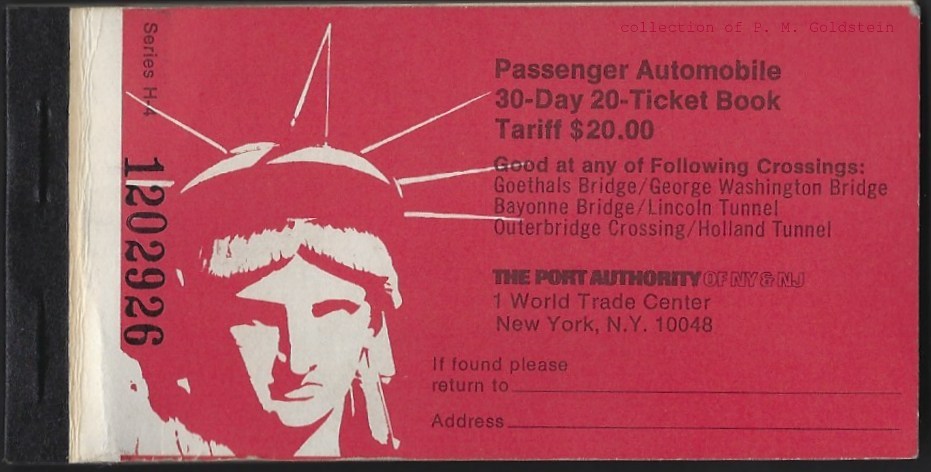 |
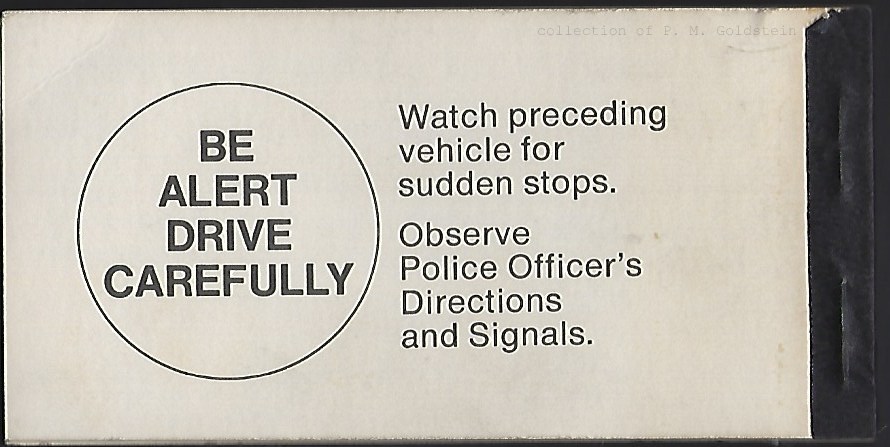 |
PANYNJ Second Issue -
Series H-4 - February 1977
30 day / 20 ticket / $20.00
roman font serial number
collection of
Philip M. Goldstein |
facsimile
signature:
printer:
colors, face:
colors, back:
serial number:
notes:
security
underprinting, face:
security
underprinting, back:
size: |
none
Rand McNally
red, white head of Statue of Liberty
red
black ink, sans serif on coupons, roman font on
cover, in red body
repeating PORT AUTHORITY OF NEW
YORK AND NEW JERSEY" on face repeating
emblem of Statue of Liberty and
"PORT AUTHORITY OF NEW YORK AND NEW JERSEY" on back
3 ¾" (width) - 2 ⅛" (height) - 0.005"
(thickness) |
.
. |
|
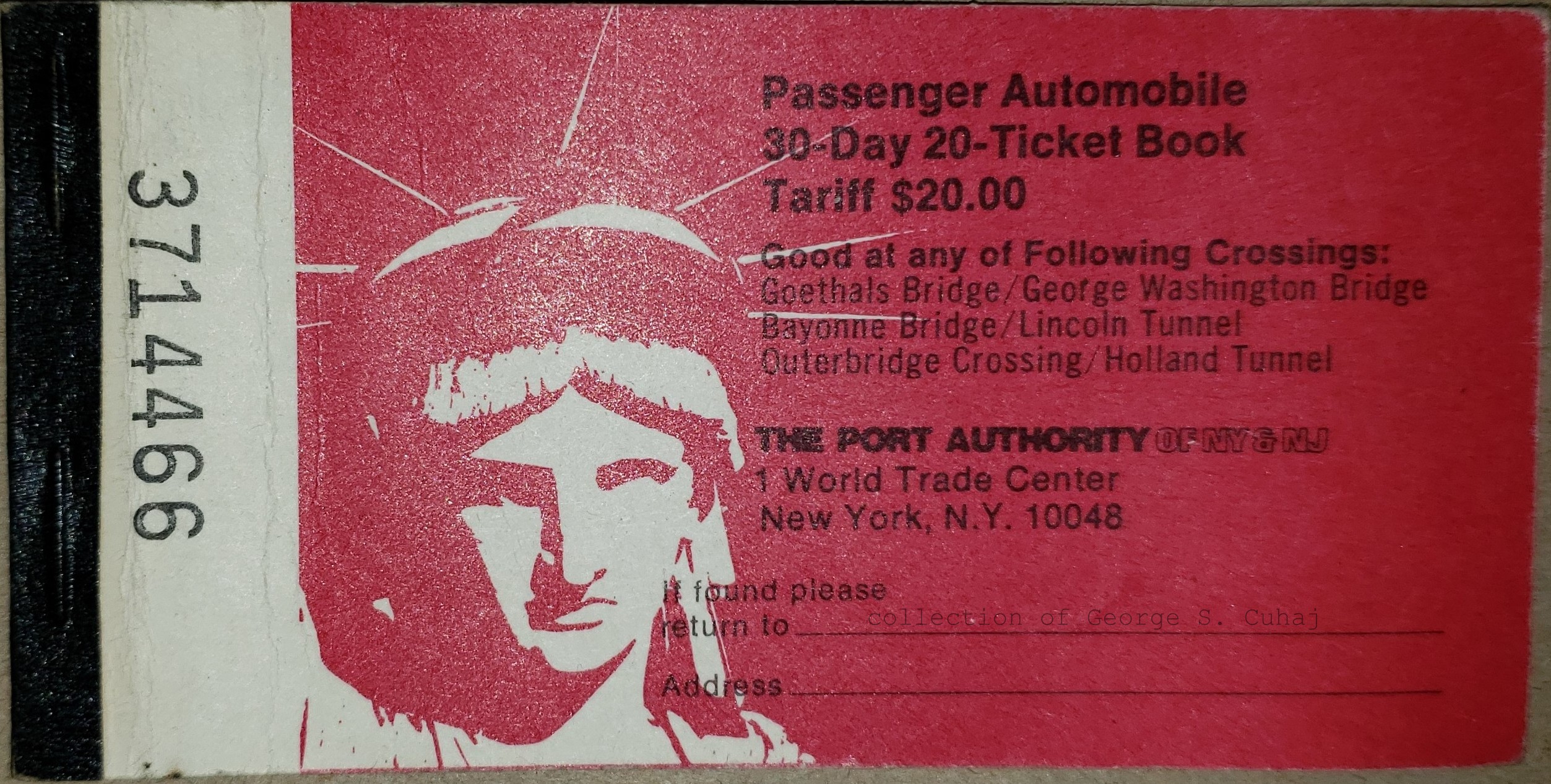 |
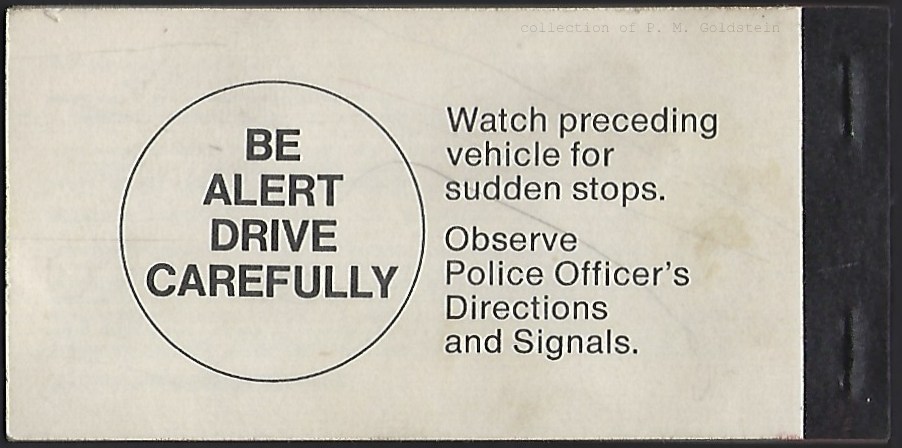 |
|
|
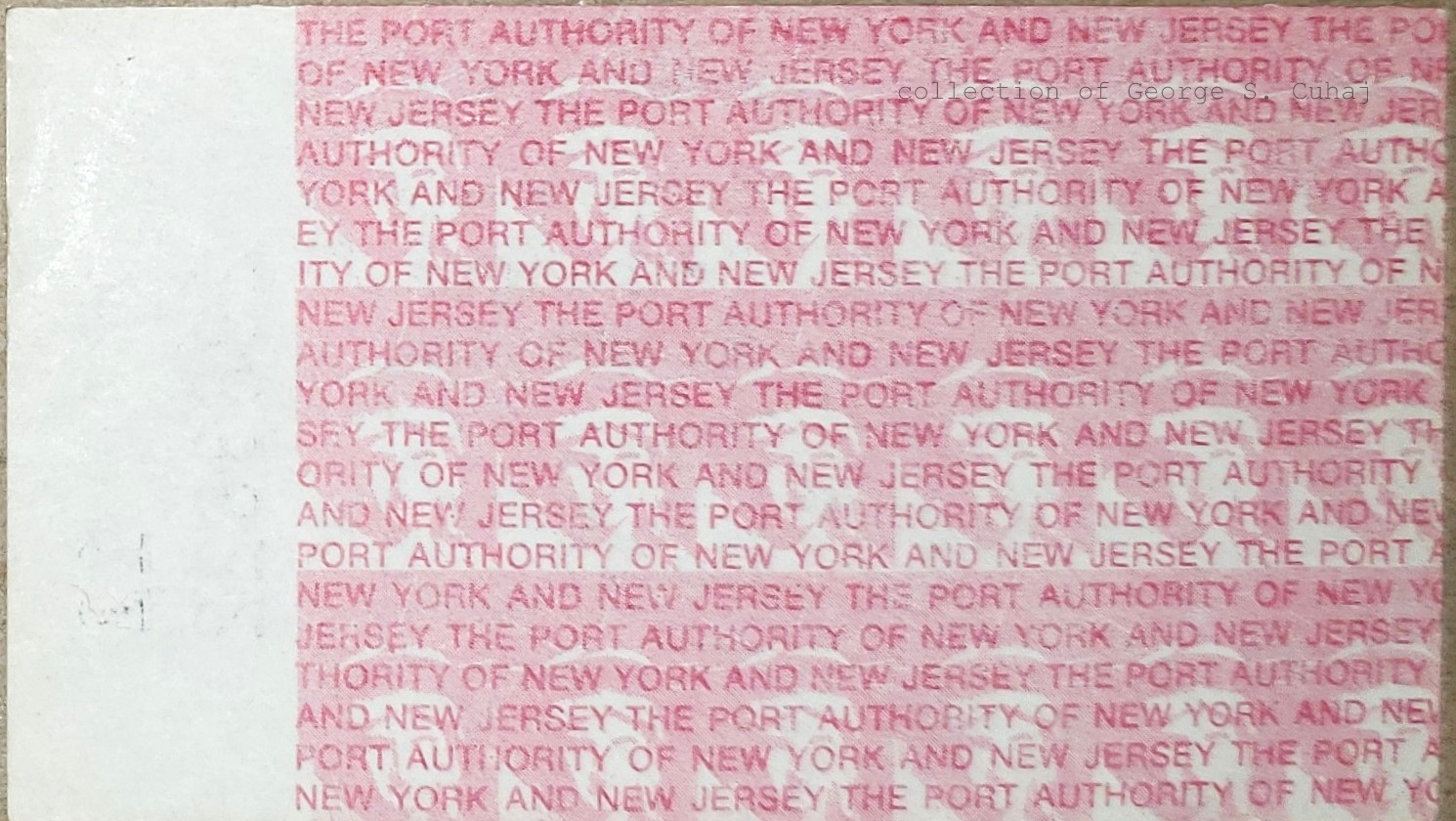 |
 |
PANYNJ Second Issue -
Series H-4 - October 1979
30 day / 20 ticket / $20.00
sans-serif font serial number
collection
of George S. Cuhaj |
facsimile
signature:
printer:
colors, face:
colors, back:
serial number:
.
notes:
security
underprinting, face:
security
underprinting, back:
size: |
none
Rand McNally, Southern Coupon, Osceola Graphics;
others?
red, white head of Statue of Liberty
red
black ink, sans-serif on cover in white area,
sans-serif font, ticket number over serial number
repeating PORT AUTHORITY OF NEW YORK
AND NEW JERSEY" on face repeating emblem of
Statue of Liberty and
"PORT AUTHORITY OF NEW YORK AND NEW JERSEY" on back
3 ¾" (width) - 2 ⅛" (height) - 0.005"
(thickness) |
.
. |
|
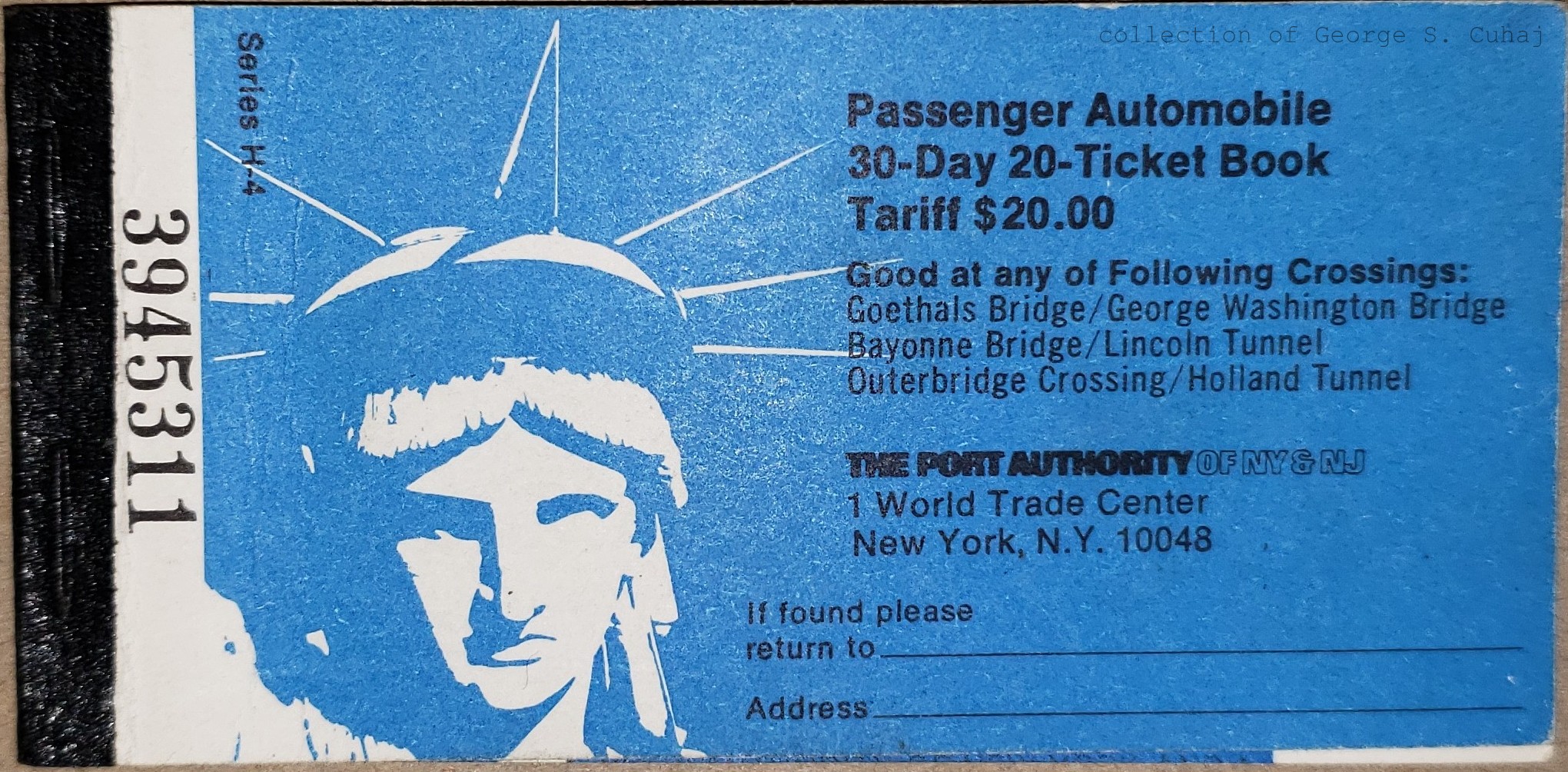 |
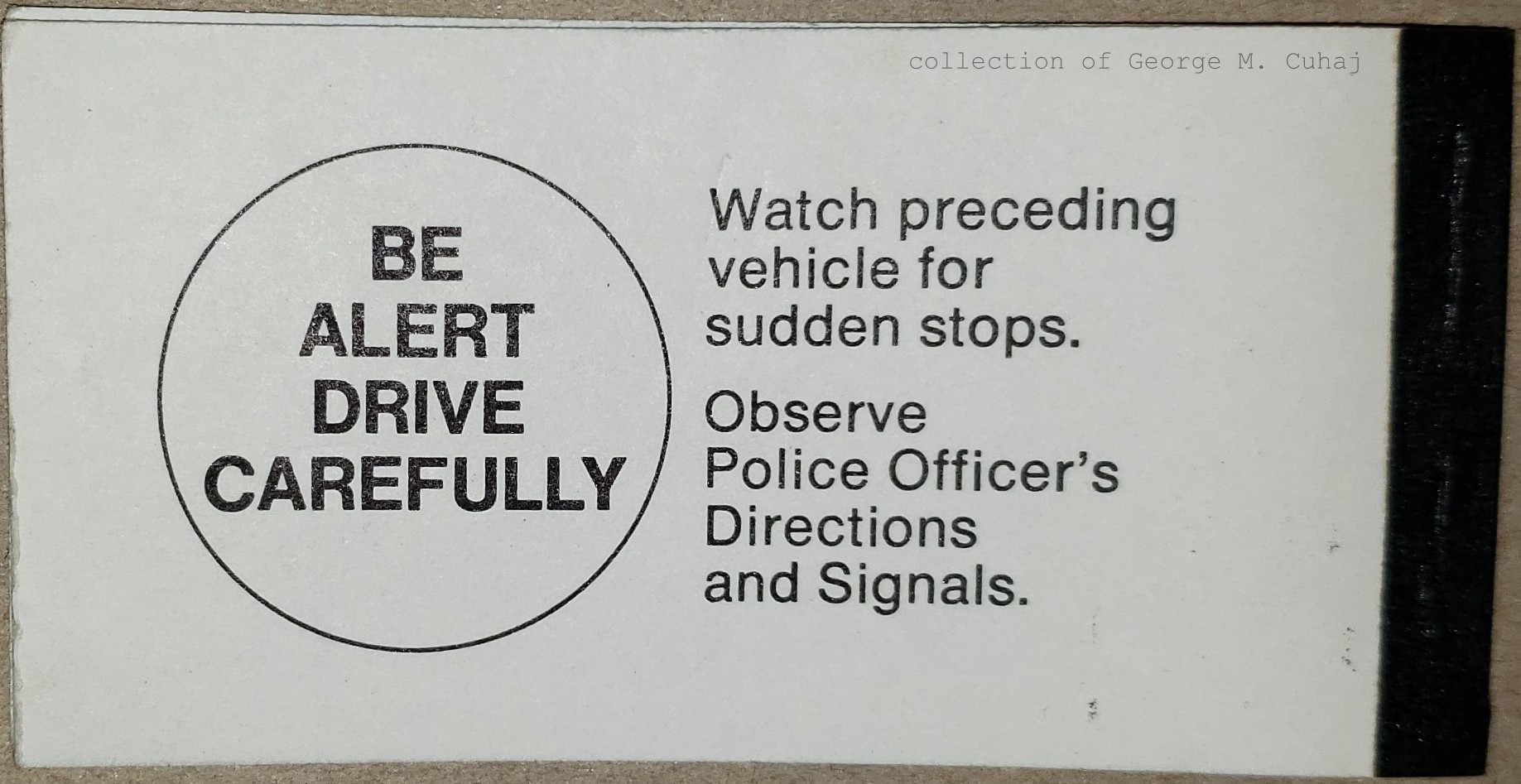 |
 |
 |
PANYNJ Second Issue -
Series H-4 - March 29 / April 29, 1980
30 day / 20 ticket / $20.00
roman font serial number on book cover, sans-serif serial number on tickets
This issue raises at least one question. With the serial number font on
cover of the book different from the serial number font on tickets,
were these two separately contracted printing firms?
collection of
Philip M. Goldstein |
facsimile signature:
printer:
colors, face:
colors, back:
serial number:
notes:
security
underprinting, face:
security
underprinting, back:
size: |
none
Rand McNally
blue, white head of Statue of Liberty
blue
black ink, roman font on cover, sans-serif
font on tickets, ticket number over serial number
three rule address line
repeating PORT AUTHORITY OF NEW YORK
AND NEW JERSEY"
repeating emblem of Statue of Liberty and
"PORT AUTHORITY OF NEW YORK AND NEW JERSEY"
3 ¾" (width) - 2 ⅛" (height) - 0.005"
(thickness) |
| . |
|
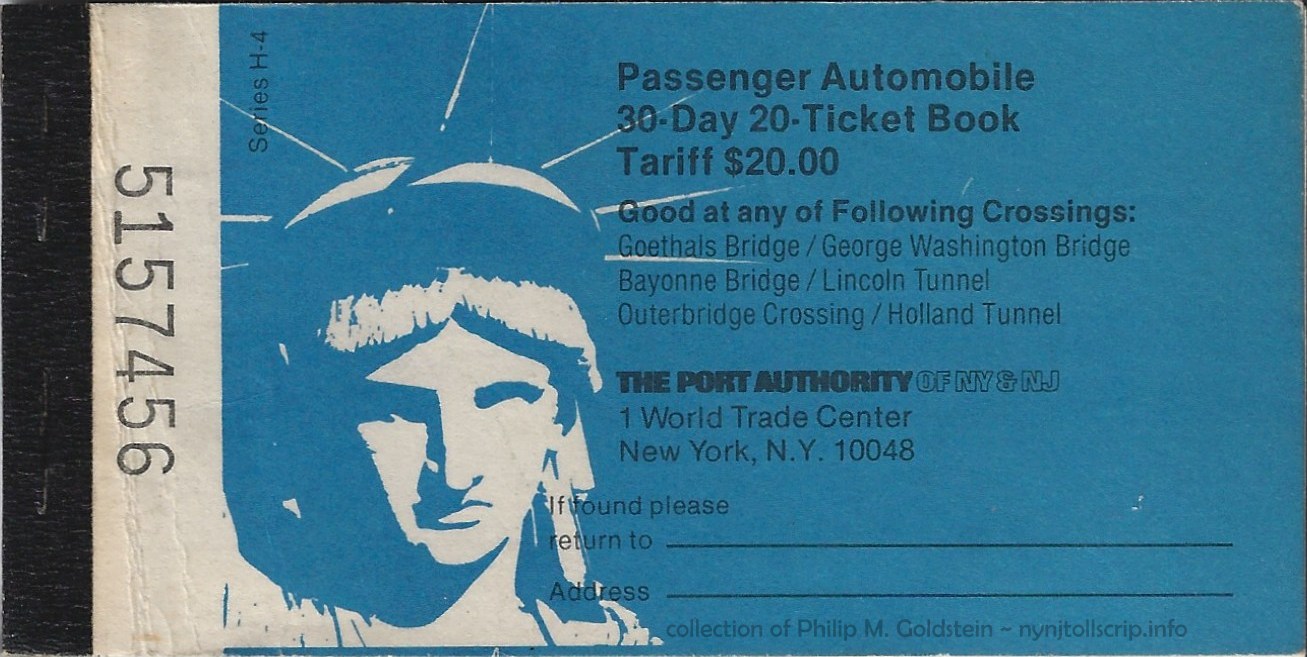 |
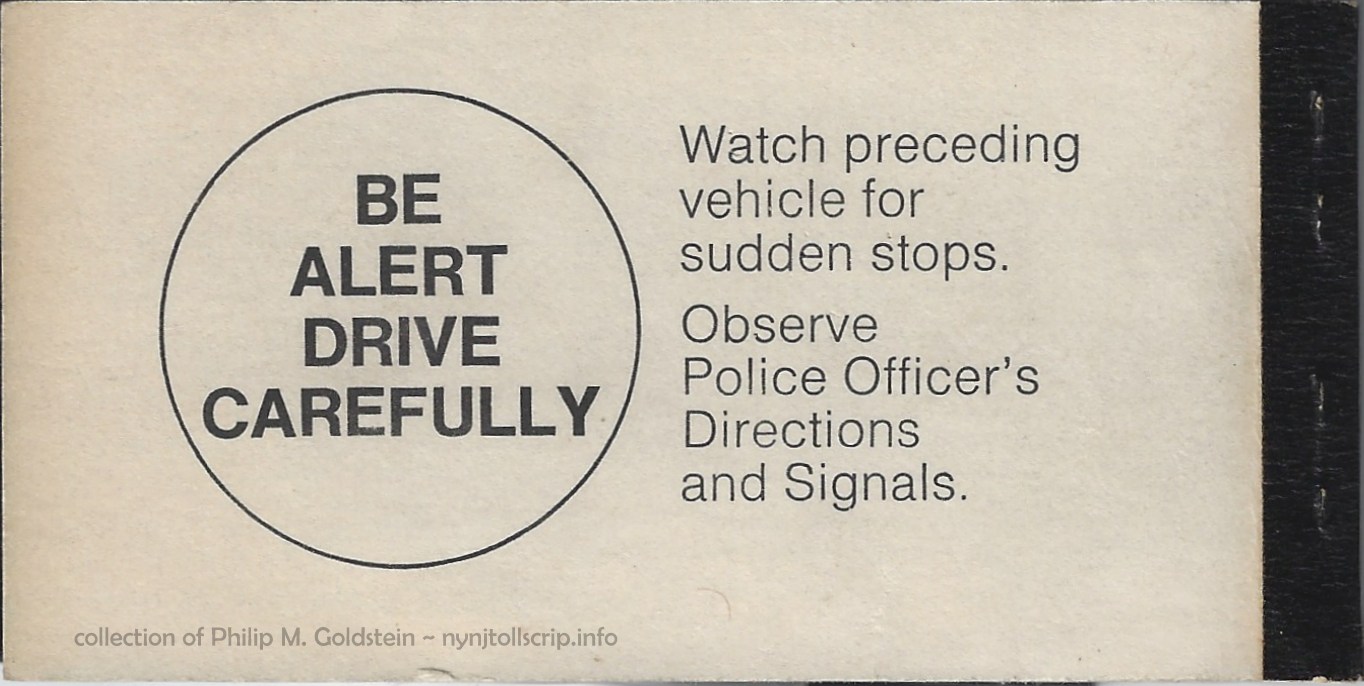 |
PANYNJ Second Issue -
Series H-4 - October 18, 1981
30 day / 20 ticket / $20.00
gothic font serial number on book cover - Series H-4 faces right (away from binding)
collection of
Philip M. Goldstein |
facsimile signature:
printer:
ticket colors, face:
ticket colors, back:
cover color, face:
cover color, back
serial number:
notes:
security
underprinting, face:
security
underprinting, back:
size: |
none
Southern Coupon
blue, white head of Statue of Liberty
unknown
blue, white head of Statue of Liberty
white
black ink, gothic font on cover
Series H4 faces right (away from binding)
repeating PORT AUTHORITY OF NEW YORK
AND NEW JERSEY"
repeating emblem of Statue of Liberty and
"PORT AUTHORITY OF NEW YORK AND NEW JERSEY"
3 ¾" (width) - 2 ⅛" (height) - 0.005"
(thickness) |
| . |
|
 |
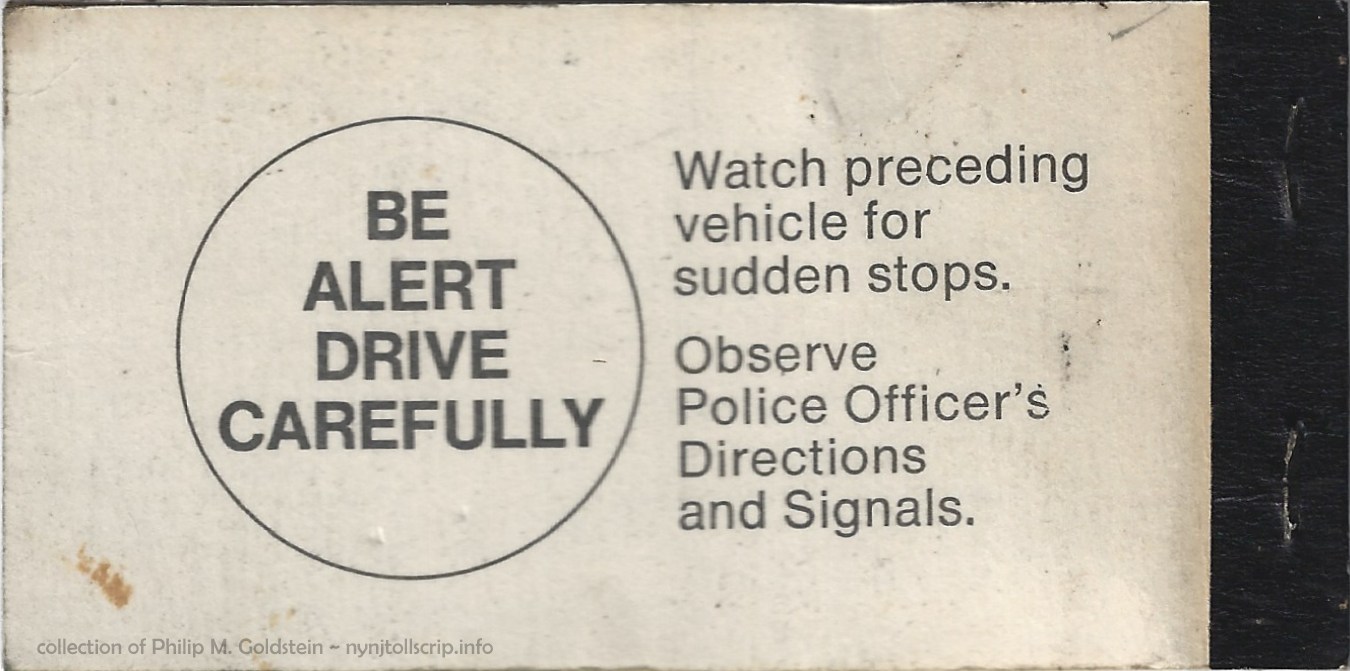 |
PANYNJ Second Issue -
Series H-4 - 1985-1986
30 day / 20 ticket / $20.00
gothic font serial number on book cover, Series H-4 faces left (towards binding)
collection of
Philip M. Goldstein |
facsimile signature:
printer:
ticket colors, face:
ticket colors, back:
cover color, face:
cover color, back
serial number:
notes:
security
underprinting, face:
security
underprinting, back:
size: |
none
Southern Coupon
blue, white head of Statue of Liberty
unknown
blue, white head of Statue of Liberty
white
black ink, gothic font on cover
Series H4 faces left (towards binding)
repeating PORT AUTHORITY OF NEW YORK
AND NEW JERSEY"
repeating emblem of Statue of Liberty and
"PORT AUTHORITY OF NEW YORK AND NEW JERSEY"
3 ¾" (width) - 2 ⅛" (height) - 0.005"
(thickness) |
PANYNJ "Second Issue" -
Carpool Commutation Books
As learned from a Federal Highway Administration report on
"Valuation of Priority Treatment for High Occupancy Vehicles, Final
Report - January 1981", the Carpool Ticket book was introduced in 1975;
the following is now known.
|
TOLL
PRICING
New York City, NY
Project Description:
Reduced
tolls for 3+ carpools during peak periods were instituted on
six river crossings from New Jersey to New York. The carpool tolls
were introduced in April 1975 at the same time tolls were increased for
other modes. The carpool rate is half the rate of a standard commuter
ticket.
Project Location:
The
six (6) river crossings are the Outerbridge Crossing, Goethals Bridge,
Bayonne Bridge, George Washington Bridge, and the Lincoln and Holland
Tunnels.
Project Characteristics:
On
April 10, 1975, the toll schedule
for the NY-NJ river crossings was increased by 50 percent for all
classes of vehicles except buses. At the same time, an existing 50
percent commuter discount ticket and a 20 percent two-year discount
ticket were abolished. A special weekday transferable carpool ticket
was made available for 3+ carpools. This carpool ticket, good for six
months, represented a 66 2/3 percent discount over the new cash fare
and equivalent to the price of a commuter ticket before the toll increase.
On
April 21, 1975, the twenty trip, thirty-day commuter discount ticket
was reinstated, except at a 33 1/3 percent discount level rather than
at the previous 50 percent level. This toll schedule
took effect on May 5, 1975, and is summarized as follows:
|
Prior
to 5/5/75 |
Effective
5/5/75 |
| Automobile:
cash price |
$1.00 |
$1.50 |
| Thirty
day Commuter Ticket |
.50 |
$1.00 |
| Two-Year
Ticket |
.80 |
n/a |
| Carpool
Ticket |
n/a |
.50 |
| Bus:
|
$2.00 |
$2.00 |
| Trucks: |
$1.00-$4.00 |
$1.50-$6.00 |
Project
Impacts:
Carpool ticket use increased from 400 during the first
week of the project to almost 4000 one month later as existing
commuters and carpools became familiar with the new ticket. This
represents approximately 2 percent of all peak period vehicular
crossings and 5 percent of all person crossings.
However, the carpool discount had a minimal effect on the actual
formation of new 3+ carpools. Negligible changes in vehicular
occupancies supports this finding. An examination of commuter travel
modes in the NYC
area helps to explain this situation. Of the total morning peak period
travelers (195,000 total crossing the river), 65 percent use mass
transit, and over 90 percent of these trips are destined to the Central
Business District. On the other hand, less than 40 percent of total
peak period automobile trips are destined to the Central Business
District. Thus, about 85 percent of the trans-Hudson person trips to
the Central Business District in the peak period are by transit and
only 15 percent by auto. For Central Business District work trips-only
the auto percentage is even lower. This must be placed into the
perspective that the average one-way trans-Hudson auto commuter trip is
over 30 miles.
|
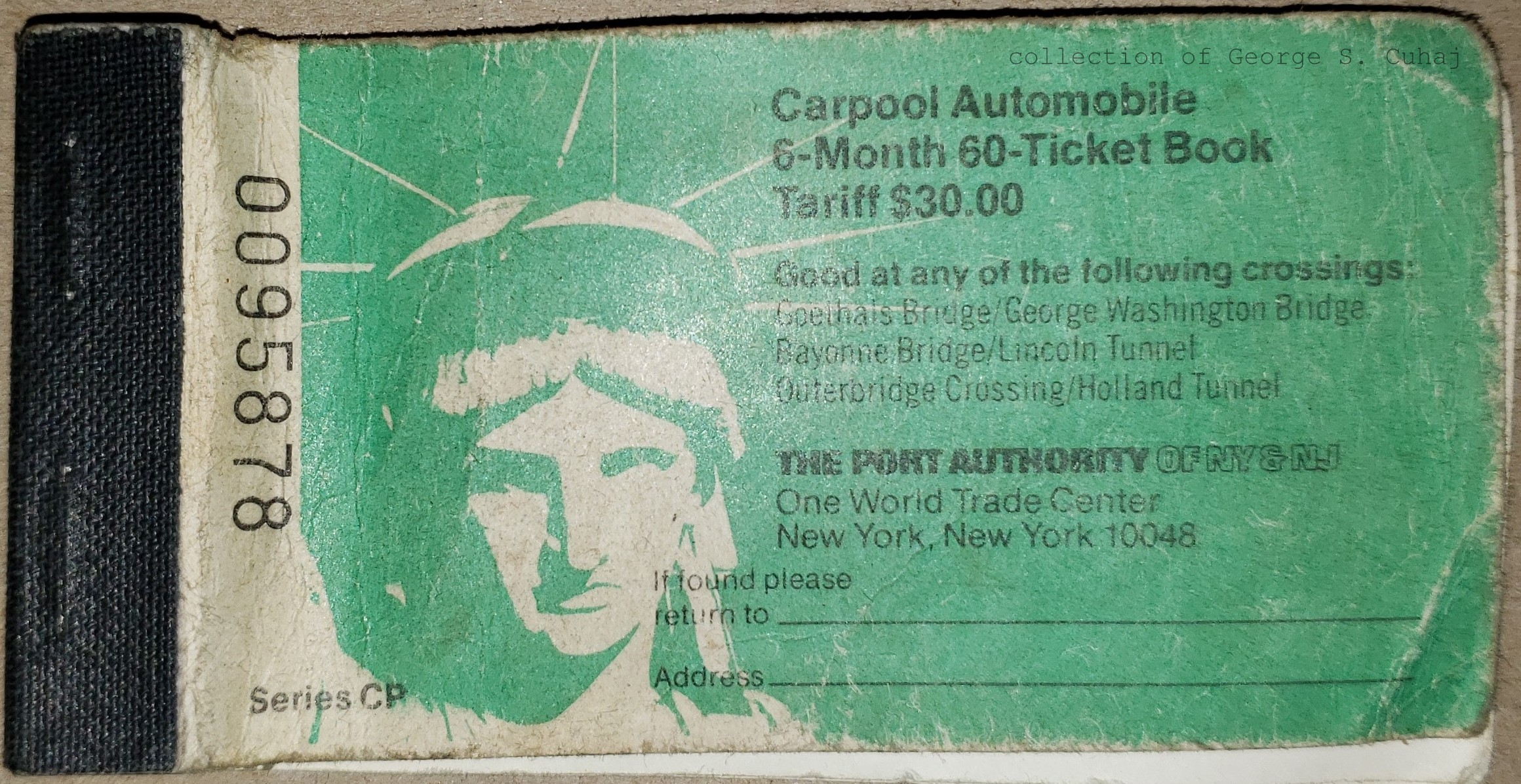 |
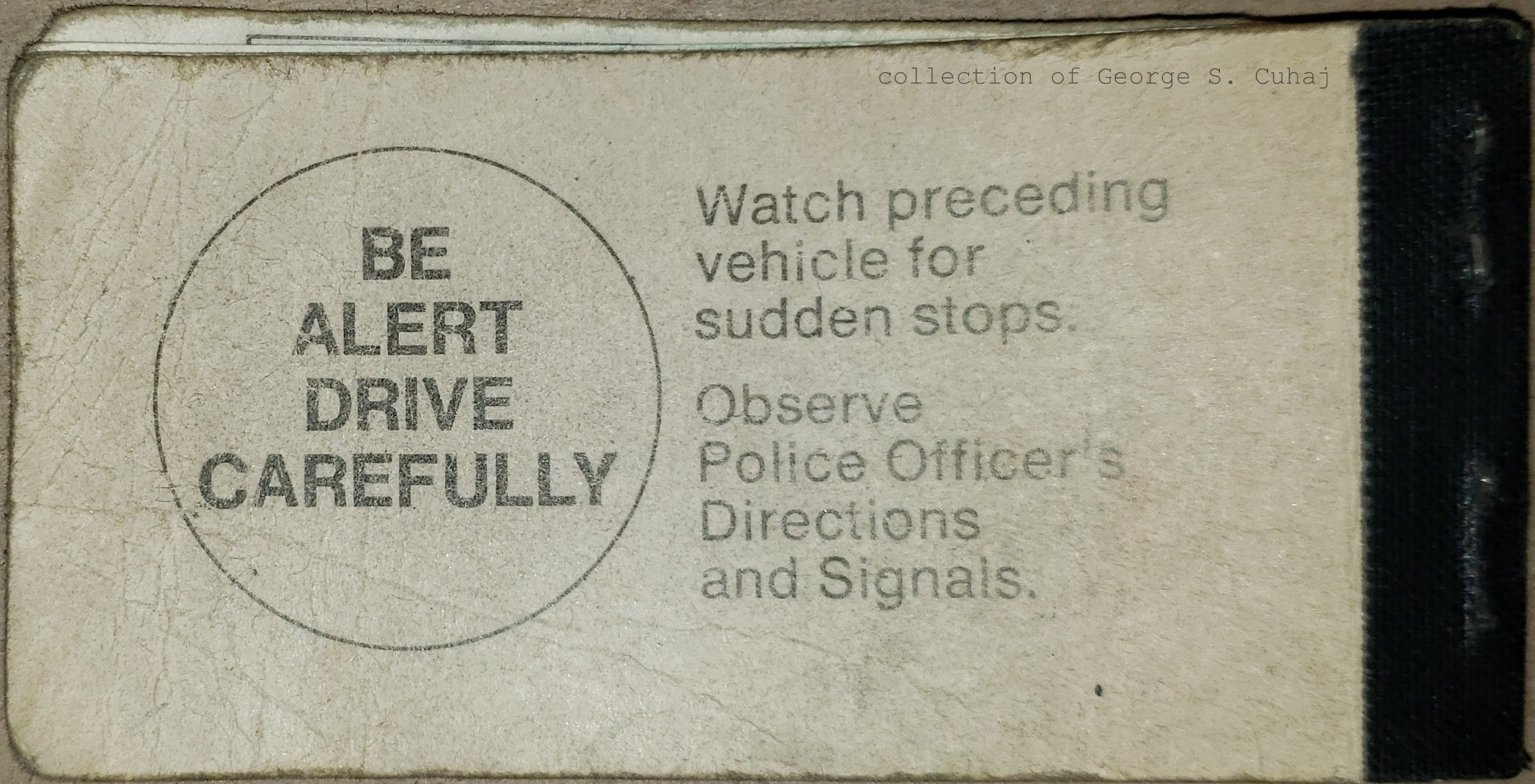 |
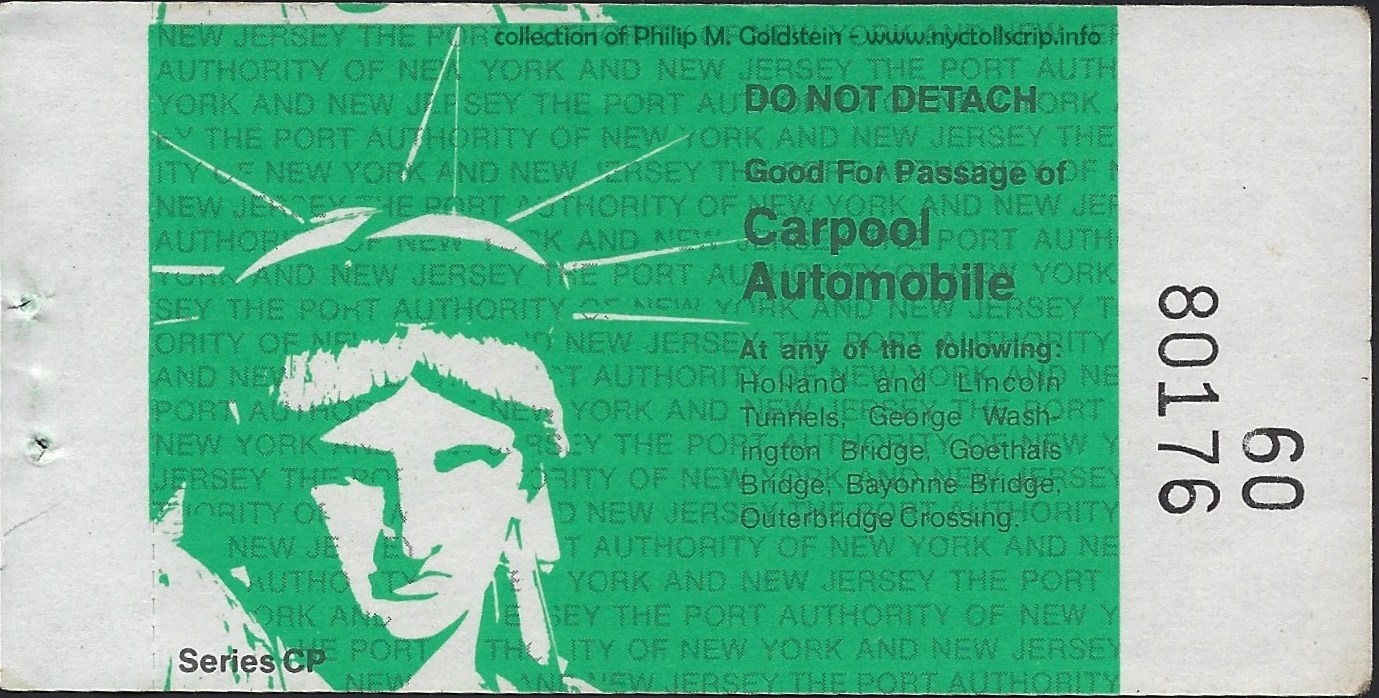 |
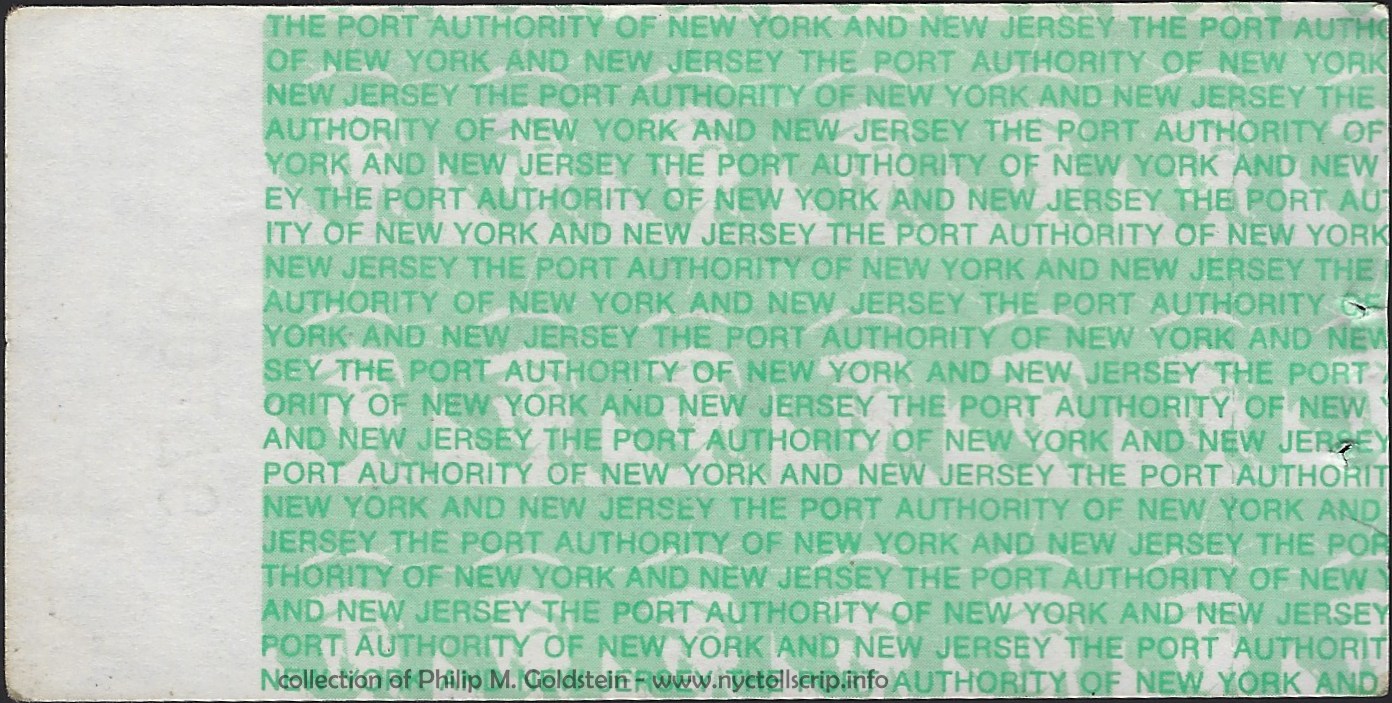 |
 |
 |
PANYNJ Second
Issue - Series CP - Carpool Automobile - June / December 1980
6 month / 60 ticket /
$30
collection
of Philip M. Goldstein |
facsimile signature:
printer:
colors, face:
colors, back:
serial number:
notes:
security
underprinting, face:
security underprinting, back:
size: |
none
Southern Coupon, Birmingham, AL, and other books unmarked
green, white head of Statue of Liberty
green
black sans-serif font; ticket number over serial number
repeating PORT AUTHORITY
OF NEW YORK AND NEW JERSEY"
repeating emblem of Statue of Liberty and
"PORT AUTHORITY OF NEW YORK AND NEW JERSEY"
3 ¾" (width) - 2 ⅛" (height) - (thickness unknown) |
| PANYNJ
"Second Issue" - Employees Personal Passes |
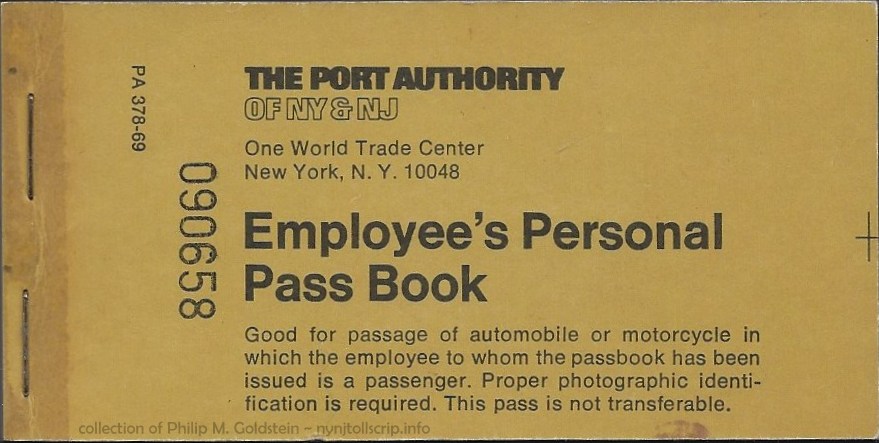 |
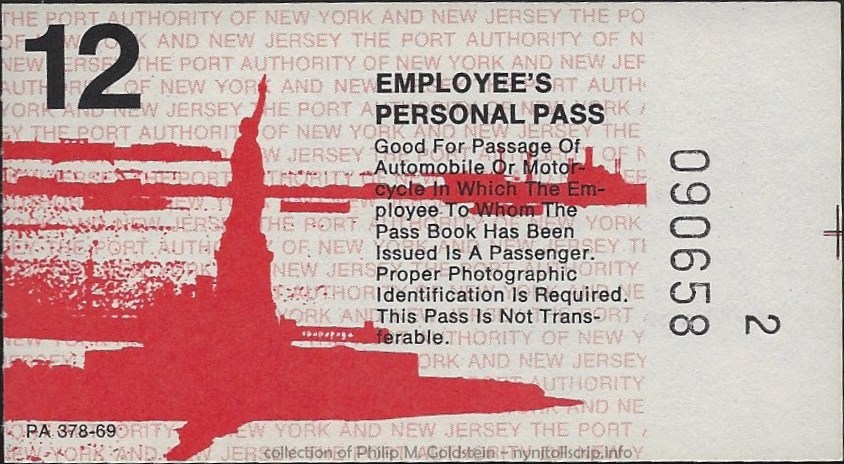 |
 |
PANYNJ Second Issue -
Employee's Personal Pass (unknown year - post 1972) - Variety 1 (black 12)
collection of
Philip M. Goldstein |
facsimile
signature:
printer:
colors:
serial number:
notes:
security
underprinting, face:
security
underprinting, back:
.
size:
PA form: |
none
unknown
face: red silhouette view of
Liberty Island and NY harbor,
12 in black, text in black
back: gold security underprinting
black ink sans-serif font, ticket number over serial
number in unprinted margin on right
black sans-serif number "12" in upper left corner of
face.
repeating PORT AUTHORITY OF NEW
YORK AND NEW JERSEY"
repeating Statue of Liberty and PORT
AUTHORITY OF NEW YORK AND NEW JERSEY"
3 ¾" (width) - 2 ⅛" (height) - 0.005"
(thickness)
378-69 |
.
.
|
|
 |
 |
PANYNJ Second Issue -
Employee's Personal Pass (unknown year - post 1972) - Variety 2 (red 12)
collection of
Philip M. Goldstein |
facsimile
signature:
printer:
colors:
serial number:
notes:
security
underprinting, face:
security
underprinting, back:
.
size:
PA form: |
none
unknown
face: red silhouette view of
Liberty Island and NY harbor,
12 in red, text in black
back: gold security underprinting
black ink sans-serif font, ticket number over serial
number in unprinted margin on right
red sans-serif number "12" in upper left corner of
face.
repeating PORT AUTHORITY OF NEW
YORK AND NEW JERSEY"
repeating Statue of Liberty and PORT
AUTHORITY OF NEW YORK AND NEW JERSEY"
3 ¾" (width) - 2 ⅛" (height) - 0.005"
(thickness)
378-69 |
.
. |
|
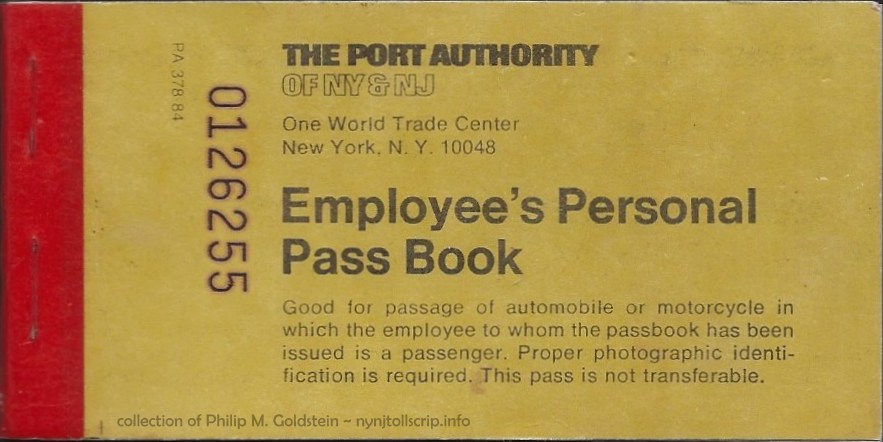 |
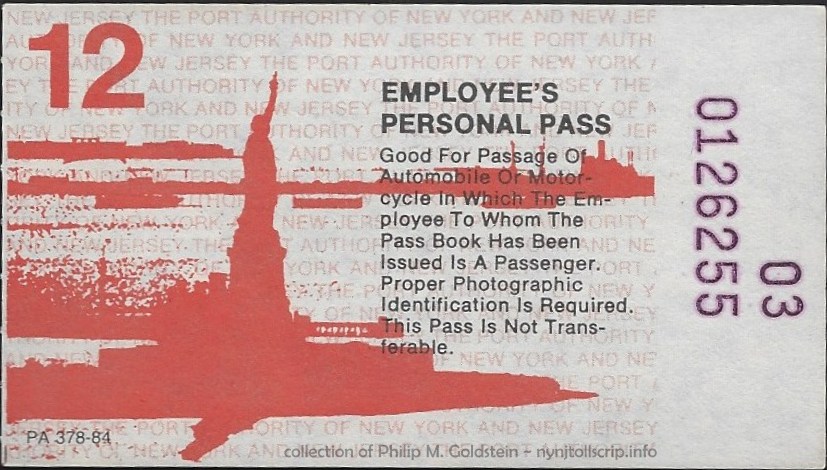 |
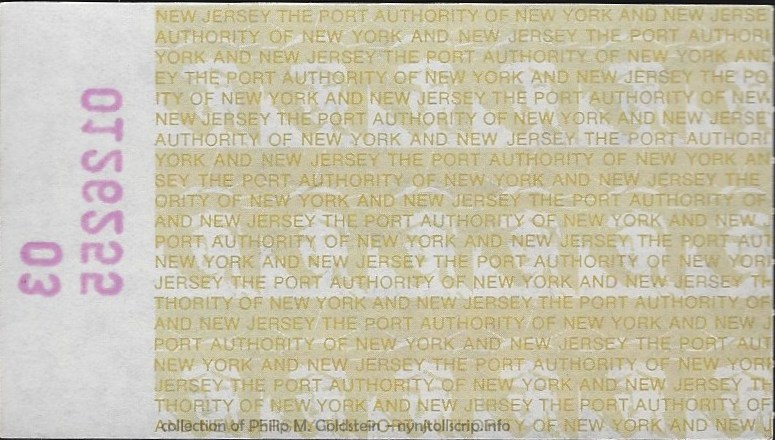 |
PANYNJ Third(?) Issue -
Employee's Personal Pass (1984) - Variety 2 (red 12)
collection of
Philip M. Goldstein |
facsimile
signature:
printer:
colors:
serial number:
notes:
security
underprinting, face:
security
underprinting, back:
.
size:
PA form: |
none
unknown
face: red silhouette view of
Liberty Island and NY harbor, 12 in black, text in black
back: gold security underprinting
black ink sans-serif font, ticket number over serial
number in unprinted margin on right
red sans-serif number "12" in upper left corner of
face.
repeating PORT AUTHORITY OF NEW
YORK AND NEW JERSEY"
repeating Statue of Liberty and PORT
AUTHORITY OF NEW YORK AND NEW JERSEY"
3 ¾" (width) - 2 ⅛" (height) - 0.005"
(thickness)
378-84 |

PANYNJ "Third Issue" Scrip - ca. 1/1/1984? to ca. 1990?
With
this series, and by reviewing the scrip examples in my collection; we
can see the next set of design changes. The overall design of the note
remains unchanged save for the following few details:
- the unprinted white area for the
serial number is now removed and the face design extended to the border.
- the
serial number is now simply overprinted on the design at the lower left
corner and appears to be in a magenta colored ink.
- the newest logo of the PANYNJ:
 is inserted at at the top
right of the face
is inserted at at the top
right of the face
- and
the vignette of the Statue of Liberty now includes more of her shoulder
area to accommodate an unprinted white area for the serial number.
It is unknown
at this time what other denominations exist, but several more are likely.
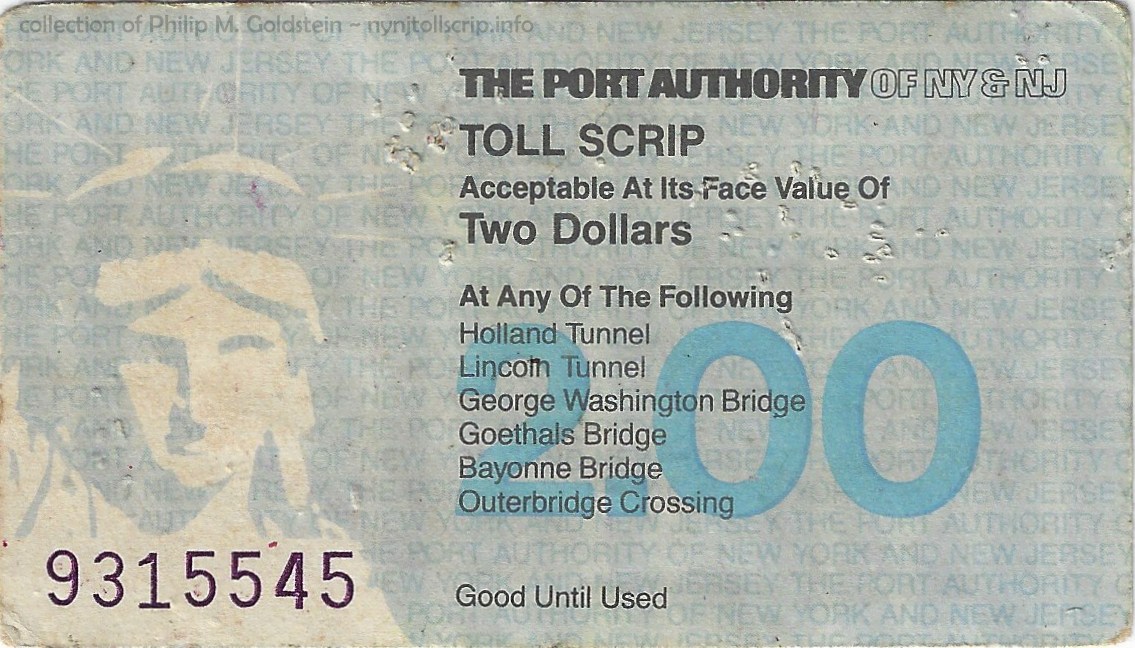 |
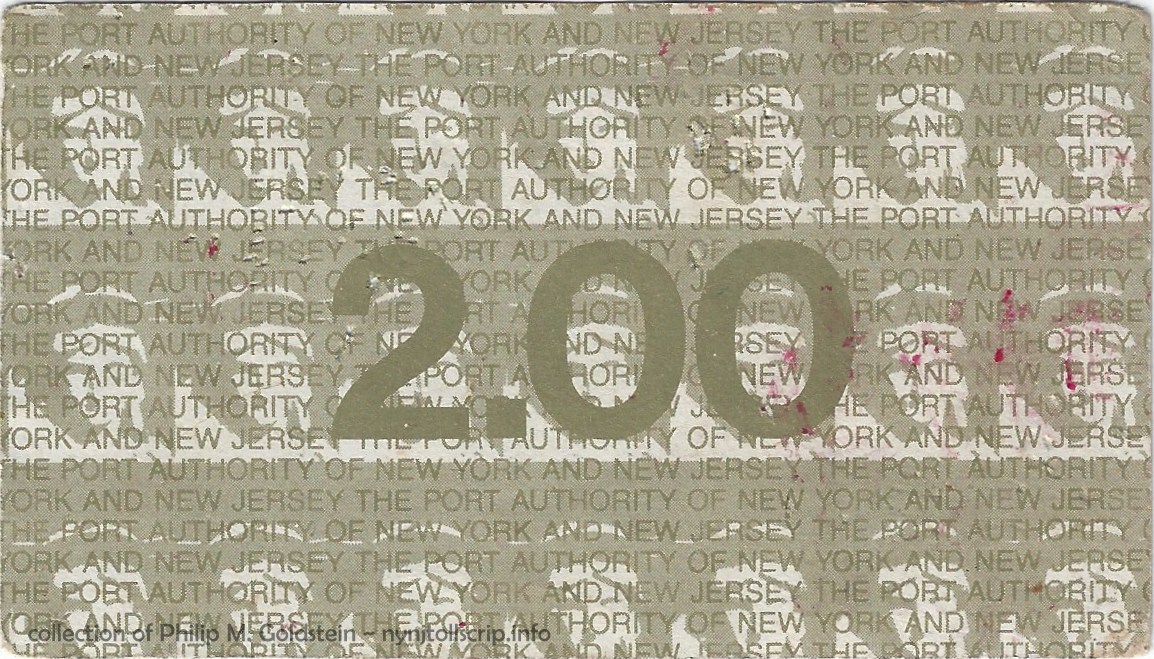 |
PANYNJ
Third Issue - Scrip - $2.00
collection of
Philip M. Goldstein |
facsimile
signature:
printer:
colors, face:
colors, back:
serial number:
notes:
security
underprinting, face:
security underprinting, back:
PA Form:
size: |
none
unknown
light blue, white head of Statue of Liberty, blue
numerals
olive
black ink in lower left corner
sans-serif denomination numbers on face and back.
S. C. 86 on upper left corner of face; 86 = date?
repeating PORT AUTHORITY OF NEW
YORK AND NEW JERSEY" repeating
emblem of Statue of Liberty
"PORT AUTHORITY OF NEW YORK AND NEW JERSEY" on back
3 ¾" (width) - 2 ⅛" (height) - 0.005"
(thickness) |
|
|
 |
 |
PANYNJ
Third Issue - Scrip - $3.00
collection of
Philip M. Goldstein |
facsimile
signature:
printer:
colors, face:
colors, back:
serial number:
notes:
security
underprinting, face:
security underprinting, back:
PA Form:
size:
|
none
unknown
olive, white head of Statue of Liberty, blue
numerals
olive
black ink in lower left corner
sans-serif denomination numbers on face and back.
repeating PORT AUTHORITY OF NEW
YORK AND NEW JERSEY" repeating
emblem of Statue of Liberty
"PORT AUTHORITY OF NEW YORK AND NEW JERSEY" on back
S. C. 86 on upper left corner of face; 86 = date?
3 ¾" (width) - 2 ⅛" (height) - 0.005"
(thickness)
|
.
.
|
|
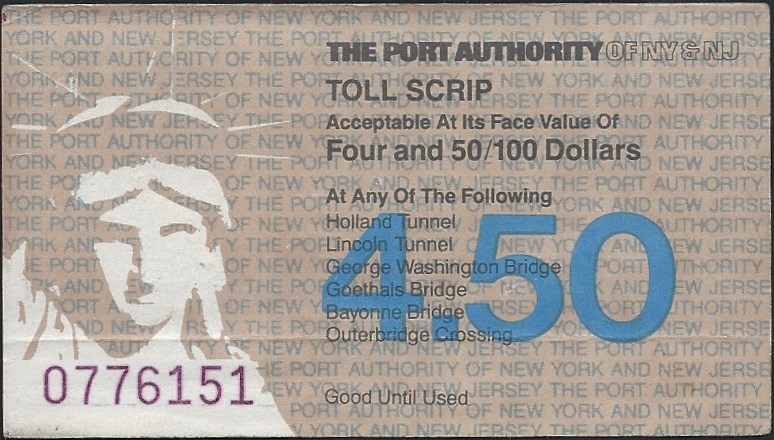 |
 |
PANYNJ Third Issue - Scrip - $4.50
collection of
Philip M. Goldstein |
facsimile signature:
printer:
colors, face:
colors, back:
serial number:
notes:
security
underprinting, face:
security underprinting, back:
PA Form:
size: |
none
unknown
beige, white head of Statue of Liberty, blue
numerals
olive
magenta ink in lower left corner
sans-serif denomination numbers on face and back.
repeating PORT AUTHORITY OF NEW
YORK AND NEW JERSEY" repeating
emblem of Statue of Liberty
"PORT AUTHORITY OF NEW YORK AND NEW JERSEY" on back
3 ¾" (width) - 2 ⅛" (height) - 0.005"
(thickness)
|
.
.
|
|
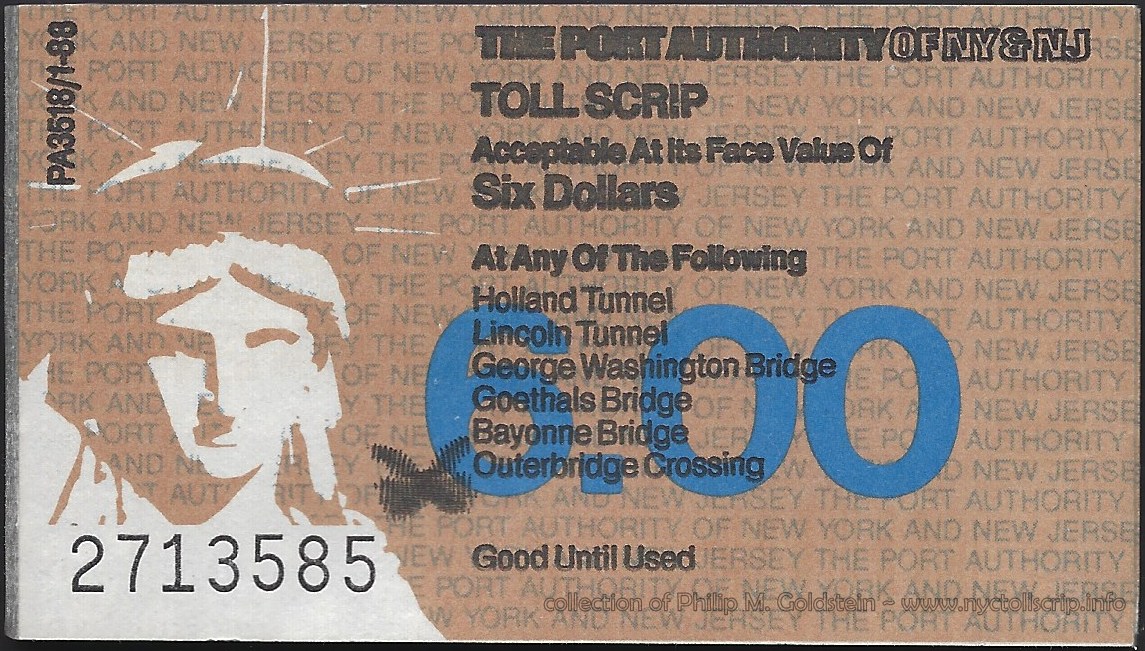 |
 |
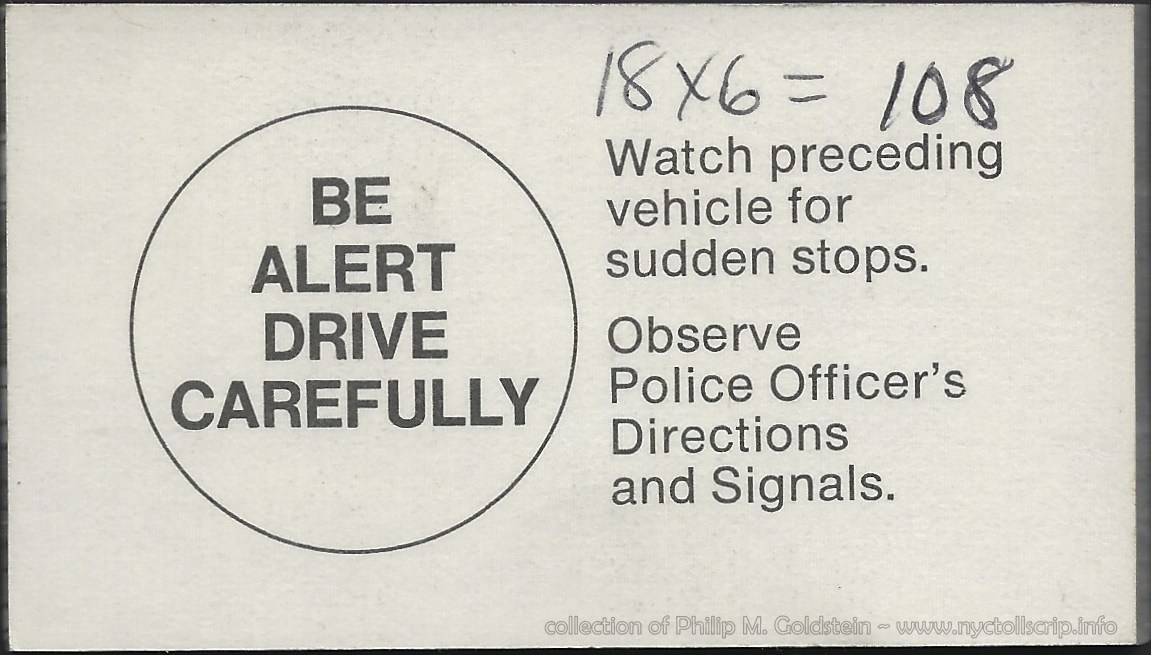 |
PANYNJ
Third Issue - Scrip - $6.00
collection of
Philip M. Goldstein |
facsimile
signature:
printer:
colors, face:
colors, back:
serial number:
notes:
security underprinting, face:
security underprinting, back:
PA
form:
size: |
none
unknown
coffee, white head of Statue of Liberty, blue
numerals
olive
black ink in lower left corner
sans-serif denomination numbers on face and back.
Note
the butterfly shaped mark on face next to numeral 6. This has not been
seen before, but is on all notes of this book, and in same strength. It
is unknown if this is an intentional design inclusion, or simply an
error on the negative.
repeating PORT AUTHORITY OF NEW
YORK AND NEW JERSEY" repeating
emblem of Statue of Liberty
"PORT AUTHORITY OF NEW YORK AND NEW JERSEY" on back
PA3518/1-88
3 ¾" (width) - 2 ⅛" (height) - 0.005"
(thickness)
|
.
.
|
|
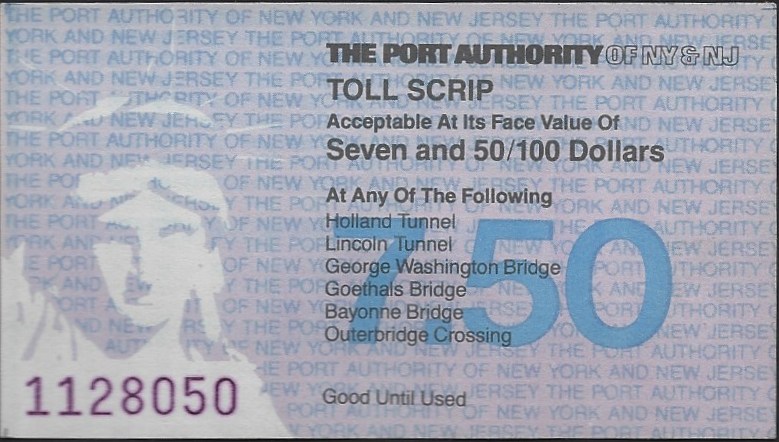 |
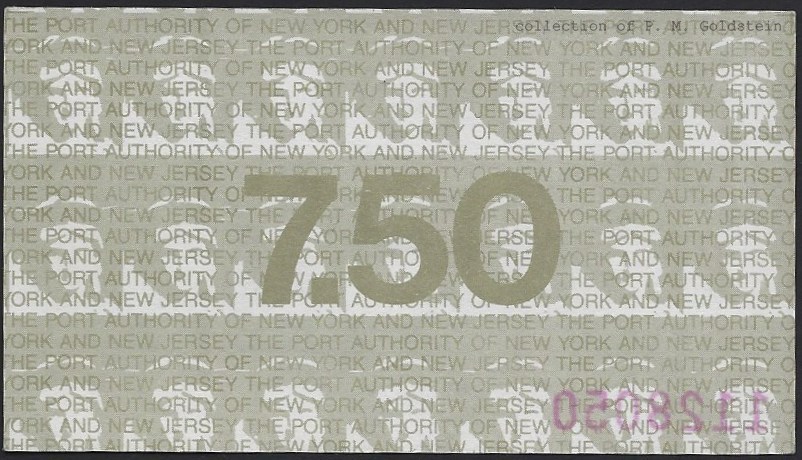 |
PANYNJ Third Issue - Scrip - $7.50
collection of
Philip M. Goldstein |
facsimile signature:
printer:
colors, face:
colors, back
serial number
notes:
security underprinting, face:
security underprinting, back:
size:
|
none
unknown
lavender, white head of Statue of Liberty, blue
numerals
olive
magenta ink in lower left corner
sans-serif denomination numbers on face and back.
repeating PORT AUTHORITY OF NEW
YORK AND NEW JERSEY" repeating
emblem of Statue of Liberty
"PORT AUTHORITY OF NEW YORK AND NEW JERSEY" on back
3 ¾" (width) - 2 ⅛" (height) - 0.005"
(thickness)
|
.
.
|
|
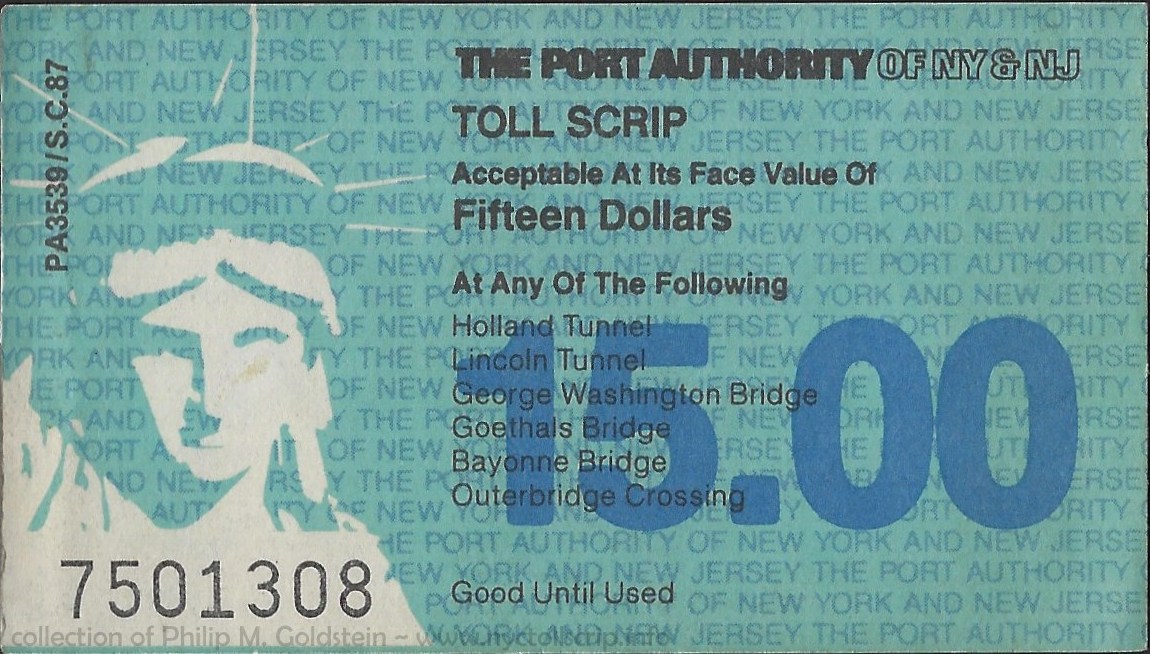 |
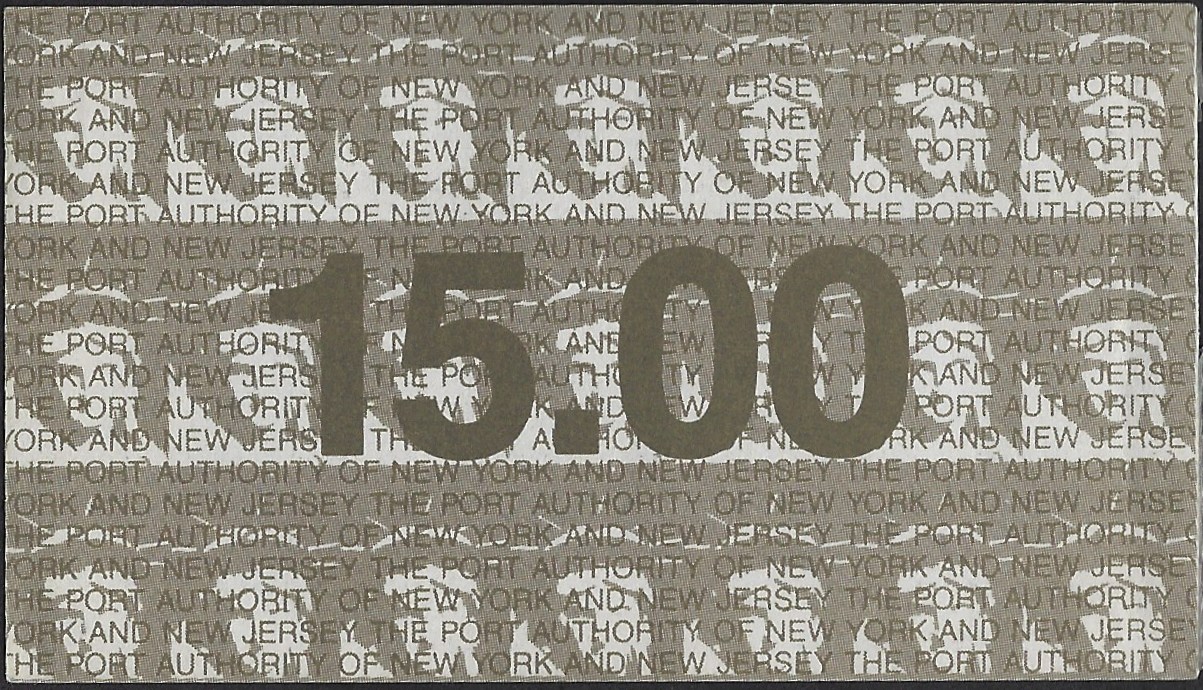 |
PANYNJ
Third Issue - Scrip - $15.00
collection of
Philip M. Goldstein |
facsimile
signature:
printer:
colors, face:
colors, back
serial number
notes:
security underprinting, face:
security underprinting, back:
size:
|
none
unknown
light blue, white head of Statue of Liberty, blue
numerals
olive
black ink in lower left corner
sans-serif denomination numbers on face and back.
repeating PORT AUTHORITY OF NEW
YORK AND NEW JERSEY" repeating
emblem of Statue of Liberty
"PORT AUTHORITY OF NEW YORK AND NEW JERSEY" on back
3 ¾" (width) - 2 ⅛" (height) - 0.005"
(thickness)
|
.
.
PANYNJ "Third Issue" -
Commutation Books
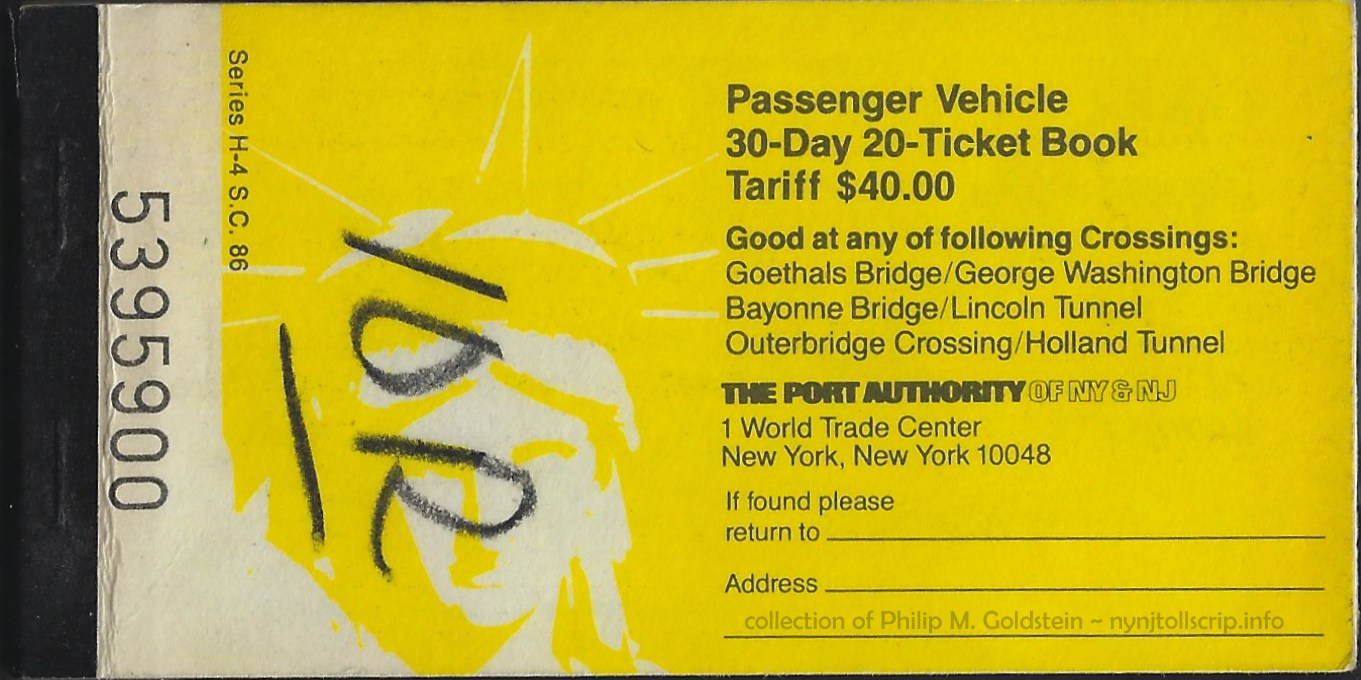 |
 |
 |
 |
PANYNJ Third Issue - Series H-4 S.C. 86 - Passenger Vehicle 30-Day 20-Ticket Book Tariff $40.00
(1986)
collection of
Philip M. Goldstein |
facsimile
signature:
printer:
colors, face:
colors, back:
serial number:
notes:
security
underprinting, face:
security underprinting, back:
size:
PA Form: |
none
Southern Coupon, Birmingham, Ala, 35202
yellow, white head of Statue of Liberty
white, with instructions
black ink in lower left corner
5,000,000 - 8,000,000
3 ¾" (width) - 2 ⅛" (height) - 0.005"
(thickness)
H-4 S.C. 86 |
.
.
 |
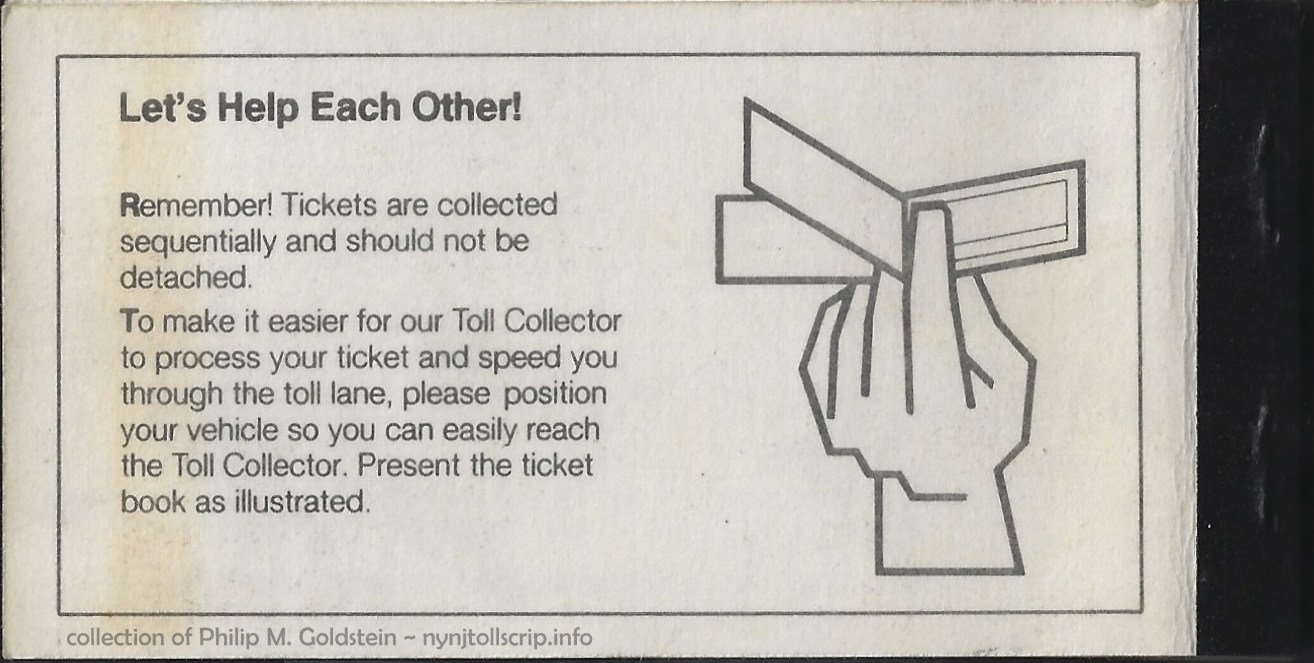 |
|
|
PANYNJ Third Issue - PA3521 / S.C. 87 - Passenger Vehicle - 30 Day 20-Ticket Book Tariff $40.00
(1987)
collection of
Philip M. Goldstein
with thanks to Tom Conklin |
facsimile
signature:
printer:
colors, face:
colors, back:
serial number:
notes:
security
underprinting, face:
security underprinting, back:
size:
PA Form: |
none
unknown
yellow, white head of Statue of Liberty
white, with instructions
7,000,000
Series H-4 nomenclature removed
3 ¾" (width) - 2 ⅛" (height) - 0.005"
(thickness)
PA 3521 / S.C.87
|
.
.
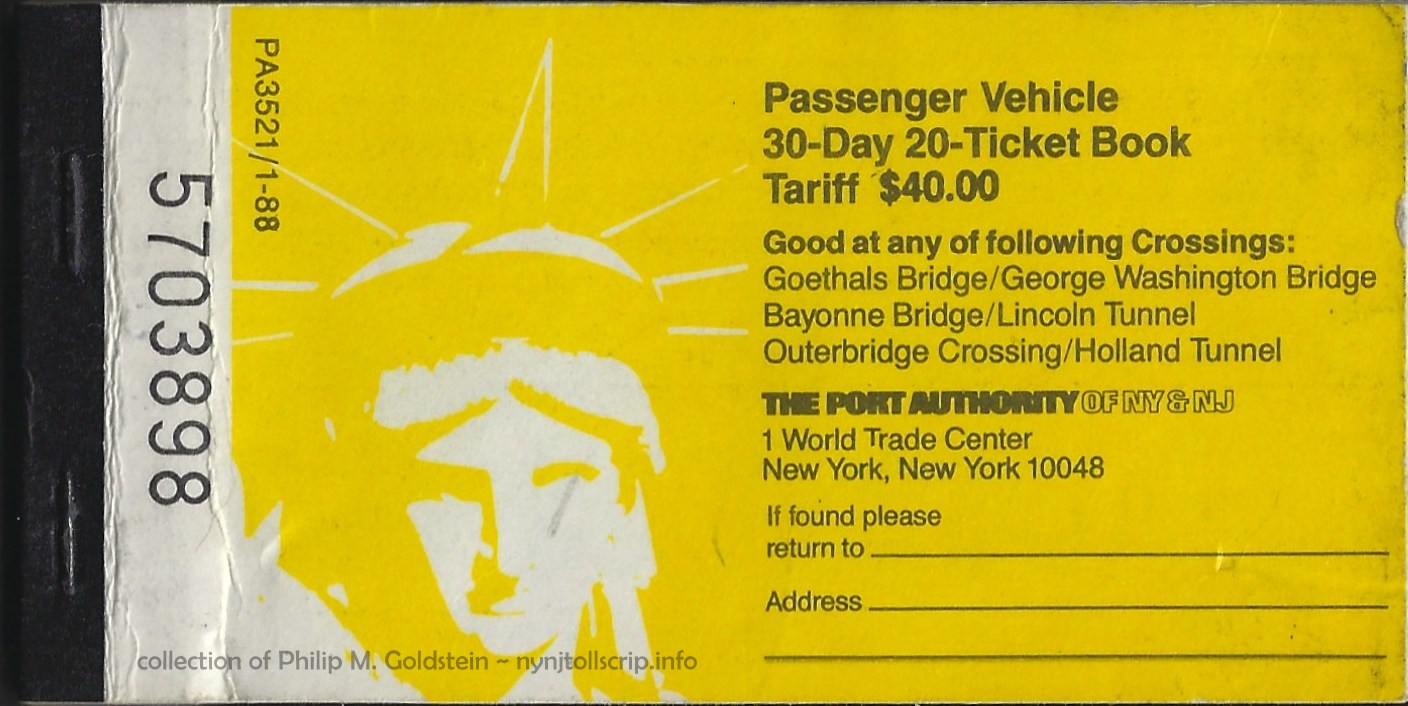 |
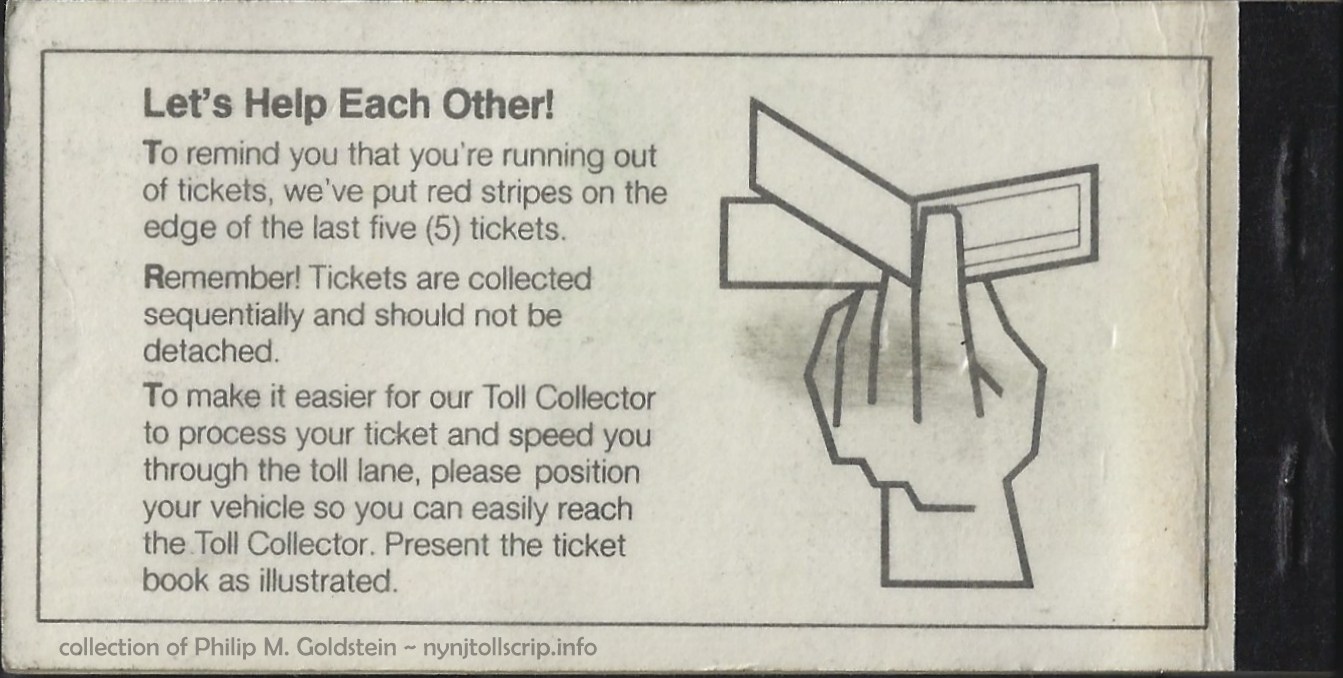 |
|
|
PANYNJ Third Issue - PA3521 / 1-88 - Passenger Vehicle - 30 Day 20-Ticket Book Tariff $40.00
(1988)
collection of
Philip M. Goldstein
with thanks to Tom Conklin |
facsimile
signature:
printer:
colors, face:
colors, back:
serial number:
notes:
security
underprinting, face:
security underprinting, back:
size:
PA Form:
|
none
unknown
yellow, white head of Statue of Liberty
white, with instructions
5,000,000
3 ¾" (width) - 2 ⅛" (height) - 0.005"
(thickness)
PA3521/1-88 |
.
.
PANYNJ "Third and a Half Issue" -
Commutation Books; Retail / PA Outlet Sales
Theoretically,
this design should be included in the Fourth Issue, but the dates
correspond with Third Issue. So, these could be considered Third and
Half Series.
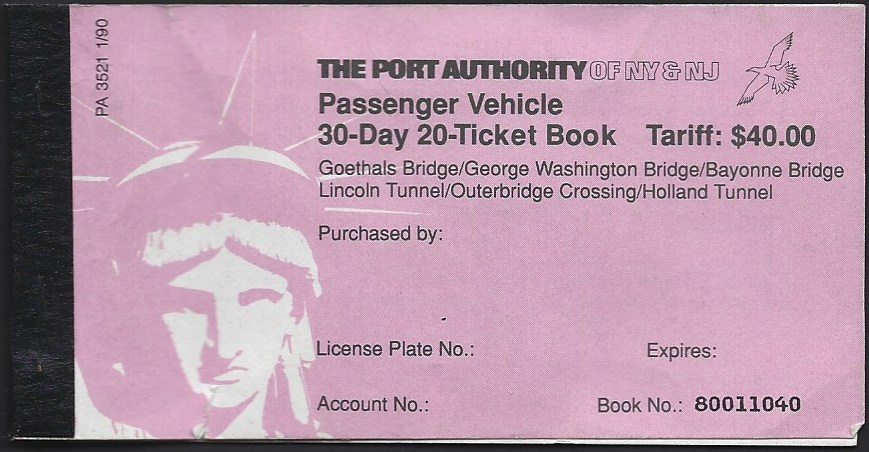 |
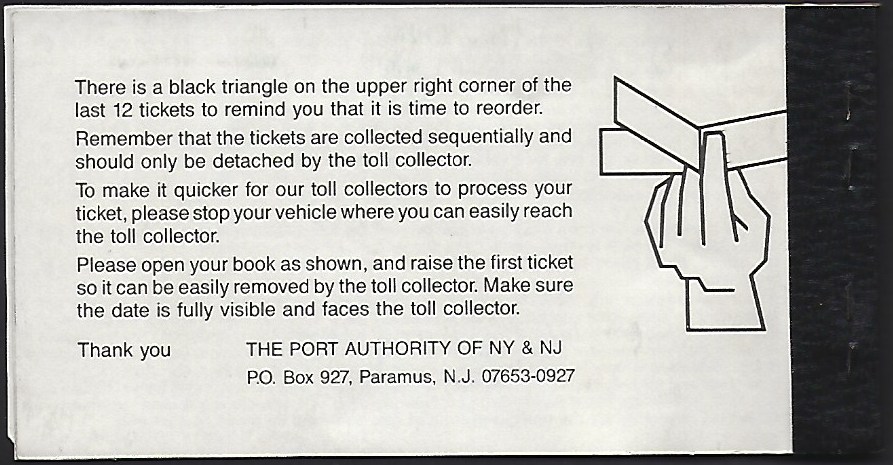 |

with affixed license plate change sticker |
 |
PANYNJ Third Issue - PA 3521 1/90
- Passenger Vehicle 30-Day 20-Ticket Book Tariff $40.00 -
Retail Purchase at toll booths or PA Outlet
8000xxxx-8002xxxx? serial numbers
Front Cover lacks ruled lines for address.
collection
of Philip M. Goldstein
with thanks to Tom Conklin |
facsimile signature:
printer:
colors, face:
colors, back:
serial number:
notes:
security underprinting, face:
size:
printing code:
PA form: |
none
unknown
pink, white head of statue of Liberty
white, with instructions
OCR-B font in black, lower left of tickets, covers
are sans-serif bottom right corner
no ruled lines for address on front cover
repeating "THE PORT AUTHORITY OF NEW YORK AND NEW
JERSEY" in blue on face only. Ultra violet barcode bottom right corner
none
3 15/16" (width) +
3/8" stub - 2 3/16"
(height) - 0.005" (thickness)
cover: PA 3521 1/90
selvage: 06-B230 (H) |
.
.
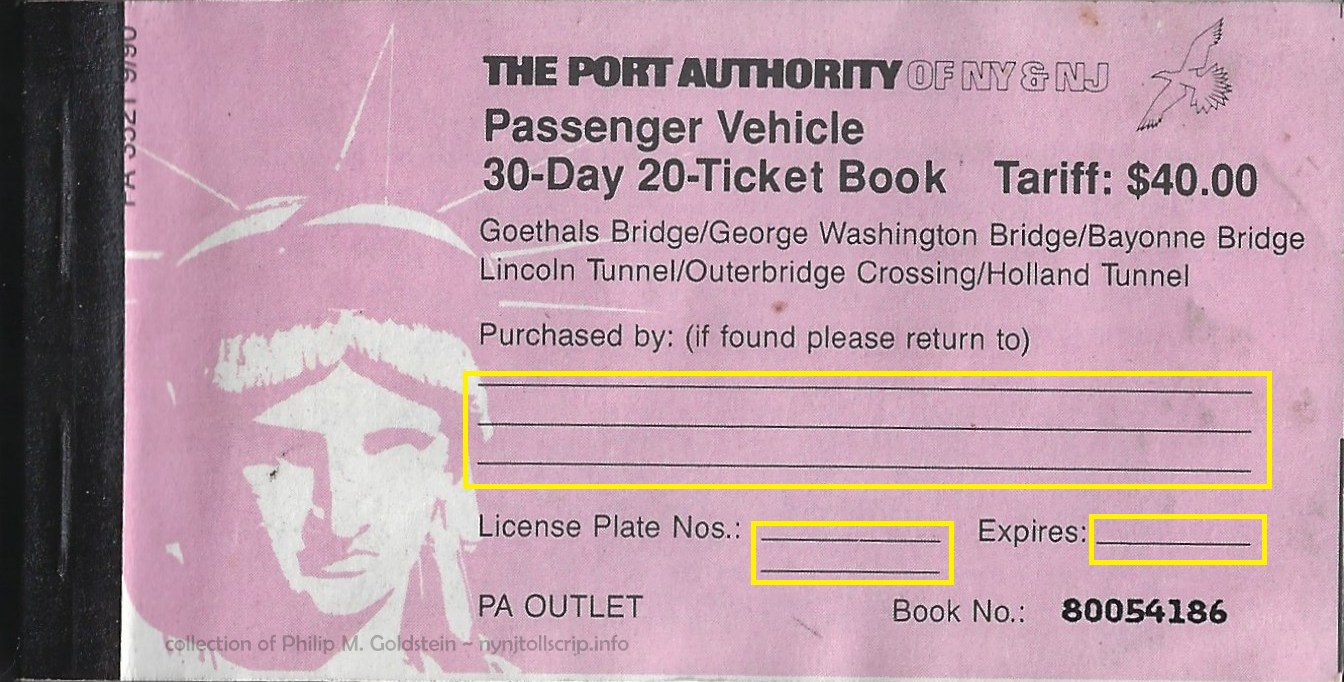 |
 |
 |
 |
 |
PANYNJ Third Issue - PA 3521 9/90 - Passenger Vehicle - 30-Day 20-Ticket Book Tariff $40.00
Retail Purchase at toll booths or PA Outlet
8005xxxx - 8013xxxx+ serial numbers
30 day, 20 tickets, $40.00
collection
of Philip M. Goldstein
with thanks to Tom Conklin |
facsimile signature:
printer:
colors, face:
colors, back:
serial number:
notes:
security underprinting, face:
size:
printing code:
PA form: |
none
unknown
pink, white head of statue of Liberty
white, with instructions
OCR-B font in black, lower left of tickets, covers
are sans-serif bottom right corner
ruled lines for address on front cover
repeating "THE PORT AUTHORITY OF NEW YORK AND NEW
JERSEY" in blue on face only. Ultra violet barcode bottom right corner
none
3 15/16" (width) +
3/8" stub - 2 3/16"
(height) - 0.005" (thickness)
cover: PA 3521 1/90
selvage: 06-3429-B230 (H) back cover 06-41X8-B230 (J) |
.
.
PANYNJ "Third and a Half Issue" -
Commutation Books; Mail Order Sales
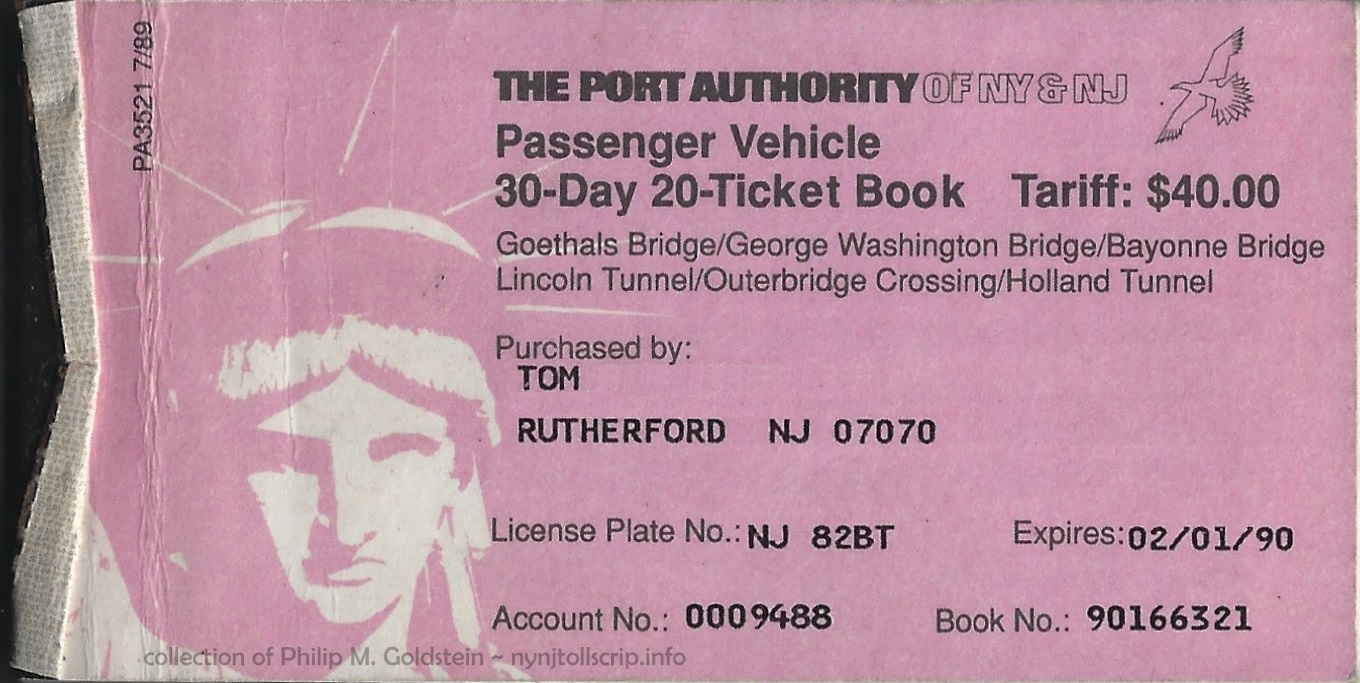 |
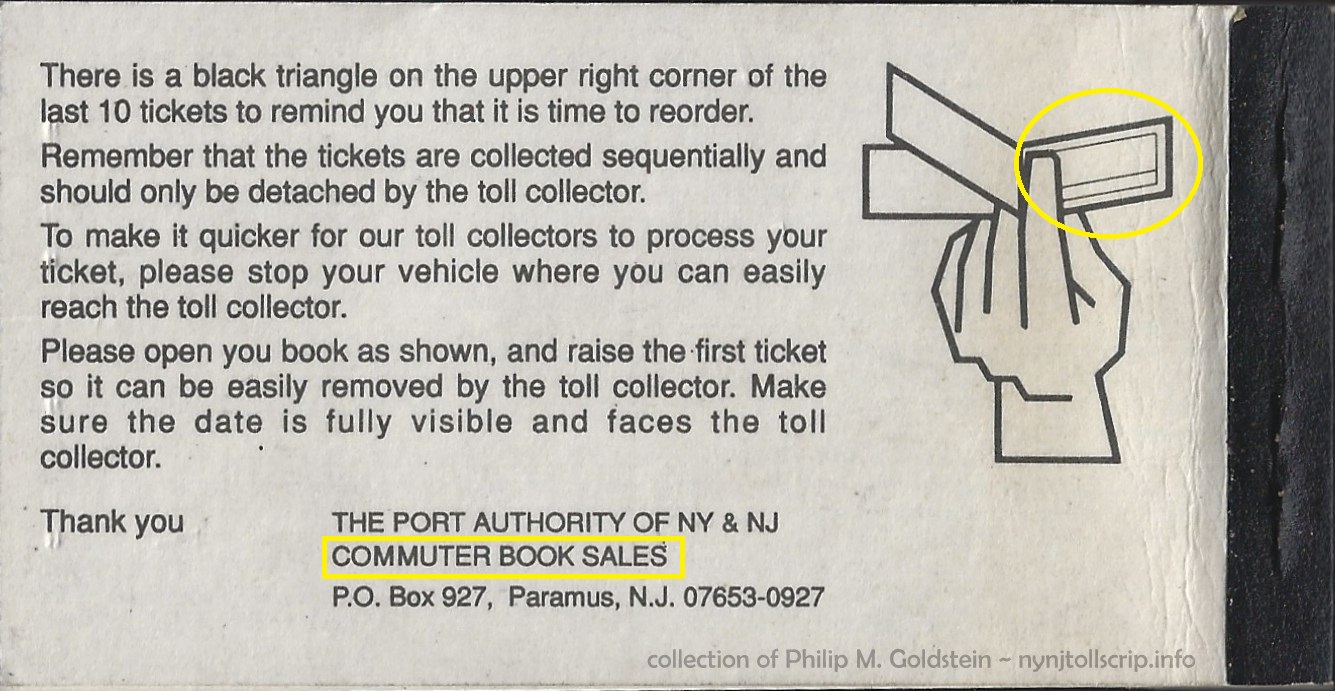 |
 |
 |
 |
PANYNJ Third Issue - PA 3521 7/89 - Passenger Vehicle - 30-Day 20-Ticket Book Tariff $40.00
Mail Order
9000xxxx - ? serial numbers
30 day, 20 tickets, $40.00
front cover contains printed name, address, license, expiration date of account holder
collection
of Philip M. Goldstein
with thanks to Tom Conklin |
facsimile signature:
printer:
colors, face:
colors, back:
serial number:
notes:
security underprinting, face:
size:
printing code:
PA form: |
none
unknown
pink, white head of statue of Liberty
white, with instructions
OCR-B font in black, lower left of tickets, covers
are sans-serif bottom right corner
no ruled lines for address on front cover
back cover: ticket illustration has framed ticket, commuter book sales listed
none
3 15/16" (width) +
3/8" stub - 2 3/16"
(height) - 0.005" (thickness)
cover: PA 3521 7/89,
selvage: PA 3521 7/89 |
.
.
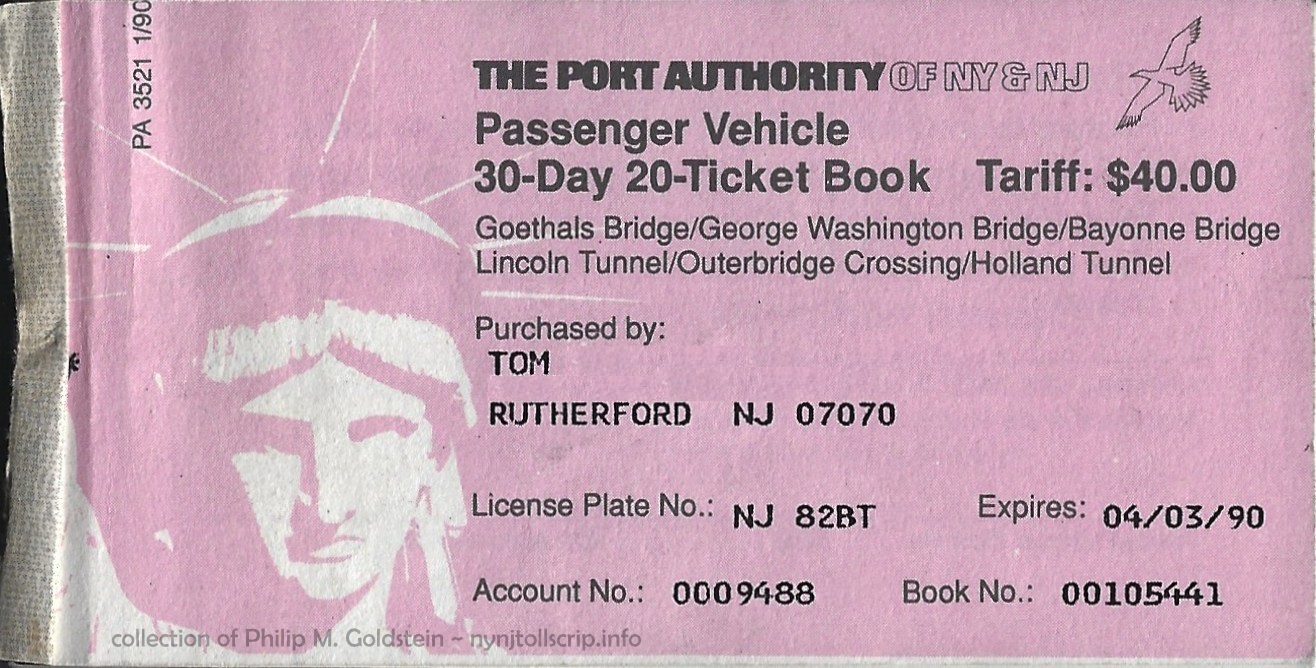 |
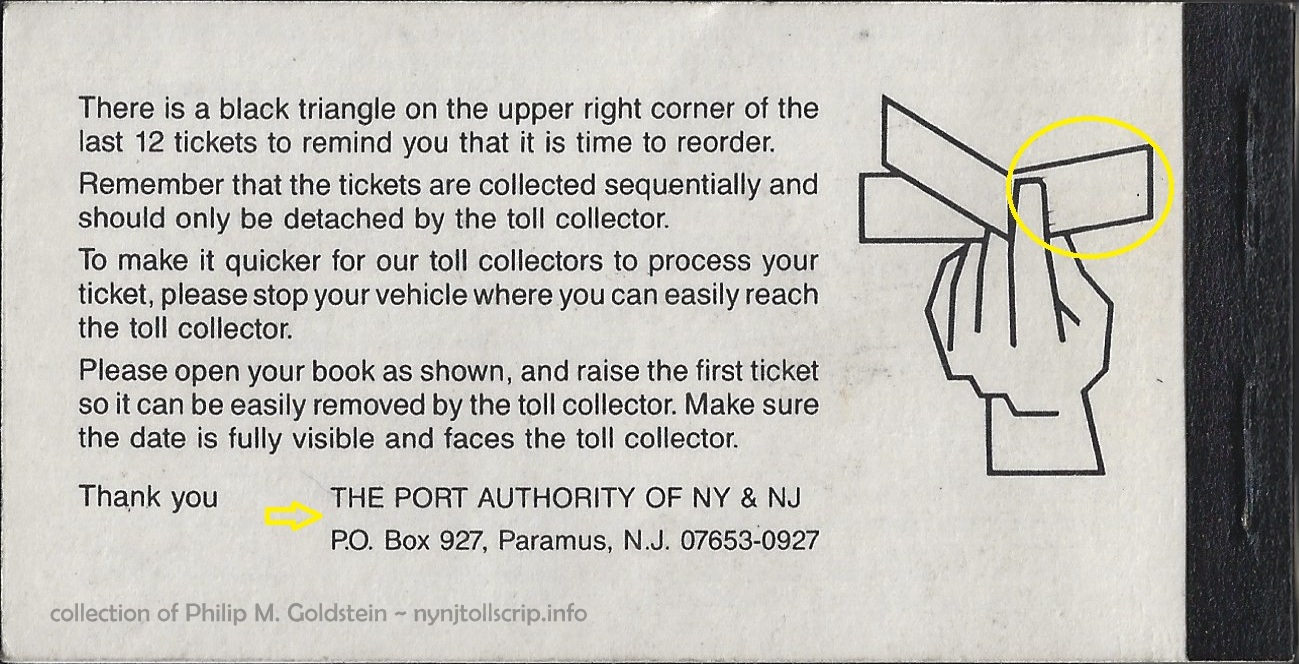 |
 |
 |
 |
 |
PANYNJ (Third Issue) - PA 3521 1/90 - Passenger Vehicle - 30-Day 20-Ticket Book Tariff $40.00
Mail Order
0000xxxx - ? serial numbers
front cover contains printed name, address, license, expiration date of account holder
collection
of Philip M. Goldstein
with thanks to Tom Conklin |
facsimile signature:
printer:
colors, face:
colors, back:
serial number:
notes:
security underprinting, face:
size:
printing code:
PA form: |
none
unknown
pink, white head of statue of Liberty
white, with instructions
OCR-B font in black, lower left of tickets, covers
are sans-serif bottom right corner
no ruled lines for address on front cover
back cover: ticket illustration has unframed ticket, commuter book sales omitted
none
3 15/16" (width) +
3/8" stub - 2 3/16"
(height) - 0.005" (thickness)
cover: PA 3521 7/89,
back cover 06-41X8-B230 (J) |
.
PANYNJ
"Fourth" Issue - ca. 1990 - 1991
With this series, we now observe the following design changes:
- the
previous single line
 is split between two lines; is split between two lines;
- the new "seagull" logo is
included to the right of that;
- the
single column list of applicable facilities is now doubled for Holland
Tunnel / Lincoln Tunnel and Goethals Bridge / Bayonne Bridge, thereby
making a six row list into a four row.
- As a result, smaller denomination numbers (1/2") on face and back from the previous series (5/8").
- The "GOOD UNTIL USED" legend has been relocated from bottom center to top left corner.
.
.
In May of 2021, I acquired a Goethals Bridge & Outerbridge
Crossing 60th Anniversary Commemorative Map & Pamphlet issued by the PANYNJ dated
June 29, 1988.
This one pamphlet reveals a lot of information regarding scrip
issues, even more than I had expected. For starters, it breaks down
the toll amounts for all vehicle classes; but even more importantly,
it lists all the denominations that scrip books were issued in.
Furthermore, it
goes on to state that scrip tickets are sold in the exact corresponding
denominations of the various toll rates; i.e. $3.00 for passenger auto,
$9.00 for class 3 (3 axles), $18.00 for Class 6 (6 axles) etc. These
toll rates would have taken effect April 12, 1987, and would remain so
until April 6, 1991. As this is the case, this should make it easy to
postulate what scrip issues issues prior to this toll schedule, simply
by multiplying the toll per axle for truck by the number axles, of
which the number corresponded to the truck class: 2 axle = Class 2, 4
axles = Class 4, etc.
While it has been long been expected, this map and information
confirms this correlation of scrip denomination matching toll rates.
Therefore, even if not yet shown on this website, if a toll amount was
collected for a specific vehicle class, there was a scrip issue in that
denomination.
It also goes on to specify the limitations between toll scrip and reduced rate tickets.
Please note: what is not listed is the Universal Scrip issue, as
this issue was
introduced in 1990 between two toll rate modifications: 1987 and 1991.
Also, upon re-examination, as the Universal Scrip issue bears the same
design elements as those in the Fifth Issue; the Universal Tickets have
been moved to the Fifth Issue chapter. (5/2021)
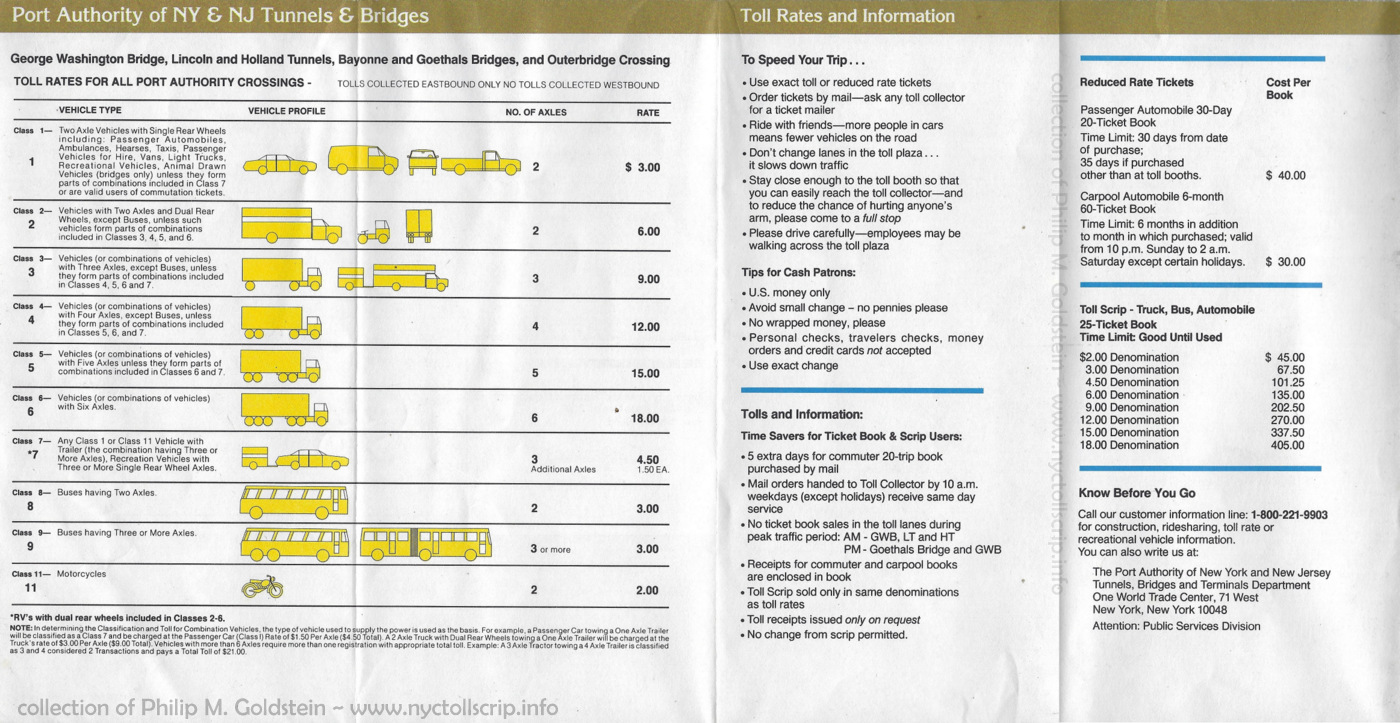 . .
.
PANYNJ "Fourth" Issue Scrip
 |
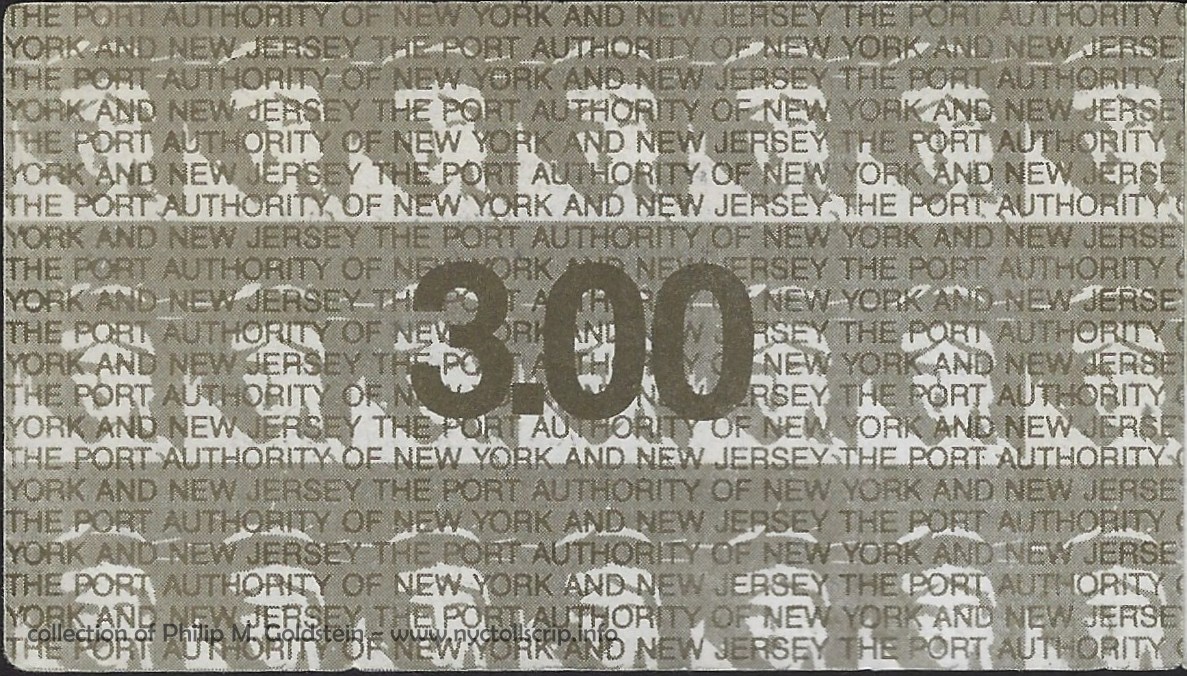 |
 |
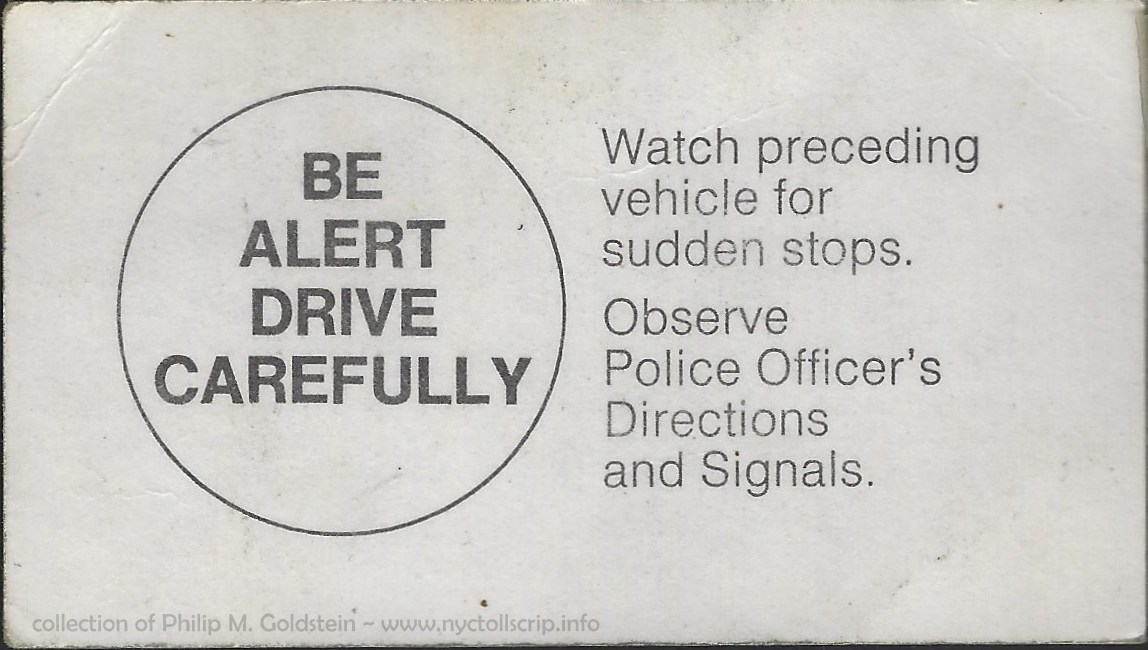 |
PANYNJ Fourth Issue - Scrip - $3.00
with back cover
collection of
Philip M. Goldstein |
facsimile
signature:
printer:
colors, face:
colors, back
serial number
notes:
security underprinting, face:
security underprinting, back:
size:
PA form: |
none
unknown
olive, white head of Statue of Liberty, blue
numerals
olive
black ink in lower left corner
sans-serif denomination numbers on face and back.
repeating PORT AUTHORITY OF NEW
YORK AND NEW JERSEY" repeating
emblem of Statue of Liberty
"PORT AUTHORITY OF NEW YORK AND NEW JERSEY" on back
3 ¾" (width) - 2 ⅛" (height) - 0.005"
(thickness)
PA 3516 |
| . |
|
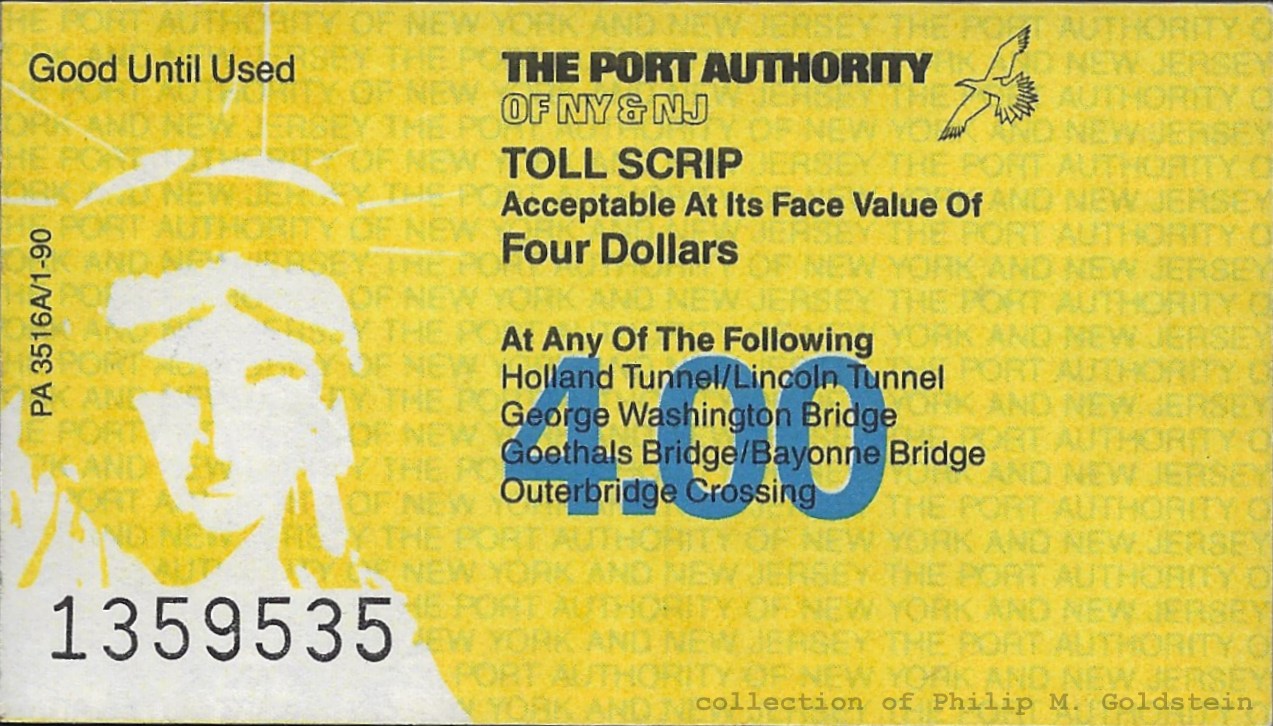 |
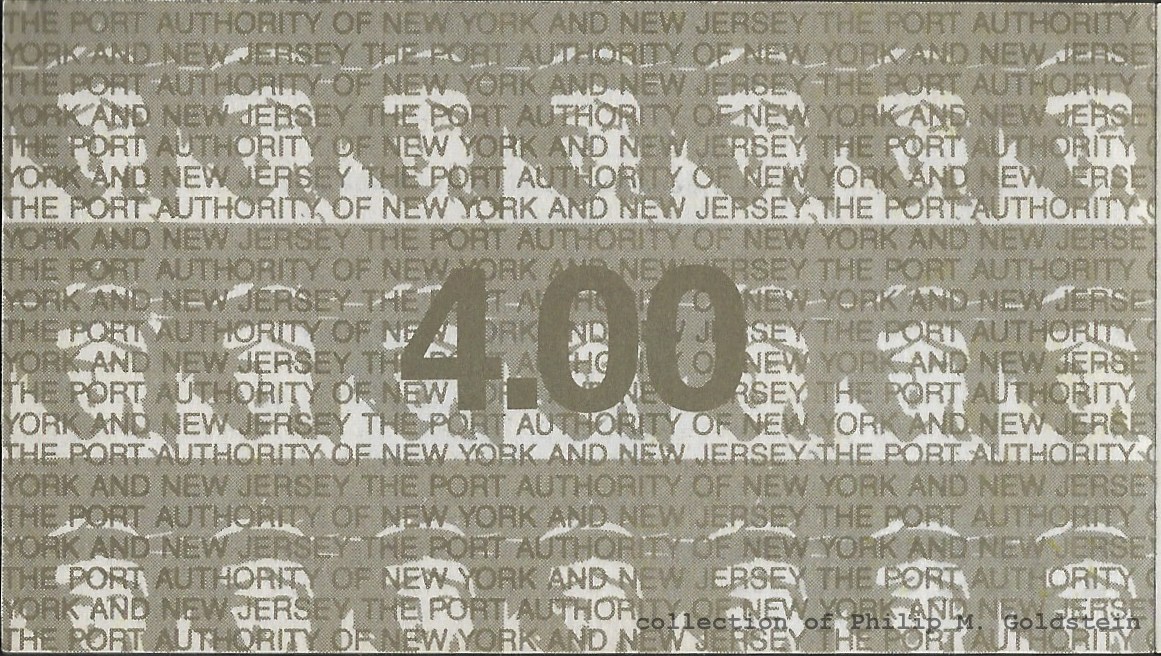 |
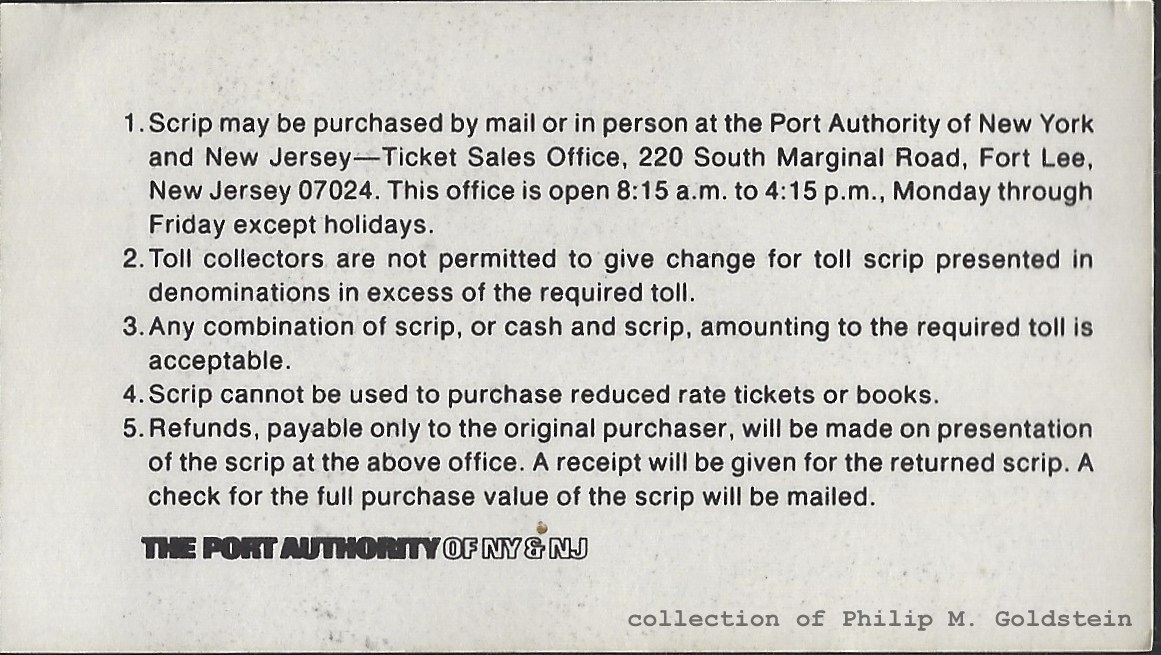 |
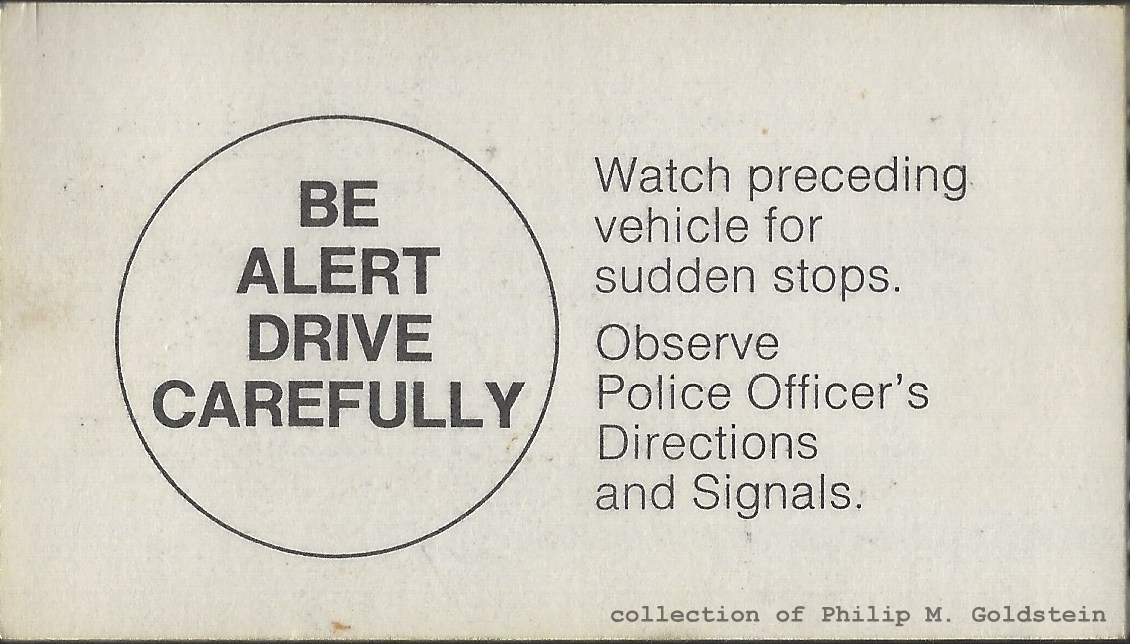 |
PANYNJ Fourth Issue - Scrip - $4.00
with back cover
collection of
Philip M. Goldstein |
facsimile
signature:
printer:
colors, face:
colors, back
serial number
notes:
security underprinting, face:
security underprinting, back:
size:
PA form: |
none
unknown
lime green, white head of Statue of Liberty, blue
numerals
olive
black ink in lower left corner
sans-serif denomination numbers on face and back.
repeating PORT AUTHORITY OF NEW
YORK AND NEW JERSEY" repeating
emblem of Statue of Liberty
"PORT AUTHORITY OF NEW YORK AND NEW JERSEY" on back
3 ¾" (width) - 2 ⅛" (height) - 0.005"
(thickness)
PA 3516A |
.
.
.
..
PANYNJ "Fourth" Issue - Carpool Vehicle, 6 Month - 60 Ticket - $30.00
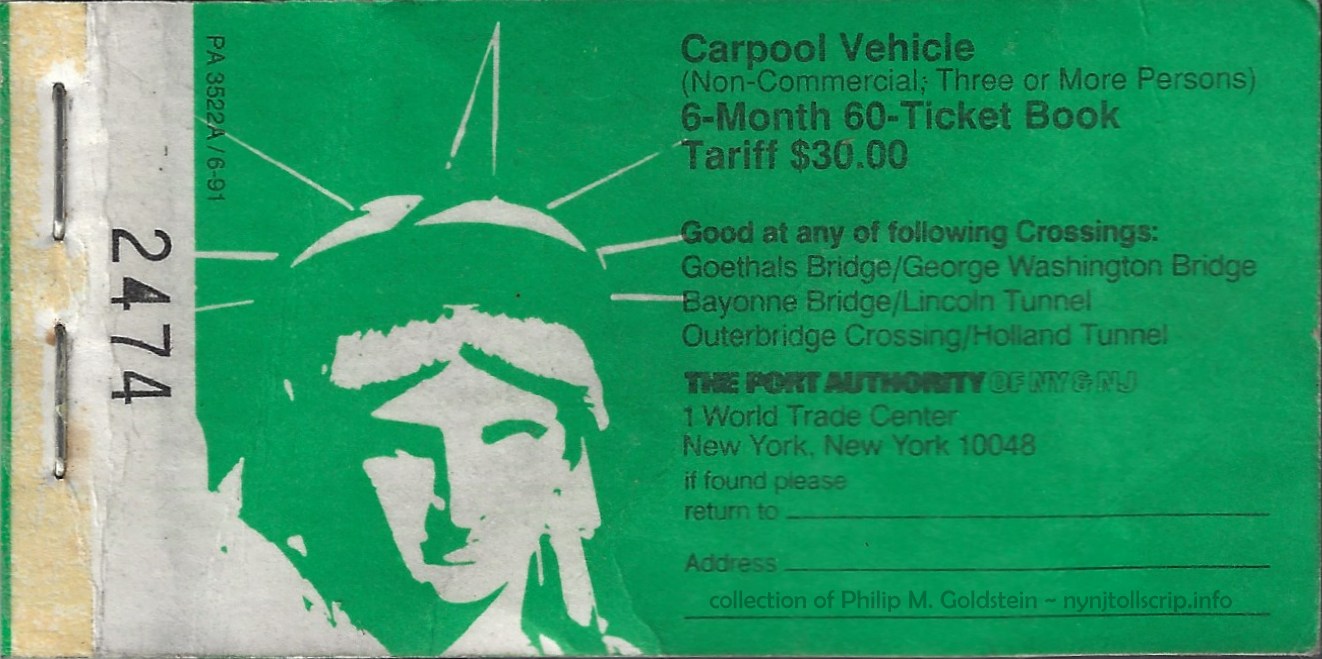 |
 |
PANYNJ Fourth Issue - PA 3533A 6-91 - Carpool Vehicle 6-Month 60 Ticket $30.00
July 1992
collection of
Philip M. Goldstein |
facsimile
signature:
printer:
colors, face:
colors, back:
serial number:
notes:
security underprinting, face:
security underprinting, back:
size:
PA form: |
none
unknown
green, white head of Statue of Liberty
white
black gothic
repeating PORT AUTHORITY OF NEW
YORK AND NEW JERSEY" repeating
emblem of Statue of Liberty
"PORT AUTHORITY OF NEW YORK AND NEW JERSEY" on back
3 ¾" (width) - 2 ⅛" (height) - 0.005"
(thickness)
PA 3522A - 6-91 |
.
.
.
.
PANYNJ Scrip -
Fifth Issue - ca. 1991
and
Universal Commuter Commutation Tickets &
Books - 4/1991 - 1993
Quite frankly, I do not know if this issue is the last issue
printed before becoming obsolete what with the advent of E-ZPass, or if
in fact another series is lurking about undocumented. I hope time will
tell.
At the expense of
sounding like a broken record, you are cordially invited to share
images of your collection or information, additions or corrections.
Please contact me by email at bedt14@aol.com
or by telephone at
(936) 396-6103.
The "The Port of Authority of New York & New Jersey is
now on two lines, not one; and all solid black block lettering; but the
"seagull" logo of the Port Authority of New York and New Jersey is
still included to the right of the legend.
The "GOOD UNTIL USED" remains in the upper left corner.
The unprinted area at the bottom for the serial
number is removed and the design expanded to cover the entire face of
the note. The serial number, now enlarged to 7/32" for easier
legibility and in a serif font.
There now appears to be a printers registration square and circle on left edge.
As of May 2021; we now have seen two varieties of this issue of scrip:
Type 1: the face graphics extending border to border and with large serial number along the bottom;
Type 2: ticket with a smaller face printed area, with a white
unprinted bottom area of approximately 3/4", containing a barcode and
the book number.
This second type of ticket may have been the front cover of a booklet of the other tickets.
On all types, the back is unprinted and blank.
 |
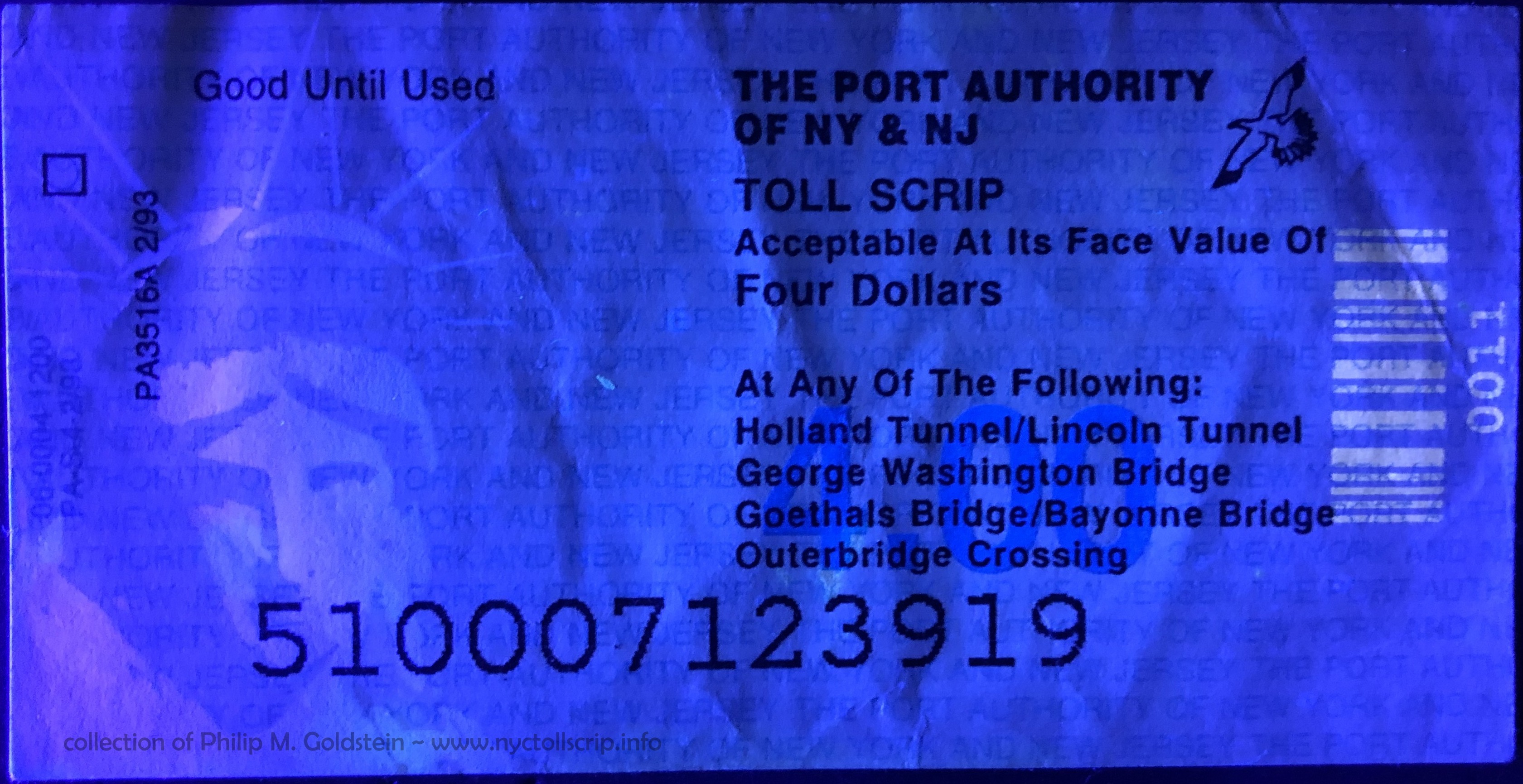
|
| (under
white light) |
(under
ultraviolet light) |
PANYNJ
Fifth Issue - Scrip - $4.00 scrip (Type 1)
1993
collection
of Philip M. Goldstein |
facsimile signature:
printer:
colors, face:
colors, back:
serial number:
notes:
security underprinting, face:
size:
printing code:
PA form: |
none
unknown
lime green, white head of statue of Liberty solid
blue numerals
unprinted plain white
enlarged serial number in Courier style serif font on
bottom,
seagull logo
repeating "THE PORT AUTHORITY OF NEW YORK
AND NEW JERSEY" in blue on face only. Ultraviolet barcode on right edge
4 1/4" (width) - 2 3/16"
(height) - 0.005" (thickness)
06-0004-1200
PA-S-4-2/93
PA3516A 2/93
|
.
. |
|
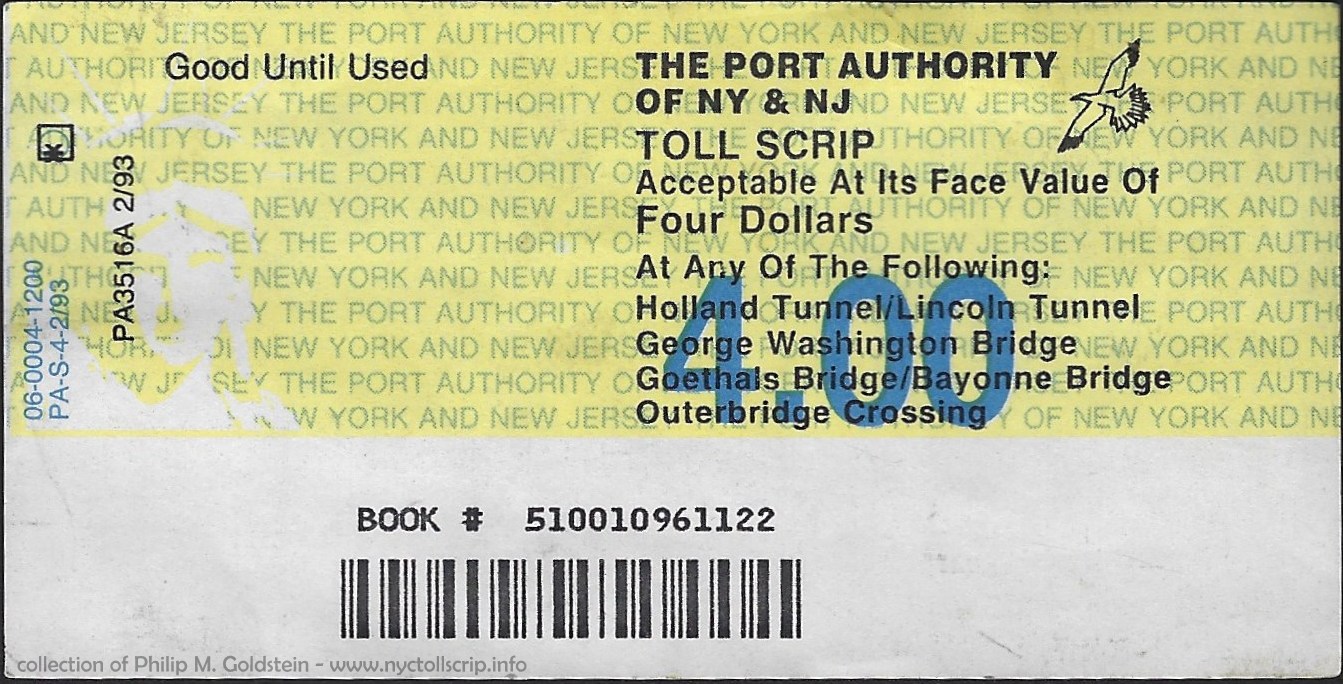 |
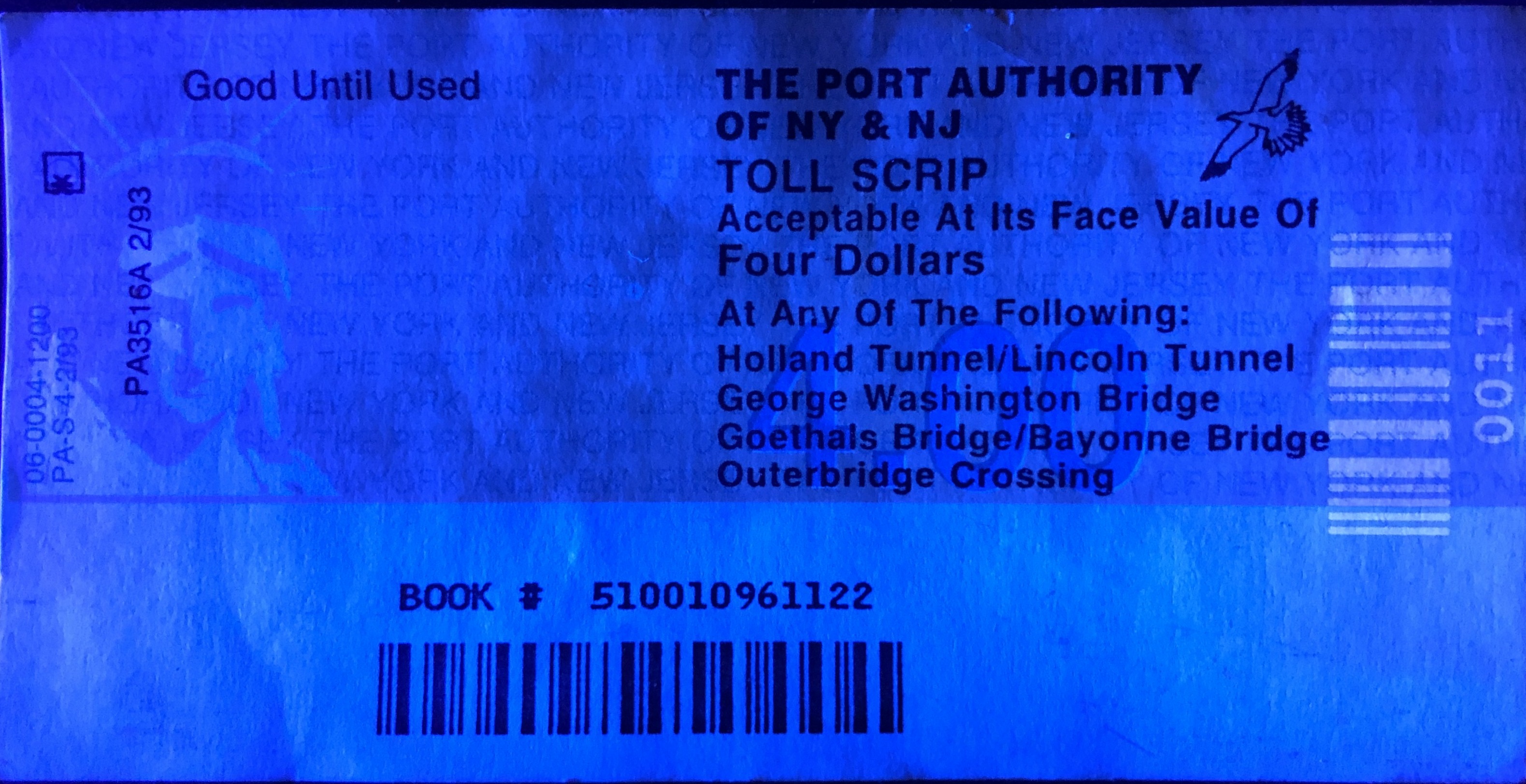 |
| (under
white light) |
(under
ultraviolet light) |
PANYNJ
Fifth Issue - Scrip - $4.00 scrip (Type 2)
1993
This may have been the top ticket of the booklet of Type 1 tickets and served as a cover.
collection
of Philip M. Goldstein |
facsimile signature:
printer:
colors, face:
colors, back:
serial number:
notes:
security underprinting, face:
.
size:
printing code:
PA form: |
none
unknown
lime green, white head of statue of Liberty solid
blue numerals
unprinted plain white
book number and barcode in 3/4" unprinted area on bottom of face
seagull logo
repeating "THE PORT AUTHORITY OF NEW YORK
AND NEW JERSEY" in blue on face only. Ultraviolet barcode 0011 on right edge
4 1/4" (width) - 2 3/16"
(height) - 0.005" (thickness)
06-0004-1200
PA-S-4-2/93
PA3516A 2/93 |
.
.
|
|
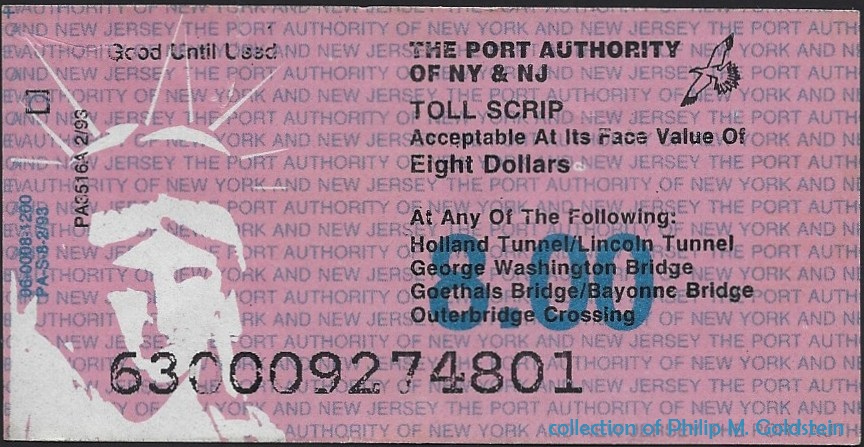 |
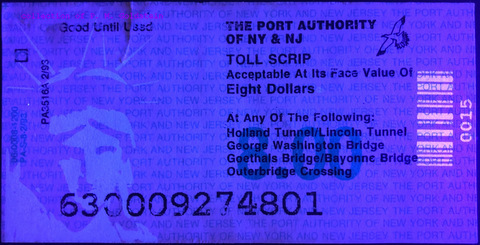 |
| (under
white light) |
(under
ultraviolet light) |
PANYNJ Fifth Issue - Scrip - $8.00
1993
collection
of Philip M. Goldstein |
facsimile signature:
printer:
colors, face:
colors, back:
serial number:
notes:
security underprinting, face:
.
size:
printing code:
PA form:
|
none
unknown
pink, white head of statue of Liberty solid blue
numerals
unprinted plain white
enlarged serial number in Courier style serif font on
bottom,
seagull logo
repeating "THE PORT AUTHORITY OF NEW YORK
AND NEW JERSEY" in blue on face only. Ultraviolet barcode on right edge
4 1/4" (width) - 2 3/16"
(height) - 0.005" (thickness)
06-008-1200
PA-S-8-2/93
PA3516A 2/93
|
Universal Tariff $72.00
20-Ticket Commuter Book
OCR-B font on cover, purchased at PA Outlet
s/n: 8 digits: 1900xxxx
4/91 |
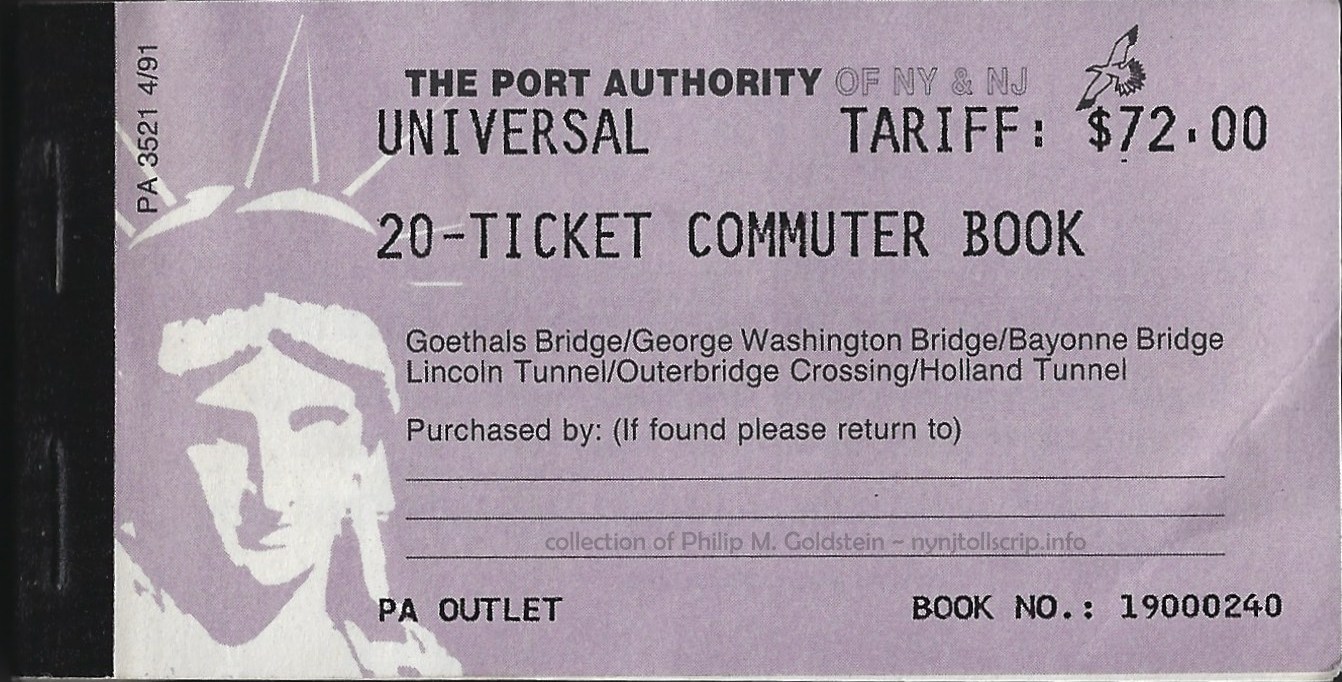 |
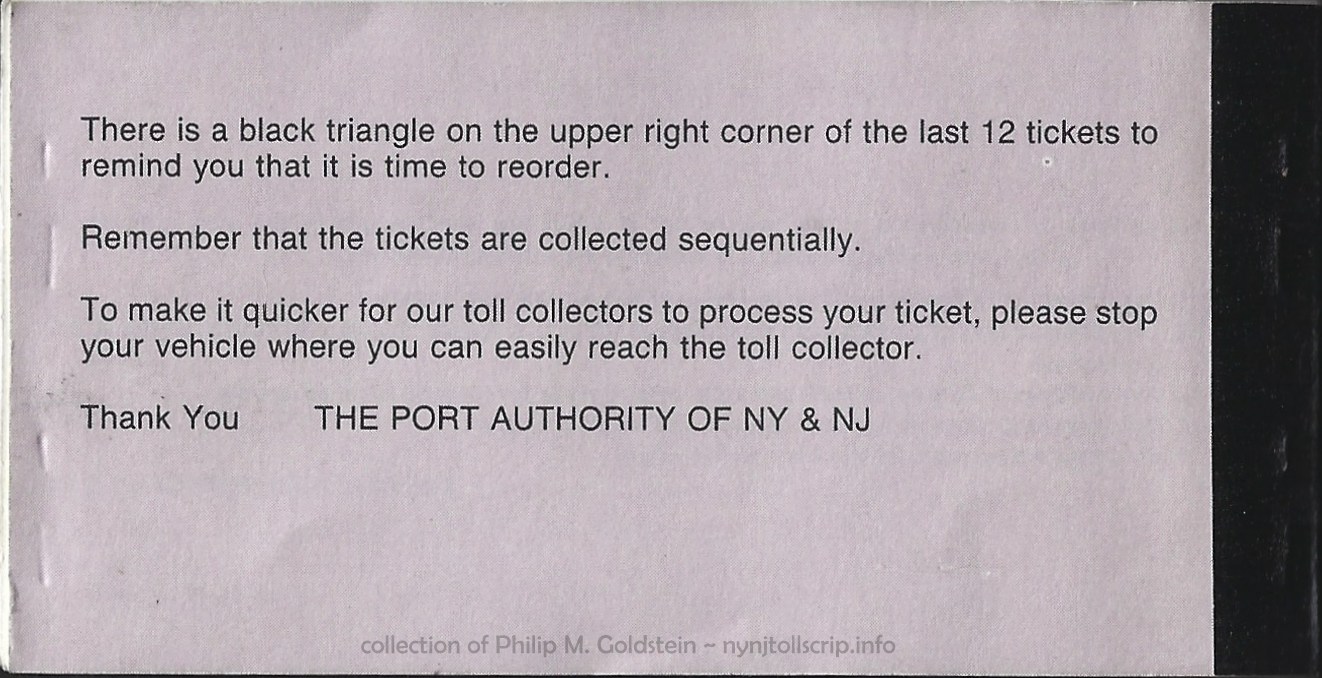 |
 |
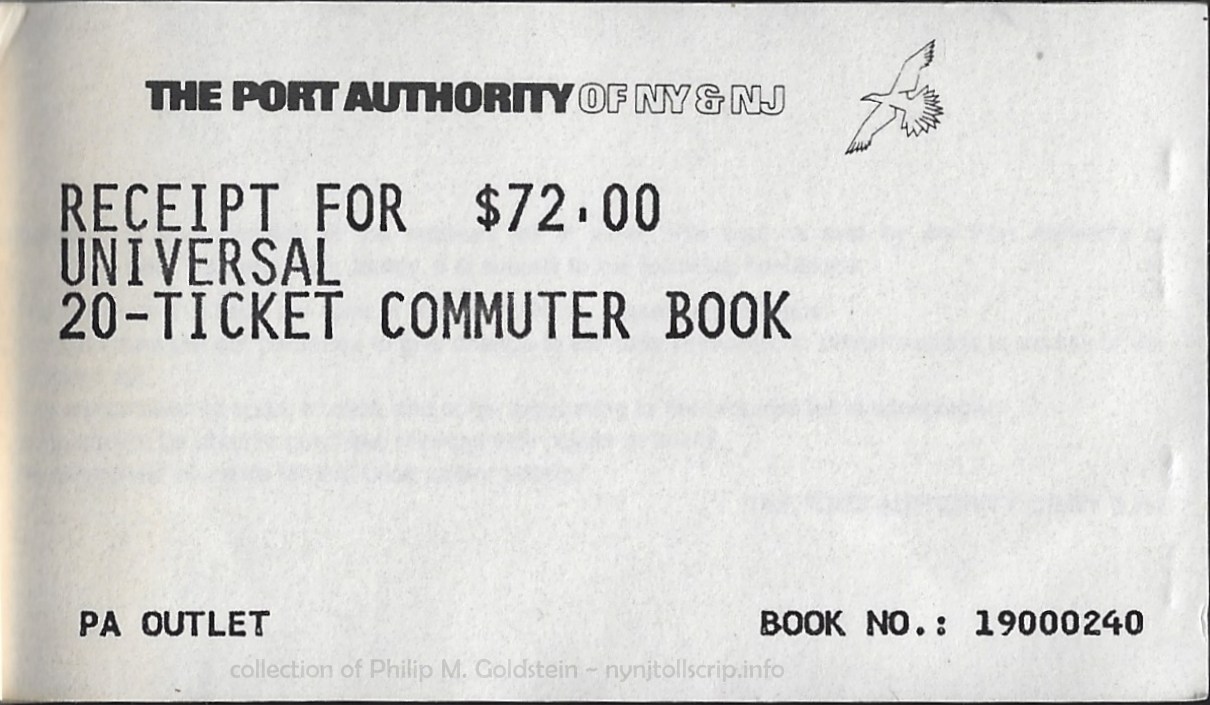 |
 |
PANYNJ
"Universal" Issue - PA 3521 4/91 - 20 ticket, $72.00, commuter book / $4.00 scrip
20 tickets for $72 ($3.60 value each scrip) but
were valid indefinitely
collection
of Philip M. Goldstein |
|
facsimile signature:
printer:
colors, face:
colors, back:
serial number:
.
notes:
security
underprinting, face:
.
security underprinting, back:
size:
printing codes:
PA form
|
none
unknown
lavender, white head of Statue of Liberty
lavender, with instructions
19000xxx series
OCR-A font in black, lower left of tickets, covers
are sans-serif bottom right corner
UNIVERSAL TARIFF: $72.00
20-TICKET COMMUTER BOOK in Gothic OCR-B
repeating "THE PORT AUTHORITY OF NEW YORK AND NEW
JERSEY" in blue on face only. Ultra violet barcode bottom right corner
none
3 15/16" (width) +
3/8" stub - 2 3/16"
(height) - 0.005" (thickness)
selvage: AFPA J-91
PA 3521 - 4/91 |
Universal Commuter
20-Ticket Book
Helvetica on cover, purchased at PA Outlet
s/n 10 digits: 1500000000 - 1500020000 series: 9/91 |
 |
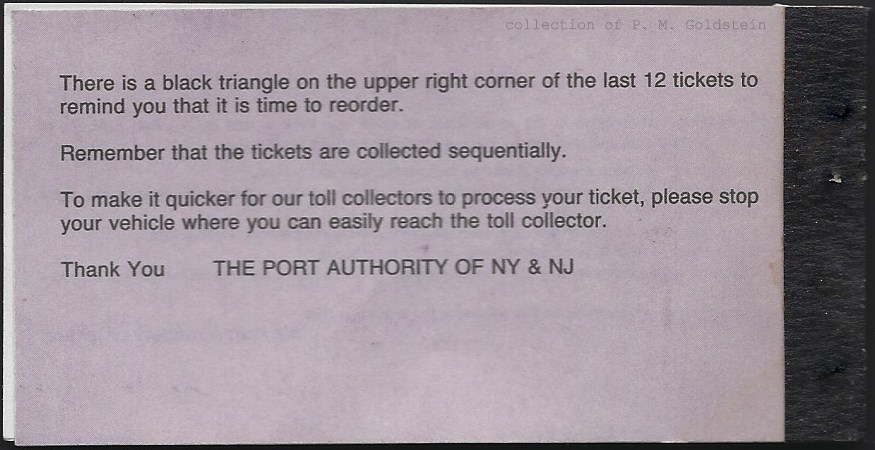 |
 |
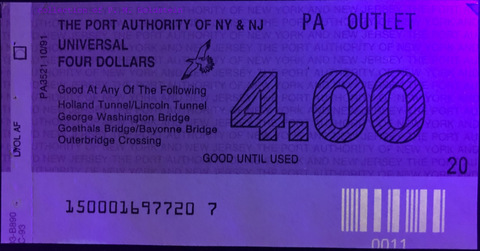 |
| Scrip Ticket: (under
white light) |
Scrip Ticket: (under
ultraviolet light) |
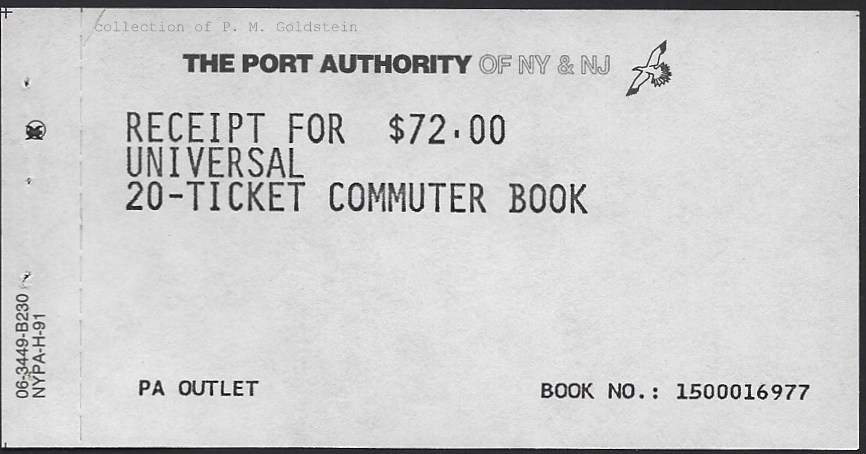 |
PANYNJ
"Universal" Issue - 9/91 - 20 ticket, $72.00, commuter book / $4.00 scrip
20 tickets for $72 ($3.60 value each scrip) but
were valid indefinitely
collection
of Philip M. Goldstein |
facsimile signature:
printer:
colors, face:
colors, back:
serial number:
.
notes:
security
underprinting, face:
.
security underprinting, back:
size:
printing codes:
PA form
. |
none
unknown
lavender, white head of Statue of Liberty
lavender, with instructions
OCR-A font in black, lower left of tickets, covers
are sans-serif bottom right corner
sans-serif outline shaded denomination number on face.
repeating "THE PORT AUTHORITY OF NEW YORK AND NEW
JERSEY" in blue on face only. Ultra violet barcode bottom right corner
none
3 15/16" (width) +
3/8" stub - 2 3/16"
(height) - 0.005" (thickness)
? 3-B890
? C-93
PA 3521 - 10/91 |
.
.
Universal Commuter
20-Ticket Book Tariff $72.00
Non-Refundable
Helvetica on cover, purchased at PA Outlet
s/n: 10 digits: 1500020000 to 1500099999
series: 4/93 |
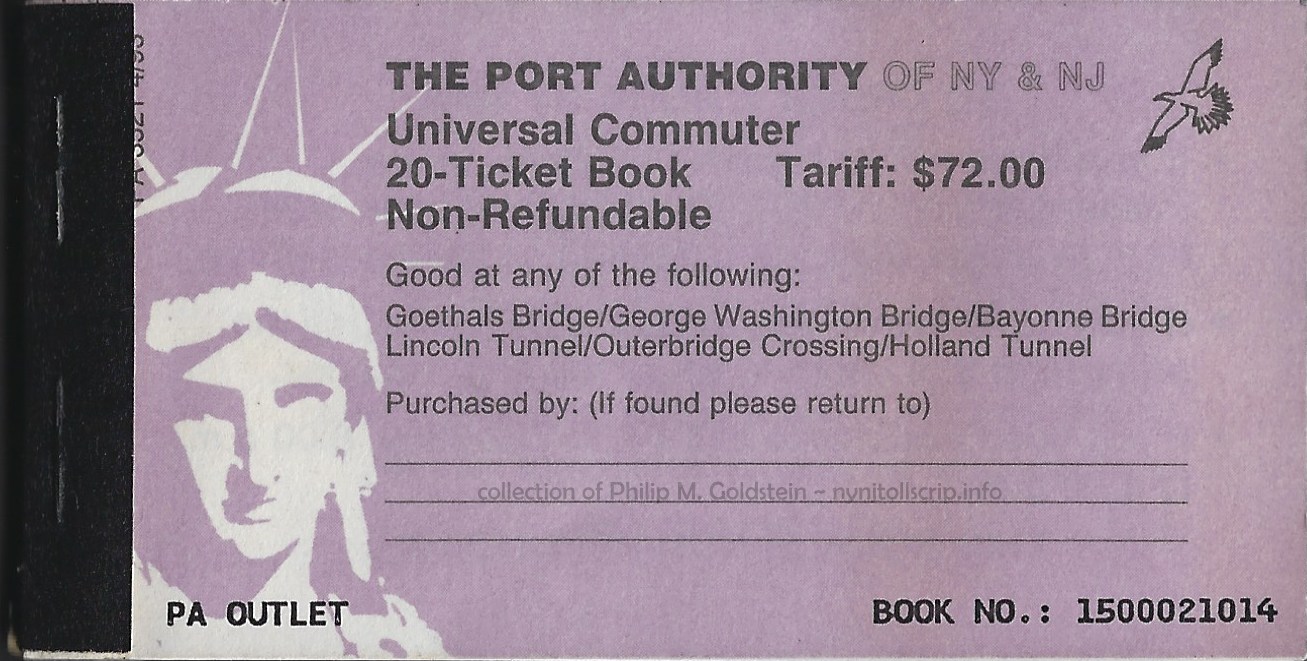 |
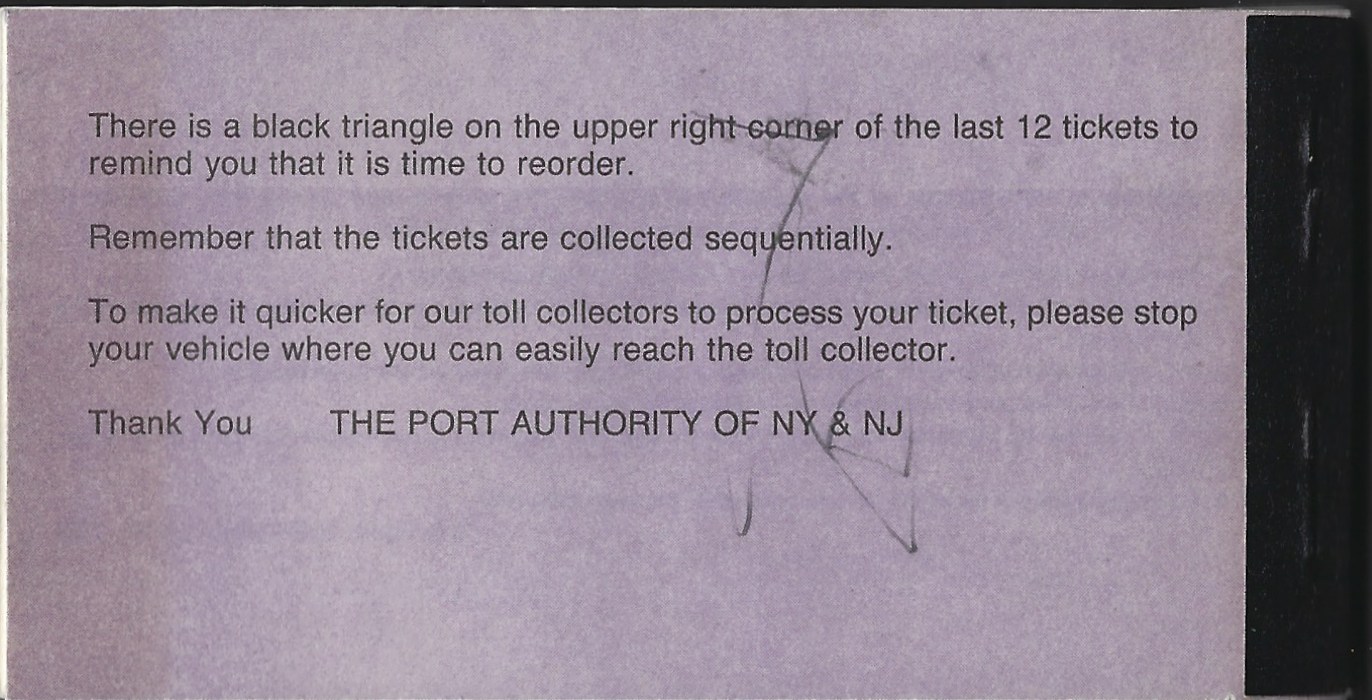 |
 |
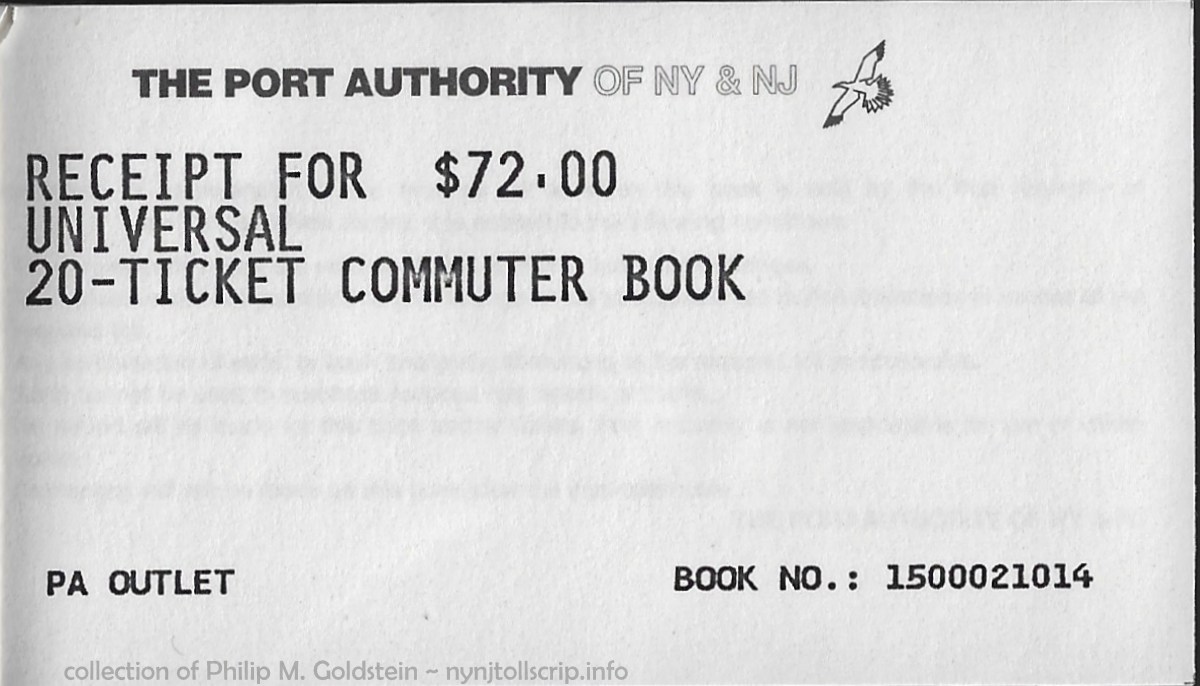 |
 |
PANYNJ
"Universal" Issue - PA 3521 10/93 - 20 ticket, $72.00, commuter book / $4.00 scrip
20 tickets for $72 ($3.60 value each scrip) but
were valid indefinitely
collection
of Philip M. Goldstein |
facsimile signature:
printer:
colors, face:
colors, back:
serial number:
.
notes:
security
underprinting, face:
.
security underprinting, back:
size:
printing codes:
PA form. |
none
unknown
lavender, white head of Statue of Liberty
lavender, with instructions
OCR-A font in black, lower left of tickets, covers
are sans-serif bottom right corner
sans-serif outline shaded denomination number on face.
repeating "THE PORT AUTHORITY OF NEW YORK AND NEW
JERSEY" in blue on face only. Ultra violet barcode bottom right corner
none
3 15/16" (width) +
3/8" stub - 2 3/16"
(height) - 0.005" (thickness)
? 3-B890
? C-93
PA 3521 - 10/93 |
.
.
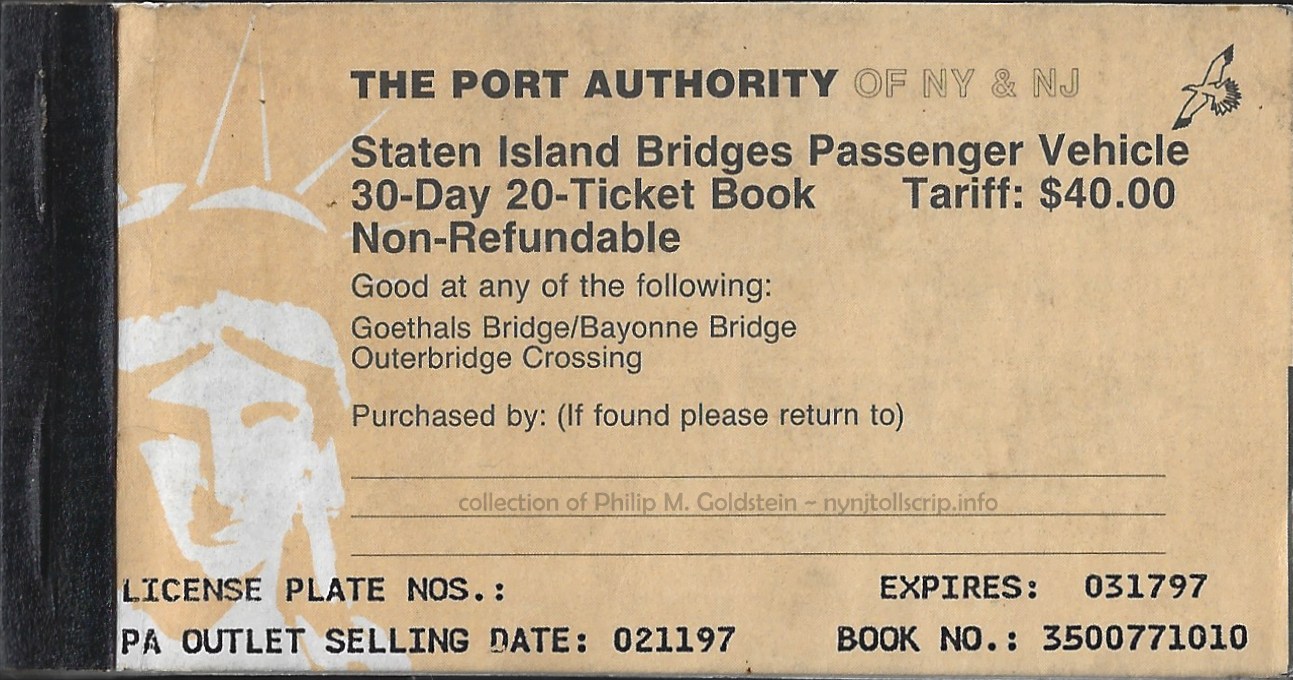 |
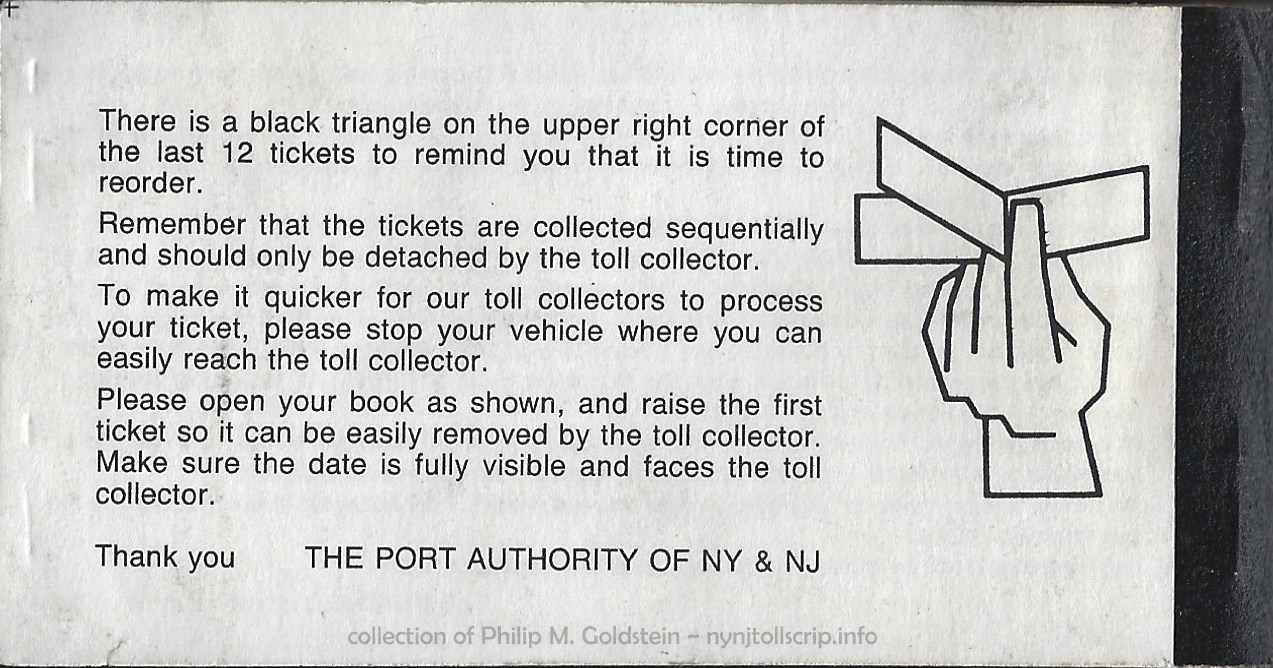 |
 |
 |
 |
PANYNJ Fifth Issue - 4/93 - Staten Island Bridges Passenger Vehicle
3500xxxxxx series serial numbers
30 day, 20 tickets, $40.00
preprinted PA Outlet selling date & expiration date
collection
of Philip M. Goldstein |
facsimile signature:
printer:
colors, cover, face:
colors, cover, back:
colors, ticket, face:
colors, ticket, back:
serial number:
notes:
security underprinting, face:
security underprinting, back:
size:
printing code:
PA form: |
none
unknown
beige, white head of Statue of Liberty
white, with instructions
orange
orange
covers: OCR-B font bottom right corner
repeating PORT AUTHORITY OF NEW
YORK AND NEW JERSEY"
repeating
emblem of Statue of Liberty
3 15/16" (width) +
3/8" stub - 2 3/16"
(height) - 0.005" (thickness)
cover: PA 3521 4/93,
front cover: 06-2107-B700 (A) 4/93
NYPASIOB-A
selvage: NYPAOB-B-91
back cover: 06-4109-B230 BACKER (J)
NYPA-J-93 |
.
.
.
.
PANYNJ
End of Scrip Acceptance - 2012
According to the Port Authority of New York and New Jersey
website, acceptance of Port Authority Scrip & Universal Tickets for
toll payments at PANYNJ tunnels and bridges ended on June 30, 2012.
While they offer a refund program and you may return your
Port Authority Scrip and Universal tickets to the PANYNJ for a full
refund of the price paid, keeping in mind the monetary value of these
tickets is 10 percent less than their face value; i.e.: a ticket with a
$4 face value is redeemed at $3.60.
However!
I am willing to significantly pay more than face value to add needed
examples and issues,
including complete, partial books or empty book covers to my collection.
How
much I will pay depends on several factors:
*
whether I have the issue or not (and even if
I have issues, I may need extras for trade)
*
how many of each example you have
*
the overall condition they are in, and
*
whether they are loose, still attached in either a partial or full
book, or if you have book cover only.
Contact me to find
out: bedt14@aol.com or
by telephone at (936)
396-6103.
|
Serial Number Prefixes
& Designs Observed for PANYNJ Scrip & Commutation Books
| ..
|
|
| . |
|
|
|
|
|
|
|
|
|
|
|
|
|
|
|
|
|
|
|
|
|
|
|
|
|
|
|
|
|
|
|
| PANYNJ |
H4
purple |
1973
1975 |
Passenger
Auto - 20 ticket / 30 day / $10.00
all crossings
Good Until October 15, 1973 - s/n 003 525555
Good Until June 7, 1975 - s/n 5224095
s/n 1 828604 (gsc) |
|
|
|
003
prefix |
|
|
|
|
|
|
|
|
|
|
|
|
|
|
|
|
|
|
|
|
|
|
|
|
.
|
|
|
|
|
|
|
|
|
|
|
|
|
|
|
|
|
|
|
|
|
|
|
|
|
|
|
|
|
|
|
|
| PANYNJ |
H4
red |
1977
1979 |
Passenger
Auto - 20 ticket / 30 day / $20.00
all crossings
Good Until February 10, 1977 - 1202926 (roman)
Good Until October 31, 1979 - 1547270 (helvetica) |
|
|
|
|
|
|
|
|
|
|
|
|
|
|
|
|
|
|
|
|
|
|
|
|
|
|
|
Southern
Coupon |
.
|
|
|
|
|
|
|
|
|
|
|
|
|
|
|
|
|
|
|
|
|
|
|
|
|
|
|
|
|
|
|
|
| PANYNJ |
H4
blue |
1980 |
Passenger
Auto - 20 ticket / 30 day / $20.00
all crossings
Good Until April 29, 1980
Good Until June 18, 1980 |
|
|
|
|
|
|
|
|
|
|
|
|
|
|
|
|
|
|
|
|
|
|
|
|
|
|
|
|
| . |
|
|
|
|
|
|
|
|
|
|
|
|
|
|
|
|
|
|
|
|
|
|
|
|
|
|
|
|
|
|
|
| PANYNJ |
H5 |
1976
1977 |
Passenger
Auto
Good Until December 31, 1976 - s/n 002 057443
Good Until December 31, 1977 -
s/n 002 221704 |
002 |
Rand McNally
Osceola Graphics |
| . |
|
|
|
|
|
|
|
|
|
|
|
|
|
|
|
|
|
|
|
|
|
|
|
|
|
|
|
|
|
|
|
| PANYNJ |
CP |
1980 |
Carpool
Automobile - 60 ticket / 6 month / $30.00
all crossings
Good Until December 1980 |
s/n
and 00 prefix s/n |
Southern
Coupon |
| . |
|
|
|
|
|
|
|
|
|
|
|
|
|
|
|
|
|
|
|
|
|
|
|
|
|
|
|
|
|
|
|
| PANYNJ |
EPP |
? |
Employees
Personal Pass - 0062150
PA-378-69 |
|
|
|
|
|
|
|
|
|
|
|
|
|
|
|
|
|
|
|
|
|
|
|
|
|
|
|
|
n/p = no prefix
bold
italics = in my
collection |
|

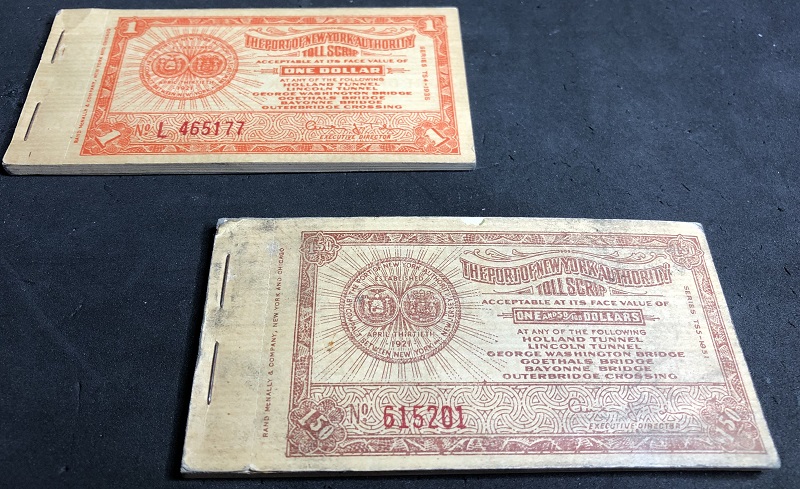
Known Types of Books - Scrip & Commutation - 1935
to ?
Scrip - PoNYA
1935-1972
. |
| series |
issue
dates |
used for |
face
value
per ticket |
actual
value |
book
qty
"# of trips" |
good
for |
book
purchase price |
| TS2 |
1935 |
all
vehicles |
50¢
|
45¢ |
25 |
until
used |
$11.25 |
| TS3 |
1935 |
all
vehicles |
75¢
|
67.5¢ |
25 |
until
used |
$16.88
(?) |
| TS4 |
1935 |
all
vehicles |
$1.00 |
90¢ |
24? |
until
used |
|
| TS4 |
1935 |
all
vehicles |
$1.00 |
90¢ |
25 |
until
used |
$22.50 |
| TS4 |
1969 |
all
vehicles |
$1.00 |
|
|
until
used |
|
| TS5 |
1951 |
all
vehicles |
$1.50 |
$1.35 |
25 |
until
used |
$33.75 |
| TS7 |
1970 |
all
vehicles |
$3.00 |
$2.70 |
unk |
until
used |
unknown |
.
.
Commutation
Tickets & Books - PoNYA
|
|
1928 |
Passenger
Automobile - Staten Island Bridges only |
|
25¢ |
26 |
? |
$8.00 |
H-3
|
1932, 1942/1943 |
Passenger
Automobile - Staten Island Bridges only |
|
23¢ |
26 |
30
days |
$6.00 |
| H-4 |
1951,
1960, 1965 |
Passenger
Automobile |
|
20¢ |
40? |
30 days |
$10.00 |
| H-5 |
1967,
1968, 1969, 1971 |
Passenger
Automobile |
|
40¢ |
25 |
1 year |
$10.00 |
|
1929 |
Motor
Truck, with driver & helper, less than 2 tons |
|
10¢ |
100 |
30
days |
$45.00
(reduced to $40 in 1932) |
|
1932 |
Motor
Truck, with driver & helper, less than 2 tons |
|
40¢ |
50 |
30
days |
$40.00 |
| F-4 |
1934/35, 1939 |
Motor Truck (2 axle) less than 2 tons |
|
40¢ |
25 |
7 months |
$10.00 |
| F-5? |
1939 |
Motor Truck (2 axle) 2 to 5 tons,
Tractor w/ semi-trailer (3 axles) 2 to5 tons
Passenger Auto w/ semi trailer (3 axles) |
|
60¢ |
25 |
7 months |
$15.00 |
| F-6? |
1939 |
Motor Truck (2 axle) more than 5 tons,
Tractor w/ semi-trailer (3 axles) more than 5 tons
Truck Tractor (3 axles) |
|
75¢ |
25 |
7 month |
$18.75 |
| F ? |
1939 |
Bus (2 and 3 axles) |
|
60¢ |
600 |
30 days |
$360.00 |
|
1929 |
Tractor
with Trailer, driver with helper |
|
75¢ |
100 |
30
days |
$75.00 |
|
1930 |
Passenger
Auto? |
|
35¢ |
12 |
7
days |
$4.20 |
|
1930 |
Passenger
Auto? |
|
35¢ |
12 |
7
days |
$4.20 |
|
1930 |
Passenger
Auto? |
|
40¢ |
12 |
14
days |
$4.80 |
|
1969-1972 |
Employees
Personal Pass |
n/a |
n/a |
unk |
unknown |
n/a |
.
..
Known Scrip Issues - PANYNJ
1972-2012
|
|
scrip issue: |
TS-4 /
First |
Second |
Third |
Fourth |
Fifth |
Sixth? |
Seventh? |
Eighth? |
| class |
vehicle description |
wheel arrangement (front = right) |
1969* |
1976 |
1984 |
1987 |
1991 |
2001 |
2008 |
2011 |
| Class 1 |
two axle autos |
(o o) |
|
1.50 |
2.00 |
3.00 |
4.00 |
6.00 |
8.00 |
12.00 |
| Class 2 |
two axle trucks |
[o o] |
1.00 |
2.00 |
3.00 |
6.00 |
8.00 |
12.00 |
16.00 |
24.00 |
| Class 3 |
three axle trucks |
[o]+[o==o] |
|
3.00 |
4.50 |
9.00 |
12.00 |
18.00 |
24.00 |
36.00 |
| Class 4 |
four axles trucks |
[oo]+[o==o] or [o]+[oo==o] |
|
4.50 |
6.00 |
12.00 |
16.00 |
24.00 |
32.00 |
48.00 |
| Class 5 |
five axles trucks |
[oo]+[oo==o] |
|
6.00 |
7.50 |
15.00 |
20.00 |
30.00 |
40.00 |
60.00 |
| Class 6 |
six axle trucks |
[ooo]+[oo==o] |
|
7.50 |
15.00 |
18.00 |
24.00 |
36.00 |
48.00 |
72.00 |
| Class 7 |
two axle auto w/ single axle trailer or motorcycle with single axle trailer |
o+(o-o) or o+ o/o |
|
2.25 |
4.00 |
4.00 |
|
|
|
|
| Class 7 |
two axles auto w/ two axle trailer or motorcycle with two axle trailer |
oo+(o-o) or oo+ o/o |
|
3.00 |
6.00 |
6.00 |
|
|
|
|
| Class 8 |
two axle buses |
{o°°°°o} |
|
2.00 |
|
3.00 |
4.00 |
|
|
|
| Class 9 |
three axle buses |
{oo°°°°°o} or {°°o°°}-{o°°°o} |
|
2.00 |
|
3.00 |
4.00 |
|
|
|
| Class 11 |
motorcycles |
o/o |
|
.50 |
1.00 |
2.00 |
|
|
|
|
Only
colored cells are confirmed to exist (either in my collection or in official photos), and are so
colored in the main face color of the scrip.
Other
colors are presumed to
exist, but their denominations are not known and are not shown at this
time. As a denomination / color is confirmed, it will be added to the
chart.
Sixth,
Seventh and Eighth series have not been seen but are presumed to exist
in some fashion as toll scrip acceptance did not end until June 30,
2012; so it is therefore presumed (but not confirmed) that scrip was issued in
the denomination respective for the 2001, 2008 and 2011 toll
raises.
*
Even though notes of this issue bear the legend "Series TS4-1969"; this
issue was printed after the new name of the agency: "Port Authority of
New York and New Jersey" took effect in 1972. |
|
.
Commutation Tickets & Books - PANYNJ
. |
| series |
issue
dates |
used for |
face
value
per ticket |
actual
value |
book
qty
"# of trips" |
good
for |
book
purchase price |
| H-4 |
1972 |
Passenger
Automobile |
|
|
20 |
30
days |
$10.00 |
| H-4 |
1973 |
Passenger
Automobile |
|
|
20 |
30
days |
$10.00 |
| H-4 |
1975 |
Passenger
Automobile |
|
|
20 |
30
days |
$10.00 |
| H-4 |
1977 |
Passenger
Automobile |
|
|
20 |
30
days |
$20.00 |
| H-5 |
1976 |
Passenger
Automobile |
|
|
12 |
Dec
31, 1976 |
$9.60 |
| H-5 |
1977 |
Passenger
Automobile |
|
|
12 |
Dec
31, 1977 |
$9.60 |
| CP |
1980 |
Carpool Automobile |
|
|
60 |
6
months |
$30.00 |
|
1990 |
Passenger
Vehicle |
|
|
20 |
30
days |
$40.00 |
|
1991 |
Universal
Commuter |
$4 |
|
20 |
until
used |
$72.00 |
|
post
1972 |
Employees
Personal Pass (red number 12) |
|
n/a |
unk |
unk |
n/a |
|
ca.
1977 |
Employees
Personal Pass (black number 12) |
|
n/a |
unk |
unk |
n/a |
Combination
Tickets? |
Another extremely interesting item furnished for this page by
George S. Cuhaj, is this intaglio printers plate and printers proof for
a pass for the bridge & tunnel crossings for the Port of New York
Authority.
It is not known specifically what such a pass would be
used for other than perhaps for city or state government or PoNYA agency
officials and to the best of his recollection, George does not recall
encountering an issued pass conforming to this design.
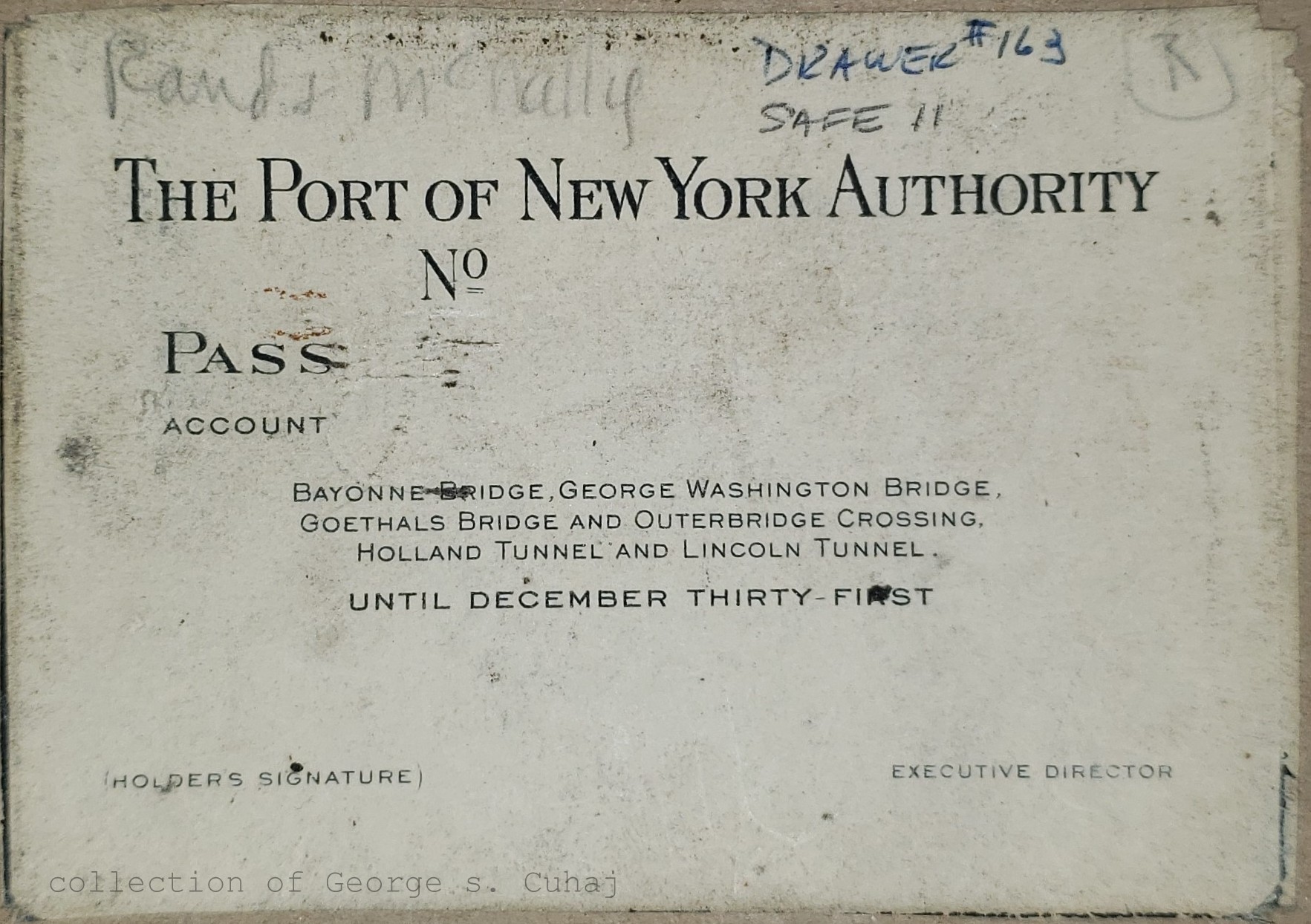 |
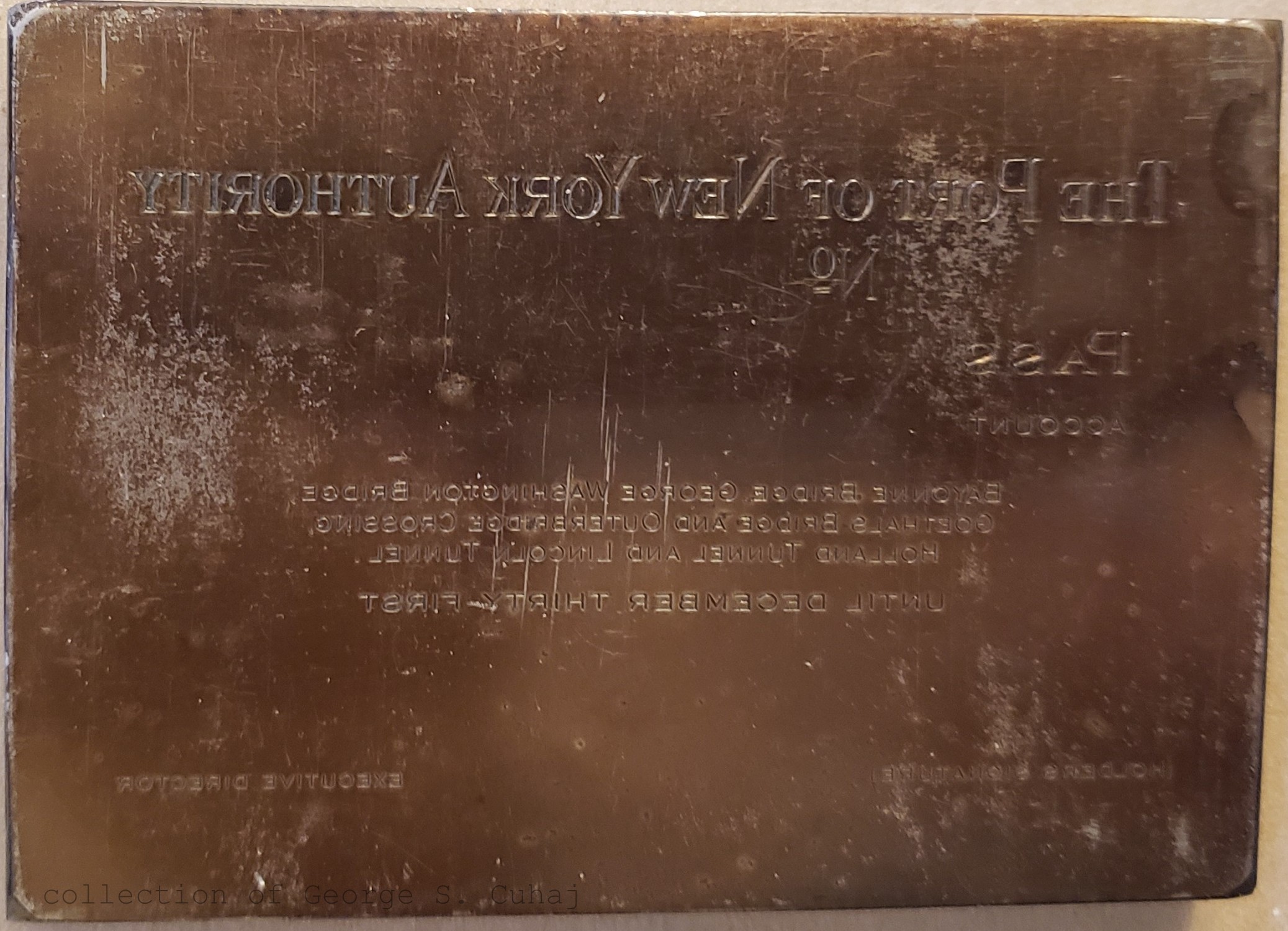 |
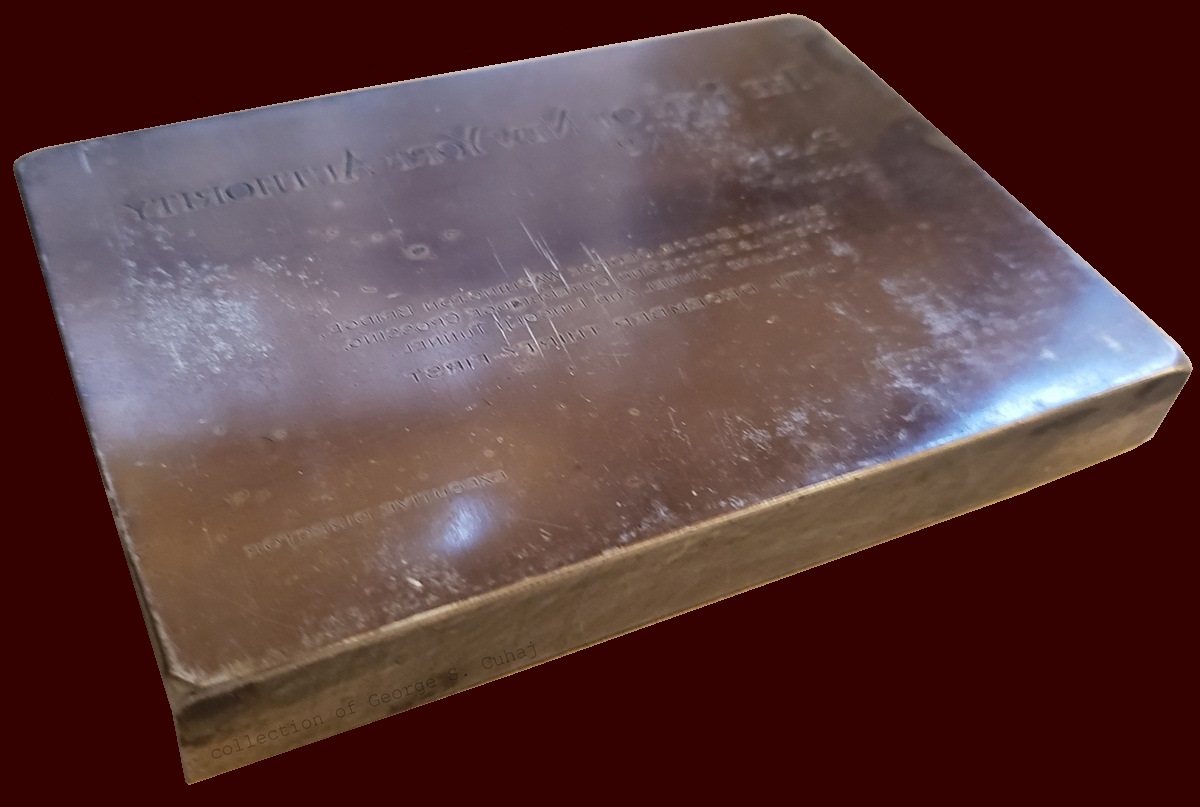
Port
of New York Authority - Pass For Toll Crossings
Rand McNally intaglio plate block with printers proof
collection
of George S. Cuhaj |
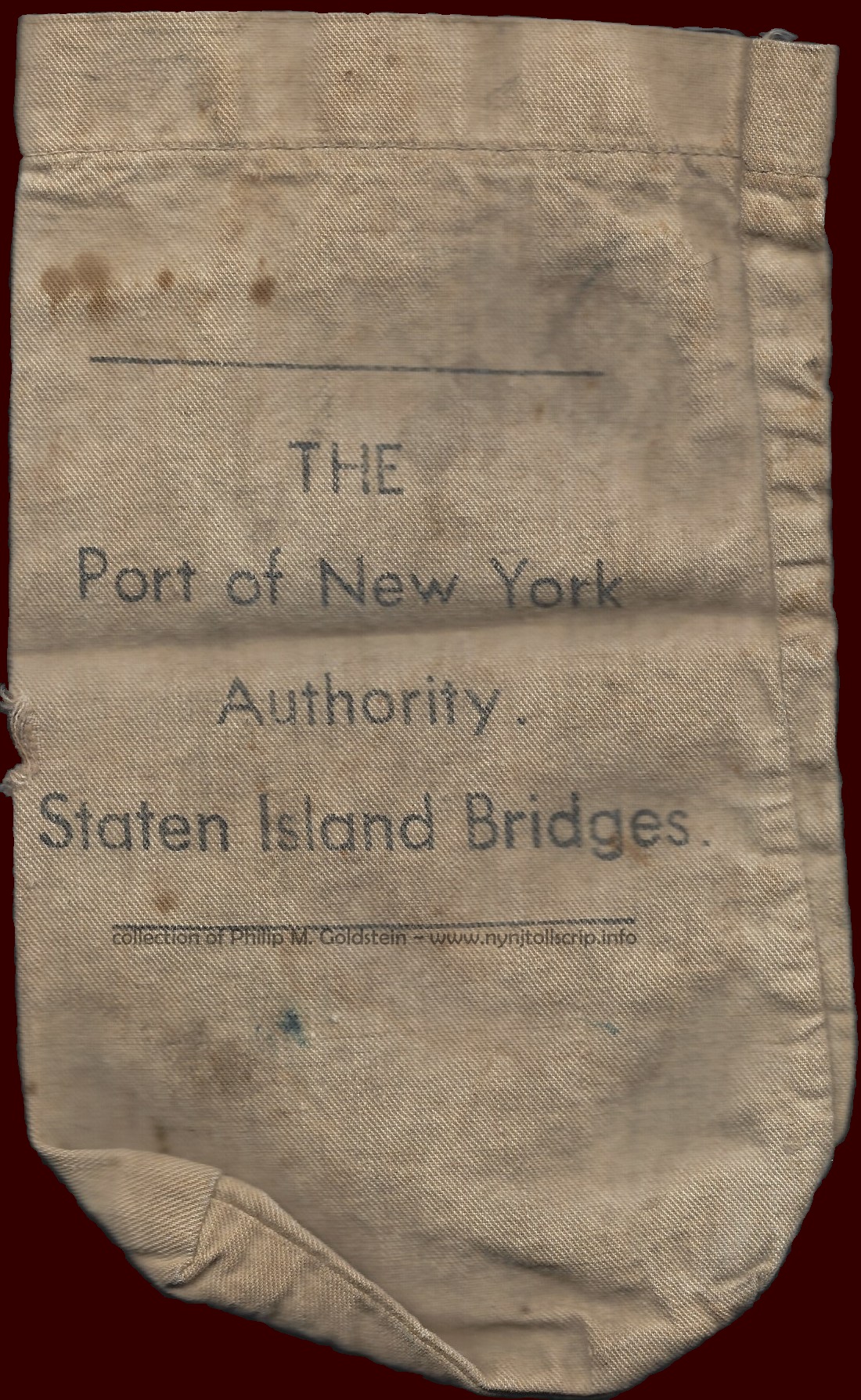 |
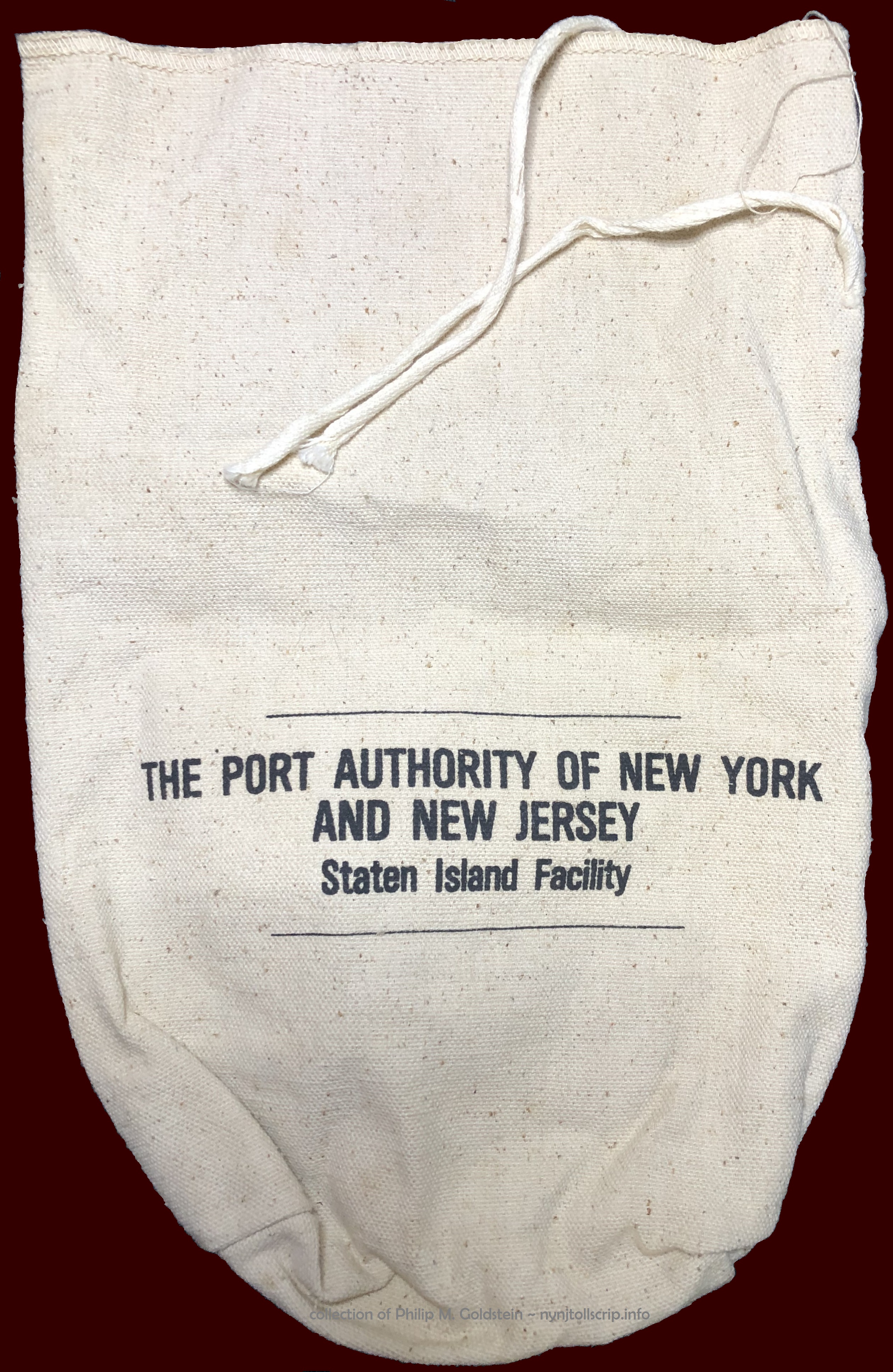 |
change or receipts bag? Pre-1972
5 1/4" x 9"
collection
of Philip M. Goldstein |
change or receipts bag? Post-1972
8" x 12"
collection
of Philip M. Goldstein |
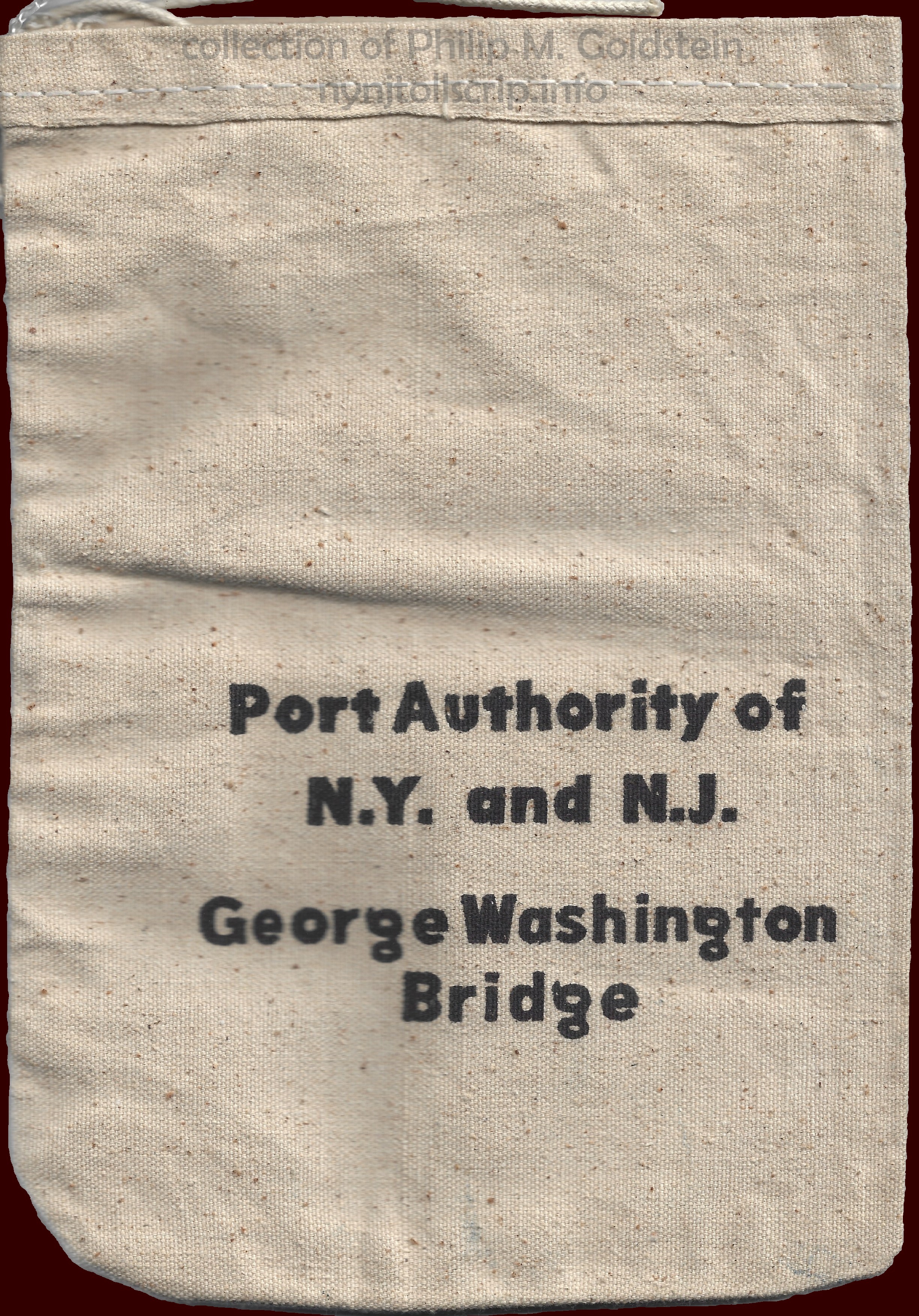 |
change or receipts bag? Post-1972
8" x 11"
collection
of Philip M. Goldstein |

As with the
TBTA toll receipts, they were the most disposable. Who kept them?
I personally had only one PANYNJ Toll Receipt in my
collection. Thanks to George Cuhaj, he was kind enough to supply quite
a few more to add to my solitary piece. Unfortunately, PANYNJ toll
receipts are not stamped with a 2 or 4 digit year upon issuance.
For the ones now shown below, there are two distinct styles of
dater imprint: the older two line and the new single line. The older
two line imprint has the crossing on the top line G. B. (Goethals
Bridge) O. B. X. (Outerbridge Crossing), B. B. for Bayonne Bridge; and
the lane number.
With the new style imprint, all information is on a single
line. It is believed that the first numeral in the "new style"
imprint reflects the year: 0 = 1980 or 1990,, ! = 1971 or 1981, 5 =
1975 or 1985, etc. Also complicating matters is due to a collectors
rush in stamping, the first numeral is sometimes cut off. Usually;
based on the toll amount, we can discern the decade issued. The rest of
the stamp imprint is relatively straight forward and denotes:
crossing, collection
lane,
month, day, and time.
In the upper right corner of almost all the receipts is
a letter and 5 digit number.
One variety seen has this number in the upper left corner under PA 163
and one variety is even blank, with no number. While I am not certain,
I believe this to be a printing contract. Almost all receipts have a
letter 'A', but the letter 'K' is seen as well on a few.
| Bayonne
Bridge |
|
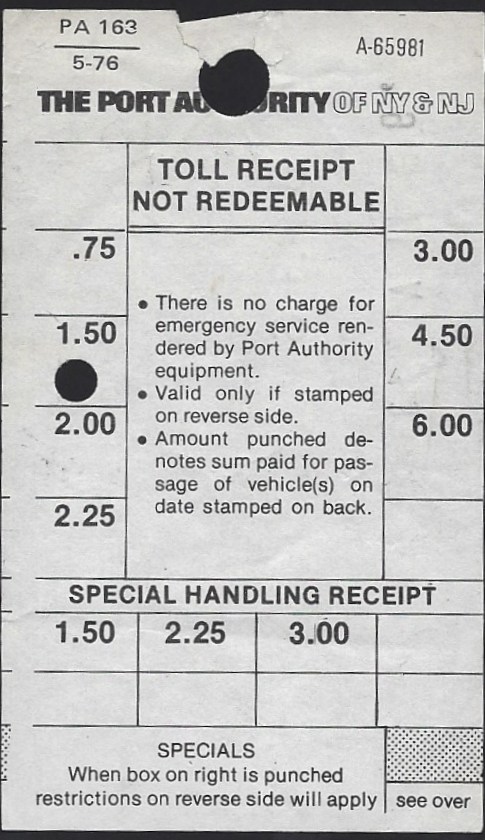 |
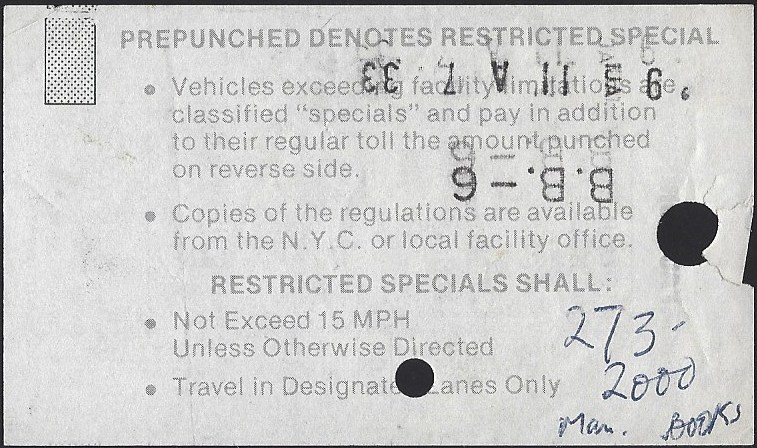 |
|
circa 1979 - Bayonne Bridge
- $1.50
PA 163 - A65981
While
normally any extraneous writing on an issue would be distracting, I
decided to look up the telephone number. It is to the Goethals Bridge
Administration Office!
collection
of Philip M. Goldstein |
.
. |
|
| Goethals
Bridge |
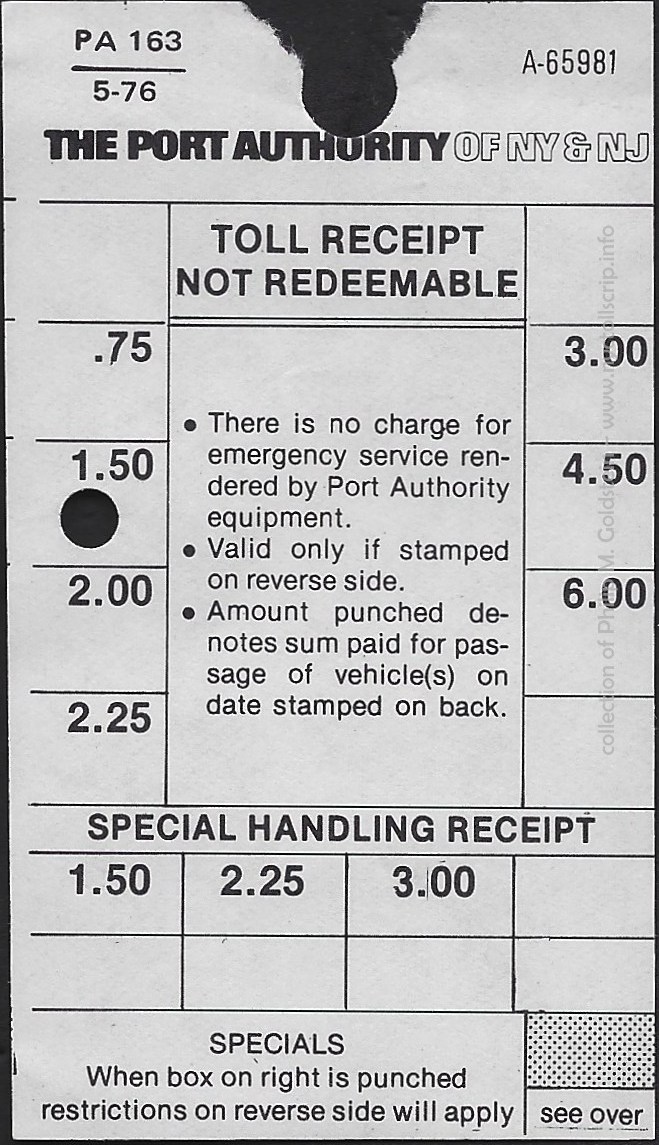 |
 |
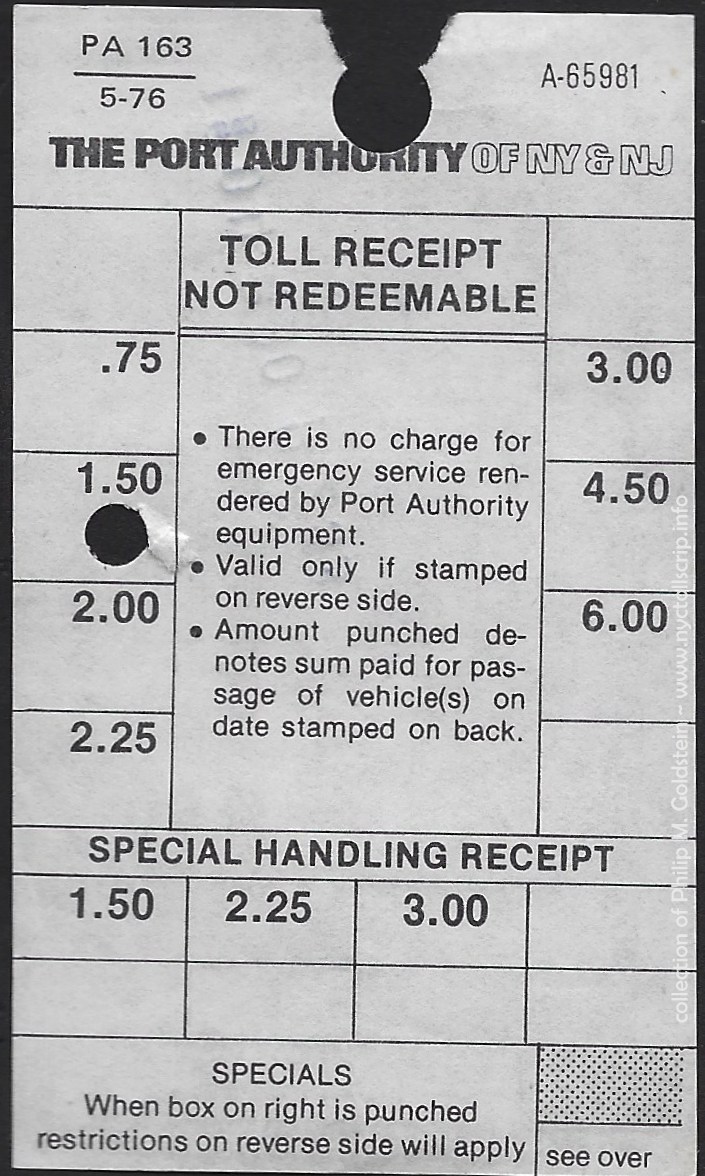 |
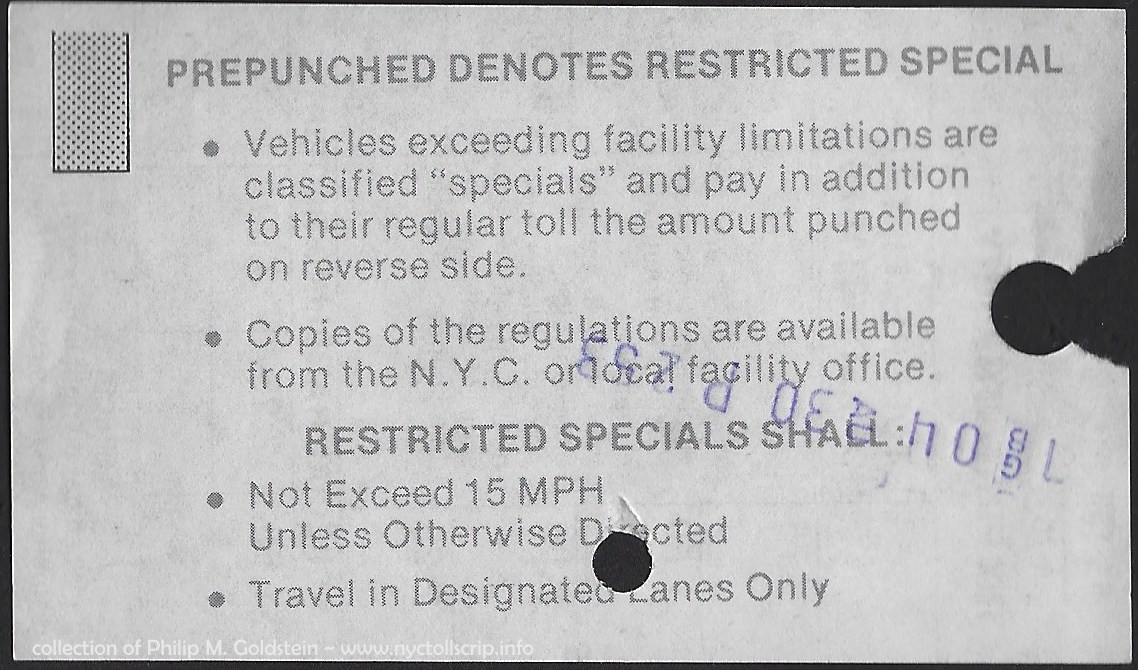 |
G.
B. - 6 - unknown date - 11:25 PM -
$1.50
(old style imprint)
PA 163 / 5-76 - A65981
collection
of Philip M. Goldstein |
7GB04
- August 30, 1977 - 2:53 PM -
$1.50
PA 163 / 5-76 - A65981
collection
of Philip M. Goldstein |
.
. |
|
| Outerbridge
Crossing |
|
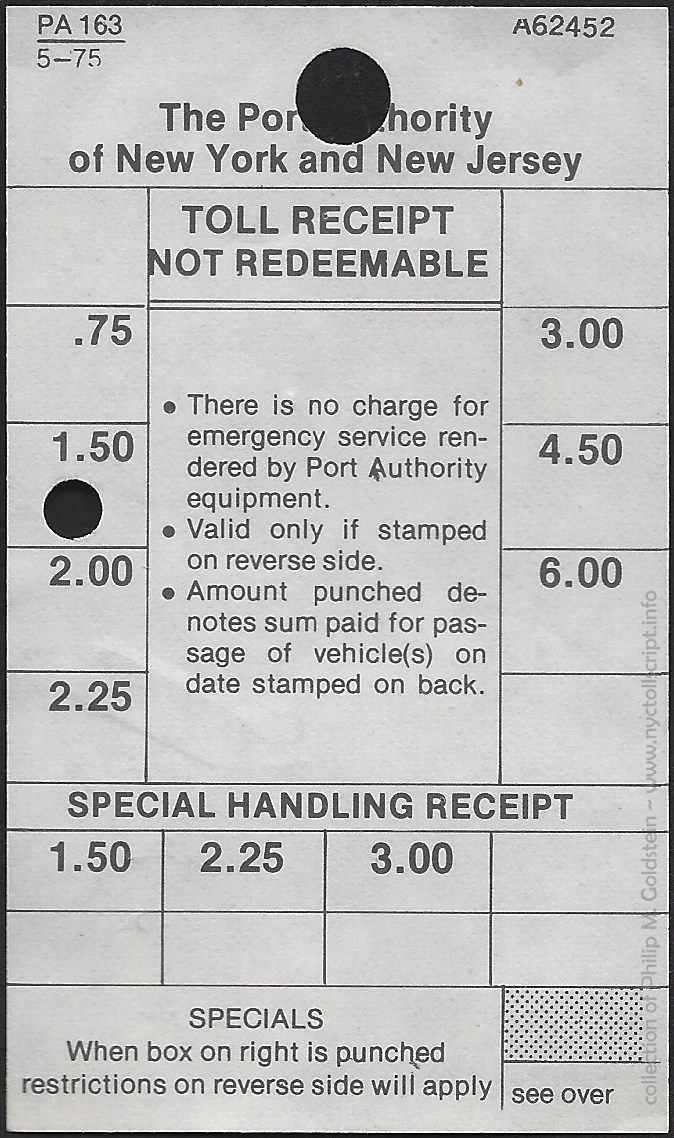 |
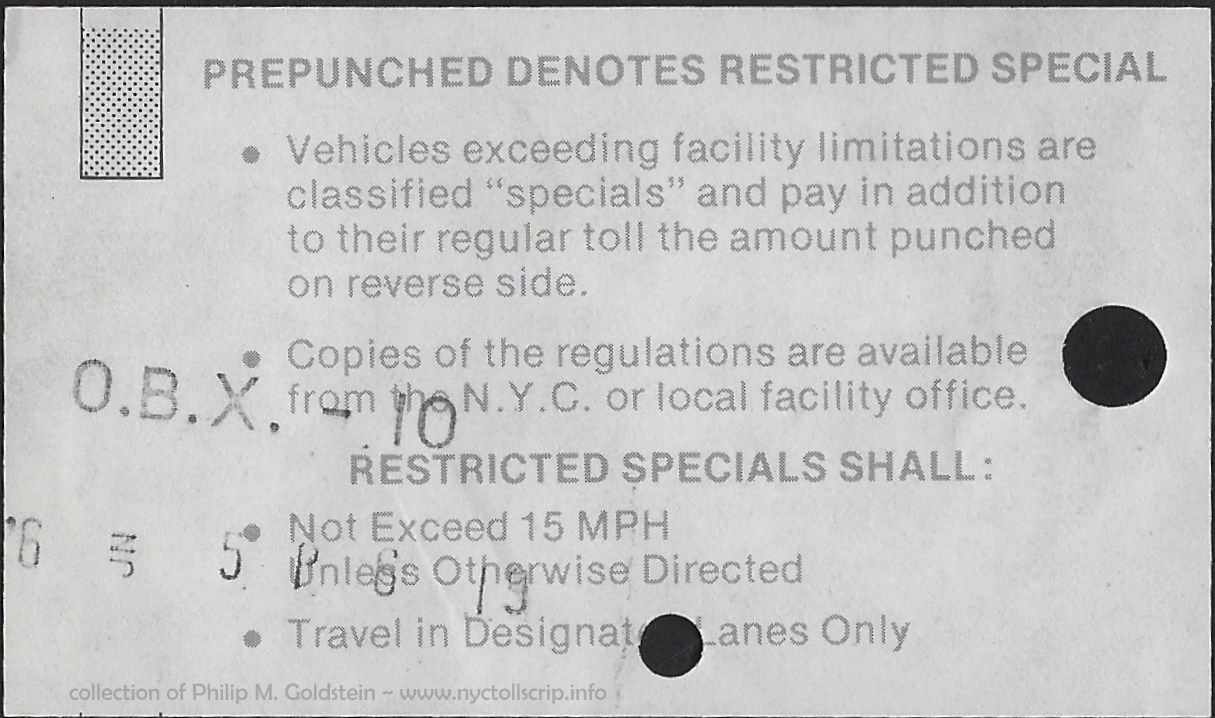 |
|
O.B.X.
- 10 - June 5, 1976 - 6:13 PM -
$1.50
PA 163 / 5-75 - A62452
(old style imprint)
collection
of Philip M. Goldstein |
| . |
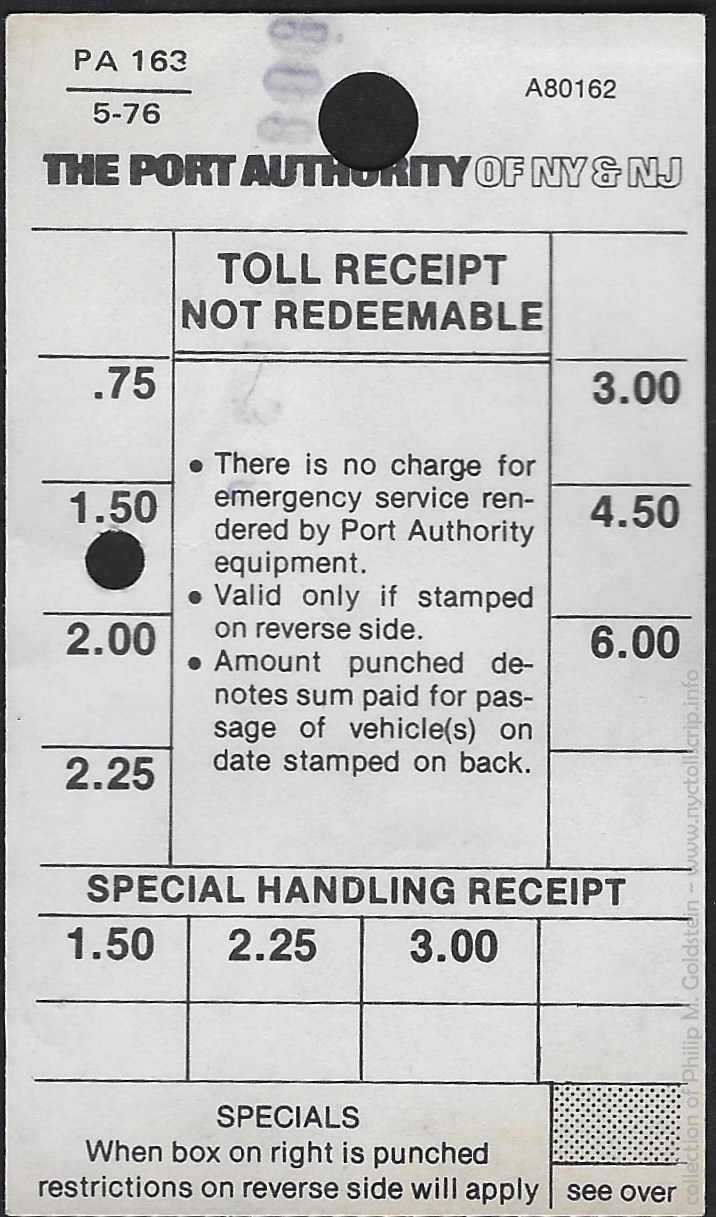 |
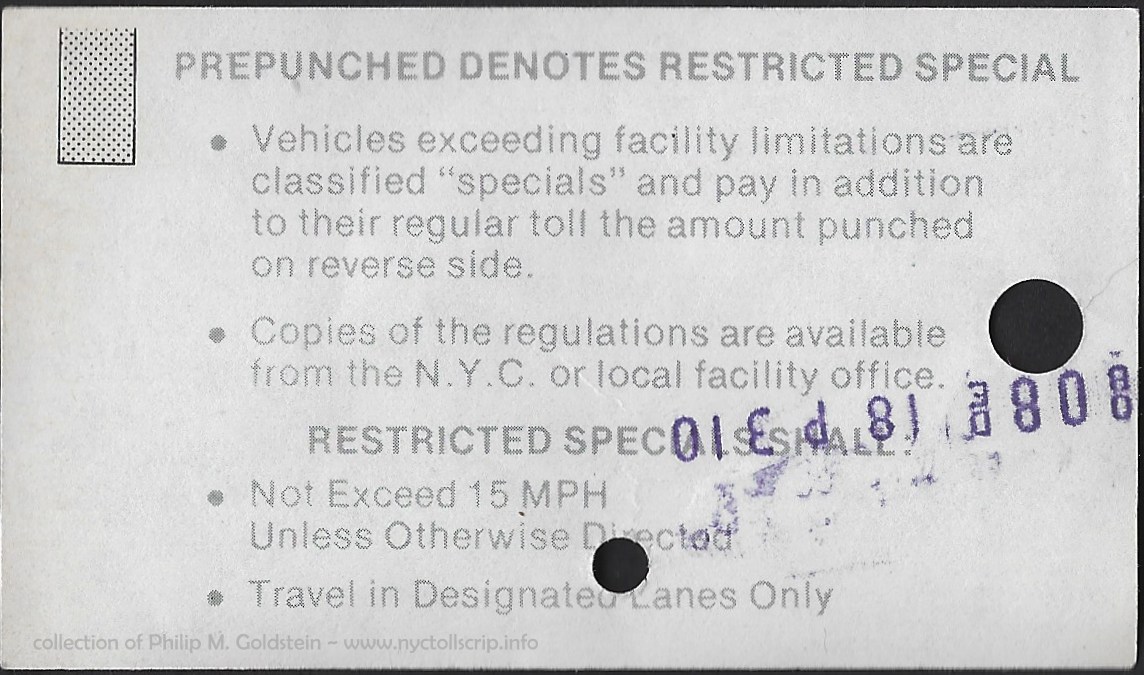 |
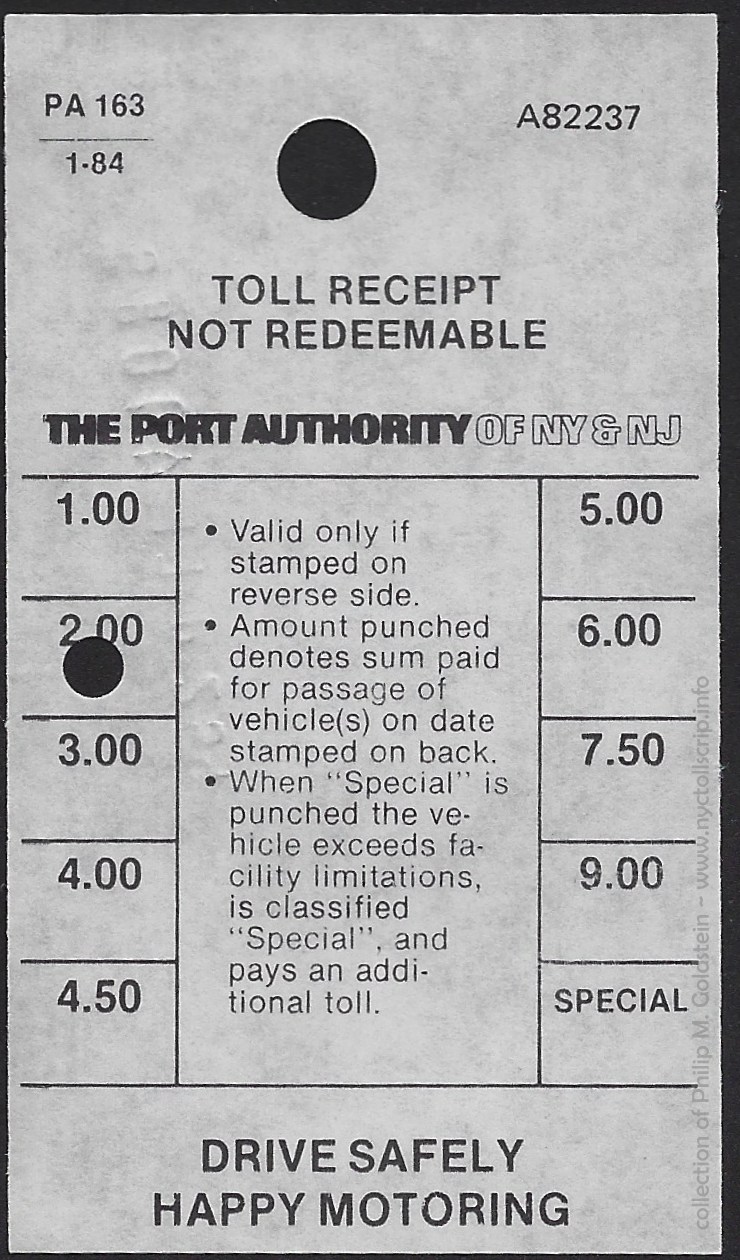 |
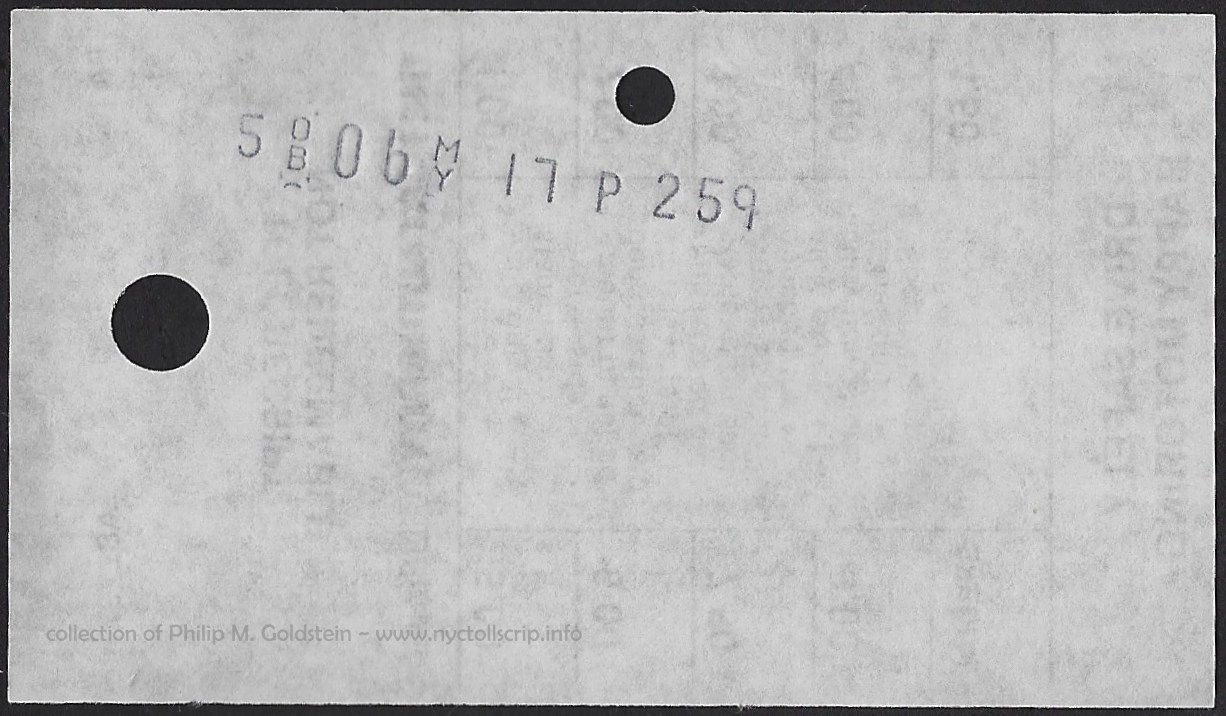 |
_OB08
- December 18 (ca. 1976) - 3:10 PM -
$1.50
PA 163 / 5-76 - A80162
collection
of Philip M. Goldstein |
5OB06
- May 17, 1985 - 2:59 PM -
$2.00
PA 163 / 1-84 - A82237
collection
of Philip M. Goldstein |
.
. |
|
| Holland
Tunnel |
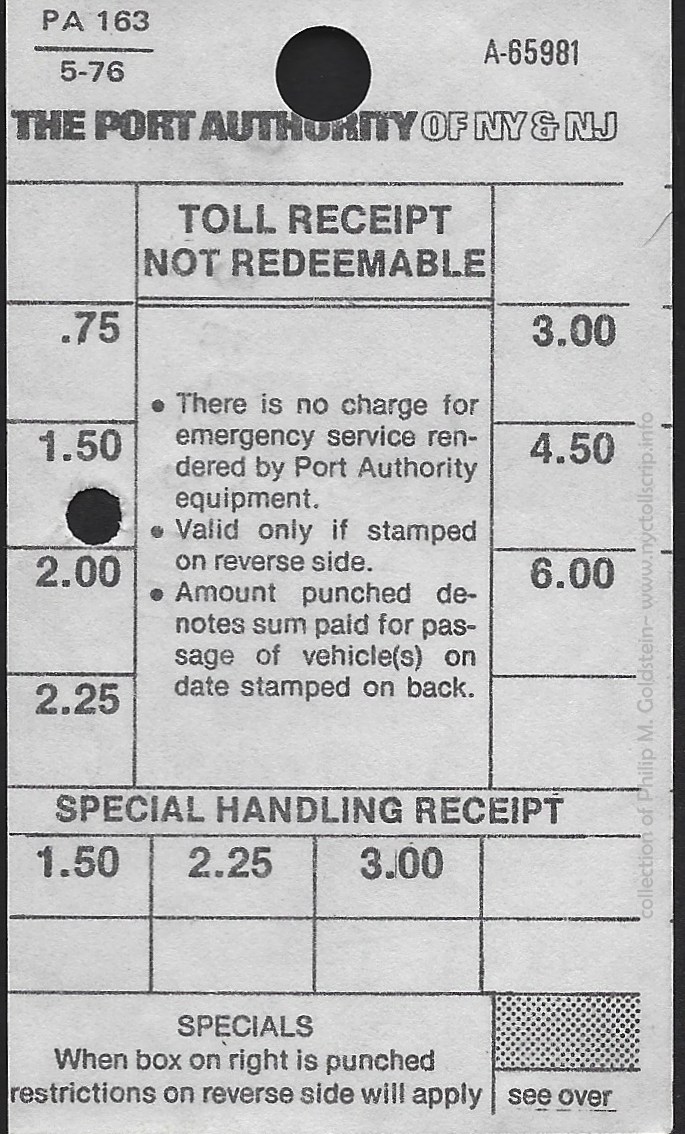 |
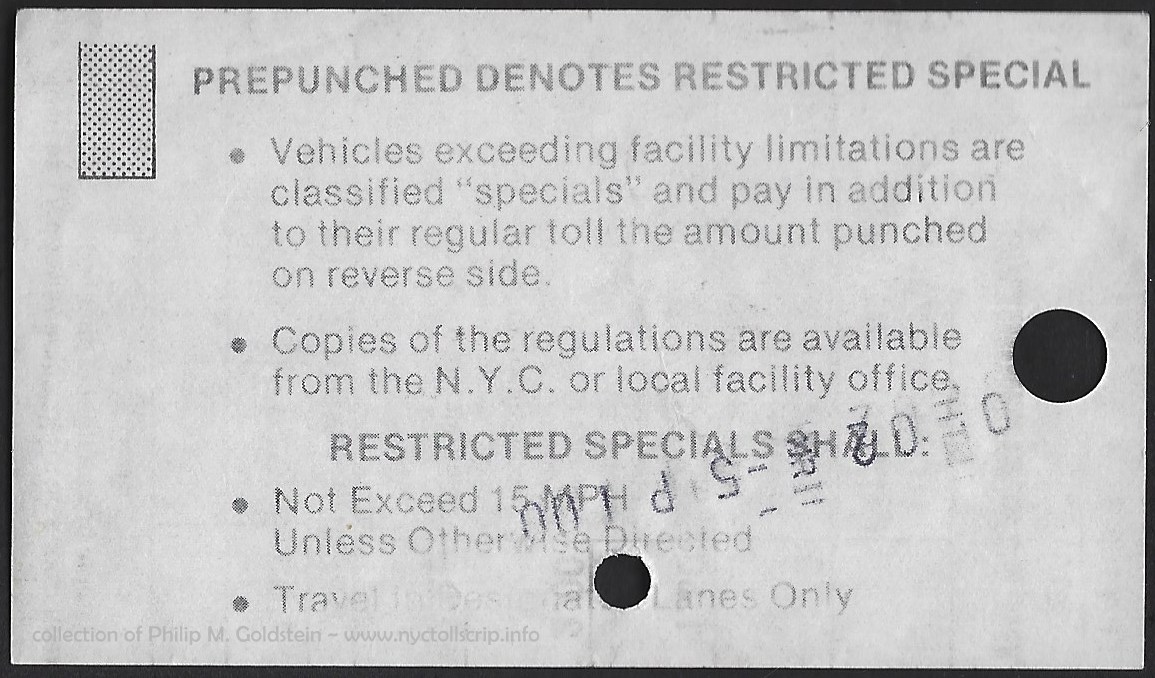 |
 |
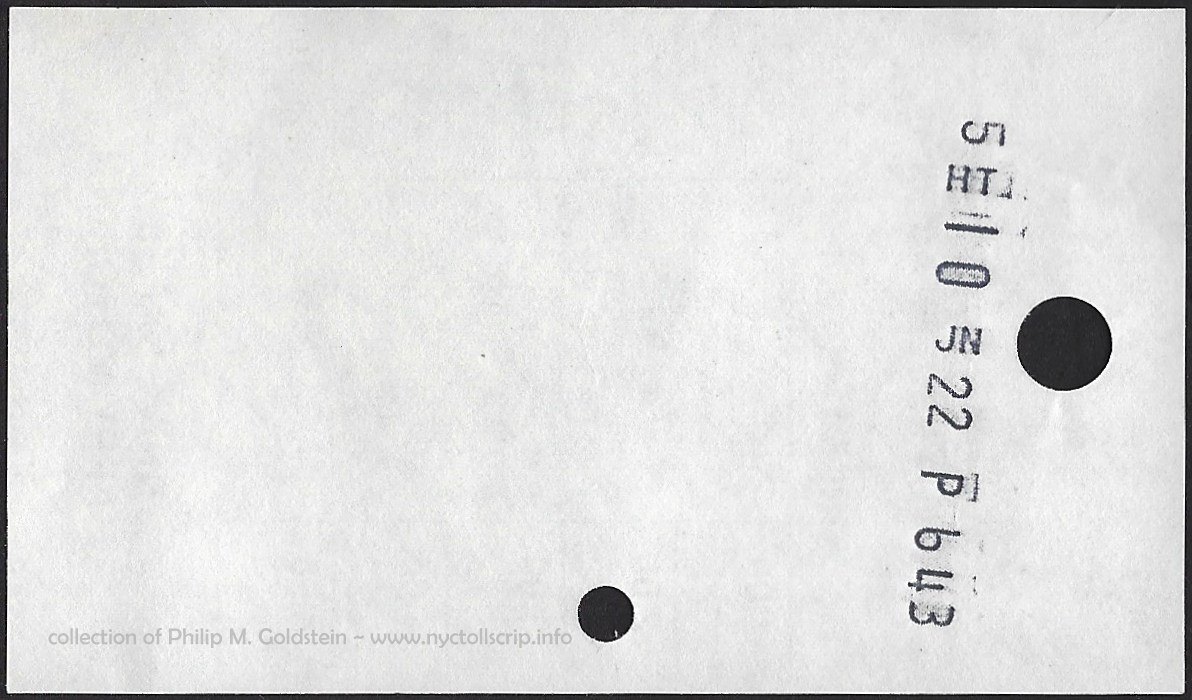 |
0HT02
- March 5, 1980 - 1:00 PM -
$1.50
PA 163 / 5-76 - A65981
collection
of Philip M. Goldstein |
5HT10
- June 22, 1985 - 6:43 PM
- $2.00
PA 163 / 1-84 - A82851
collection
of Philip M. Goldstein |
.
. |
|
 |
 |
|
|
6HT12
- January 12, 1986 - 9:14 AM
- $1.50
PA 163 / 1-84 - K83165
collection
of Philip M. Goldstein |
|
|
| Lincoln
Tunnel |
|
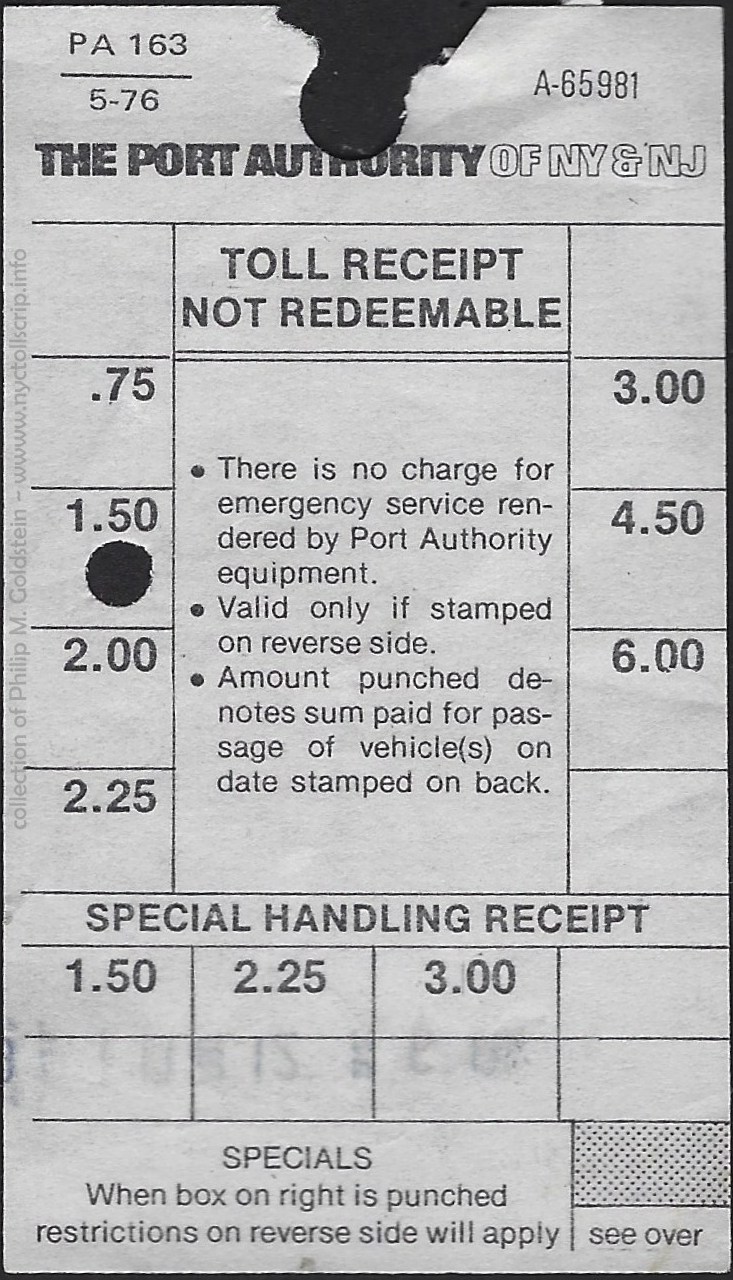 |
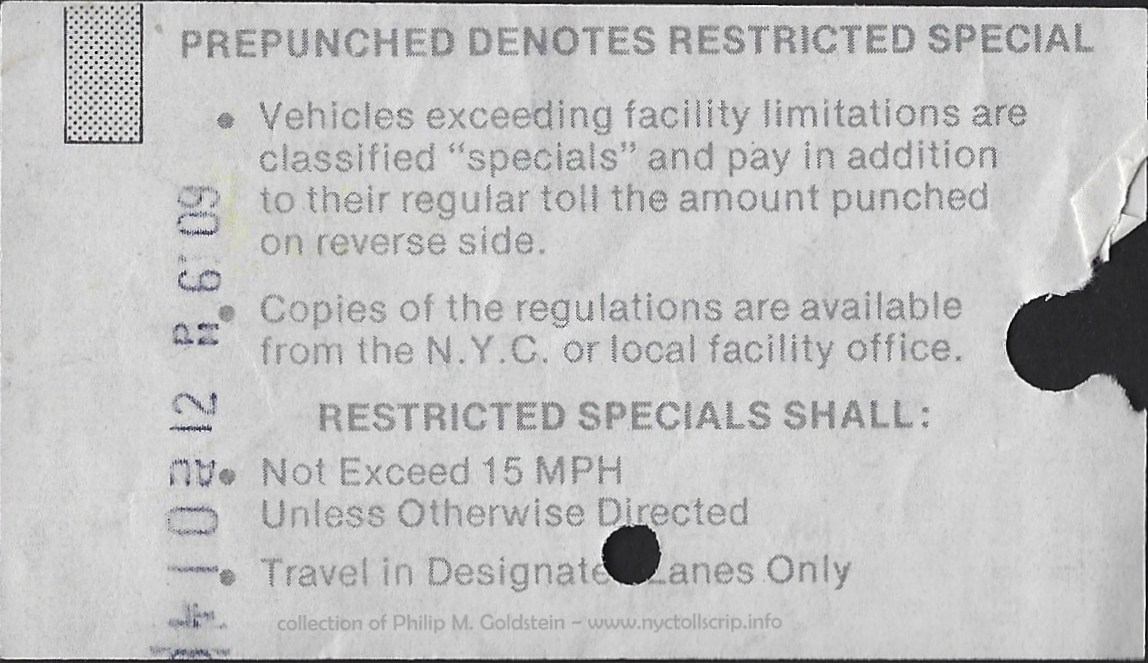 |
|
0LT10
- August 12, 1979? - 6:09 PM -
$1.50
PA 163 / 5-76 - A65981
collection
of Philip M. Goldstein |
.
. |
|
| George
Washington Bridge |
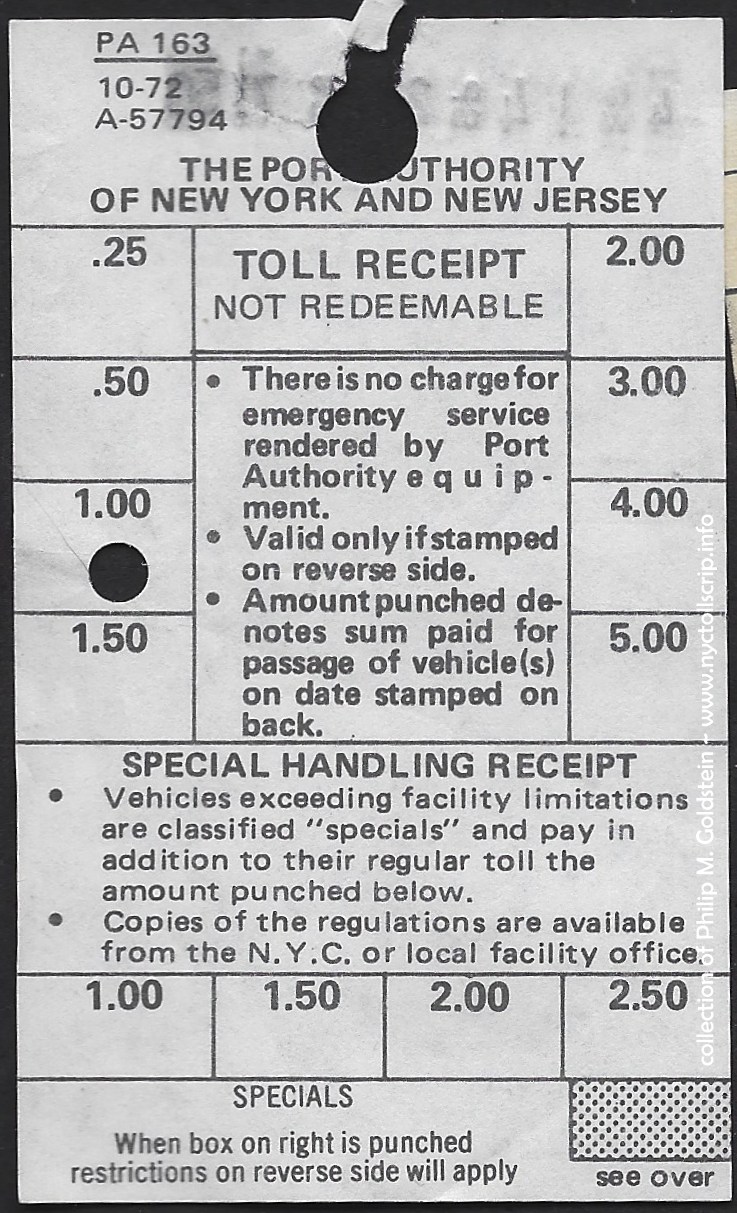 |
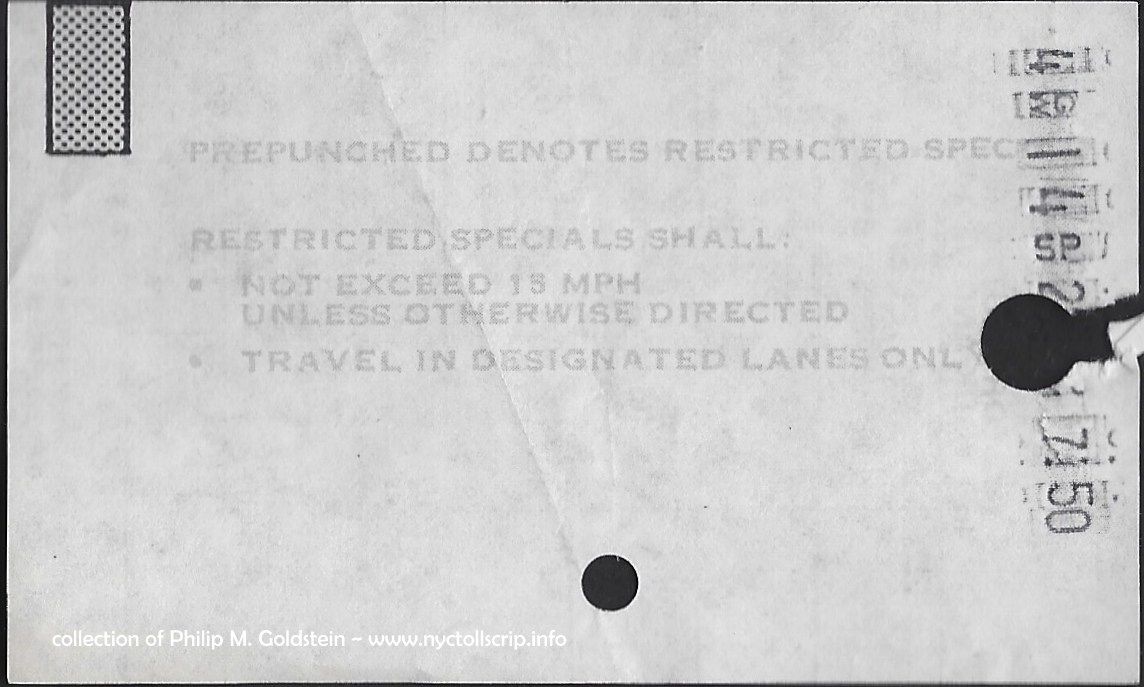 |
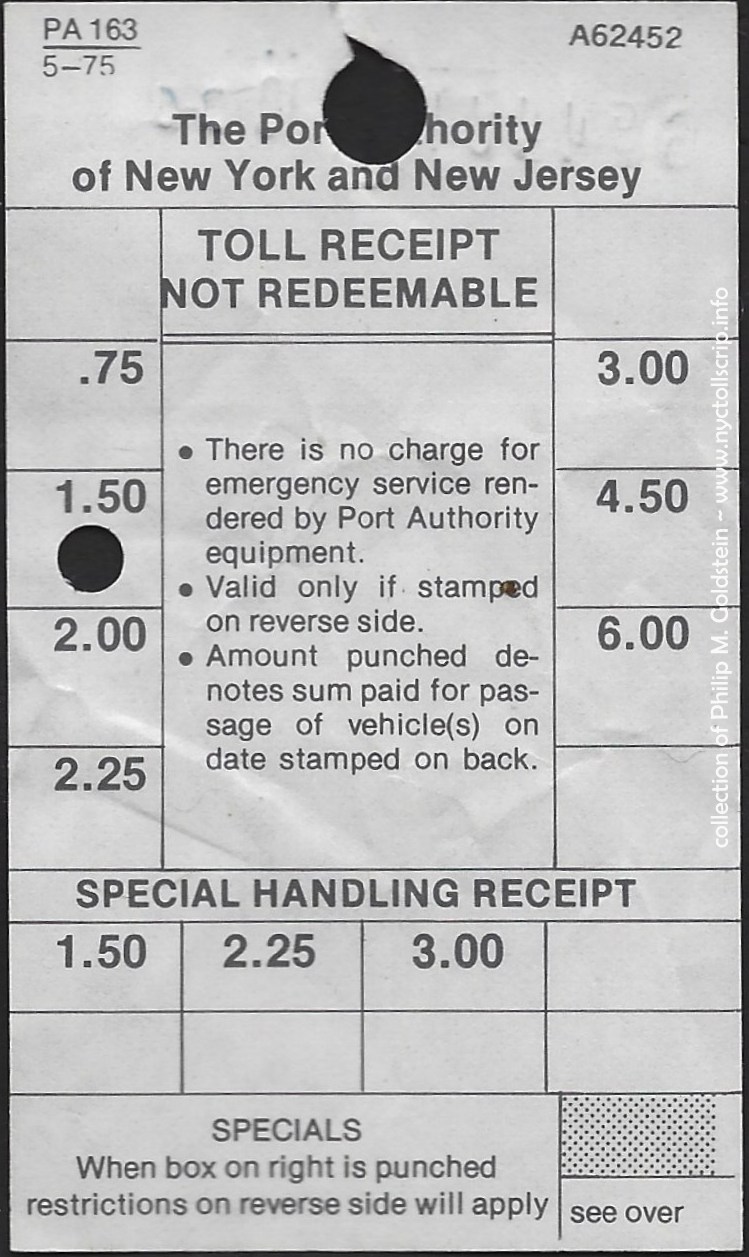 |
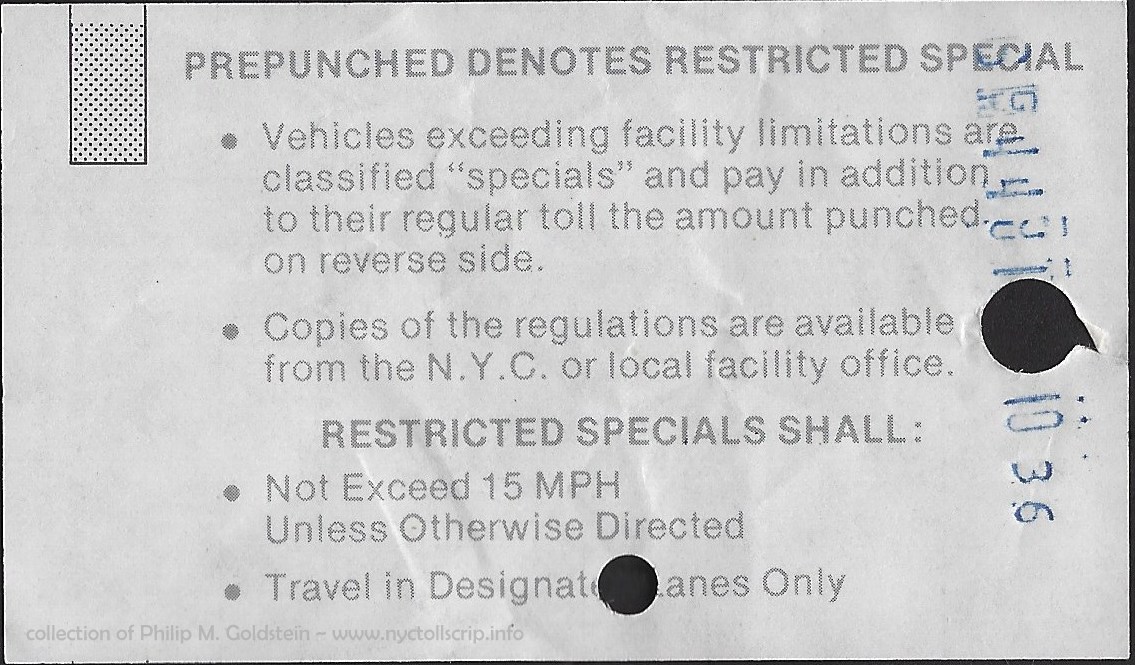 |
4GW14
- September 2_, 1974 - 7:50 PM -
$1.00
PA 163 / 10-72 - A57794
collection
of Philip M. Goldstein |
5GW44
- June 1_, 1976 - 10:36 AM? -
$1.50
PA 163 / 5-75 - A62452
collection
of Philip M. Goldstein |
| . |
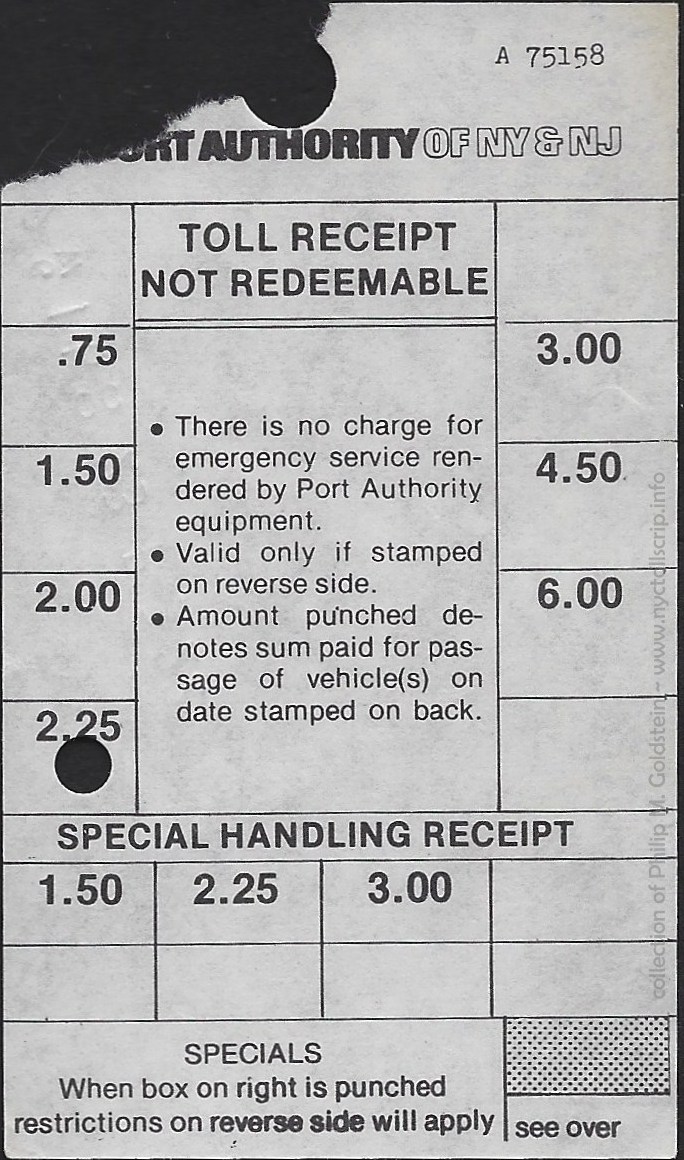 |
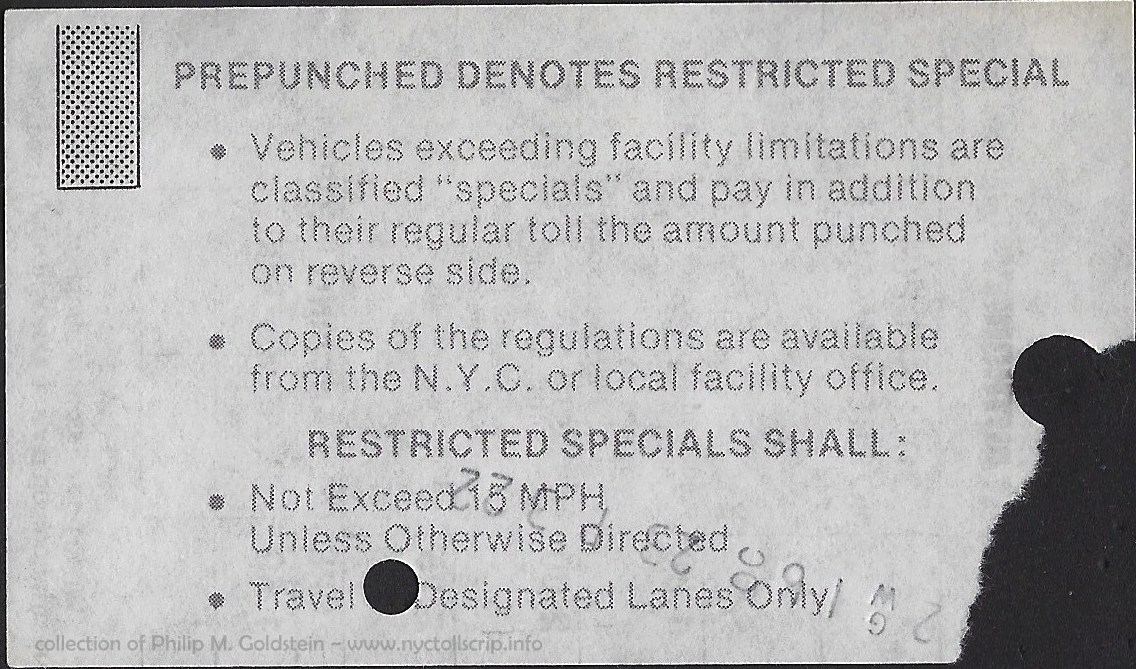 |
|
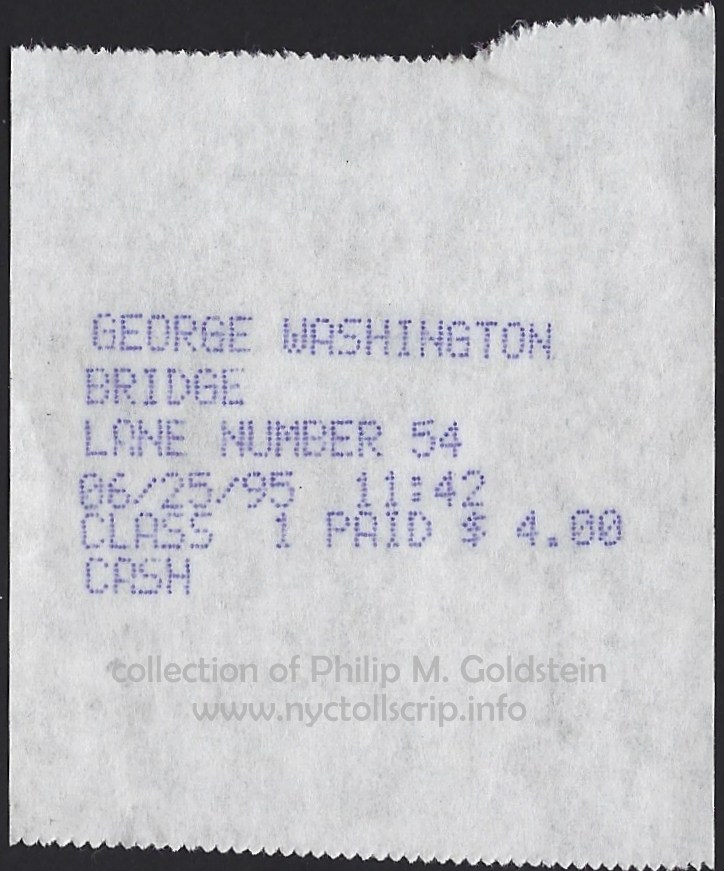 |
2GW16
- October 23, 1982 - 3:22 PM -
$2.25
PA 163 / 5-76 - A75178
collection
of Philip M. Goldstein |
|
June
25, 1995 11:42 AM - George
Washington Bridge - $4.00
collection
of Philip M. Goldstein |
.
. |
|
| unknown
location |
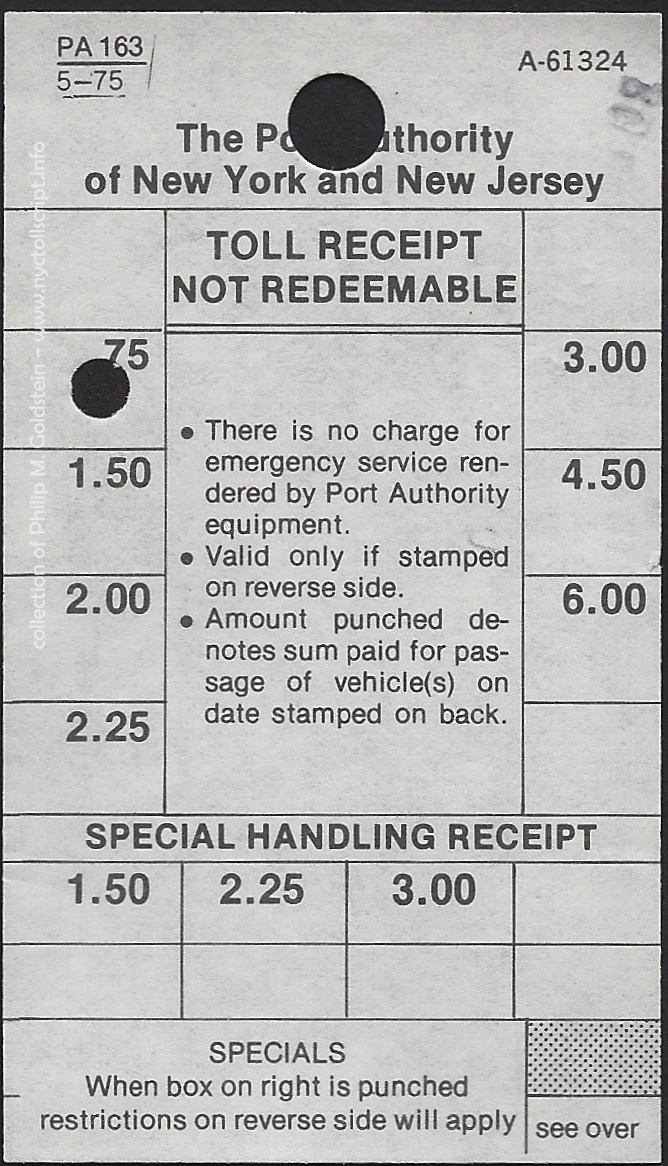 |
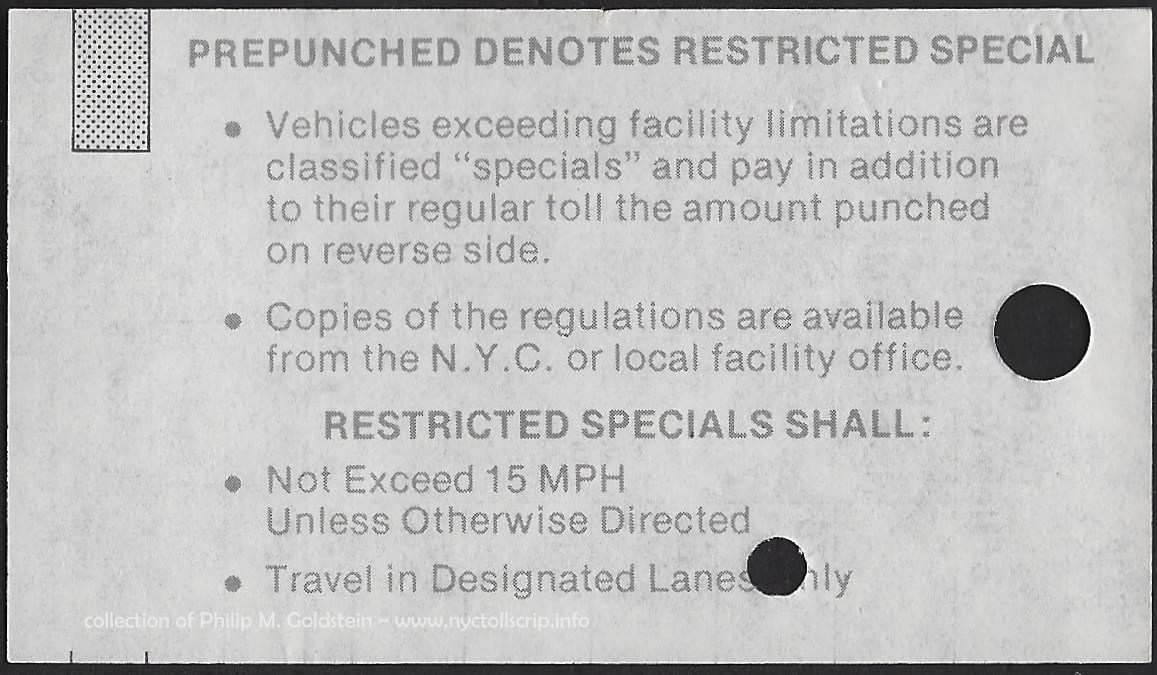 |
|
|
unknown
date - unknown location - .75
PA 163 / 5-75 - A61324
collection
of Philip M. Goldstein |
|

Historical Toll Fares and
Information Time Line
for Port of New York Authority and Port Authority of New York & New Jersey Crossings
Toll fares and information throughout the years. As I researched
the PoNYA and PANYNJ Annual Reports, I came across mentions of scrip,
commutation books and continuation tickets. So I compiled the applicable information in a
chronological order and published them here.
The toll fare structure of the Port of New York Authority
was cumbersome (and has kind of returned to that way, what with Peak /
Off Peak / Overnight Truck Tolls for both cash amounts and E-ZPass
discounts)
The structures were revised numerous times to reflect the
opening of additional crossings, public request and traffic flow. Only
in later years after 1970, did it actually get raised to compensate for
increased costs of operation.
Fortunately, and most conveniently, the Port Authority of
New York and New Jersey has expended the effort and made digital scans
of their of annual reports dating back to their inception in 1921, and
available online for free (always a plus!).
It was surprising to learn that the PoNYA not only charged
per vehicle but for additional passengers as well. Oh, how that
would NOT go over well in this day & age! So in short, while a car
& driver was charged 50 cents, each additional passenger was
charged a nickel. So a passenger automobile, driver and passenger paid
a toll of 55 cents. Large families were big back then, so I just imagine the
scene at a toll booth on a Sunday morning with a family enroute to the
Jersey shore for the day:
|
toll collector:
father
/ husband:
mother
/ wife:
father
(thinking):
toll
collector:
father:
mother
in law:
father:
toll collector:
|
"Good morning sir."
"Good morning to you.
Let's see, theres me; the missus, her mother, (man thinking
to himself "why did the old bag have to come!?!?!")
and three kids.
Junior!
Sit up so the man can see you!"
"Four
kids, sorry." ("Damn
that just cost me a nickel.")
"That'll
be 75 cents please." (husband
rifling through pocket - chink rattle clink jingle),
"Oh
damn I dropped a dime, hang on let me get it."
"Herbert! Watch your
language in front of the children!"
"Yes
mother..." (indistinct
muttering under breath) "There
ya go, 75 cents.
"Thank
you sir, have a nice day. Drive safely please."
|
(And with any luck, his toll fare on the way home was 70 cents
when he buried his mother-in-law at the beach!) LOL
A forgotten but interesting insight to the age; were the tolls
collected for animals ridden, led or herded. Can you just picture 50
head of cattle enroute to the meat packing district in Manhattan being
herded through the Holland Tunnel? And yet we complain now when we are
stuck in non-moving traffic in the tunnel behind a sanitation truck!
Been there done that, and with no air conditioning!
Another forgotten detail: when first opened, automobiles and
trucks could pull up to a toll booth on either drivers side or the
passenger side of the vehicle! That means a drivers helper or passenger
could pay the toll. This arrangement was phased out in the late 1940's,
as not all vehicles has passengers, and traffic would back up at the
drivers side toll booths.
Dates
are of the annual report, and were published at the conclusion of the operating year.
1927
Holland Tunnel opens - Toll Fare Structure
| toll
group |
description |
amount |
| I |
motorcycle |
25¢
|
| II |
passenger
automobiles, with a capacity up to 7 passengers, ambulance or hearse |
50¢
|
| III |
bus,
(up to and including 29 passenger seating capacity) |
$1.00
|
| IV |
motor
truck with driver & helper, less than 2 tons |
50¢
|
| V |
motor
truck with driver & helper, 2 tons to 5 tons |
75¢
|
| VI |
motor
truck with driver & helper, 5 tons and over |
$1.00 |
| VII |
trucks
exceeding 10 tons capacity and not exceeding 15 tons Gross Weight and
not exceeding 12 tons axle load |
$2.00 |
| VIII |
vehicles
admitted by special permit, only |
Special* |
1928
Goethals Bridge, Outerbridge Crossing Open - Toll Fare Structure
| toll
group |
description |
amount |
| I |
motorcycles,
bicycles, horse & rider |
25¢
|
| II |
passenger
automobiles, ambulances, hearses |
50¢
|
|
extra
riders in vehicle |
5¢
|
| III |
horse
drawn vehicle & rider |
50¢
|
| IV |
motor
truck with driver & helper, less than 2 tons |
60¢
|
| V |
motor
truck with driver & helper, 2 tons to 4 1/2 tons |
75¢
|
| VI |
motor
truck with driver & helper, 5 tons and over |
$1.00 |
| VII |
bus |
$1.00 |
| VIII |
tractor-trailer |
$1.00 |
|
Special |
|
| IX |
tractor
only |
75¢
|
|
extra
trailer |
50¢
|
|
special
vehicle (not defined in the annual report) |
$2.00 |
|
pedestrian |
5¢
|
| No tolls are
collected for Army, Navy, Police Department or Fire Department vehicles |
It
was proposed and instituted in 1928, that a commutation rates for
passenger vehicles be instituted:
12 trips good for one week: $4.20 (35¢
per trip) or
12
trips good for two weeks: $4.80 (40¢
per trip)
.
.
1929
Truck
Commutation Rates
As listed in the annual report
for this year, commutation rates for motor trucks was instituted:
- motor truck with driver
& helper, less than 2 tons, 2 axles: 100 trips for $45
- motor truck with driver
& helper, 2 tons to 5 tons, 2 axles: 100 trips for $60
- motor truck with driver
& helper, 5 tons & over, 2 axles: 100 trips for $75
- tractor trailer
with driver & helper, 3 axles: $100 trips for $75
.
1931
George Washington Bridge, Bayonne Bridge opens - Toll Schedule
vehicle
class |
vehicle
description |
single
trip |
| 1 |
passenger
automobile, station wagon, hearse, ambulance, tractor without trailer,
or extra trailers: |
50¢ |
| 2 |
horse
drawn vehicle |
50¢ |
| 3 |
passenger
automobile with 2 wheel trailer |
70¢ |
| 4 |
motorcycle,
bicycle or animals per head |
25¢ |
| 5 |
truck
less than 2 tons, 2 axles |
50¢ |
| 6 |
truck
2 to 5 tons, 2 axles |
75¢ |
| 7 |
truck
more than 5 tons, 2 axles |
$1.00 |
| 8 |
tractor
& semi-trailer, 6 wheel truck, 3 axles |
$1.10 |
| 9 |
tractor-trailer
or truck and trailer with 4 axles |
$1.50 |
| 0 |
bus,
2 axles |
$1.00 |
| 10 |
bus,
3 axles |
$1.10 |
| 11 |
pedestrians |
10¢ |
1932
Toll
Fare Schedule Revised, Combination Tickets Offered
This
year, it is mentioned that the institution of combination tickets,
(that is, in other words; discounted continuous trips using both the
Holland Tunnel and the Bayonne Bridge) was enacted on April 1, 1932.
Combination rates in effect with the Holland Tunnel and Arthur Kill
Bridges were reduced, commensurate with the reduction in single trip
rates. In order to encourage a more extensive demand for
commutation rates applicable on the three Staten Island Bridges,
the 26-trip passenger commutation coupon book was reduced from
$8.00 to $6.00 giving the commuter the benefit of a twenty-three cent
one-way toll compared with twenty-five cents applicable on competing
ferries.
The 60-trip passenger commutation coupon book, which
formerly sold at $15.00 was eliminated. Commutation rates on
small trucks were reduced from forty-five cents to forty
cents per trip, and all commutation truck tickets were issued for
sale on the basis of a minimum of 50 trips per month instead of
100 trips per month. The results obtained from these reductions and
changes have been encouraging.
On April 1, 1932, the original toll schedule was revised
downward in order to partially offset reduced competing ferry
rates. The changes involved the elimination of a higher rate for
sedans, and places all passenger automobiles on a flat rate of fifty
cents on all crossings. At the same time, trucks of capacity up to and
including two tons were reduced from sixty cents to fifty cents.
vehicle
class |
vehicle
description |
single
trip |
continuous
trip (2 hour limit) Bayonne Bridge
& Holland Tunnel |
continuous
trip (2 hour limit) Bayonne Bridge
& Outerbridge or Goethals |
| 1 |
passenger
automobile, station wagon, hearse, ambulance, tractor without trailer,
or extra trailers: |
50¢
|
75¢ |
75¢ |
| 2 |
horse
drawn vehicle |
50¢ |
not
permitted
|
75¢ |
| 3 |
passenger
automobile with 2 wheel trailer |
70¢ |
1.35 |
1.35 |
| 4 |
motorcycle,
bicycle or animals per head |
25¢ |
35¢
not permitted |
35¢ |
| 5 |
truck
less than 2 tons, 2 axles |
50¢
|
75¢ |
75¢ |
| 6 |
truck
2 to 5 tons, 2 axles |
75¢ |
$1.00 |
$1.25 |
| 7 |
truck
more than 5 tons, 2 axles |
$1.00 |
$1.25 |
$1.50 |
| 8 |
tractor
& semi-trailer, 6 wheel truck, 3 axles |
$1.10 |
$1.50 |
$1.75 |
| 9 |
tractor-trailer
or truck and trailer with 4 axles |
$1.50 |
$2.50 |
$2.75 |
| 0 |
bus,
2 axles |
$1.00 |
$1.40 |
$1.50 |
| 10 |
bus,
3 axles |
$1.10 |
$1.50 |
$1.60 |
| 11 |
pedestrians |
.05 |
... |
... |
Also, on November
15, 1931, the toll for passengers in automobiles was abolished.
.
.
1933
Truck Commutation Books
On
November 1, a truck commutation book was discontinued and another
to replace it was instituted: the 25 ticket book good for 6 months
replaced the 50 ticket book good for 1 month issue. These tickets were
good on all Staten Island Bridges. I believe this 25 ticket issue is
represented in Series F-4 1934/1935 by the example in my collection:
 collection of Philip M.
Goldstein
collection of Philip M.
Goldstein
On
November 1st, modification was made in motor truck commutation with the
hope of increasing revenues and benefiting the public. Tickets
comprising fifty coupons formerly offered for sale were good only
for the calendar month in which purchased. These were discontinued
and in place thereof tickets comprising twenty-five coupons were made
available good for six months after the month in which purchased. These
tickets are also good over all Staten Island bridges the same as
formerly.
.
.
1934
Prepaid
Tickets, Scrip Issues
This
years annual report mentions the following: use of the prepaid tickets
was discontinued as of 12/31/1934.
As a substitute for
them, a form of toll scrip in lots of 25 tickets in denominations of 25¢,
50¢, 75¢ and $1.00 was issued. This scrip was acceptable either singly
or can be combined to pay the amount totaling the toll fare required
($1.00 scrip + 50¢ scrip = good
for $1.50 toll). This scrip was now applicable for all crossings.
As such, the existing toll fare structure was now revised to be in multiples of 25¢
so that amounts of less that 25 cent were not necessary eliminating the
need for nickels and quarters (with exception for the 5 cent pedestrian
fare).
| class |
description |
axles |
amount |
| 1 |
passenger
automobiles, 2 axles and horse drawn vehicles (on bridge only) |
2
axles |
50¢
|
| 2 |
motorcycles |
|
25¢
|
| 3 |
bus |
|
$1.00 |
| 4 |
motor
truck with driver & helper, less than 2 tons |
2
axles |
50¢ |
| 5 |
motor
truck with driver & helper, 2 tons to 5 tons |
2
axles |
75¢
|
| 6 |
motor
truck with driver & helper, 5 tons and over |
2
axles |
$1.00 |
| 7 |
tractor
& semi-trailer, less than 5 tons |
3 axles |
$1.00 |
| 8 |
tractor
& semi-trailer, more than 5 tons |
3
axles |
$1.25 |
| 9 |
tractor
& semi-trailer, |
4
axles |
$1.50 |
| 10 |
bicycles,
and animals (per head) |
|
25¢
|
|
pedestrians |
|
5¢ |
.
.
1935
Pedestrian Toll Reduced
Pedestrian toll on
George Washington Bridge reduced from 10 cent to 5 cents.
.
.
1937
Lincoln Tunnel opens: Revision
to Toll Fare Structure
More
revisions to the basic toll fare structure took place this year, in
reflection of the opening of the first tube of the Lincoln Tunnel:
| class |
description |
axles |
amount |
| 1 |
passenger
automobiles, 2 axles and horse drawn vehicles (on bridge only) |
2
axles |
50¢
|
| 2 |
motorcycles;
animals ridden, led or herded |
|
25¢ |
| 3 |
bus |
|
$1.00 |
| 4 |
truck,
less than 2 tons |
2
axles |
50¢ |
| 5 |
truck,
2 tons to 5 tons |
2
axles |
75¢
|
| 6 |
truck,
5 tons and over |
2
axles |
$1.00 |
| 7 |
tractor
& semi-trailer, less than 5 tons |
3 axles |
75¢
|
| 8 |
tractor
& semi-trailer, more than 5 tons or bus |
3
axles |
$1.25 |
| 9 |
tractor
& semi-trailer or trailer |
4
axles |
$1.50 |
| 10 |
pedestrian
with no bicycles |
|
5¢
|
| No
tolls are collected for Army, Navy, Police Department or Fire Department vehicles. |
.
.
1940
Pedestrian Toll Eliminated on George Washington Bridge
.
.
1944
Female
Toll Collectors
During WW 2
The Port Authority continued the practice,
established in 1943, of hiring women
toll
collectors to replace the men that were called away for military service for World War 2.
.
.
1951
Commutation
Tickets Expanded
Effective
September 1, passenger car tolls for frequent users who cannot take
advantage of our commutation tickets were reduced 20 per cent, from 50
cents to 40 cents, through the availability of twenty-five-trip
transferable $10 books of tickets, good for two years in addition to
the year in which they are sold.
Toll scrip,
usable by any type of vehicle in lieu of cash fare, can be bought at a
10 per cent discount in quantities of twenty-five. The regular price of
this scrip is 25 cents, 50 cents, 75 cents, $1.00 and $1.50 each.
Commutation rates have been in effect on the Port
Authority's three Staten Island Bridges for more than twenty years.
Commuters may buy twenty-six-trip tickets for $6.00, or at a rate of 23
cents a trip. You will recall that our passenger vehicle commutation
toll ticket for regular users on our Hudson River crossings was
introduced on June 15, 1950.
The $10 ''H-4" ticket, which is good for thirty days and provides
for forty trips, was used by 32.2 per cent of all passenger cars on
weekdays during a test period in December. The use of this ticket
permits the commuter to make five round trips a week across the Hudson
at a 25-cent rate. As you will kindly note, our experience with
commutation and other reduced-rate tickets is discussed in detail in
the report that follows.
The passenger vehicle commutation toll ticket for regular users
of our Hudson River crossings was available for the full twelve months
of 1951, having been introduced on June 15, 1950. The $10 'H-4''
ticket, which is good for thirty days and provides for forty trips, was
used by 32.2 per cent of all our trans-Hudson passenger vehicles on
weekdays during a test period in December. The use of this ticket
permits a commuter to make five round trips a week across the
Hudson at a rate of 25 rents a trip. It was used by 20.1 per cent of
all passenger cars including those on weekdays.
Saturdays, Sundays and holidays in 1951, as compared with
17.5 per cent in the six and one-half months during which it was
available in 1950. During the year, 32.8 per cent of the weekday
passenger car trips at the George Washington Bridge, 26.9 per cent at
the Lincoln Tunnel and 20.7 per cent at the Holland Tunnel, or 27.5 per
cent at the three Hudson River crossings, were using
commutation tickets. A total of 9,850,249 passenger car trips were
made with commutation tickets in 1951. Commutation rates have been in
effect on the Port Authority's three Staten Island Bridges for more
than twenty years.
Commuters may buy twenty-six-trip tickets for $6.00, or at a rate
of 23 cents a trip. During 1951, 33.5 per cent of the passenger cars
using the Staten Island Bridges took advantage of this low rate. A
combination rate of 75 cents a through-trip for the crossing of two of
the Staten Island Bridges, or a combination trip by way of a Staten
Island Bridge and a Hudson River crossing also has been in effect for
several years.
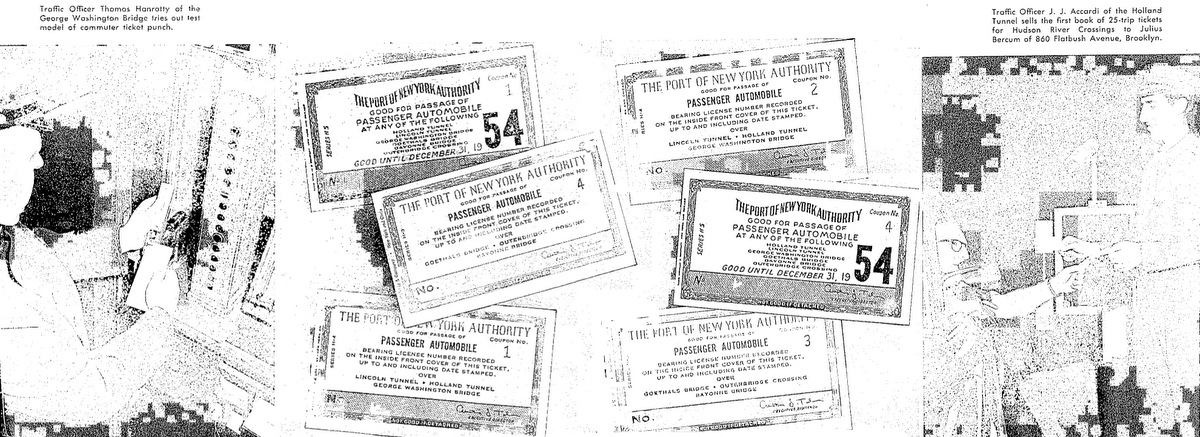
Toll
Cuts Are Made for Regular Passenger Car, Bus and Truck Trips
The
Port Authority Commissioners on June 14, 1951 authorized the second
toll cut in less than fifteen months. Effective September 1, passenger
car tolls for frequent users who cannot take advantage of the
commutation tickets were reduced 20 per cent, from 50 cents to 40
cents, through the availability of twenty-five-trip, transferable $10
books of tickets good for two years in addition to the year in which
they are sold.
Toll scrip,
usable by any type of vehicle in lieu of cash fare, can be bought at a
10 per cent discount in quantities of twenty-five. Scrip is sold
in 25 cents, 50cents, 75 cents, $1.00 and $1.50 denominations.
.
.
1954
Commutation Books
Commutation
Books are now offered for sale at gasoline & service stations,
banks and other select locations to reduce dwell times and congestion
at toll booths. As
a result, the 30 day expiration date of commutation books extended to
35 days to encourage purchase at these locations.
Also, a 40 trip Commutation Book for Staten Island Crossings
is introduced.
.
.
1957
Automatic
Toll Collection Equipment Tested
Trial of automatic toll collection equipment began at the George
Washington Bridge on August 6th as part of the continuing effort to
provide more convenient service for patrons, to improve traffic
handling capabilities and to reduce operating costs. Designed for
passenger-car patrons with exact change, the installation totals four
machines, two in the New Jersey-bound lanes and two in the New
York-bound lanes. Tests are expected to continue into 1958
at which time an evaluation will be made of the installation to
determine its possible permanent utilization at the George
Washington Bridge and other facilities.
.
.
1958
Automatic
Tolls Collection
The
Port Authority's tunnels and bridges personnel have two main
objectives: to provide the most convenient and expeditious service for
patrons and to reduce operating costs. To further these objectives,
research and trial on the feasibility of automatic tolls collection
continued throughout the year.
The machines for automatic service to passenger car
patrons with exact change, which were installed in four lanes at the
George Washington Bridge main plaza in August 1957, have been
constantly improved. Two additional automatic lanes have been installed
on the crossing's Palisades Interstate Parkway plaza. Thus, six lanes
at the George Washington Bridge are now equipped for automatic service
to passenger car patrons.
Experience to date indicates that automatic service
for passenger cars is feasible but can be utilized only to a
limited degree because of approach traffic patterns and the high
percentage of reduced-rate and commutation tickets during peak hours.
Studies are now being made of means for handling ticket traffic
automatically in the same lanes with exact-change traffic. Solution of
this problem will permit more widespread use of automatic service.
.
.
1965
Female
Toll Collector Program
The
civilian toll collector program was considerably accelerated during
1963 as Police Officers were replaced by women toll collectors at
all tolls plazas of the George Washington Bridge. The staff of 90
women who started at the Lincoln Tunnel in October, 1962, was
expanded to a total of 270 women operating both the Lincoln Tunnel and
the George Washington Bridge tolls plazas by the end of 1963.
This expansion was necessary to free Port
Authority police manpower for increased traffic and patrol duties.
By mid-year the toll collector program was a full year ahead of
plan. The program had been launched in 1962 with an intensive
six-month period of preparation which included a mass recruitment
program, uniform selection and procurement, and the establishment of a
tolls training center. With the success of the program at the Lincoln
Tunnel immediately apparent, recruitment began late in 1962 for a
similar program at the George Washington Bridge.
Operations began at the main tolls plaza in April, 1963,
the lower level tolls plaza in August and finally at the Palisades
Interstate Parkway plaza in October. The introduction of women toll
collectors at the Holland Tunnel is scheduled for early 1964.
.
.
1966
Female Toll Collector Program Expanded
The
women toll collector program which began in 1962 at the Lincoln Tunnel
is now in effect at the three Hudson River crossings. The changeover to
women toll collectors permits reassignment of police officers to
specialized police duties. It is expected that civilian personnel will
be utilized at the Staten Island Bridges starting in 1966.
.
.
1970
One
Way Toll Collection
On
August 12, 1970 the Port Authority joined with the New York State
Thruway Authority and the New York State Bridge Authority in starting
a one-way toll collection system on 12 Hudson River and
interstate New York-New Jersey crossings. This new procedure has
sped up the flow of traffic and eased congestion. Operators of all
vehicles now pay the toll on their eastbound trip, and
thereby eliminate the need to stop to pay a toll on the
westbound trip.
The new collection system did not represent a change
in existing rates, because surveys had demonstrated that virtually
all vehicles using the 12 facilities made round trip crossings. In
addition to providing greater comfort and convenience for the
traveler, the procedure has improved the economy and efficiency of
bridge and tunnel operations.
The region-wide system includes
all
the 12 interstate and Hudson River crossings over a 130-mile
distance, as follows: The George Washington Bridge, the Lincoln
Tunnel, Holland Tunnel, Bayonne Bridge, Goethals Bridge and the
Outerbridge Crossing, all operated by the Port Authority; the Tappan
Zee Bridge, operated by the New York State Thruway Authority; and the
Rip Van Winkle Bridge, Kingston - Rhinecliff Bridge, Mid-Hudson Bridge,
Newburgh - Beacon Bridge and Bear Mountain Bridge, all operated by the
New York State Bridge Authority.
.
.
1971
One-Way
Toll Collection
The
one-way toll collection system, begun in 1970, with tolls collected
only in the eastbound direction at all six Port Authority vehicular
crossings, continued to please the public. This change permitted
elimination of unnecessary toll booths at the George Washington
Bridge, the Lincoln Tunnel and the Holland Tunnel. Work at the Bayonne
and Goethals Bridges will be completed in 1972. At the Outerbridge
Crossing certain toll lanes have been closed pending complete plaza
reconstruction.
.
.
1975
Toll Fare Increase
To
finance the bus terminal construction and to prepare to finance other
mass transportation projects, as well as to weight the individual
traveler's choice in favor of public transportation, the Port Authority
made an historical revision to one of its key revenue sources.
On May 5, for the first
time in 48 years, the tolls on its tunnels and bridges were increased
by approximately 50 percent for all except buses and those who form
carpools.
At year-end, a proceeding was pending before the Federal
Highway Administrator to determine the reasonableness and justness of
the new toll schedule under applicable federal law.
.
.
1976
Toll Fare Increase Decision To Court
The
Federal Highway Administrator ordered a hearing, held in New York City
in November, to inquire whether the Port Authority's May 5, 1975 bridge
toll
increase is "reasonable and just". At year-end a determination by
the Administrative Law Judge who presided, and who must issue a
recommended decision to the Federal Highway Administrator, was still
pending.
The increase in Port Authority vehicular tolls, the first
in almost 50 years, was instituted to further federal and state energy,
environmental and transportation policies and to provide the Port
Authority with revenues needed to finance mass transportation projects.
.
.
1977
Note L - Toll Increases
In
May, 1975, the Port Authority revised its toll schedules for its six
interstate vehicular crossings resulting in additional tolls of about
$40,000,000 for the year 1977. Litigation instituted in 1977
challenging the decision of the Federal Highway Administrator of the
U.S. Department of Transportation which upheld the toll increase is
presently pending. On February 2, 1978, plaintiffs' complaint was
dismissed against the Federal Highway Administrator and the Secretary
of Transportation and on March 16, 1978, the suit against the Port
Authority was also dismissed.
Plaintiffs sought to invalidate the toll increase and in
the interim to enjoin the Port Authority from disbursing funds received
pursuant to the toll increase and to impound such revenues in a trust
fund administered by the court to be used to reduce tolls in the event
the court finds the toll increase invalid. The plaintiffs have
indicated their intention to appeal the court's decision.
.
.
1978
Toll
Fare Increase Appellate Court Decision Upheld
Litigation challenging the toll
increase was dismissed by the U.S. District Court for the Southern
District of New York in 1978, a decision which was affirmed by the
U.S. Court of Appeals for the Second Circuit in January 1979. According
to an announcement made by plaintiff automobile clubs, no further
appeal is to be taken from the court's decision.
.
1984
Toll
Fare Increase
The
tunnels and
bridges tolls
schedules were revised and adjusted effective January 1, 1984. Tolls
were increased for automobile users who do not purchase commuter
discount books, to $2.00 from the prior one-way toll of $1.50, and for
commercial vehicles (other than buses) and trucks. (See Note K-2.) The
bridge tolls increase is presently under review by an investigative
team appointed by the Federal Highway Administrator after he
received three complaints about the bridge tolls increase.
.
.
1987
Toll
Fare Increase
Effective
April 12, 1987 the tolls
schedules were increased for the six tunnel and bridge facilities
effective April 12, 1987. The significant revisions included an
increase in passenger automobile tolls from $2.00 to $3.00, bus tolls
from $2.00 to $3.00 and truck tolls from $1.50 per axle to $3.00 per
axle.
.
.
1989
Toll Registration System
The
first phase of a new $9.3 million Toll
Registration System that will be installed at all tunnels and bridges
by 1991 began operation during the year at the Bayonne Bridge. The
system simplifies the processing procedure and reduces the time
required to collect and record toll and vehicle data.
An Automatic Vehicle Identification System (AVI) was installed in
July to provide speedier and more efficient processing of toll
transactions for buses using the Lincoln Tunnel's exclusive bus lane
"XBL". Through this innovation, bus companies are billed monthly based
on the recorded trips their buses make. The system helps reduce
toll transaction time, congestion, fuel consumption and air pollution.
Currently, 23 bus carriers are participating in the program, with some
1,500 buses using AVI equipment at the Lincoln Tunnel on a typical
weekday morning.
.
.
1990
Exact Fare Lanes
Instituted & Electronic Toll Collection System Test
At
the Goethals and George Washington Bridges and Outerbridge Crossing,
exact fare toll lanes were established to expedite passenger car
traffic flow during peak periods. Due to positive feedback from
motorists, exact toll lanes will be established at the Lincoln and
Holland Tunnels in 1991. • To increase the availability of commuter
ticket books, satellite ticket sales outlets were opened at the
Goethals and George Washington Bridges in October. In November,
commuter ticket book sales outlets were also established at the
Holland and Lincoln Tunnel Administration Buildings. The outlets
supplement the mail sales system introduced in 1989 by addressing the
special needs of some customers.
An Electronic Toll Collection (ETC) system test was initiated at
the Goethals Bridge for cars, trucks and buses in an effort to provide
customers with convenient alternatives to conventional toll payment and
to improve the region's mobility and environment. Plans are under
way to introduce the system at all Port Authority bridges and tunnels,
while working with other toll agencies to establish a compatible
regional ETC system.
Electronic Toll Collection, in use on the Exclusive Bus
Lane (XBL) of the Lincoln Tunnel since 1987, reached 95 percent
subscription of all commuter buses. In December the XBL also
marked its 20th anniversary as the nation's first dedicated contra-flow
bus lane. To date, more than six million buses and 244 million
passengers have used the lane to cut their morning commuting time by 10
to 25 minutes. The region's transportation agencies joined in marking
the anniversary of the XBL, a pioneering innovation that has been
widely replicated to offer commuters a quicker, more reliable
transit alternative in many U.S. metropolitan areas.
.
.
1991
Testing of Electronic
Toll Collection, Toll Fare Increase
In 1991, testing of an Electronic Toll
Collection (ETC) system at the Goethals Bridge was completed, including
specifications for common tags and readers, which will allow for the
introduction of a universal one-tag ETC system for the New York-New
Jersey-Pennsylvania area. ETC will provide motorists with a convenient
alternative to conventional toll payment and improve regional mobility
and the environment by speeding the flow of traffic.
Effective
April 7, 1991, passenger automobile tolls
at the Port Authority's six Hudson River vehicular crossings were
increased from $3.00 to $4.00 and truck tolls from $3.00 per axle to
$4.00 per axle.
.
.
1992
Use
of part-time toll
collectors instituted, Electronic Toll Collection Progress
Considerable progress was made in the planned
implementation of a regional electronic toll
collection (ETC) system by toll agencies in New York, New Jersey
and Pennsylvania. By permitting vehicles to use a single
identification tag at facilities operated by participating agencies in
these three states, ETC will provide motorists with a convenient
alternative to conventional toll payment and improve regional mobility
and the environment by speeding traffic flow.
The interagency group selected 'E-Z Pass" as the name for
the compatible ETC system expected to be phased in throughout the
region over the next few years. The tristate, seven-agency group
collectively serves 37 percent of all toll traffic in the U.S. and
registers more than 1.4 billion toll trips annually - which would make
theirs the largest application of ETC technology in the nation.
.
.
1995
Improved Traffic Flow,
Electronic Toll Collection
At busy bridge and tunnel toll
plazas, more exact fare toll lanes help speed the
traffic flow and cut commutation time for travelers.
Also continued to put new technologies to work to add
capacity across the system and to advance E-ZPass electronic toll
collection for the region. E-ZPass will help improve traffic flow and
enhance customer service by simplifying toll payment. First E-ZPass
implementation is planned for in third quarter 1997 at the three Staten
Island crossings: the
Bayonne Bridge, Goethals Bridge and Outerbridge Crossing - to serve the
growing market already created by the E-ZPass electronic toll
collection system in operation at the Verrazano-Narrows Bridge.
Current plans call for the implementation of electronic
toll collection at all Port Authority vehicular crossings by the end of
1998.
.
.
1996
Number of Exact Toll
Lanes Increased
The number of exact toll
lanes was expanded from 15 to 21 during morning and evening rush hours
at the George Washington Bridge, Holland Tunnel, Bayonne Bridge and
Outerbridge Crossing to improve traffic flow. Additionally, an exact
toll lane for trucks at the George Washington Bridge was established.
.
.
Travel
on Port Authority tunnels and bridges got a little easier in 1997,
thanks to E-ZPass. The electronic toll collection system was installed
at the Bayonne Bridge on June 29, followed later in the summer by the
Goethals Bridge, Outerbridge Crossing and George Washington Bridge.
Holland and Lincoln tunnel commuters welcomed E-ZPass in October. Each
opening was accomplished without any measurable service disruptions.
Customers eagerly enrolled in E-ZPass throughout the phased
implementation, and by year-end, electronic toll collection users on
weekdays averaged 38 percent.
.
.
2001
Toll
Fare Increases, Peak / Off Peak Toll Structure Institution, and..
On
January 25, 2001, the Board of Commissioners authorized bridge and
tunnel toll increases, which will become effective on March 25,
2001. These increases are presently expected to
provide funds, when combined with other Port Authority revenues,
to carry out a proposed $9 billion five-year capital program pertaining
to the Port Authority's bridges and tunnels, PATH and other
facilities. The Port Authority last raised bridge and tunnel tolls in
1991.
It also approved the institution of the "Time of Day
Pricing Initiative" toll rate structure, a/k/a Peak / Off Peak /
Truck Overnight Tolling, in both pricing structures: cash
and E-ZPass, and for all vehicle classes. This Peak / Off Peak
toll structure took effect March 25.
| In
memoriam to the 84 employees of the Port Authority of New
York and New Jersey lost on September 11, 2001. |
Following
the terrorist attacks of September 11, 2001 and the subsequent
collapses of the World Trade Center buildings; all bridges and tunnels
(PANYNJ, TBTA and the free crossings on the East River), all airports
and all mass transit systems in the New York City Metropolitan area
were shut down.
The Port Authority of New York and New Jersey was the
operator of the World Trade Center buildings and site, and had their
headquarters occupying multiple floors in 1 World Trade Center
(the North Tower). With the North Tower's collapse at 10:28 am,
the PANYNJ lost its "nerve center" containing a significant amount of
its corporate and logistical support structure. An estimated 1,400 Port
Authority employees worked in the World Trade Center. Eighty-four
employees, including thirty-seven Port Authority Police Officers; the
Port Authority Executive Director, Neil D. Levin;
and Port Authority Police Superintendent Fred V. Morrone, died in the collapse.
Also destroyed were its vaults containing decades of documents,
records, reports and historical memorabilia.
With the exception of the Holland Tunnel, all of the Port
Authority’s bridges and tunnels had fully re-opened by the morning of
September 13, 2001. In addition, the E-ZPass electronic toll collection
system had resumed operations, and the Port Authority Bus Terminal
had re-opened and bus carriers had resumed service. The Holland Tunnel
would remain closed to all vehicles except emergency service and law
enforcement vehicles until October 15, 2001. Even after it reopened,
the Holland Tunnel remained off limits to commercial vehicles.
In addition, a single-occupancy vehicle prohibition
(which was instituted by the Port Authority on September 28, 2001,
in cooperation with the City of New York) remains applicable to
eastbound traffic through the Holland Tunnel and Lincoln Tunnel on
weekdays between 6 A.M. and 10 A.M. Commercial vehicles using the
George Washington Bridge are currently restricted to using the upper
level.
2002
Single Occupancy Vehicle
Ban Lifted
While
traffic volumes nearly recovered, the distribution of traffic among the
crossings changed significantly as a result of operating restrictions
and shifting economic conditions in New York City. The Holland Tunnel
operated through the year with restrictions, including a weekday 6:00
a.m. to 10:00 a.m. single-occupant auto ban to New York, and a ban of
large trucks into New York City and all trucks into New Jersey.
At the Lincoln Tunnel, the weekday morning single-occupant
auto ban introduced following September
11 was lifted in April 2002.
.
.
2003
E-Z Pass Lanes
For improved customer service, we introduced
three new 25-mph E-ZPass lanes toll
lanes at the Outerbridge Crossing that allow motorists to pass through
at more efficient speeds.
.
.
2007
Electronic
Toll Collection
In 2007, the agency proposed an innovative
approach to address congestion generated by toll-collection
activities at the bridge and tunnel crossings – elimination of the
tollbooths by replacing them with an all-electronic toll-collection system.
The agency authorized initial planning to determine the
feasibility of such a system that would replace traditional tollbooths
with electronic scanners and cameras in overhead gantries and
would enable customers to pay tolls through E-ZPass or other
methods. The all-electronic toll system would help smooth choke
points at bridges and tunnels, reduce traveler delays, and provide
benefits to regional air quality. The study will examine the potential
to achieve these benefits and effectively operate alternate
toll-collection systems.
It is also expected to determine In 2007, the Port
Authority renewed plans to redevelop other benefits of electronic
toll-collection, such as the recording its midtown Manhattan bus
terminal in conjunction with an and transmission of real-time traffic
information at and through these key transportation facilities.
While the proposal is still in the early stages of
planning, it has the potential to transform the way that toll revenues
are collected and help mitigate the negative impacts of congestion.
.
.
2008
Toll
Fare Increase
At
the beginning of 2008, the Board of Commissioners approved the tunnels
and bridges toll increase and a PATH fare increase. The final action
was substantially modified from the original proposal as a result of
public participation in the hearing process. The increases went into
effect in March 2008.
.
.
2011
NY-NJ Staten Island Bridges
Plan
Among
the key service initiatives undertaken in 2011 was an adjustment in the
New York-New Jersey Staten Island Bridges Plan. The Port Authority plan
now provides savings of up to 50 percent for E-ZPass users and up to 60
percent off the cash toll for motorists who make up to 10 trips in a
30-day period when using the Bayonne and Goethals bridges and the
Outerbridge Crossing. The previous plan required 20 trips in a 35-day
period. For regular commuters, this can translate into more than $1,000
per year in savings.
The toll and fare schedules for the Port Authority's six
vehicular crossings were revised effective September 18, 2011. The
toll for automobiles paying with cash was increased from $8.00 to
$12.00, with further increases of $1.00 scheduled in December 2012,
2014 and 2015;
The cash toll for truck classes 2-6 was increased from $8.00 to
$13.00 per axle, with further increases of $2.00 per axle scheduled in
December each year from 2012 through 2015;
The cash toll for buses carrying 10 or more people was
increased from $6.00 to $20.00, with further increases of $1.00
scheduled in December each year from 2012 through 2015.
Discounts are available for vehicles using the E-ZPass
electronic toll collection system and certain designated user programs.
.
.
2012
Toll Fares Increase
Toll
and fare schedules for the Port Authority’s six vehicular crossings
were revised effective September 18, 2011.
The toll for automobiles paying with cash was increased
from $8.00 to $12.00 in 2011 and to $13.00 in December 2012, with
further increases of $1.00 scheduled in December 2014 and 2015;
The cash toll for truck classes 2-6 was increased from
$8.00 to $13.00 per axle in 2011 and to $15.00 per axle in December
2012, with further increases of $2.00 per axle scheduled in December
each year from 2013 through 2015;
The cash toll for buses carrying 10 or more people was
increased from $6.00 to $20.00 in 2011 and to $21.00 in December 2012,
with further increases of $1.00 scheduled in December each year from
2013 through 2015.
Discounts are available for vehicles using the E-ZPass
electronic toll collection system and certain designated user programs.
2013
Toll Fares
Increase Per 2011 Plan
2014
Toll Fares Increase Per
2011 Plan
2015
Toll Fares
Increase Per 2011 Plan
2019
Toll Fares
Increase Per 2011 Plan
.
Goethals
Goes Cashless
As
of September 4, the Goethals Bridge is fully cashless. All three Staten
Island Crossings are now cashless. Toll Collectors remain at Holland
and Lincoln Tunnels and the George Washington Bridge.
.
2020
Toll Fares Increase
New toll rates to go into effect January 5,
2020. Cash tolls will increase to $16 from $15.
|
Holland Tunnel
1927
|
George
Washington Bridge
1931
pedestrian toll: originally 10c either direction
reduced to 5c
eliminated 1940
|
Goethals
1928 (rebuilt 2017)
Outerbridge
1928
Bayonne
1931
|
Lincoln
Tunnel
(Midtown Hudson Tunnel)
1937
|
|
|
1927
|
50¢
(bi-directional
toll collection)
|
1931–1970
|
50¢
(bi-directional
toll collection)
|
1928
|
50¢
35¢ commutation
(bi-directional
toll collection)
|
1937
|
50¢
(bi-directional
toll collection)
|
|
|
|
|
|
9/1/1929
|
< 2 ton - 60¢
> 2 ton - 5 ton 75¢
> 5 ton - $1.00
pedestrians - 5¢
|
|
|
|
8/1970
|
$1.00
eastbound (to NY) only
toll collection started
|
8/1970
|
$1.00
eastbound (to
NY) only
toll collection started
|
8/1970 |
$1.00
eastbound (to NY) only toll collection started
|
8/1970 |
$1.00
eastbound (to NY) only toll collection started
|
|
5/5/1975
|
$1.50
|
5/5/1975
|
$1.50
|
5/5/1975
|
$1.50
|
5/5/1975
|
$1.50?
|
| 1/1/1984
|
$2.00 |
1/1/1984
|
$2.00 |
1/1/1984
|
$2.00 |
1/1/1984
|
$2.00 |
|
4/12/1987
|
$3.00
bus $3.00
trucks per axle $3.00
|
4/12/1987
|
$3.00
bus $3.00
trucks per axle $3.00
|
4/12/1987
|
$3.00
bus $3.00
trucks per axle $3.00
|
4/12/1987
|
$3.00
bus $3.00
trucks per axle $3.00
|
|
4/7/1991
|
$4.00
trucks per axle $4.00
|
4/7/1991
|
$4.00
trucks per axle $4.00
|
4/7/1991
|
$4.00
trucks per axle $4.00
|
4/7/1991
|
$4.00
trucks per axle $4.00
|
|
3/25/2001
|
$6.00
|
3/25/2001
|
$6.00
|
3/25/2001
|
$6.00
|
3/25/2001
|
$6.00
|
|
3/2/2008
|
$8.00
trucks per axles $8.00
|
3/2/2008
|
$8.00
|
3/2/2008
|
$8.00
|
3/2/2008
|
$8.00
|
|
9/18/2011
|
$12.00
bus $20.00
trucks per axles $13.00
|
9/18/2011
|
$12.00
bus $20.00
trucks per axles $13.00
|
9/18/2011
|
$12.00
bus $20.00
trucks per axles $13.00
|
9/18/2011
|
$12.00
bus $20.00
trucks per axles $13.00
|
|
12/2012
|
$13.00
bus $21.00
trucks per axle $15.00
|
12/2012
|
$13.00
bus $21.00
trucks per axle $15.00
|
12/2012
|
$13.00
bus $21.00
trucks per axle $15.00
|
12/2012
|
$13.00
bus $21.00
trucks per axle $15.00
|
| 12/2013
|
bus $22.00
trucks per axle $17.00
|
12/2013
|
bus $22.00
trucks per axle $17.00 |
12/2013
|
bus $22.00
trucks per axle $17.00 |
12/2013
|
bus $22.00
trucks per axle $17.00 |
|
12/2014
|
$14.00
bus $23.00
truck per axle $19.00
|
12/2014
|
$14.00
bus $22.00
truck per axle $19.00
|
12/2014
|
$14.00
bus $22.00
truck per axle $19.00
|
12/2014
|
$14.00
bus $22.00
truck per axle $19.00
|
|
12/6/2015 to present
|
$15.00
bus $24.00
truck per axles $21.00
|
12/6/2015
– present
|
$15.00
bus $23.00
truck per axles $21.00
|
12/6/2015
- present
|
$15.00
bus $23.00
truck per axles $21.00
|
12/6/2015
- present
|
$15.00
bus $23.00
truck per axles $21.00
|
| 1/5/2020 |
$16.00 cash
$13.75 E-ZPass Peak
$11.75 E-ZPass Off-Peak
bus $25.00
truck per axle $22.00 |
1/5/2020
|
$16.00
cash
$13.75 E-ZPass Peak
$11.75 E-ZPass Off-Peak
bus $25.00
truck per axle $22.00 |
1/5/2020
|
$16.00 cash
$13.75 E-ZPass Peak
$11.75 E-ZPass Off-Peak
bus $25.00
truck per axle $22.00 |
1/5/2020 |
$16.00
cash
$13.75 E-ZPass Peak
$11.75 E-ZPass Off-Peak
bus $25.00
truck per axle $22.00 |
|
|
|
|
|
|
|
|
|
see
Current Toll chart below
for other vehicle classes |
|
see
Current Toll chart below
for other vehicle classes |
|
see Current
Toll chart below
for other vehicle classes |
|
see
Current Toll chart below
for other vehicle classes |
| 1/5/2020 - 1/8/2023 |
Class 1
Class 2
Class 3
Class 4
Class 5
Class 6
Class 6 +
Class 7
Class 8
Class 9
Class 11 |
two axles - passenger auto
two axles, dual rear wheels
three axles
four axles
five axles
six axles
each additional axle
Class 1 or 11 vehicles with a trailer or RV towing a car
two axle buses & limousines
three axle buses
motorcycles
|
$16.00
$44.00
$66.00
$88.00
$110.00
$132.00
$22.00
$33.00
$25.00
$25.00
$16.00 |
Current
PANYNJ Crossings - Toll & Vehicle Class Structure
Toll rates in effect January 8, 2023 at 12:01 a.m.
.
|
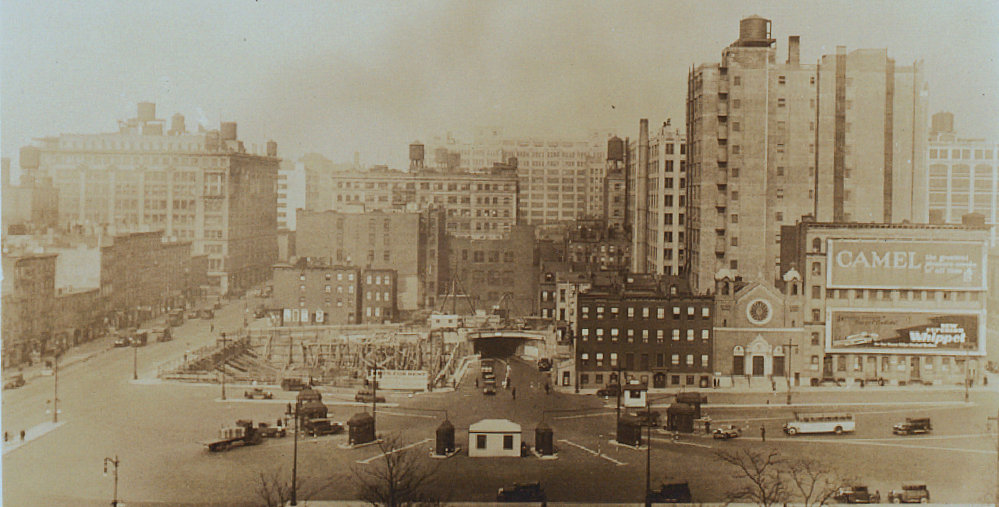

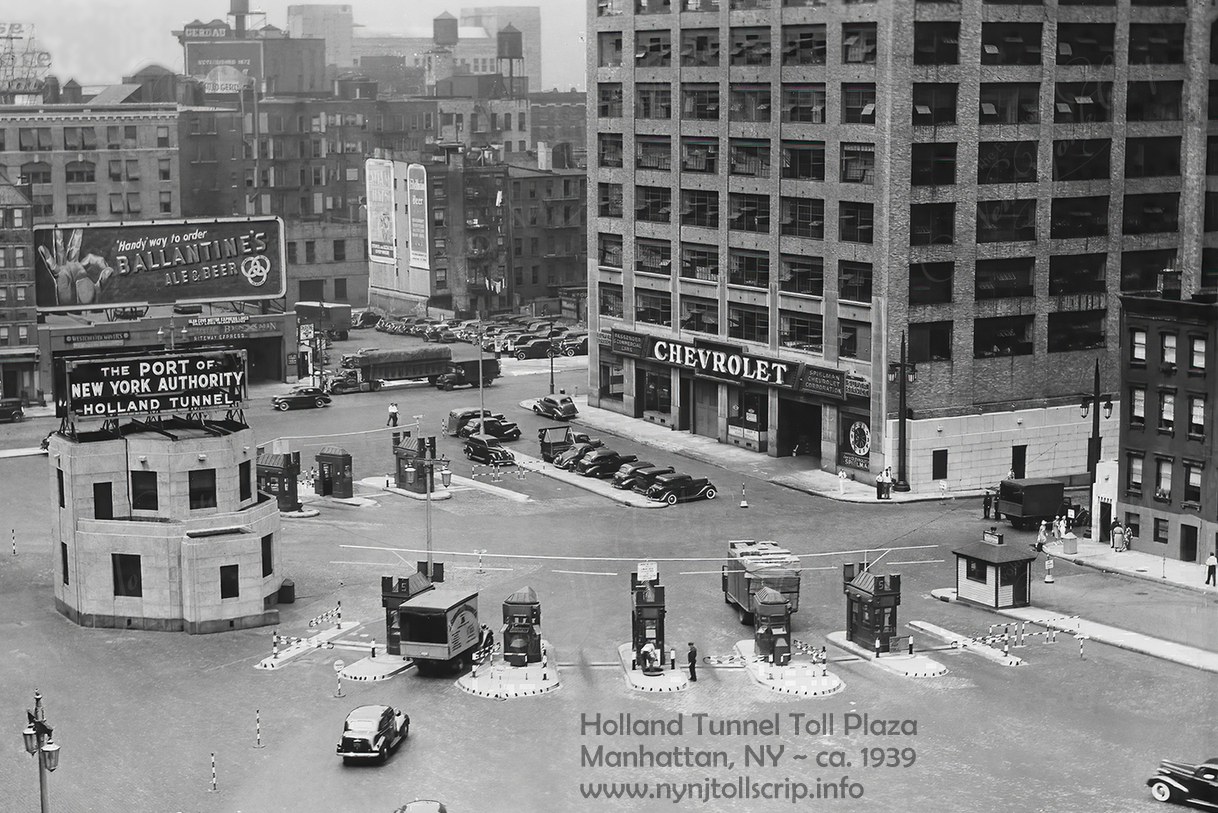



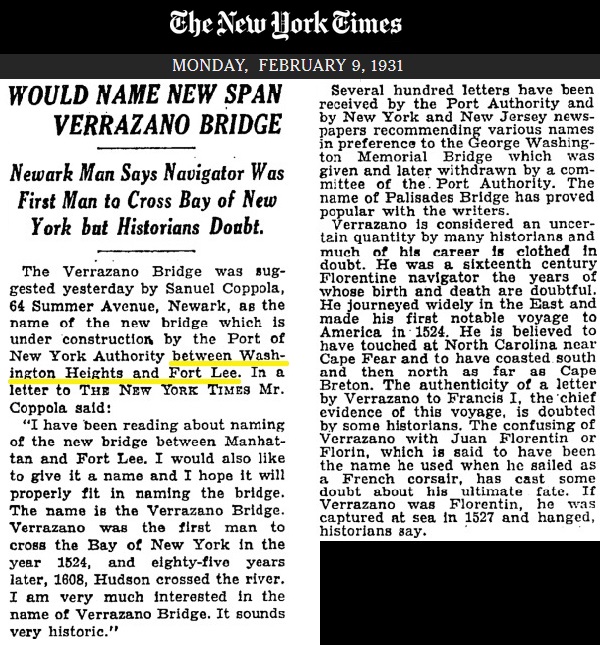

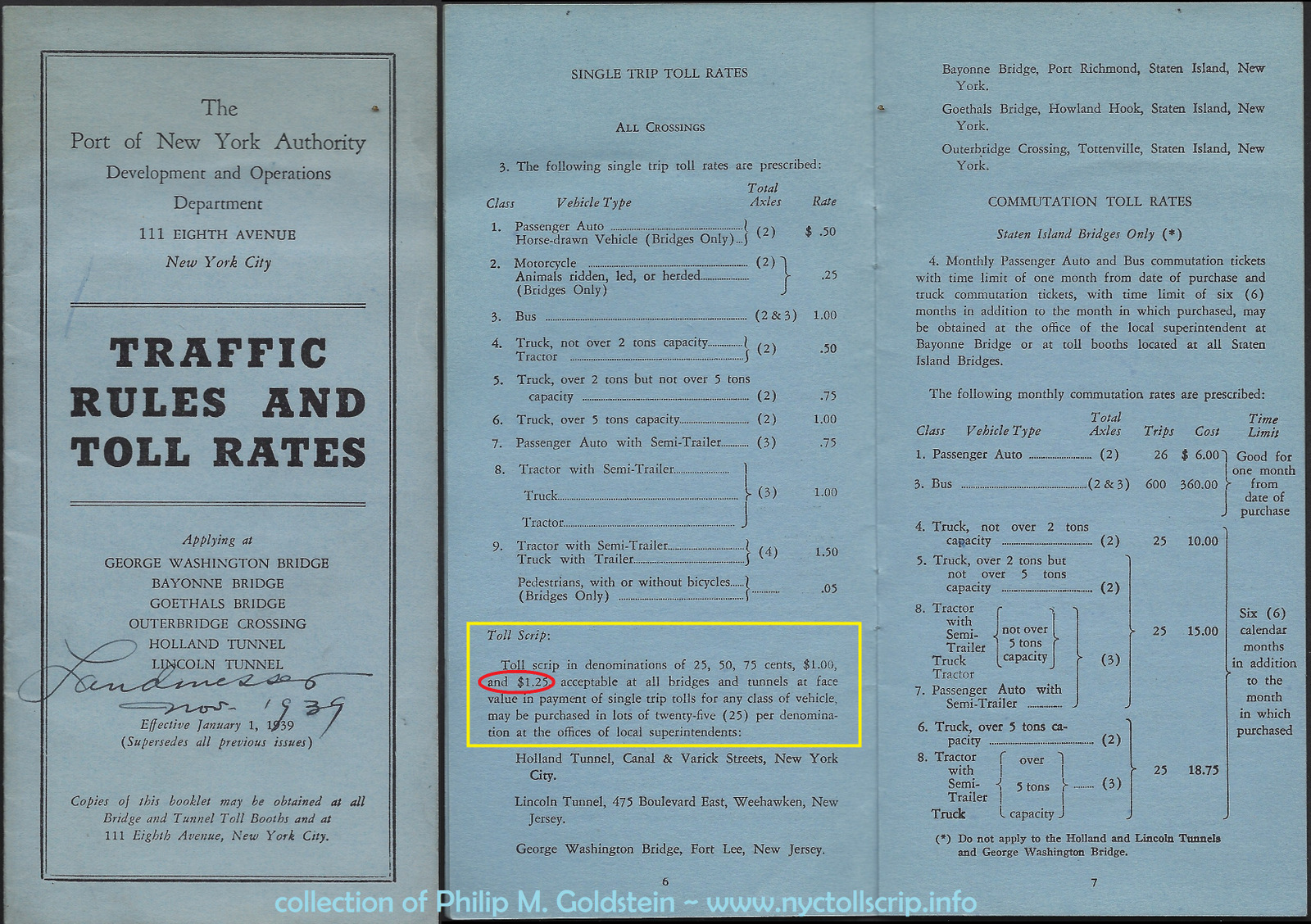
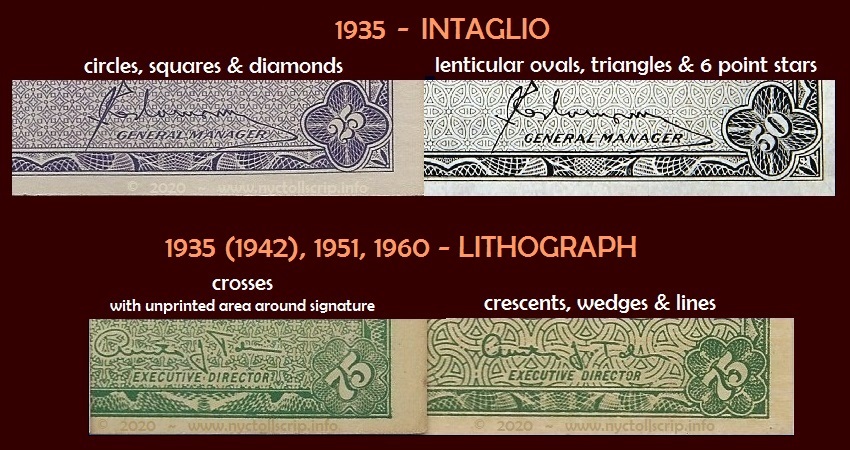
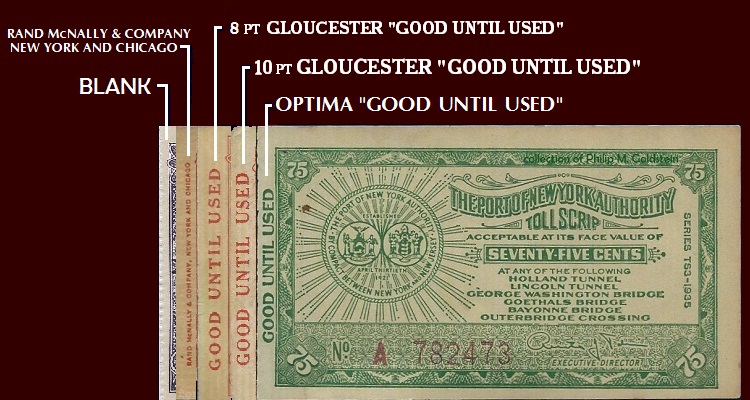
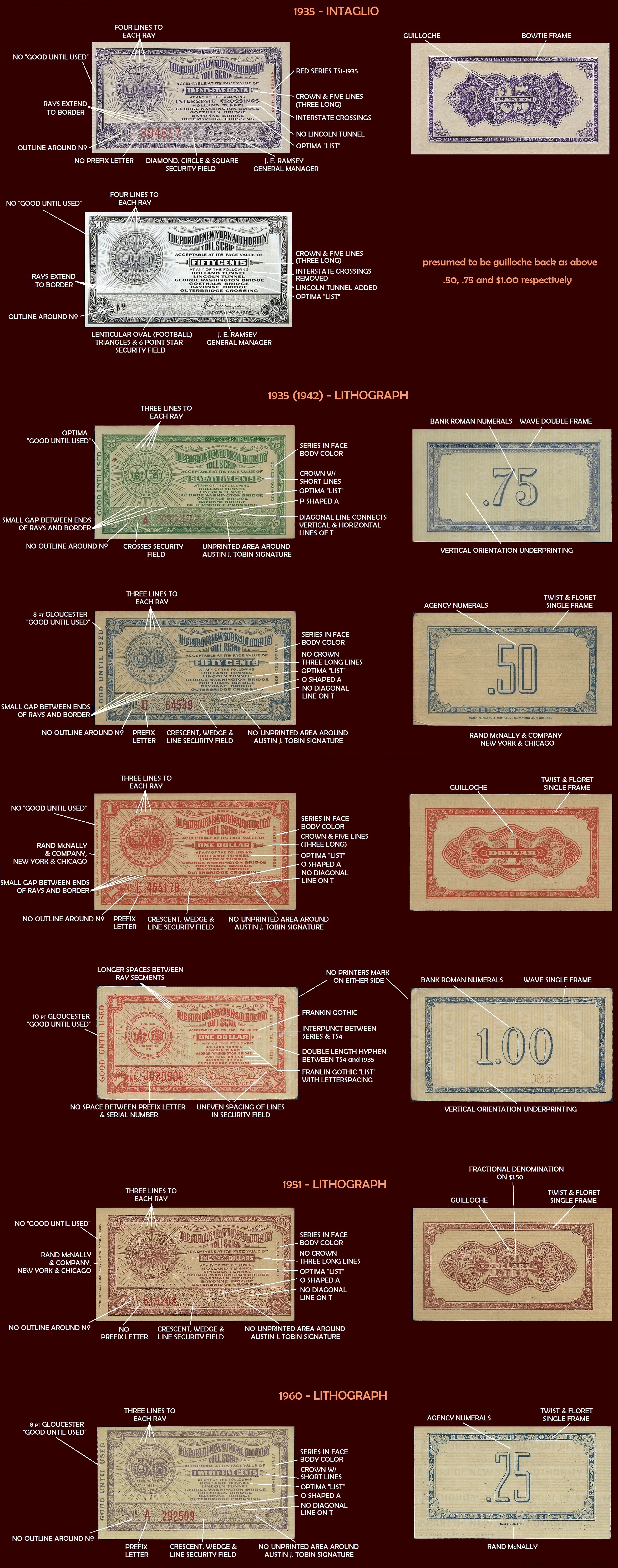




 .
.